THE WORK OF ART Adam Moss
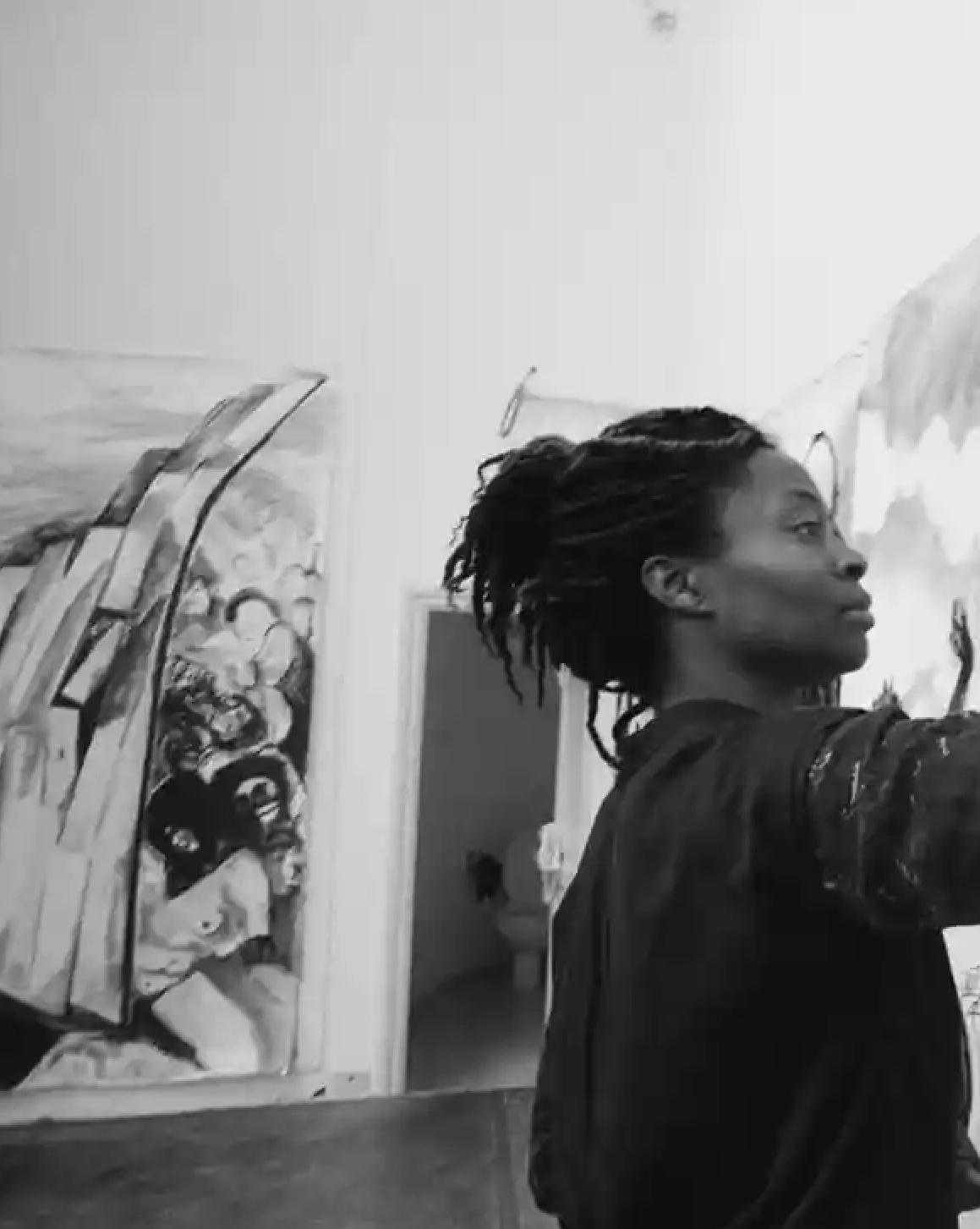

KARA WALKER
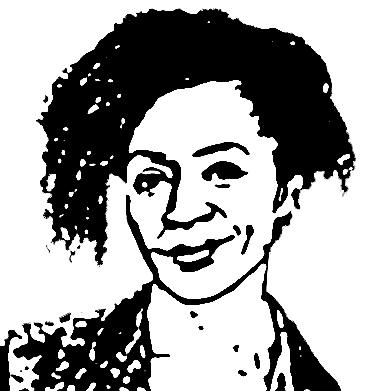
You, Where Are You?
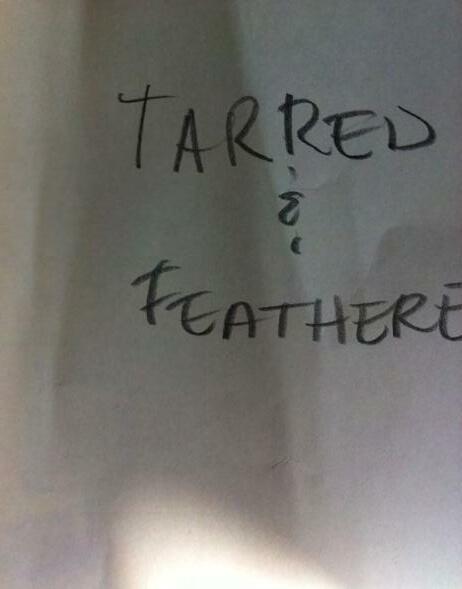
born : 19TK
I’D READ ABOUT A Subtlety, or the Marvelous Sugar Baby – or as it was commonly referred to, the Sphinx – but I can’t say I was really prepared for it. I had biked there, to the old Domino Sugar Factory right by the Williamsburg Bridge. The factory was about to be destroyed, and I knew that they — Creative Time, a visionary arts organization devoted to public works, with funding from the developer [fn1] — had approached Kara Walker, an artist I revered, and invited her to make a public sculpture there.
I entered the building, and if I remember right, it was a little twisty to get there, passing deserted rooms until suddenly you were in a vast cavernous space. And there you saw the giant face of a Mammy figure, perched forward with two giant breasts, Sphinx-like. Her body extended behind her. She was mammoth — 75 feet long, 35 feet high —and surrounding her were more life-sized figurines, boys with baskets, most of them. The Sphinx was white. She was covered in refined sugar- in fact it looked like she was made of the sugar entirely. It was at first almost comical to me, but I realized that was mostly a defensive reaction, since it very quickly became horrifying. Later I learned that was the frequent reaction – laugh/horror – to the sculpture, which was actually a set of sculptures: the Sphinx and the


2 KARA WALKER
Dolut eliciisqui te volupti ne et fuga. Sit quiae.
occupation : scultor work : A Subtlety, or the Marvelous Sugar Baby
1
RE: FIRST THOUGHTS FROM 2013 ABOUT DOMINO I found an email that I sent to Anne Pasternak (the director of Creative Time) of the space after the initial visit. See below. ‑Kara

3
statues of boys with baskets. You could smell the sugar, smell the molasses, it was already (and this was the beginning of its run) a little rancid. I wandered back, taking in her whole length, until I was face to face with her exposed vulva. People, including several families, mostly white, were studying her, some taking pictures, some chattering, some agog. I went home, and found myself thinking about her a lot. Several weeks later, I went back. The figurines had largely melted. The stench was vile. The spectators were now mostly black.
Between these visits, I dreamed about the Sphinx, and found myself in many conversations trying to divine her meaning, reading up about the history of sugar and slavery.
Walker was one of the first artists I spoke to. We spoke about what she’d been doing recently, and she was describing working through her struggle with a work she was then making, responding to the January 6th insurrection. “I was feeling very frustrated, she said, “I had been making a piece about white nationalism, or the origins of it, and I just started making a drawing with my feet because I had sat down to make a drawing and I was like, I can’t trust this hand not to make something very obvious, that we already know. So I took a cue from Trisha Brown [fn 2], put some paper on the floor and just let my body do the work [fn3]. And I thought, well, that’s better. It’s just a fucking mess, but it totally fit the mood.”
And we talked about the unusual creation story of A Subtlety, in which a PowerPoint and an epiphany on the Q train were pivotal to her making of the sculpture(s). The path is a cascading series of associations but she approached it like a research project. I was really surprised at how methodical her thinking was, maybe because I cling to the idea that artists are all instinct. The installation took over a year to take shape, from Walker’s first visit to the site until its opening on May 6, 2013. Walker, who had become well-known for her art, mostly about the Antebellum South and mostly comprising black and white silhouette cutouts of slaves, was just emerging from a fallow period
artistically. When Creative Time approached with the open-ended invitation to do whatever she liked in the vast, historically-fraught factory, she had been looking to move away from the silhouettes but hadn’t settled yet into a new project, or even a desired medium. She had never done a piece of public art before, or much sculpture, let alone a sculpture of this scale. But then it was not always obvious that a sculpture was what she would build. The site intimidated her, but she also found it difficult to resist. She reluctantly said yes.
KARA WALKER:
“I have to go back in time to, what was it, early spring, late winter of 2013? In 2011 I had two shows that opened at the same time in Manhattan. I did a whole bunch of drawings and prints – big sort of block letter text pieces. And a shadow puppet film. I was trying to shift some focus away from the silhouette work into drawing and other material, trying to create a space for illustration, drawings of hidden moments, as if they could be book covers for all the possible dissertations on Black life and Black culture from like Reconstruction forward.
But what happened is I bought a house and so from 2012 to 2013 all I was doing was the house. I did not make anything. There was a year where I did a bunch of little cartoon drawings, like scrolls, but really it was like: why am I not working? I didn’t understand. It was the weirdest experience not to feel productive.
By 2013, I finally had a feeling of being settled. And that’s when Creative Time approached. You know, I ‘m sort of inclined to keep saying no to things, but then I just thought, why not, [I’ll look]. We went to the Domino Refinery and I was pretty floored. I felt I kind of got it, it felt kind of perfect. So saying yes was one thing.
And then – I was trying to think of an analogy earlier. It was like flood gates opened, dadada, but I can’t swim. It ushered in this huge flood of possibility. And then I was tumbling
4 KARA WALKER
around in that, trying to conjure magical sort of inflatables in order to survive.
What About This? Creative Time didn’t
say anything about what they were looking for. So... I had a sketchbook, and I kept asking myself: what about this, or this, or this? That was what it was like for three months. I was hardly even drawing. How do I think about the volume of this space? And then, how do I think about the history of this location? And then, how do I think about the history of what this location has been processing? I was overwhelmed. For a couple of those months, I couldn’t figure out how to begin.
They weren’t really ideas, just sort of little bubbles, kind of like, how to traverse the space very quickly? Something that moves? Machinery? Image, video, multimedia? You can envision all kinds of things. It could be a group happening, for instance. And when I was sitting in my studio or my room, it was hard to really picture the volume that I was going to be working with for real. There was one moment – I’d done a bunch of figures in costume with balloons. But no, it was like smashing your head over and over because everything seems like a possibility. I’d see something on TV, and I’m like: what about that ? I was sketching people on roller skates! No, really. Stupid shit.
And then I finally said to myself: You, where are you? You know, like looking in the mirror, like who are you Kara, again? Stop sketching stuff! And the deadline for presenting my idea was [fast approaching].
One of the lovely things about Creative Time was that they were at my beck and call. If I wanted to research something, they would say yes. So, for a while, I was thinking of some kind of conveyor, one material transforming to another material. And chickens. I don’t know why but I was thinking about chickens. And then I also was thinking about waste products, the effect of the sugar on the Domino plant, the heavy molasses smell – caked onto every surface was a kind of molasses. And about oil
and other byproducts and the over-reliance we have on things that are bad for us. And they did some research for me into chicken processing, slaughterhouses. And I thought, what if I do this? I won’t import raw Coke or whatever and put it in this space … that’s the wrong direction. But then I thought, wait, what is the right direction?
A PowerPoint So I put together this PowerPoint, which confused everybody at Creative Time. But the PowerPoint was the only sketch I approved of. I couldn’t trust my hand to draw the thing I was trying to articulate because it just wants to make things cute.
It’s funny. The PowerPoint was like my office life. It was a way of synthesizing material but it also has a rhythm and poetry to it. I was gathering images that included the chickens but then went into voodoo and rum and sugar and the transatlantic slave trade. I started to read about the process of sugar refining, and that it’s not a given that sugar should exist in the world. I started to think about my role as the artist in relation to doing a big public art project. I got interested in men like Henry Osborne Havemeyer [fn5], the guy that brought the sugar refining process to... foolish expression. Those are the gods of Industry. That’s really what I have to imagine myself to be.
We had a meeting scheduled for December 2013. I was trying to get a little thesis going.
And I’m not talking to anybody about it. It’s sitting in my head. I don’t usually have people that I talk to about what I’m doing. I’m too secretive sometimes –but especially this one because it was top secret. So I’m jotting things down, scattered notes. But the one thing that really changed everything was Sidney Mintz’s [fn6] book on the history of sugar. I had my aha moment in the middle of that book on the Q train.
I mean, I had been getting there because the last piece of the PowerPoint involved text and images with words on them, started with sugar and brown sugar and then I added a pole
5
TKTKTKTKT
ne et fuga. Sit liciisqui te volupti ne eliciisqui te volupti ne equiae.
impulses and make some sort of icon, whether it’s like the silhouette or... it just has to fuse into one thing. And it has to be something like you have no choice about. The time for
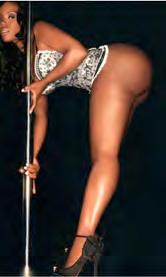
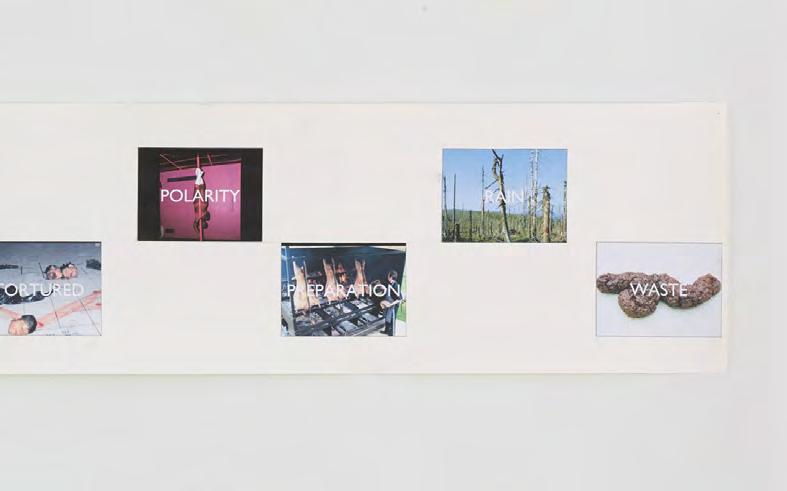

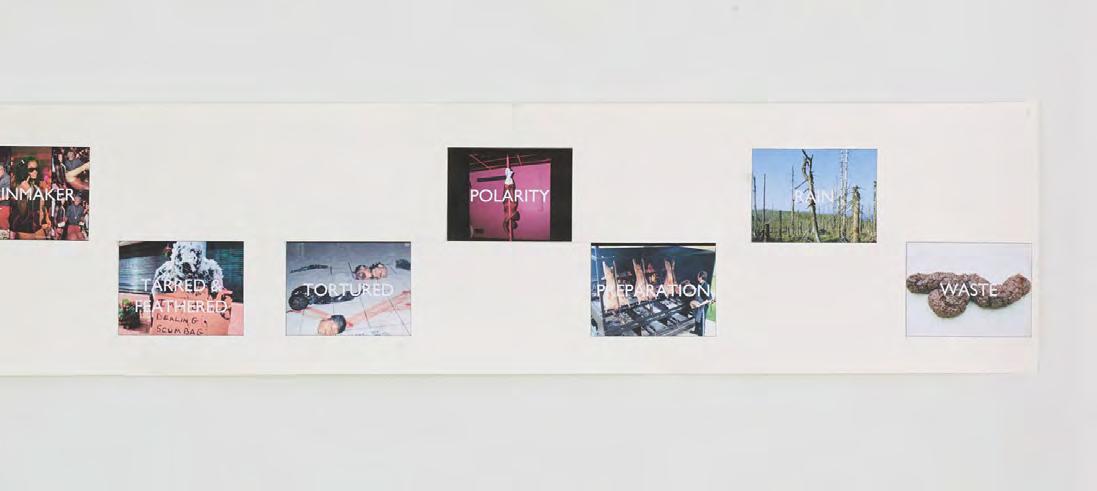
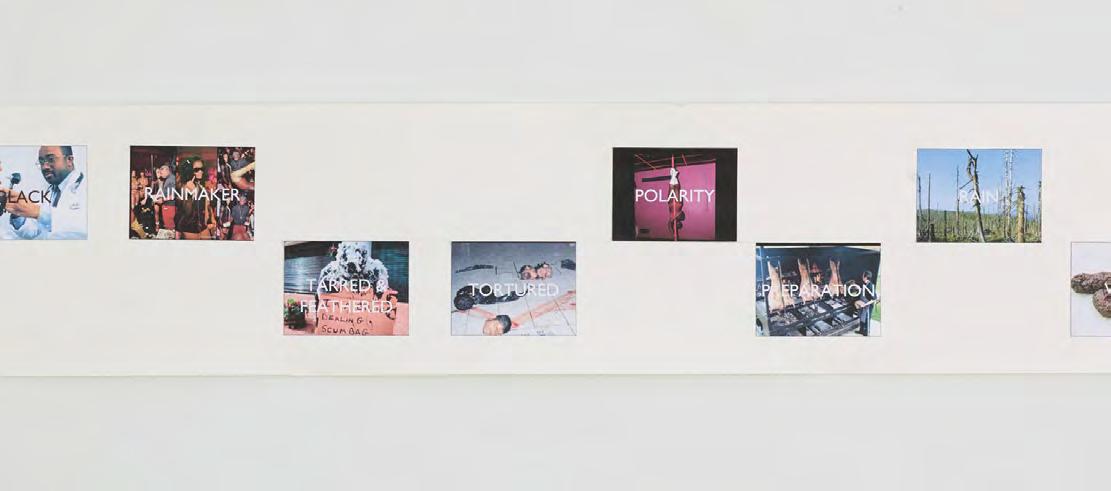
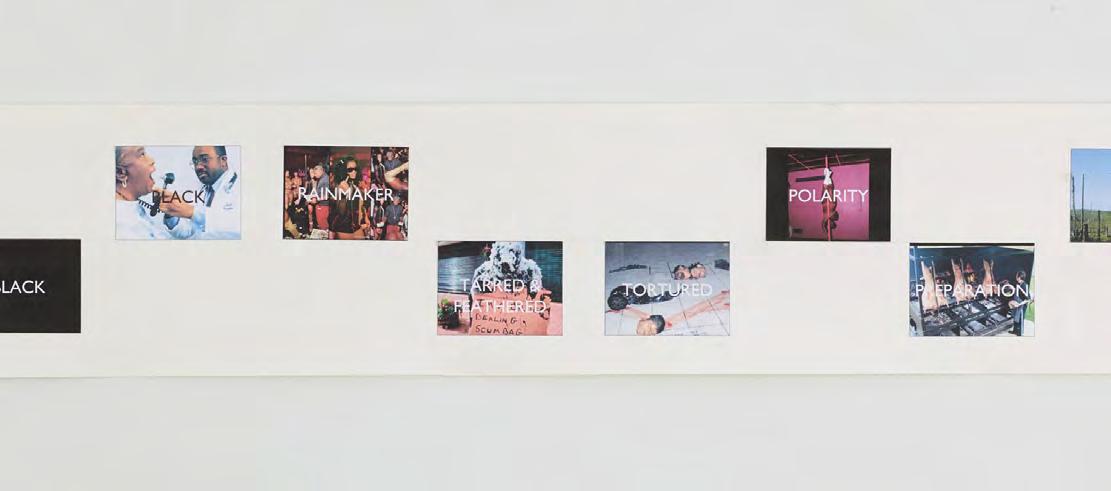





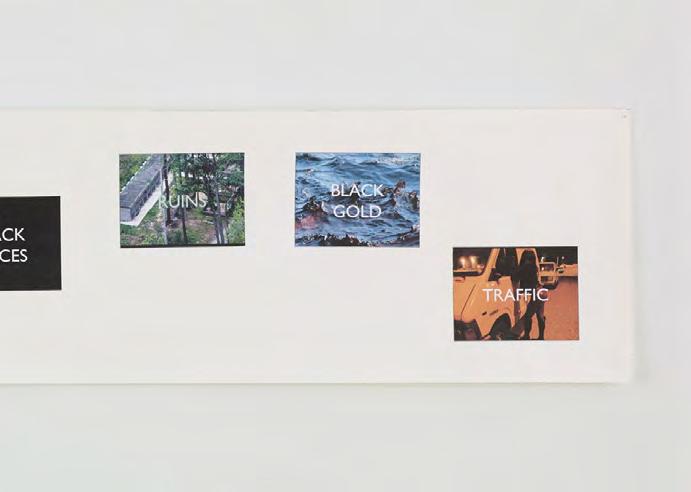


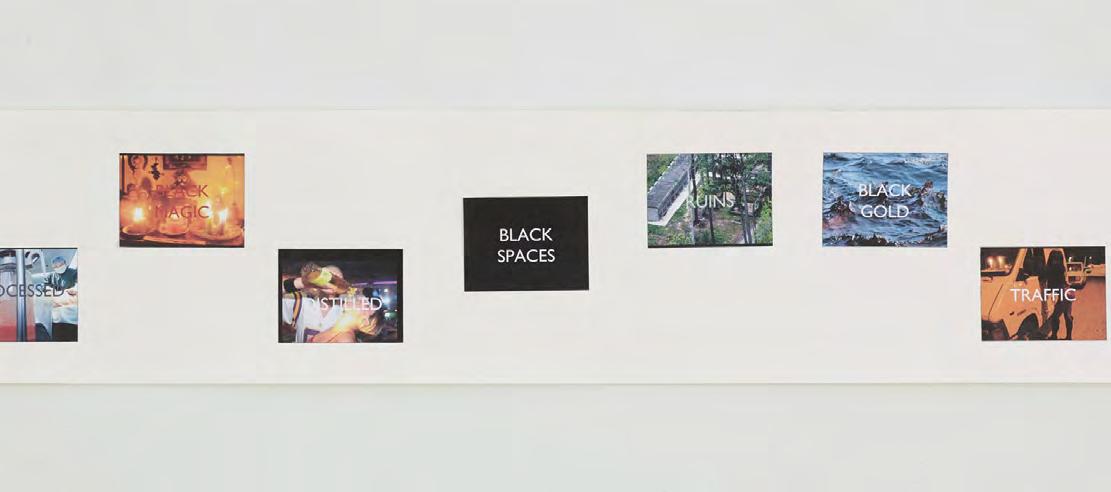
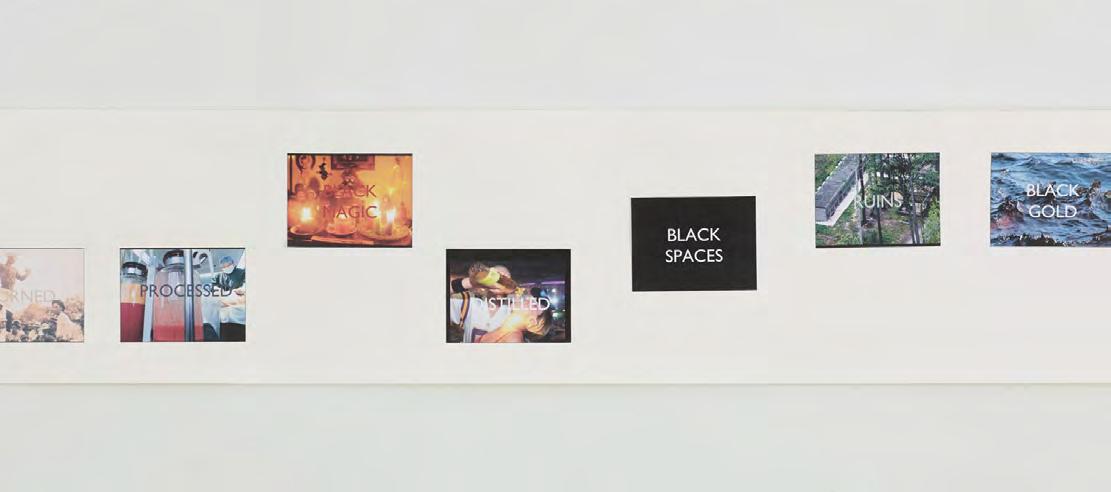



And I’m feeling, now I know what the material is. I feel the material. It’s not just an intellectual pursuit. It lives in my body.
Revelation on the Q Train And here’s what happened: I was on the Q train. And I was reading the Sidney Mintz book. And there’s a section where he talks about the “subtleties” – these special decorative [sugar ornaments] exclusively for kings, for the celebration of weddings... and you know, we’re so used to fucking sugar we don’t even realize how special sugar is...
And I was just like: Oh, it’s a sugar sculpture! And I realized the Sphinx was the perfect sort of ruin. And that was the big moment.
From that point on, the drawings are drawn with molasses, stuck together.

And I thought, It can’t just be a Sphinx because then it only reads on that one note.
We have to open it up to all these other sorts of desires that sugar exploits and represents. And our covetousness for sugar is not
mammy figure. Mammy-like figures existed so much in my work already. Michael Jenkins
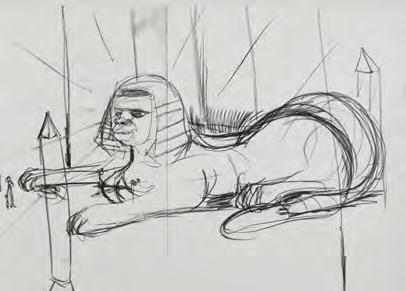
unlike sexualized covetousness. The power is hard to quantify. So it had to be a female, larger than life queen figure with everything open and bare and bare breasted.

A Mammy Sculpture I’m not sure exactly when I got the idea to do the sculpture as a
from the gallery found a drawing of mine from the late nineties or something with a mammy Sphinx on it. And there’s one sketch that was also kind of instrumental, it was a collage with the back end of the her butt in the air.
And so now I had to build a sculpture, and that was terrible. The first iteration at my studio, I was so embarrassed. I don’t know how to do sculpture. So let me just make a tablesized one, of papier mache. And the first one
collapsed. That kind of thing can be a big setback when you think you know how to do other things.
I felt, I don’t know how to do anything. Who do you think you are?
7
So then I made a smaller little clay sphinx figure, just kind of modeled on the Sphinx. And I took a little snapshot with the refinery behind it. And I had a model of space, like a little foam core model.
Creative Time helped me facilitate how it could get made, I just knew it should be an object, monumental, something grand. But then I was wondering if it should be something made by my hand. And I started looking stuff
point it became, what is possible, what is not possible? What is achievable in the timeframe? What is achievable financially? In physics? At a certain point everything was achievable. We just had to say what it was. So it was this giant sugar sculpture and these candy figurines at a human scale.
I didn’t ever have the specific notion that it would melt. That just sort of came with it. I knew it would be an unstable object. But we didn’t really know how unstable until we started making them.
up. And I found these little sugar boys sculptures online--candy dishes. And I thought these are appalling. I don’t know how I found those boysMy studio was in the Garment district for so long. So I always happened to pass by shops that had tchotchkes in the window, like African queen kind of figurines. And I thought, these are kind of strange, why are these being made. Who buys them --besides me apparently?
Logistics So the sphinx was going to be the main sculpture. And the challenge for me was how to make it solid. That was a bit of a challenge. And finally it was just, settle on a face or something, settle on a kind of body and then work with a model maker to make a figure that was a passing resemblance to the sketch. And then I thought these boys could be attendant figures.
I wanted them made as candy sculptures, made of sugar. I’m thinking everything is going to be made of sugar. And basically, at a certain

It was all trial and error because nobody had ever done it. People had made smaller sugar sculptures, and there were people in the candy business, of course, and bakers. But when we started asking around for how to do this, no one wanted to touch it. They said, it’s not going to work. The first one, when we made the molds – well, let me first explain that it’s easy to make candy — it’s just sugar and water and temperature. It just has to reach the hard ball stage, when you can pour it into the mold and let it sit. But for us, the molds were so big and the temperature was so hot, it never cooled in the interior. So the first one, we took it out of the mold, and at about six o clock that evening, it was a puddle.
Compromise Eventually, we thought maybe we have to do some of these in resin, some in resin and some in candy. Okay, compromise. Don’t love it, but maybe it will create the effect.
So we made as many of these sugar boys as we could. And then the day before the opening, a truck backed into one of them, maybe two of them got knocked over. Oh my god that was bad. I don’t know if you remember but some of the figures have figures inside their baskets. I just picked up the broken pieces of the ones that had fallen and put them in the baskets of the ones who were standing.
The building process, when that actually started, that was amazing. I’d have fits of giggles because I just couldn’t believe we’re doing this. The development was interesting, all of that was interesting, but just stepping into
8 KARA WALKER
Dolut eliciisqui te volupti ne et fuga. Sit liciisqui te volupti ne eliciisqui te volupti ne equiae.

9
table-sized one, of papier mache. And the first one collapsed. That kind of thing can be a big setback when you think you know how to do other things.
I felt, I don’t know how to do anything. Who do you think you are?
So then I made a smaller little clay sphinx figure, just kind of modeled on the Sphinx. And I took a little snapshot with the refinery behind it. And I had a model of space, like a little foam core model.
Creative Time helped me facilitate how it could get made, I just knew it should be an object, monumental, something grand. But then I was wondering if it should be something made by my hand. And I started looking stuff up. And I found these little sugar boys sculptures online-candy dishes. And I thought these are appalling. I don’t know how I found those boysMy studio was in the Garment district for so long. So I always happened to pass by shops that had tchotchkes in the window, like African queen kind of figurines. And I thought, these are kind of strange, why are these being made. Who buys them --besides me apparently?
Logistics So the sphinx was going to be the main sculpture. And the challenge for me was how to make it solid. That was a bit of a challenge. And finally it was just, settle on a face or something, settle on a kind of body and then work with a model maker to make a figure that was a passing resemblance to the sketch.
And then I thought these boys
1. Creative Time is a nonprofit that supports public art – with a particular focus on vacant spaces with historical resonance.
2. Trisha Brown is a choreographer who is also a visual artist; she makes drawings with her hands –and her feet.
3. KW’s drawing with her body because she is afraid of drawing too cute is a classic hack. Artist’s hacks are plentiful, and sometimes very odd. For their book Sketchbook with Voices, Eric Fischl and the art critic Jerry Saltz interviewed artists. “What I found so compelling was to hear how artists got themselves out of their dead spots” Fischl wrote me. “Richard Artschwager was overworking a painting. He decided to watch TV and only go into his studio to paint during commercials. That gave him about two minutes a time to work. He said it took him most of the afternoon soaps but eventually got passed whatever it was that was holding him back.” There’s a fun book on the subject, by Mason Currey called Daily Rituals. Among its findings: When Igor Stravinsky was blocked, he stood on his head. WH Auden would take a benzedrine every morning. John Cheever would get dressed in a suit, take the elevator to a room in the basement and then strip to his boxers to work.
4. She’s talking about the Rolling Stones song Brown Sugar.
5. Henry Osborne Havemeyer was President of the American Sugar Refining Company – which were once owners of the Domino Refinery.
6. The New York Times called Sidney Mintz the father of food anthropology. He wrote extensively on the link between sugar and slavery.
could be attendant figures.
I wanted them made as candy sculptures, made of sugar. I’m thinking everything is going to be made of sugar. And basically, at a certain point it became, what is possible, what is not possible? What is achievable in the timeframe? What is achievable financially? In physics? At a certain point everything was achievable. We just had to say what it was. So it was this giant sugar sculpture and these candy figurines at a human scale.
I didn’t ever have the specific notion that it would melt. That just sort of came with it. I knew it would be an unstable object. But we didn’t really know how unstable until we started making them.
It was all trial and error because nobody had ever done it. People had made smaller sugar sculptures, and there were people in the candy business, of course, and bakers. But when we started asking around for how to do this, no one wanted to touch it. They said, it’s not going to work. The first one, when we made the molds – well, let me first explain that it’s easy to make candy — it’s just sugar and water and temperature. It just has to reach the hard ball stage, when you can pour it into the mold and let it sit. But for us, the molds were so big and the temperature was so hot, it never cooled in the interior. So the first one, we took it out of the mold, and at about six o clock that evening, it was a puddle.
Compromise Eventually, we thought maybe we have to do some of these in resin, some in resin and some in candy. Okay, compromise. Don’t love it, but maybe it will create the effect. So we made as many of these sugar boys as we could. And then the day before the opening, a truck backed into one of them, maybe two of them got knocked over. Oh my god that was bad. I don’t know if you remember but some of the figures have figures inside their baskets. I just picked up the broken pieces of the ones that had fallen and put them in the baskets of the ones who were standing. The building process, when that actually
10 KARA WALKER
started, that was amazing. I’d have fits of giggles because I just couldn’t believe we’re doing this. The development was interesting, all of that was interesting, but just stepping into the space… I don’t know how to describe it really. It was intimidating. It was, is this mine? I had to go back in there and figure out and how to make it mine.
There were some things I literally couldn’t do. I wasn’t really capable of moving giant blocks of polystyrene. So I would go over there regularly and talk with the team who was shaping everything. It wasn’t until the last phase of it, the last four weeks, that I felt I was really doing something, I was running back and forth.
A Deadline We’re on a timeframe that was very tight. It was kind of clockworkish.
We decided to open early May, and then we just started an eight week run. So things are going to fall into place, or not. I had done what I could do.
As for destroying it after it was done, well, what is the purpose of a monumental sculpture on a grand scale but to be destroyed? I had my moments when I thought, well maybe I shouldn’t, but I felt ickier holding onto it than letting it go. I felt I was playing some sort of game with it. I had promised it, you’re going to come and then you’re going to go. And that’s just how it has to be.
On May 10 it opened: My daughter went to see it a couple of days before. And there’s a picture of her when she first gets into the space, laughing. And that resonated for me because it reminded me so much of my first experience when I presented the work. There was the not-seeing of it. People walked into the factory and they were like wow, wow, wow, look at all the sugar boys. People walking and walking and walking, and then suddenly it was there. And they didn’t know there would be a big thing there. They were just like, Oh my God. And I found that very satisfying. So, my daughter walked in there, she’s a teenager and she’s looking around, and I sort of pointed to it. We were standing in front of it, just looking. And it wasn’t about the aha moment. It wasn’t just Oh, the breasts, Oh the sugar, it’s made of what? You know, you walk around. And it keeps changing shape and meaning in the viewer’s eye and mind – I mean hopefully. And maybe it sort of elicits some of those harder feelings that I was thinking about – I hope so.
All I can say is, I was trying to materialize and manifest the feeling of the histories I wanted to talk about. I had ingested that. I had done something that affected me, and I knew what it was. I knew the effect I wanted it to have. And that was it.
I don’t know about anything really. I always feel like I’m a novice and I’m just starting out
SIDEBAR TKTKTKT
I was very taken with the ephemerality of the project. I asked if that was always the plan.
KW: Well, what is the purpose of a monumental sculpture on a grand scale but to be destroyed? I had my moments when I thought, well maybe I shouldn’t, but I felt ickier holding onto it than letting it go. I felt I was playing some sort of game with it. I had promised it, you’re going to come and then you’re going to go. And that’s just how it has to be.

11


TONY KUSHNER

Breadcrumb
Traces Is What I Call Them
occupation : Playwright/screenwriter
work : Angels in America
born : 1956
I MET TONY KUSHNER in his house in Provincetown. I was first greeted by his husband Mark Harris who I used to work with, and soon by his exuberant dog, who they both fussed with. Mark took off, and Tony and I settled in his living room, curled on the couches for a long conversation. It took place, like so many of these conversations, during the heart of Covid. The release of Steven Spielberg’s West Side Story , for which he had written the script, was still months away. West Side Story was finished a while ago, and now it was just waiting, we were all just waiting. A revival of the musical he wrote, Caroline, or Change (evidence of the broad nature of his talent, if some were needed), was also in suspended animation; it had been set to open just as the pandemic began. But Tony was hardly idle; he was furiously writing another movie with Spielberg [fn1] , and the speed with which it was coming surprised him, since he is very invested in his identity as a procrastinator. I told him the obvious, that he seemed plenty productive.
ROY COYN THE OCTOPUS, FINAL
Roy (Hitting a button): Hold. (To Joe) I wish I was an octopus, a fucking octopus. Eight loving arms and all those suckers. Know what I mean?
Joe: No, I . . .
Roy (Gesturing to a deli platter of little sandwiches on his desk): You want lunch?
Joe: No, that’s OK really I just . . .
Roy (Hitting a button): Ailene? Roy Cohn. Now what kind of greeting is. . . . I thought we were friends, Ali. . . . Look Mrs. Soffer you don’t have to get. . .
. You’re upset. You’re yelling. You’ll aggravate your condition, you shouldn’t yell, you’ll pop little blood vessels in your face if you yell. . . . No that was a joke, Mrs. Soffer, I was joking. . . . I already apologized sixteen times for that, Mrs. Soffer, you . . . (While she’s fulminating, Roy covers the mouthpiece
“I’m not though. It’s pathetic. Todd Haynes [fn2] called me a while back and said would you do this series with me, about Freud? It was so much up my alley I said yes immediately. And I never heard back from him. And then I saw him later and I said what are you working on? And he said, a miniseries about Freud with this British playwright. And I was aghast. I said, ‘what happened to me?’ And I tried not to have a reaction but I couldn’t resist. I said, ‘fuck, what happened to me?’ He said ‘Oh, I’m sorry, I forgot. I wanted to hire you. But Christine [Vachon, the producer fn 3 ] said absolutely not. You’re never going to get the script.’” I laughed. “Spielberg
2 TONY KUSHNER
2
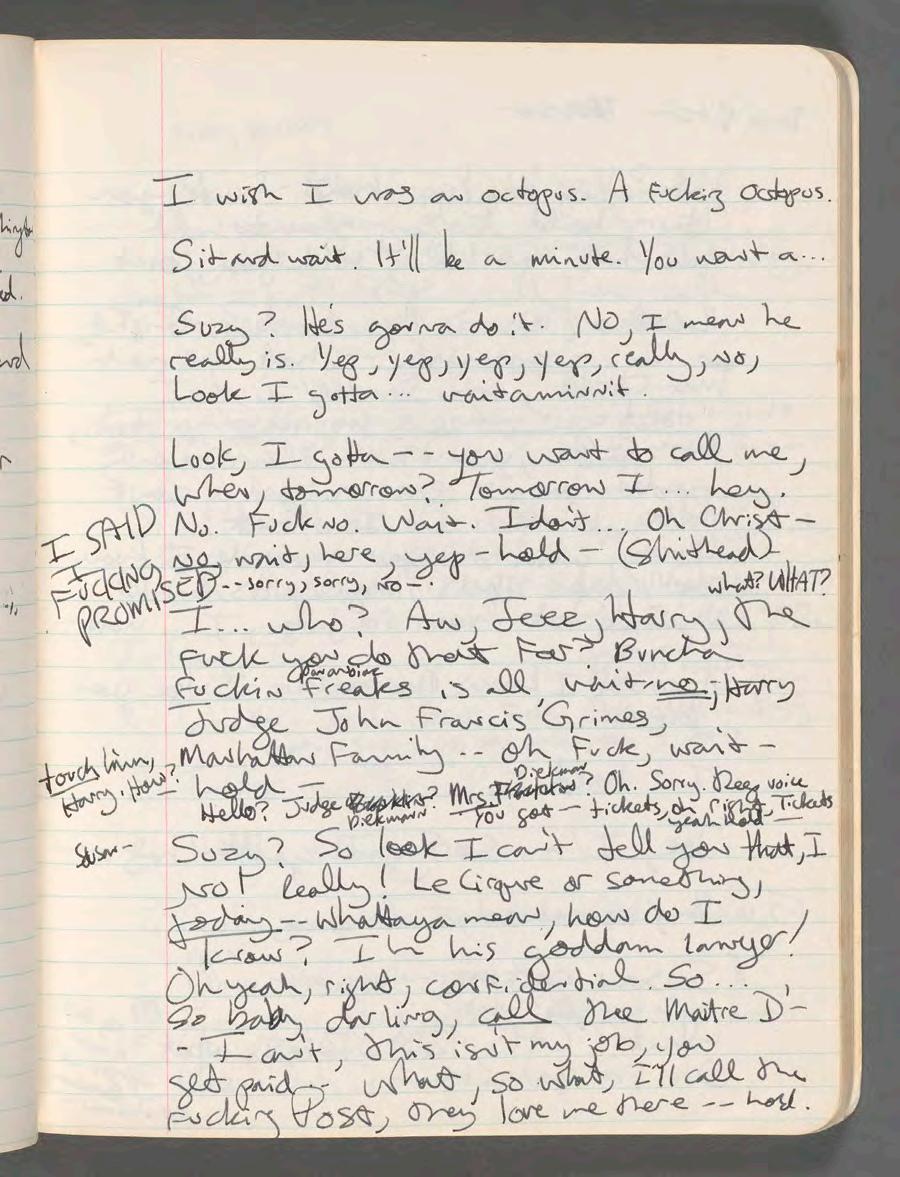
3
ROY COYN THE OCTOPUS, FIRST TRY Tktktkt tktktk tktktktk tktktk


4 TONY KUSHNER
TKTKTKTKTT, Figure 1 – teekay
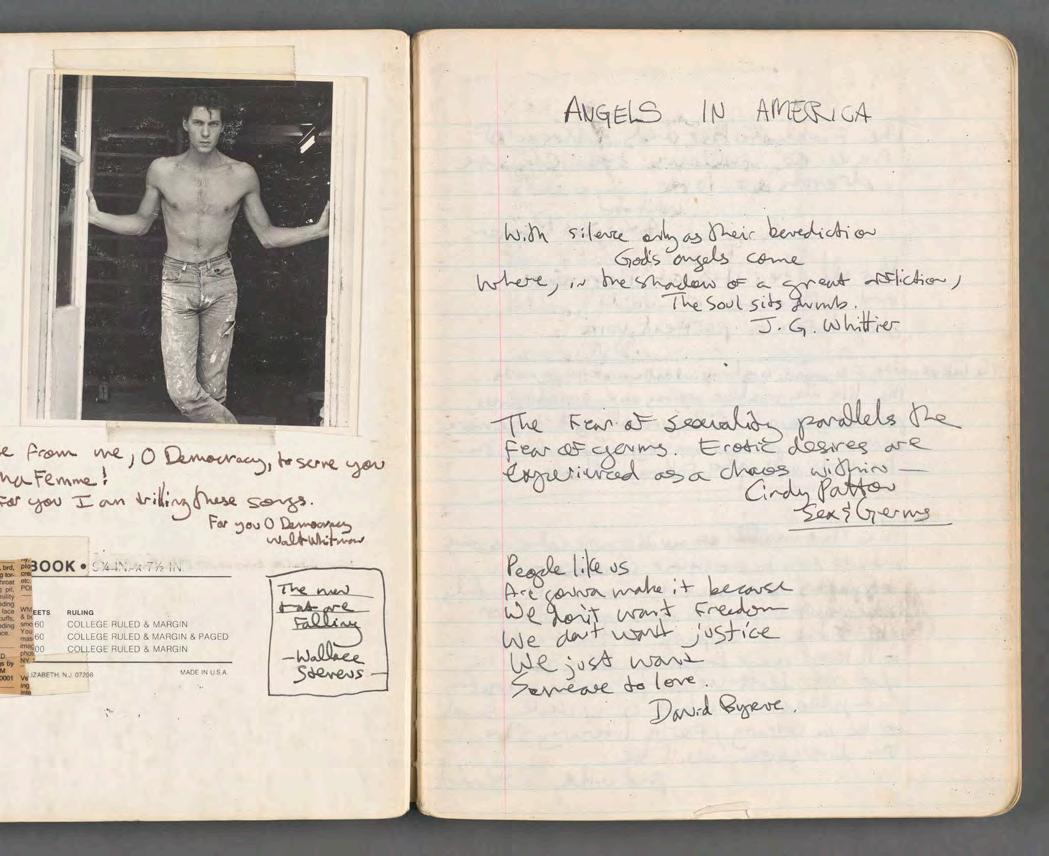
5
TKTKTKTTKTKT, Figure 2 – teekay
for some reason has been the soul of patience with me. I always have 700 reasons why I mustn’t start working right now: I don’t trust my instrument, I think I’m not really good.”
Freud hovered over our talk, which concerned his masterwork Angels in America, and how it came together, a story in which the unconscious, in the shape of a dream, plays a central part. I probably don’t have to explain how good it is, since it’s widely considered the most accomplished play of the last chunk of the twentieth century at least; it’s the winner of Tonys and the Pulitzer and all that. Just to give you some orientation, it’s actually two plays-- Millennium Approaches and Perestroika, written in succession but usually performed together. Its hero is a gay man named Prior, who is struck with AIDS and has hallucinations, but it is also a thickly plotted epic involving the Mormon Church (and Joe, a closeted Mormon who has an affair with Louis, Prior’s boyfriend that Louis has left; Joe’s wife Harper, a pill addict, who also has hallucinations; and his mother, Hannah Pitt, who comes to visit); and the notorious real-life lawyer Roy Cohn, who also has AIDS and also has hallucinations and has designs on Joe; and Belize a friend of Prior’s who is Roy’s nurse; and most crucially an Angel, who has descended from Heaven through Prior’s ceiling to take him back with her, since he is, she tells him, a Prophet, who is destined to rescue
the otherworld, which by the way is in tatters because it has been abandoned by God. Does that make sense? For our purposes here I suppose it must, since my conversation with Tony was a piece by piece account of how the epic emerged.
We got to that in a winding way that suggested the labyrinth of Tony’s mind, which is just as funny and thoughtful and honest as his plays. I’ve tried to straighten it out here. So we’ll just pick it up at the beginning of how he became a playwright in the first place:
ABOUT FORM
Experience Does Teach You “I
think I really always wanted to be a writer,” he said, “but I’ve always found writing scary. I have ADHD or something, I don’t know what it is. In any case, I didn’t actually know what I wanted to do. I came from this tiny town in Louisiana, both my parents were musicians, my father was very erudite – a great reader of poetry. My father, who was a Juilliard trained clarinetist, lived for art – music and poetry especially and had a kind of eidetic memory, could cite ‘Endymion’ by heart and Robert Burns and Shakespeare. He really loved language and loved words. And he wasn’t a mean person. But he couldn’t read a book that was badly written. It just made him angry. And it was sort of, if you weren’t a genius, if you weren’t Keats, what was the point? He and I clashed
As Tony was considering the sort of play he might want to write,. he found himself attracted to the possibilities of epic theater, thinking particularly about Shakespeare. “Shakespeare makes you want to come in and do what most people don’t know they have to do with works of art, which is, you are as capable of failing it as it is of failing you. You have to bring yourself to it. And somehow Shakespeare just makes that the thing you want to do–
“I love big long discursive things. I loved Moby-Dick. I just became obsessed with Melville, rejecting the idea that you had to exclude things. One of Brecht’s friends Walter Benjamin said that beneath the surface there are these tunnels constantly being made, that connect things. I loved that idea and because I’m Freudian and have been in analysis forever, I really believe in the unconscious as a schematic.--
“It sort of became my method of construction. I just had some vague intuition that there might be some way to join these things. I would write them down in a notebook and keep playing with them until I figured out how they join.”
6 TONY KUSHNER
blackly on my bar mitzvah sermon. For my bar mitzvah I was just young enough for him to stomp on it-- he took it away and wrote his own version of it. And that’s what I delivered.”
“It makes sense to me that that might make it terrifying to be a writer.” I said.
He nodded. “But part of it about writing also is that I’m an emotional coward, I become a little disarranged by having to go into painful places. So I have to trick myself into doing what you’re supposed to do, which is to go into difficult emotional terrain. And the more I’ve come to understand my writing, the harder it’s gotten, which I think is probably true of any kind of anxiety-based art, is that experience does teach you. One, you start to realize what human beings are actually capable of, what a great work of art is really-- I mean if you were an earthworm you’d probably be able to figure out that Hamlet is a great play. But the more times you see Hamlet , the more you realize this impossibly great thing lies so far beyond your capabilities. One starts to assume a proper level of awe for what a truly great work of art is, and how many shortcomings you bring to this enterprise.”
Tony’s modesty, his default stance, alternated with pride; it didn’t feel insincere, even if as he was pretty hard on himself –
“And the few times you’ve stumbled into something good,” Tony says, “you think, How did that happen? What if I had gone down this other road instead? Would I have ever gotten to this thing that I’ve accidentally come across? I mean there are a few things I’ve written, moments in some of the things I’ve written that I really rather proud of. Where did that come from?”
“That’s what this conversation is about,” I told him. “Also this book.”
“Good luck.” He laughed.
He returned to his chronology, or the pieces of it that would end up relevant to the evolution of Angels. The early years in a biography are often the dullest, but in Tony’s own account you could see how the strands – intellectual and otherwise – started to weave. He went to
Columbia. “In my junior year I took Edward Tayler’s [fn4] class in Shakespeare-- and his maxim was to really understand Shakespeare you have to be able to count to two because everything was was dyads and dialectics and antinomies. And I started to read Marx for the first time. And I was taking a modern drama class. I started reading Brecht – the theory as well as the plays. And I was a medieval studies major --”
“Why that?”
“Because I was a Jew and gay and the glory of the church and all that I am... am I just babbling?”
I assured him that he wasn’t, but he sped up. He fast-forwarded to NYU.
A Beautiful Boy Named Bill “I was a graduate student at NYU’s theater acting program. I was a directing student, not a playwriting student. Directing was sort of a way of getting into writing through the back door because I was terrified to own the identity of being a writer.” He met Stephen Spinella, an acting student there – that would become essential. The drama program did collaborations with the dance department – that was crucial too. “One of the first things I wrote was for one of these collaborations.” But also: “there was a dancer there named Bill who was unbelievably beautiful. I saw him once dancing in a studio without his shirt on and I was faint.”
He started to explore the cruising aspects of gay life of New York – situations that he would later integrate into Angels. And he wrote more. His first play was produced, A Bright Room Called Day , at a theater on 22nd street. A friend knew Oskar Eustis, who now runs the Public Theater, but was then running an avant-garde theater company in San Francisco; he was even at that point a formidable figure. “Oskar was this hot kind of red diaper baby guy. He spoke German, he had actually read Marx unlike most everybody else and really had theories. He was legendary.” Tony continues. “This friend brought Oskar to see the first performance. And Oskar asked to see the
7
script afterwards. He read the script, liked it, and then he [went] to back to the Eureka.”
Eureka would go on to produce Bright Room, but at one point, as they were eating hot dogs on the Embarcadero, Oskar had another question for Tony. He asked if he wanted to apply with Eureka for a commission for his next play.
So now in order to understand how Tony answered that question, we have to back up.
“Remember the dancer Bill I was telling you about?” Tony said. “I was in St. Louis on a NEA directing fellowship. And I heard that Bill was sick. He was the first person I knew fairly well who had gotten sick. Then I got a phone call from a mutual friend who said that Bill had died. I was in this weird little house in back of some rich drunk lady’s house in St .Louis I had rented. And I dreamt that Bill was in this room, in his pajamas. And he was screaming in terror. And looking up at the ceiling. The ceiling was starting to bulge like in a horror movie. The lights were flickering, he was cowering in the bed screaming. And then the ceiling collapsed and fell on the bed and covered him in plaster. And this angel came through the hole in the ceiling.”
Tony had dreamed “what turned out to be the punchline to the end of Millennium Approaches --”
Two Mormons on the Street “I wrote it down.”

he continued. “I went back to New York, there were two adorable Mormon guys on Carroll Street in Brooklyn, they were missionaries, they were not getting a lot of attention from angry Brooklynites on their way to work. And I asked one of them if I could have a copy of the Book of Mormon, which I’d read before. One of them was seriously hot so there was a level of erotic obsession. And I was doing a lot of driving back and forth in St Louis. Bruce Springsteen’s Born in the USA had just come out, I’d listen to the tape over and over again, thinking about his butt. And as I said, I was a medieval studies major and we were fifteen years from the Millennium, which is a very big deal if you’re a medieval studies major. And as I say, I was thinking about America, Born in the USA. And the Mormon angel Moroni is the only real homespun American angel. But he didn’t have wings. My angel had wings. And was a woman. Or Bill’s angel I guess I should say –“I went back to St. Louis, I was still thinking about this dream. And then I wrote a poem, which nobody’s ever seen except for me. And it was an attempt to fake my way through the epidemic and this dream about Bill and these boys and the Angel- and whatever else I stuffed in there. I’m not a poet –I’ve always had the good taste to know that –so I put it away.
“And this is when I was thinking, what
8 TONY KUSHNER
Dolut ete volupti ne et fuga. Sit quiae.
would my next thing be? And that was when Oskar flew me to San Francisco to do a reading of Bright Room before they committed to do it –
“And when the play closed Oskar and I went out to the Embarcadero for hot dogs. The play hadn’t been particularly successful, but he said, we are really excited about your writing. We want to do a thing with you. They had a standing company of three straight woman and one straight man. And I had come out of the closet between 1982 and 1984, at a point when the epidemic was really starting to make its way through the community in that terrifying way – and you know, Reagan and all that stuff. So I decided that since it was for San Francisco, I should really write about being gay. And so that’s what I told Oskar. And we both scratched our heads a little bit over the fact that if we got the grant it was going to be for these four straight actors. And I said, I needed to think about it.”
So he did. He thought about his dream, and the poem he’d written about it. In fact, he’d filled notebooks writing about it. He gave a title to it. “I called it Angels in America...” he said.
“And then I guess probably a year before that, Roy Cohn had died. And I had been interested in him since I was 10. I heard these terrifying stories about the McCarthy era from my parents, and the Rosenbergs and all the stuff
that one has heard about if you were born in 1956. My father had given me a copy of Fred Cook’s The Nightmare Decade to read in which he looms significantly as one of the great villains, as he should. Cook talks about him and David Schine [fn5] chasing each other naked through the Ritz in Paris and snapping each other’s butts with towels. I was this little closeted gay boy and I picked up all the signifiers.”
As he got older, Tony’s interest in Cohn had just grown.
“When I came to Columbia, at the beginning of Studio 54 [where Cohn was a regular] I was disgusted that this horrible man that any sane human being would turn away in revulsion suddenly was in the NY Post everyday with Liza Minelli and Halston. And then we all saw that bizarre Mike Wallace interview where he’s saying I don’t have AIDS. So he’s really beginning to loom for me as a gay Jewish man.”
When Cohn died, Tony found himself feeling some sympathy. He was particularly upset about an article in The Nation by Robert Sherrill
“one of the great old lions of the Left. He wrote this really venomous piece [building on] what Jack Anderson [fn6] had written about Cohn, about his body’s condition at the end, talking about the number of lesions around his anus. I mean, it was ugly. And this was quoted rather gleefully by Sherrill, who then also resorted to the old bromide, that there’s something about

9
Dolut ete volupti ne et fuga. Sit quiae.
homosexuality that seems to have a natural affinity for fascism, and the lavender mafia around Ronald and Nancy Reagan. It was infuriating and enraging. I felt angry on his behalf. And I felt that meant I really should start to think about writing something.”
And then, in the meantime, Tony and Eureka had gotten their grant from the NEA, which Tony called “a command.”
“So you had to write it.” I said. Like with Kara Walker, Angels emerged from a commission. A prompt. Or a command.
“Well, it was a command to write something, but because of the watermark on the check, it was the people of the United States of America-the federal government – who had commissioned this play. And I’m in my own way a very patriotic person. I have a belief that a combination of action on the street and representation in the halls of power would bring about transformation for everybody. And what Reagan was doing at that point... it just felt terrifying. And I’m sure that’s where a gay fantasia on national themes came from.--
Preaching to the Converted “The impulse is always, what do you feel most confused about and most unsure about. You can assume that others like you are having similar doubts. As I’ve always said, your job is to preach to the converted. That’s what preachers are supposed
to talk about. It’s not the things we know are true but the things we’re worried might not be true that contravene our faith. That’s the place to go. Anything good comes from a place of unknowing.--
“I pulled out the poem because I had it in the folder in a filing cabinet. And I said, Oskar I think I have a title. And I thought, why am I saying it to him, it’s a terrible title. And he said, ‘right the fuck on’ – when Oskar likes something you really can tell. So butch and manly and just a daddy guy.--

“And then I started writing. And I wrote, with very little trouble, 60 pages, which is an hour on stage. And Oskar made me sign a contract – he wanted the play to be two hours [max] because Bright Room had been three. And I said I wanted to have songs. Jazz with songs. And I did write lyrics, and a couple of the lines from them wound up in the play. But needless to say, it didn’t turn into a musical.”
The 60 pages began to have characters, and a shape.
“My friend Kimberly [fn5] had had a terrible accident. I was taking care of somebody who was catastrophically ill. That really fed into Louis [who would abandon his very ill boyfriend].” He considered the company, the three straight women actors and the fourth a man.
The Importance of Constraint For the man, Jeff King, “he was six foot two and looks like
10 TONY KUSHNER
Dolut ete volupti ne et fuga. Sit quiae.
a linebacker, and I thought, there’s gonna be a Mormon guy. And he’d be a great closet case. What if he could be a Mormon missionary?”
He devised his characters around the available women as well. “So at first I thought I’m going to make the angel a man because it would be hotter and whatever. And then I thought no I can’t. I wanted Roy Cohn in there somewhere. And I made Jeff King Joe and I made Lorri [Holt] his wife because she was small and in her early 30s and a little bit nuts. And I’ll figure out something for Abigail. She was really sort of a roughhewn person. And I thought maybe Joe would have a mother who was a Mormon also. And then in the dream the angel was female. So I said, let’s make it female and I made it Sigrid.”
His thinking about Roy led him to a thought that Roy should have some sort of father-son thing with Joe. He’d read a lot about Cohn and his relationship with Joe McCarthy. “It started off as a paternal thing. Kind of s&m. Daddy and his boy. I will admit that I was somewhat attracted to those power dynamics.
“It [took me a while to] come up with a gay couple, I wanted to write a gay couple. Also at this point I knew anything I wrote needed to have Stephen Spinella in it.” Spinella, the actor he had so admired at NYU, would play Prior, “There was just no actor on earth who
has a better command than Stephen. He had already become sort of my avatar. And that voice, I just loved him.”
And he understood that their stories would have to intertwine, even as he wasn’t sure yet exactly how. “I’ve always loved chamber music. And if you listen to chamber music, if you’re paying attention you can start to understand how the music is constructed. I began very much in these terms. I thought of Roy as a kind of continuum, a line that went down the middle, and then the two couples would weave. And I knew Joe would connect to Roy and then Joe would connect to Louis.”
“And I really didn’t think Harper and Prior would meet. I think the play originally started with Harper’s monologue about when you look at the world from a spaceship. I had written it sitting on the Bethesda fountain [fn6] on a January day, this monologue. And then I just put it away, I said, maybe I’ll use that, that’s pretty good. And I think she opened the play first and then the rabbi and then Roy. And then I switched them around. I think Roy was in the first place at some points and then the rabbi became permanently first.”
But one thing he absolutely knew was that at the turn of the play, which he had at first thought was the end of Act I, the Angel would appear. She hadn’t at the end of his sixty pages. He typed his pages up (“I write in longhand.

11
Dolut ete volupti ne et fuga. Sit quiae.
[fn7] And then I type it. I always do that. So that my first draft is really my second draft. So that if anybody looks at your first draft, it’s not going to be as bad as your first, it gives you permission to be a terrible stupid idiot.”)
He gave the pages to Oskar Eustis. “‘I thought this is some sort of dumb soap opera.,” Tony said of this first effort. “I kind of loved it but I also thought it was kind of horrible. I sent it to Oskar, and he clearly wasn’t nuts about it. He’ll deny that. He said, there’s great stuff comrade, and we’ll just keep going. And we’ll edit. And this was clearly a lie.--

But there were others who were more excited by it. “People saying, ‘you’re doing something we didn’t know you could do.’ that sort of thing. And I was confused by the different reactions. And it was already so long! Surely in the next 60 pages the angel will have arrived. I always start with an outline. The outline said, the angel arrives by intermission. So an hour in. Sixty pages is an hour. All right the next 60 pages the angel will at least arrive somewhere. And we can cut.--”
And even if he wasn’t wild about the play, Oskar gave him useful insight about how to understand what seemed to be pouring forth. “Oskar said you know what you’re showing is that under really unbearable pressure, reality is going to start to crack. And that is in a sense the action of Millennium Approaches .”
He understood exactly what Oskar was saying. The play he seemed to be writing was fantastical; strange things kept happening. They were having a cumulative effect. “I read comic books when I was a kid, and I learned how to construct the science fiction fantasy thing. The reason the angel works is the escalation of supernatural events that happen to Prior in the first act. The play gets crazier and crazier. It really moves in on you until you know something is going to happen. And as Coleridge said about Shakespeare, his genius was that he always preferred expectation to surprise.”
All the while, Tony was unlocking boxes. He hadn’t meant for the Prior/Harper stories to converge but once he figured out how to do that, through their mutual hallucinations, “that was a big liberation.”
Writing on Vehicles [fn7] He began to write Act 2. “And still the angel wasn’t showing up. But I had more scenes that I thought were worth including.” Among these was another that felt like giving birth. The first scene of the act involved Prior collapsing in his apartment – “which is probably the hardest thing I ever had to write. And I got on the subway. I always write on the subways and airplanes really well. I went out towards Coney Island and I said, I’m not getting off this fucking train until I write this because I couldn’t go into the second act without it. I knew what the scene
12 TONY KUSHNER
Dolut ete volupti ne et fuga. Sit quiae.
was. I was just such a chicken about it, because it’s about somebody having a psychotic break.
“I got the second act done and that’s when Oskar called and said okay we’re now really late. And you’re in breach of contract, and why don’t you come out and we’ll do a reading of the play. So I got on the plane and there was one other scene -- I knew that I wanted the ghosts to start showing up, so I wrote really quickly on the plane. I thought there’s only one other thing I know is going to happen-- Ethel Rosenberg is going to show up. So I quickly typed that out. And we did a reading of that.--
“In the reading, we got to Roy and Joe and Ethel and then the play just stopped. I didn’t have anything else, but we had already been reading for two hours and 45 minutes. And it had not been boring. It was working in this kind of exhilarating way-- so good that Oskar now thought it could be a two and half hour play! And I went out walking with Sigrid and she said what else are you thinking, and I said I don’t know all this stuff, na na, na. I’ve written tons of notes and one monologue. And it’s Harper’s and I don’t know when she would even say it. It was the night flight to San Francisco [that’s the one he wrote sitting at Bethesda fountain]. And she read it and then she handed it back to me, and she says, ‘you know I think you should make this two plays.’”
A Conversation with Louis Which of course is what actually came to pass. But meanwhile, the play was long – very long. “I became panicked that I didn’t know how I was going to cut the play down. The characters wouldn’t do the thing that they’re supposed to do in the outline. So I just had to ask a character. And the character I was closest with was Louis, and I said, you know, what’s this play about? And I felt like I was sort of taking dictation…
I noticed in our conversation that Tony would toggle between the mystical and the analytical to explain both how he worked and how he understood what was actually happening when he was working. He’s fond of dialectics; this one seemed core; and like all dialectics they resolve in synthesis. Here he wanted to talk to Louis (who was, of course, his proxy) – his description was striking, equal part séance and self-analysis. I was especially struck by it earlier in the conversation, when he was describing how he wrote a scene in another play The Intelligent Homosexual’s Guide to Capitalism and Socialism with a Key to the Scriptures: “I was writing Lincoln at the same time, so I wrote this play in rehearsal, which is insane. There was no play. We designed it, we cast it, but the play [wasn’t really written until] the second day of rehearsal. And it sort of worked.--
“I was still trying to finish the third act and I’d done a really bad job. Everybody was sick of
WRITING BOY
Tony said that the toughest part of these first pages for him was writing a scene he knew he needed: the conversation between Roy and the doctor when the doctor tells him he has AIDS. Tony couldn’t figure it out.
“The last thing I wrote in Act One was Roy and his doctor, because I knew that’s how I wanted to end Act One. The scene didn’t work. I struggled for a week, two weeks, to think of what do I want to say? And then for some reason I went back and reread Billy Budd. And I came across this line about Claggart: He had perfected the use of the rationale as an ambidextrous instrument for effecting the irrational. In other words, a great order is a disorder and a great disorder is an order, these things are one. And it made me realize what I was getting at with Cohn, which is true of right wing thinking in general-- that reality is an activity of the imagination, they’re fundamentally idealists, they believe that the idea precedes matter. They reject the notion that you begin with material reality. You just demand that reality obey your fantasies.”
“Then I called my friend Kimberly and I think I’ve just written the best scene that I’ve ever written.”
13
me. In the play, there are a bunch of characters in a house in Brooklyn. And one of them is in labor. And in the first draft they call a car service and the car service is sitting outside and honking the horn. And when I was starting to type up the play from longhand, I thought, Oh this is weird. I’ve made a real deal about every time the car horn honks, I keep getting more descriptive about it. It blasts very loud, like the trumpets in the Book of Revelations. And I went back and counted – there were seven horn blasts. My father was in the later stages of kidney disease. I watched one of my father’s favorite movies, The Seventh Seal, and I just fell apart. And then I wrote what was probably the best scene in the play – a father and son scene. The father has tried to commit suicide several times, the son says you have to promise me you’re not going to do that. And the father says I promise. And the son says “as true as that you love me.” And the father says it’s true that I love you. And then the son leaves, knowing that the father’s just going to do it. And the car horns, I just cut out.” The story itself is full of the cosmic coincidence of the mystical but his explanation is analytical. Synthetic.
“It’s a thing your brain does all the time.”he said. ‘’The unconscious is leaving little puns and little jokes. Breadcrumb traces is what I call them.”
He returned to Angels . “So Louis started talking, then I realized that he was very nervous while he was talking, correcting himself a lot, especially when it comes to politically correct things. And I thought oh, he’s talking to someone else , and I started to see Belize. And so I put Belize in there. And then I started really having fun. By the time I was done I had this massive stack of paper. But the purpose of the writing was make the thing shorter!”
I had articulated some of the themes of this giant thing, but now they were watching and waiting. I call them “penny drop” moments -- moments in a play when something happens.and the audience starts having a singular experience and everybody bonds. And the energy that those moments can create is astonishing. There are some really good plays without them including Perestroika , which I think may be a better play than Millennium but it doesn’t have that moment.”
How Do You Write an Epistle?
There was another play to go, which would have its own struggles, most of which I won’t go into here. But there was one particular part of Perestroika I did want to talk to Tony about, because it was a part he has felt he never got right – the Angel’s “epistle,” which is a crucial scene in the second play: it is the Angel’s own nervous breakdown, her description of how Heaven has been devastated by the disappearance of the Creator, and sets in place Prior’s eventual visit there. To makes matters more difficult, it is relayed by Prior as he’s talking to Belize so it is acted out and described, back and forth. The Epistle delivers pivotal exposition, but it also requires pathos and is incidentally very, very funny. That balance makes it almost impossible to play. But when Tony and I first started talking, he had seen a version on Zoom for a benefit that he thought may have worked, so he’d been thinking about it. He set up the Epistle for me..
Pennies
Drop
Eventually he finished the play. Finally the angel does appear through the ceiling. But even as the play began actual performances, he wasn’t done. “The show went well,” said Tony. “The audience got it, and they were waiting for something to happen.
“I had gone up to Russian River and in ten days wrote hundreds of pages. And then I drove back with this gigantic stack of legal paper and turned on the – I’m not making this up – -car radio driving back from Napa Valley. The first thing that came on was Mozart’s Bassoon concerto, which was one of my mother’s big practice pieces. It was the sadness when she died. Then it went right from that to Mozart’s Clarinet Concerto, one of my father’s big practice pieces! And then the Black Crowes song -- She lives an angel, she would sing with angels, something like, about angels. I finally got scared and I turned off the radio.” Cosmic coincidence
14 TONY KUSHNER

15
WORKING OUT ‘DOOMED’: TWO TRIES, Figure 1 – teekay
again. “But I had written most of the play.--
“Ok, so the angel crashes through the ceiling. I knew she going to crash into the ceiling because that happened in my dream. And when Millennium was done people in the audience were devastated at the end because they thought [the angel’s arrival] meant Prior was dead. I had even thought for a moment that Prior was dead.--
“But some people were exhilarated because – this is exactly what you used to say in the Middle Ages-- the kingdom of God is both the day of judgment and the day of wrath, it’s the end of history, the end of suffering and the beginning of the kingdom of God...”
“So you started to realize it has dramatic possibilities?”
“Well I kind of accidentally stumbled on it. Millennium Approaches is really beautifully constructed just in terms of its dramatic structures, where it goes, how it ends, what it leaves you wanting, I think it’s really really good. But all epic poems need fatigue. How do you know you’re on an epic journey if you’re not tired.”
The action of Perestroika had picked up quickly. He realized the second play would involve, in a sense, the exchanging of partners – Belize with Roy, Prior with Hannah, that sort of thing.
“I began to really play with this idea of the Angel as a kind of [agent of] failed revelations. I thought a lot about the prophet that rejects the vision then complains about it.”
He cited various theological examples to me. “And so I thought all this was interesting. And I was interested in perestroika and glasnost, watching this kind of miraculous thing happening in the Soviet Union. And Chernobyl -- and I thought that was apocalyptic and millennial.”
So that informed his thinking about needing the Epistle as the pivot of the second play. And he wrote it, and has kept rewriting it, long after the play was finished and performed.

“I’ve learned so much about being a playwright.” Tony said. “There’s this glob of text that I rewrite and rewrite but it never gets all that much easier. And in a certain sense, I’ve made my peace with it. The play’s doing fine. So I don’t worry too much about it.--”
“I’ve seen a couple of people get close to really nailing her,” he said, and we talked a bit about the Zoom version he’d recently seen, which altered his text some and in which the Angel is played by four actresses spookily layering parts of the speech on top of each other. But still–
“It’s hard to perform a being who is not human. And it’s very important that she not be human. And some of what she says is meant to be confusing to Prior. You want to make it as idiot proof as people read it, they think it’s a big joke. And then they turn her into a joke. But if you do that, it really guts the whole experience. So the speech - it just comes out as gobbledygook.”
16 TONY KUSHNER
Dolut ete volupti ne et fuga. Sit quiae.
Seeking Magic We got to talking about various productions – one by the director Ivo van Howe which he thought worked pretty well and was deadly serious and very theatrical – and some aspects of the play he still thinks haven’t been realized. “When the angel pierces through the ceiling, nobody’s done what I really want. It’s to see what I saw in the dream – a heavenly visitation in plaster and lathe debris. She doesn’t appear in the room, she just punches through the membrane. That speaks to me in all these –.” He stopped. “And then what’s always bothered me, is that nobody vanishes. Harper vanishes, but she doesn’t – she just walks offstage, and this is theater so people understand the convention. I like the zizz of it, the magic trick. But also-- these things have deeper meanings. And this is a play about AIDS-- there one day and gone the next.”
“So that was subconscious for you--”
“That took me decades.”
“Do you find yourself understanding your subconscious by looking at your work in retrospect, seeing things you were working out that you didn’t realize at the time?”
“I think every writer would say that. There are themes that you come back to over and over again. There are specific things about myself that I’ve always been very unhappy about that I’m trying to figure out. I put them on stage to try and figure them out. I have to be careful because I tend to be very unsympathetic to those characters, and they can get beaten up a lot. That’s why Louis is hauled over the coals in a terrible way.”
“I’ve never been one of those people – like Mann and O’Neill I think – who don’t want to be analyzed because they thought
their magic will be taken away. I feel I got great value from being in analysis for myself. But I don’t know that I have ever really thought I could cure anything of myself in writing plays. I don’t think my plays, or my movies, will cure anything. You put these questions and visions in the world, and then you don’t know what is going to be made of them.
All Art Fails And eventually, inevitably, we got around to talking about failure. It had been a long conversation, and it would soon be time to go. He was forgiving of himself – and others – I couldn’t help but thinking his analysis had worked.
“All art fails,” he said, “because all art is essentially Orpheus, all art is meant to resurrect the dead and it will not succeed in doing that. The great model for all artists is Orpheus, and in his greatest work he bombed. He didn’t get her out.--
“Almost all playwrights are like physicists – we do our work from our late teens to about 33. And then we’re kind of garbage. And we generate some interesting things after that. But for some reason it seems to go that way.”
2.
3.
We talked about A Bright Room Called Day, which had been recently revived. “There are things I like in it, but for most people it didn’t work, and the play has never worked. But it keeps getting done, hey. And it never goes away. I sort of wish it would.--
4.
5.
6. Jack Anderson was another lefty journalist.
7. What is it about movement? Many of the book’s subjects – Gregory Crewdson, Cheryl Pope --mentioned feeling more creative when in motion. For what it’s worth (maybe not much), there’s some research that supports that.
8.
“There are flaws and problems and failures in every work that I love. A lot of people feel that the Epistle is the big mistake in Angels . [The critic] Michael Feingold just vomited all over it-- [all over Perestroika in fact] but then Robert Altman [who at one point had wanted to film Angels ] said he thought Millennium was just this kind of piffle, what you have to get through to get to the meat of the matter, which was Perestroika”
Art, Tony said “is always endurance. I don’t think you should ever feel like a failure unless you catch yourself in the habit of lying about something and telling yourself that you have to do this for money or safety. If you’ve really
17
1. The movie he was writing with Steven Spielberg was The Fablemans. Previously he’d written Lincoln and Munich for Spielberg as well.
Todd Haynes is the director of Safe and Far From Heaven, among other movies.
Christine Vachon is a well-known producer, mostly of independent movies.
Edward Tayler was a noted literary scholar.
David Schine was an hotel heir, vehement anti-communist and crony of Roy Cohn’s.
Tony has called Kimberly Flynn, a dramaturge, his closest friend.
The Child’s Way
I LOVE ROZ CHAST, but then who doesn’t? Her demented cartoons appear regularly in The New Yorker, to which she has contributed for over forty years. She’s also written or illustrated over a dozen books, including the National Book Circle winner, Can’t We Talk About Something More Pleasant , a soulful cartoon memoir of taking care of her aging parents. In it you see the more ‘grown-up’ artist she might have been, both because of the book’s depth and, interestingly to me, some glimpses of a drawing style that looks (and was) art-trained. Which isn’t to say that her cartoons are superficial. Far from it – and I was interested to see that she was elected to the American Philosophical Society, which seems apt. But she has very emphatically embraced a jubilant juvenile voice she calls “the child’s way.”

A mammoth sculpture, an epic play – those are projects of long gestation. A cartoon takes minutes. But how different is it really? I went to Roz to understand. It all happens so quickly it defeated the method of the project– she had no entrails of cartoons-in-progress. Still, she very kindly made a cartoon of how she makes cartoons, one especially called “Gifts From the House of Low Goals,” and offered it up. And she let me look into the box she throws her idea-bits into in a room in the Connecticut house where she lives with her husband and kids.
Associations are associations; hers are just a bit wackier than most. Turns out, the distance between her cartoon persona and her actual self is pretty tiny, maybe non-existent.
The Beginnings of an Idea
RC: I can give you a couple of examples of where cartoon ideas came from. There was a cartoon I did years ago, when my daughter – well, she’s not, she’s my son now she’s trans --- anyway, was about 16, and doing her homework in the living room. There was a boombox with music going. And if you’ve been around teenagers, you know that there’s nothing more disgusting in the eyes of a teenager than to watch a
2 ROZ CHAST
3
occupation : Cartoonist work : Gifts from the House of Low Goals born : 1954
ROZ CHAST
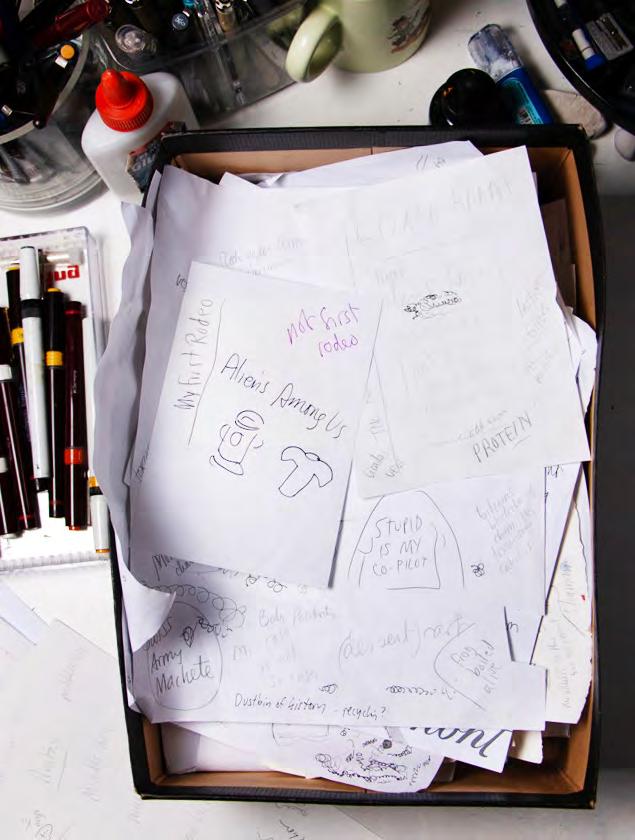
3
Dolut eliciisqui te volupti ne et fuga. Sit quiae.
grownup dancing. I hate to dance, but I wanted to see if she was paying any attention. So I’m like doing my mom dance and it was, mom, stop. You’re hurting me. And it made me laugh. So I asked if I could use that in a cartoon.
Another time I’m on Metro North, and there was an ad for –maybe it was Carvel – and there was a little girl, she’s wearing these cute cat-eye glasses, and she has a party hat on. And she’s blowing out the candles on the cake and on the cake it says, congratulations on your new glasses. And I just thought, we have set the bar low! So I had all these things, like ‘congratulations on your new armchair’ and ‘I’m so glad you’re not an arsonist.’

AM: Do these come to you fully blown? Or are you constantly revising these things once you’ve set them down?
RC: Depends. There are times – like when I saw an ‘End of the World’ guy. And I just wanted to draw one of those guys. So I did, and I thought: Oh, he needs a wife. So he has his the End is Near sign and she is next to him, looking like the female version of him. And she is carrying a sign that says, You wish.
AM: Do you keep these observations in a notebook?
RC: I’m not organized enough to keep a notebook. But I have these kinds of slips of paper in an idea box. There’s like thousands of them. A whole box of Nope, Slow Pour Coffee, Choose Your Own Adventure. And then an arrow. The entire box is nonsensical. [She pours notes out on her desk] Here, I’ll read you: Okay,
Concierge . This is circled and underlined like five times. Hacks. Semi heirloom tomatoes, Bitcoin fairy.
[Keeps reading] This one just says Podiatrist. Hmm. Niche audience. Big Hair. I did sell a cartoon with that idea. Little Red Riding Hood is visiting her grandmother in bed. And I had just been in Texas, where the women had like helmet heads. And the grandmother has this giant hairstyle, and Little Red Riding Hood says, um, what big hair you have…
Let’s see: Uber. Compassion fatigue. Chief Happines s Officer.
AM: Whe n you go back to these things, do you know what you’re talking about?
RC: Sometimes yes, sometimes no. A lot of the ideas happen when I’m actually working. When I’m at my desk. The ideas begin to percolate.
AM: So you sit down. And one of your scraps says Concierge.
RC: It made sense at the time. But now it… AM: So what do you do, do you run through different scenarios in your head, are you working
4 ROZ CHAST
THIS THOUGHT BECAME... Caption here tktkt tktktk tktktk tktkt
out language, are you starting to draw?
RC: It all happens simultaneously. Once I decided that the End of the World guy needed a wife, I knew what was going to be on the sign. Boom, done. But that’s rare. Most times, I draw, I write, I figure it out. I’m kind of immersed in it. One time I was chewing gum and I forgot, and the gum just actually fell out of my mouth. That’s really kind of a moment that lives on in time for me.
Cut Anyway, then a lot of what I do is cut. If I can say something in ten words as opposed to 50, it helps the joke.
Comedy has a lot to do with rhythm and how you tell a story. I’m not the most analytical person about this, I’m usually feeling my way blindly through something, but you see something, it seems better, sometimes you realize the other version was better, but you just look it over and decide-- I’m going to go with that, you know.
AM: Bec ause you’re really generating a lot of
these?
RC: At The New Yorker , we submit a group of cartoons a week, batches we call them-for me, that’s usually six or seven. So a lot of stuff I do just gets shoved aside. But if something gets rejected that I think is a good idea, I’ll resubmit it multiple times.

AM: Alt ered?
RC: Sure. If I think there’s an idea there I’m going to see if I can find a better way to tell the story. It’s kind of like if you were telling somebody a story and their attention wandered, you’d go into the time machine and try to tell it a better way. A lot of times, if I think something’s funny I’ll just keep at it. Being a cartoonist really involves stubbornness coupled with a kind of stupidity.
Child Is Good
AM: Do you have rules that help you?
RC: I have a friend whose kid is an artist, and she told me something that her kid once said. She was trying to show her daughter how to do something, and her daughter said: I want you to do it the child way. And that’s how I feel about work. I want to do it the child way. I want to do it how I want to do it.
I’m bad at stuff like cartoon lettering. I’m bad at straight lines. I’m bad at like, do a drawing and have a gag line.
AM: But you can actually draw very well. I was looking at your book Can’t We Talk About Something More Pleasant, and there are some really moving, sophisticated drawings of your mother. And it occurred to me that the visual style that you describe as clunky is a kind of construct. How did you come upon the visual voice of your cartoons?
RC: Hmm, well, when I was like 12 or 13, I started to feel my way toward something like how I draw now. That’s when I started to think, I’m going to be a cartoonist.
AM: Bu t then you went to art school. And I presume that they were teaching you all sorts of ways to draw “better.” Was it hard to hold on to this more primitive style of expression?
RC: Well before going to RISD [Rhode
5
THIS CARTOON Caption here ttktktk tktkt
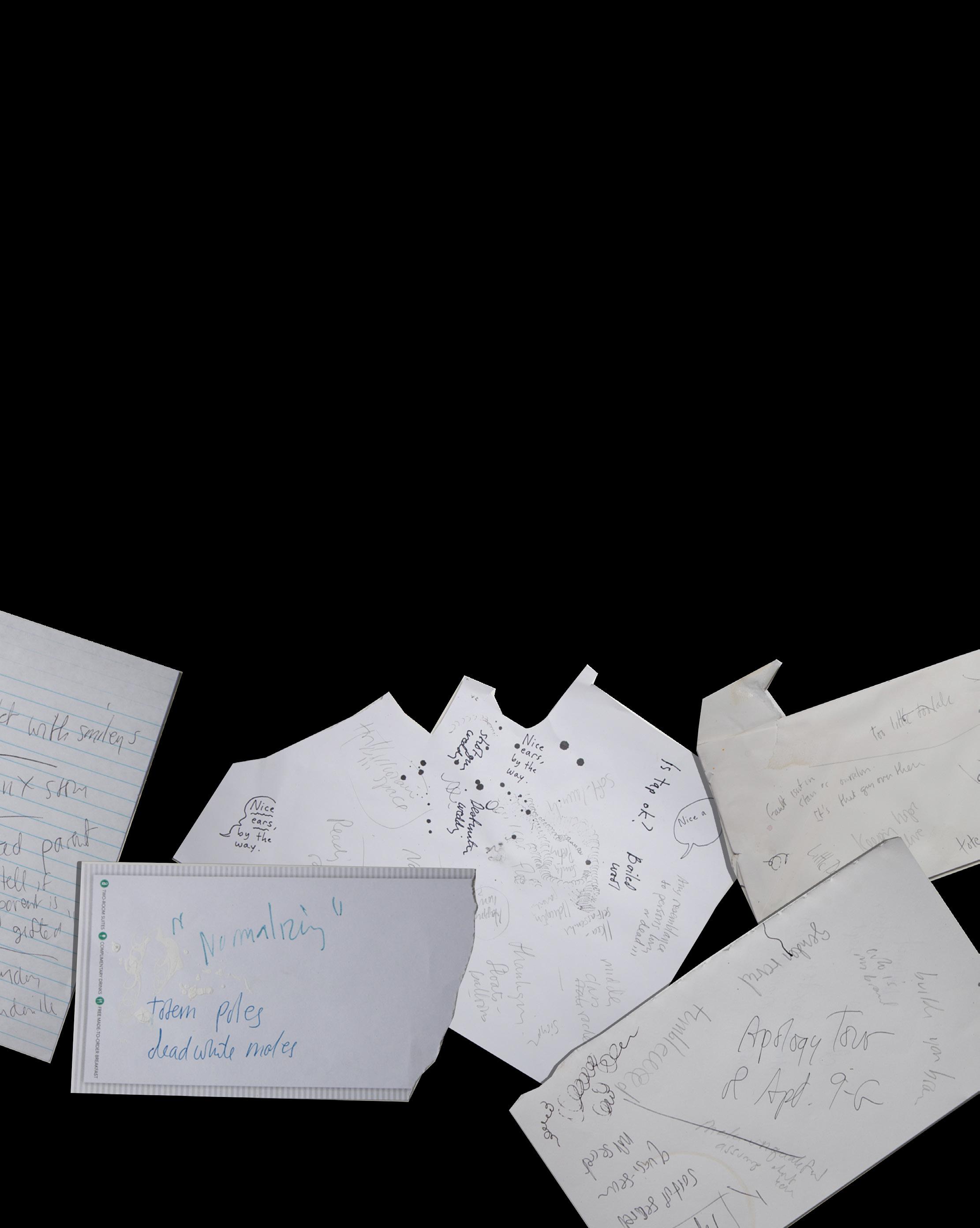
 MICHAEL CUNNINGHAM
MICHAEL CUNNINGHAM

“ Will Your Hand Do the Thing Your Mind Wants?”
born : 1956
ONE AFTERNOON I WAS sitting with Michael Cunningham in his writing studio, ransacking bags of old documents and opening countless files looking for evidence of the origins of his novel The Hours . This was before I started. Michael is a close friend, and I was leaning on our friendship for an experiment. I had been thinking about doing this book, and I wanted to see if my conceit would work – that the artifacts of something’s beginnings might yield insight into how an artist’s mind works. He was game, though he warned me he wasn’t sure what he’d saved-- the record of his work was kind of a mess. But he remembered his early thinking about the book (which, for reference, is three interweaving stories related to Virginia Woolf’s Mrs. Dalloway – Virginia Woolf writing it; a homemaker reading it; a contemporary “Clarrisa” named after it.) He explained:
“Everything about The Hours was a surprise to me.
“Originally it was going to be a contemporary version of Mrs. Dalloway , set in NYC among gay men. At the time I started writing there was a kind of gay Chelsea society that felt disconcertingly like the London society in which Clarissa Dalloway lived. Clarissa was 52 I think and I thought okay, this is about a gay party boy who turns 52, the age in which you are not considered young when viewed through any possible lens. Mrs. Dalloway is quite specifically set after World War I – subtly but clearly it is about the war. And so maybe my book would be set against the AIDS epidemic. (Which is why the character Richard, the poet in the finished book, is a casualty of AIDS. Richard incidentally was originally a woman.) Anyway, eventually I realized this wasn’t a necessary book; it was a riff on a great book. Why in the world would anyone need my gay Mrs. Dalloway when we’ve got the original goods? I might have that original draft somewhere. You lose track of how many drafts you go through.
“I decided it just had to be a story about a woman, a contemporary version of Mrs.
2
CUNNINGHAM
MICHAEL
occupation : Playwright/screenwriter
work : Angels in America
4
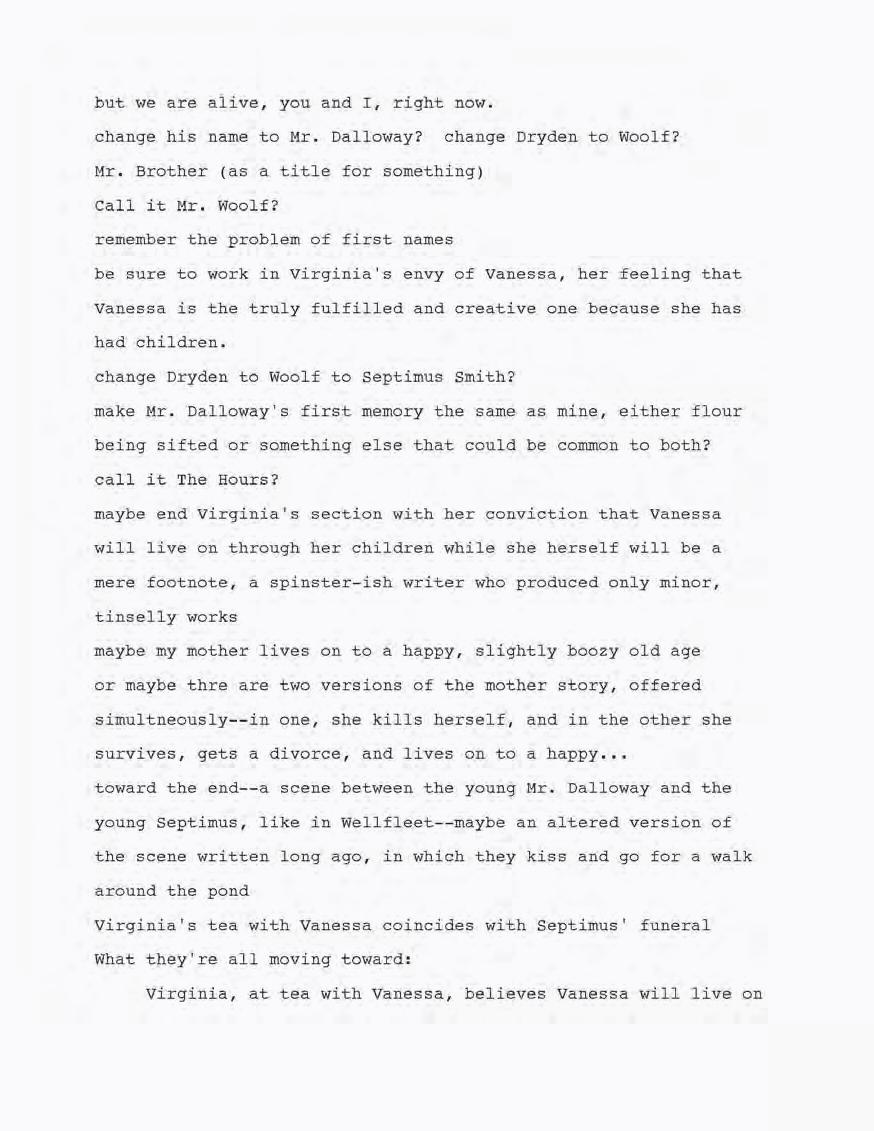
3
SELF
Dolut eliciisqui te volupti ne et fuga. Sit quiae.
THE HOURS, NOTES TO
Dalloway in which Mrs. Dalloway has many more options that she did in Wolff’s time. But that too felt more like an idea for a book than a book. So I toyed with bringing Virginia Wolff in it somehow. There was a while when I thought on the right-hand pages was going to be the contemporary version of Mrs. Dalloway and on the left side was going to be the story of Virginia Wolff writing Mrs. Dalloway.
“But all that wasn’t coming together; it felt academic and insufficiently alive and I was really about to give it up. I remember sitting in my studio ready to abandon the book. But I had put a year into it! So I gave it another try. I tried to figure out what about Mrs. Dalloway was was so compelling to me and my mother drifted into my head. And I realized eventually that my mother, as a homemaker, has always seemed to me to be trapped in a life that was too small for her. And if you look at it like this: two women, my mother and Virginia Wolff who each in their way were trying to do more than wa possible –Virginia Wolff writing Mrs. Dalloway and my mother baking a cake – then my mother gets to be in the book just as surely as Virginia Wolff. And that’s when the book started to come to be what it was.”
Michael and I went hunting in a small closet through garbage bags and boxes of paper looking for the traces of The Hours beginnings. We found just about everything else. But then somewhere in his computer drive he found the “gay” draft he wasn’t sure existed. Here
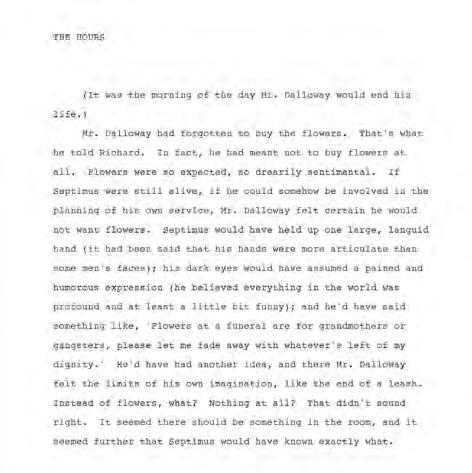
is how the book once began: And here is what that turned into:
Michael was surprised to see the gay draft. Even he didn’t remember much about this early version of what would become a Pulitzer Prize winning book and a Renee Fleming opera, a Dutch play and a Hollywood movie that would win an Oscar for Nicole Kidman for playing a part that wasn’t even imagined at the start. It’s impossible to imagine The Hours without Virginia Wolff. But there you have it.
Incidentally, we also found in our rummaging this list of notes to himself midway between the gay draft and the finished book – a particularly clear glimpse of a novelist’s constantly revising mind at work. You can see it on
Persistence, endurance – much of the work we revere wouldn’t exist if the artist hadn’t been spectacularly tenacious; I am certain pretty sure much anybody else would have moved on when Michael didn’t. But as I was listening to him and reading over his notes, I was struck by another quality as well: a Martian-like ability to be outside and inside himself at the same time. To look at his own work undefensively but critically; to say, nah, this is crap, but somehow (and this is what seemed impossible to me), not to annihilate himself in the process.
On Not Giving Up A year or so later I went to visit Michael again, tape recorder in hand. We were going to have another conversation about the book to fill in the
4 MICHAEL CUNNINGHAM
MR. DALLOWAY VERSION
gaps but also to talk this outside/inside
dynamic, why he doesn’t give up, the artist’s head, that sort of thing. It was an artificial conversation for us since we see each other often, though never on the record; the little red light of the tape gave structure to our usual meanderings (also, I cherry picked the conversation, though Michael does tend to speak in the perfectly formed paragraphs you see here).
This time we were in the apartment he shares with his husband the psychologist Ken Corbett. Michael had just given his new novel to Kenny to read. Kenny was visiting his mother so Michael was alone to fret. Michael often says that Kenny is his best reader, and he hadn’t shown this version of the novel to him (or anyone) for the years he’d been writing it. “I don’t worry, as I do with many people, that Kenny will read something bad and realize anything else I did was just a fluke, and this is terrible. It’s just, ‘God I hope he doesn’t effectively convince me that I have to rewrite the entire final third of it.’ But he might.”
THE HOURS, AS PUBLISHED
he had written the book in two parts, one set years after the other. And on that afternoon he’d just gotten off the phone with her. “She thought the second half of the book was just wrong,” he reported at the time, a little dazed. She told him he ought to junk it and start over. We were sitting on a beach. “Oh no,” I said, or something like that. I was devastated for him. But he took it in stride. “She was right,” he said, without a trace of self-pity. I was pretty sure that my response would have been to throw myself into the ocean.
To be typset tktktktktktkt
Sinum ipictin umquias susanih icimincimil molestiam aut et eos voluptate neseque cus, qui odignim aspiciis dolessitia voluptas molorectur?
Aque opta sendigene lacesti diatat. It magnimi, am quis minctur? Verat aut esto del ma dolupiet omnist ma pel et lamusam quam evelitio od que idit, conempor autaquas mos nonest laccaer ovitia volecatus, qui quaepre ptatiorectum aut ut expernat fuga. Itatus et, optas volut offic tet quid ut odio quistios eos experest, aut aute natem quae iliquib usandis quodio delest magnam hillent haris eum, et asped et et illacid eostrumque et accabori ut pos aspiduci con re sitia qui
“Yeah, it’s not what you want to hear.” he said, remembering. “But for me my fear of hearing ‘you have to throw out the whole second half’ is so overshadowed by the fear that no one will tell me it’s not working until it’s out in the world because you know, most books aren’t very good. I don’t feel very precious about it. I figure, well, there’s always more where that came from.”
I reminded him of an afternoon a couple, three, summers ago; he had just had a conversation with his agent about an earlier draft he’d given her to read. It was the same novel he’s just given to Kenny but only sort of – this one has taken a long time and gone through entire rethinks; in many ways he’d written several books searching for the right one. At that point,
I had known Michael for the sweep of his very accomplished career –met him was he was a struggling-ish writer (he did already have a published first novel he sort of didn’t acknowledge because he didn’t like it enough); celebrated with him when The New Yorker published his remarkable short story ‘White Angel’; and then again when that story became part of the much-loved book about a trio of friends called A Home at the End of the World; and again when he published his epic family novel Flesh and Blood; and especially when he won the Pulitzer Prize for The Hours. And then tried to console him when the Pulitzer
5
actually threw him into a funk. (“I was happy for three days and then depressed about it –for a long time. Which I’ve never fully understood, only, you know, it’s only downhill from here. I was surprised how bad I felt about it, and then I just came out of it. It’s obviously nice to win a Pulitzer, even if you do have some bad days about it.”
The Freedom of Low Expectations On this day, we sat in his open Brooklyn loft, and ate burritos. I turned on the tape. “Let’s talk about The Hours a little bit and then we’ll move on.” I said. “My memory of your state of mind before you set out to write the book was that you had written Flesh and Blood with the intention for it to be popular. And then when it wasn’t in the way you’d imagined, it kind of freed you up to write a personal, and-- you thought -little book.”
“Yes, that’s right.” Michael said. “ I mean, Flesh and Blood was the book that I wanted to write. But it was my impression – and the impression of the publisher – that this would be my big book. The thought was that Home at the End of the World was my solid midlist book and then this family saga was gonna really
sell. I don’t think anyone ever really knows why a book sells or doesn’t. But it didn’t. So I thought, well I’m not gonna be a best-selling writer. Which was disappointing and liberating at the same time. So when I wrote The Hours I thought, This will be a little arty book. That it will sell a few copies, then march with whatever dignity it can muster to the remainder’s table. Which was an opinion shared by the publisher.”
“All your many initial versions of The Hours involved Mrs. Dalloway in some fashion. You jettisoned one way to respond to the book after another, but you never departed from your intention to work off Mrs. Dalloway. What was so important to you about Mrs. Dalloway?”
“Well, Mrs. Dalloway was one of the first great books I read as a kid. Some girl I liked sort of urged me to read it. I’m not even sure I finished it because I couldn’t figure it out. What really struck me about it was the language. I had never seen language like that before. I didn’t know you could do that with a sentence. It was like you’ve grown up on the songs they sing in your village. And then someone takes you to a concert and they’re playing Beethoven, and you just think, what
“I need to write first thing in the morning. I need to segue from sleep and dreams directly into this invented world of mine because part of the deal is maintaining for several years your belief in this world and if I were to even run a few errands before I got to work I’d get derailed. I’d get so lost in the realness of the real world that when I turn on the computer and look at what I’ve been writing, I think well this isn’t as deep and mecurious as the dry cleaner – or the drug store, or wherever else I’ve just been. I write for about four, five hours, after which there’s nothing there anymore. But I also learned that for me it was gong to be much more helpful to think in terms of time spent as opposed to page limit – because if you just have to produce words and you write too much of what you know is crap-- and there are those days-- then you are in danger of losing faith in your book. But if I am in my chair, ready to write whatever arrives – 10 pages or one sentence-- I’ve fulfilled my commitment. The next day I read what I wrote, catch up with myself. For me it’s as much about the language as it is about the story, and I find myself needing a solid sentence to stand on in order to move forward. I usually have some idea of what I’m going to write that day. Although we have complicated feelings about Ernest Hemingway he said a great thing that I read early on: ‘always stop writing for the day when you feel you have more to write,’ so you’re eager to get back to it. I try to do that. As for writing environment, I have a studio that’s not where I live, that I go to everyday. I’m not one of those delicate creatures where if a dog barks that’s it, but I do need to be in a fairly familiar place so the background sort of fades away. I can’t write in a coffehouse for instance. I just need to be in a space capsule.”
6 MICHAEL CUNNINGHAM
A ROUTINE
the fuck?”
“In high school were you dabbling with writing at all?”
“No, I was more of a visual arts kid.”
I said, “I remember from when we took a drawing class together that you were pretty good.”
“I guess. But it didn’t turn out to be a sufficiently driving passion. When I got to college, thinking I was going to study art, there were some people in the classes I took who were not only really gifted but who were bottomlessly interested in the fundamental proposition of trying to produce something that was alive. And I just wasn’t as indefatigable as they were. I would get discouraged and give up. The girl next to me would get discouraged and start over again.”
“Were you intimidated by their levels of prowess?” I asked. “Were they just more talented than you were at drawing and painting?”
Interest, Not Talent “I think it’s really hard to comfortably separate talent from this unquenchable interest in the problem presented by the task.” I hadn’t thought about it that way – as interest rather than talent. Michael continued. “Like they never got tired of trying to paint. And I started writing and realized that I felt that way about writing. That the fundamental question, can you do some sort of justice to life using only words and ink, was endlessly interesting to me. But then sure, some people are able to produce unthinkingly a squiggle that has a kind of life. That I couldn’t do. There’s a question of I guess I’ll call it athleticism. Will your hand actually do the thing that you have in your mind? So I’m starting to write and at the same time beginning to wonder if I really possess what a serious visual artist possesses.”
“And writing came easier to you?”
“I didn’t feel instantly brilliant at it. I was pretty good. I was good with language. My sense of my ability to write still comes and goes. It depends on the day. But I don’t know if I’ve ever in all these years lost that fundamental
interest in the proposition, here’s ink, paper, words in a dictionary.”
We returned to The Hours. He’d made a lot of notes, some of which you’ve just seen. And he didn’t really mention his idea to anyone, including Kenny. . . “for the practical reason that no matter how intimate the person you might talk to about it, you need to maintain your faith in the story you are about to spend god knows how long writing, and there’s no surer way that I know to lose faith than by summing it up too soon. ‘It’s about a guy, a whale bit off his leg, he’s really mad.” Michael laughs in the big bellowing way he does.
“So we talked before about cycling through various versions--” He’d just told me another one, where his version of a day in a Mrs. Dalloway’s life would be accompanied by notes to himself, another device he soon realized “was pretentious and uninteresting.”
Getting Stuck “So many false tries.” We finally got around to the question. “Why didn’t you just give the book up?”
“You know, just this endless determination. By then I had written enough to know that most of the time you get to a certain point in a book you want to give it up. And to write another book that won’t cause me the same trouble. And it does. You just end up stuck all over again. So you might as well stay with the thing.”
“And you always get stuck?...”
“It took me a while to realize that if a novel is any good, it’s going to defeat what little idea that took you into it in the first place. And sometimes your experience of it not working out is it taking on a life of its own, going in a direction that’s more interesting and complicated than what got you there. And I suppose that’s what happened here. I realized it was really a book about women and I just felt like, lose the gay man thing, and then what we talked about before, about my mother’s labors set against Virginia Woolf’s.”
We got into a discussion of the novel’s particulars, which I was especially interested in
7
because I had just reread the book before coming over – putting Virginia Woolf’s suicide at the beginning for instance, which he’d told me was a late decision he made so her eventual suicide (which he felt it was necessary to include) wouldn’t hang over the book. I asked him about another one (I suppose this requires a spoiler alert), a surprise plot device Michael employs at the end of his book which ties together two of the threads: the son of the mother character in one of the intertwined stories is revealed to be, grown-up, the suicidal poet in the other. I’d read the book maybe three times and seen the movie, but it still startled me reading the book again – and I wondered how that simple, effective narrative move came about.
“That came late too. I felt for the longest time like, I don’t how these strands are going to meet. And one day I just saw this, and I thought hmmm. And I thought you know, let’s give it a shot, even though I was sure everyone was going to see it coming. And I was surprised as anybody that people were surprised by it.”
“And when you come up with a solution like that, are you elated? I mean, emotionally, does it feel satisfying?”
“Oh, certainly not elation. An element of relief. But throughout this book – I always feel this but maybe more so with this one – I thought, this is probably terrible. And I showed it to a lot of people, waiting for someone to say, ‘this is just a contraption with an obvious ending. Don’t publish this.’ And people kept not saying that.”
“What were you so worried about, this contrivance?”
“Oh you know, I find it easiest just to worry about everything..—
“That I had Virginia Wolff wrong.” he continued. “That, you know, how dare I as a man... But also, the time it takes to write a novel inevitably requires a level of familiarity with it that makes it almost impossible to imagine that it could be interesting to anybody. Going over it the hundredth time,
you can’t possibly know what it would be like reading it the first time.”
“And it is inevitable that a book will start to bore you?”
“No, that’s not it. I haven’t had a novel begin to bore me. And that’s probably because I keep thinking I will find a way to make it better. But you know it’s also true that you don’t want to take forever to write a novel because you don’t want to get to the point where the book ceases to be – I guess, you just don’t want to outgrow it.”
The Better Book in Your Head “I was really struck on rereading the book,” I said, “how much you underscore the theme of having something in your head that is impossible to realize. It comes up in a couple of contexts.” I wondered if that gulf was particularly frustrating to him as he was writing this book.
“You always have a better book in mind than you’re able to write. And one of the things you have to be able to do, if you’re going to write novels, is survive that discrepancy between the book you were able to write and the better book you imagined.”
“Is there a mood you’re in that you feels to you the most productive – or the most doomed for that matter?
“There are better days and lesser days. What varies the most is the degree to which the aperture is open or closed.”
“What do you mean – the aperture?”
“Whatever is coming through is either coming through in gushes or dribbles. But the dribbles are about as good as the gushes.”
“Let’s go back to what you called athleticism before.” In all my conversations I kept trying to understand where talent comes from, to no avail. I thought maybe Michael, who is fond of what he calls ‘crackpot theories’ might offer one. “You want to take a stab and describe what you think talent is, or where it comes from?” I asked. Michael didn’t really bite.
“As I mentioned before, it’s hard to separate talent from the almost spectrumy degree of endless interest in something.”
8 MICHAEL CUNNINGHAM
“All your years of teaching haven’t led to any theories as to why certain people have facility and others don’t?”
“Honestly my sense based on all the writers I’ve worked with is that the aliens aimed a beam of light at some of you, and I don’t know why. And I think the actual visceral experience of a lot of people who have some kind of gift is, What, everybody can’t do that?’”
I wanted to talk about age, since he’d mentioned it before in relation to Clarissa and he and I talk about the subject a lot in every possible context. “Do you feel anything gets different for you in your work as you age?”
“So far, I don’t feel a significant difference. I feel it lies ahead. It’s impossible to separate aging from the passage of time. So I find I’m a little less interested in lyricism for instance.”
“Just changing taste, then.” I said. “What about experience? Is experience always good --”
“Like do you sacrifice a kind of reckless --”
“Exactly. Are there things that come to you when you don’t know better?”
“Sometimes. And sometimes you’re writing pretentious shit. But take Walt Whitman. He spent all his life rewriting Leaves of Grass. And the first edition is on the one hand not as accomplished as the final edition. And yet the first edition has a kind of naive vigor that’s not in the ninth edition. I don’t know how you can fail not to be a little nervous about that. One of the reasons I love Philip Roth is those later books are some of the best stuff he’s written, it’s the work of a mature writer.”
I told him I was struck with the number of times in our conversations about writing that he swatted away feelings of satisfaction with his work. Didn’t he have any ? “Do you ever experience happiness in what you write?” I ask.
“I think if you didn’t, why would you do it? No, absolutely, the good moments range from ‘that’s a really good line’ to when you’re walking around, you think of something and you have to get back home to write it down.”
Happiness, it turned out, was all anticipation.
“Because the best times,” he said, “are while you’re working on it, you’re still imagining what it might be. And it feels like it could be anything.”
9

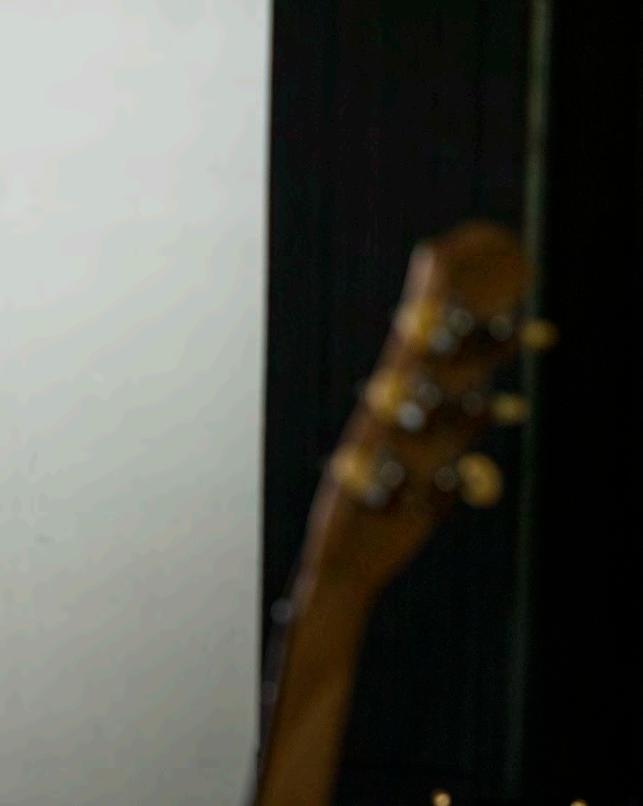
MOSES SUMNEY
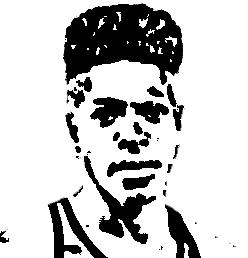
God Flows Through Him
AT SOME POINT IN EVERY ONE of these conversations, the source of an inspiration would come up, and I would ask, as a matter of habit and curiosity, somewhere between a philosophical query and a party game, where the subject I was talking to thought the inspiration came from. And most people would say the unconscious or something like that. But then, every once in a while, someone would mention God. Or the heavens. Or some otherworldly origin. Both the poets in this book. And Moses Sumney. “It comes from God absolutely,” he explained, a little surprised by the question. “It feels like it’s floating through.”

Moses is a singer and songwriter with an ethereal falsetto voice who sings songs that blur genre—soul, a little pop, some jazz inflection, maybe gospel, experimental but melodic. He talks a lot about resisting genre distinctions. But even with the divine lilt of his sound, I’ve always found him pretty secular since most of his subject matter is earthy—concerned with social justice and the like – and I (and everybody else) find him corporal and alluring, an indie sexpot. It wasn’t until I listened to the tape of our conversation over and over that I began to hear how spiritual he really is, how God seeps into pretty much his every utterance, especially about making music. I was especially moved by how, as an adolescent, when he was afraid of losing his falsetto, he prayed and prayed to God to hold on to it. Which God apparently answered.
Anyway, I shouldn’t have really been surprised. Moses is the son of two pastors, who were from Ghana (and took Moses and his sister back to Ghana for a
2 MOSES SUMNEY
occupation :
work : In a River born : 1983 5
Figure 1 – teekay
First Lastname
WORKING OUT ‘DOOMED’: TWO TRIES, Figure 1 – teekay
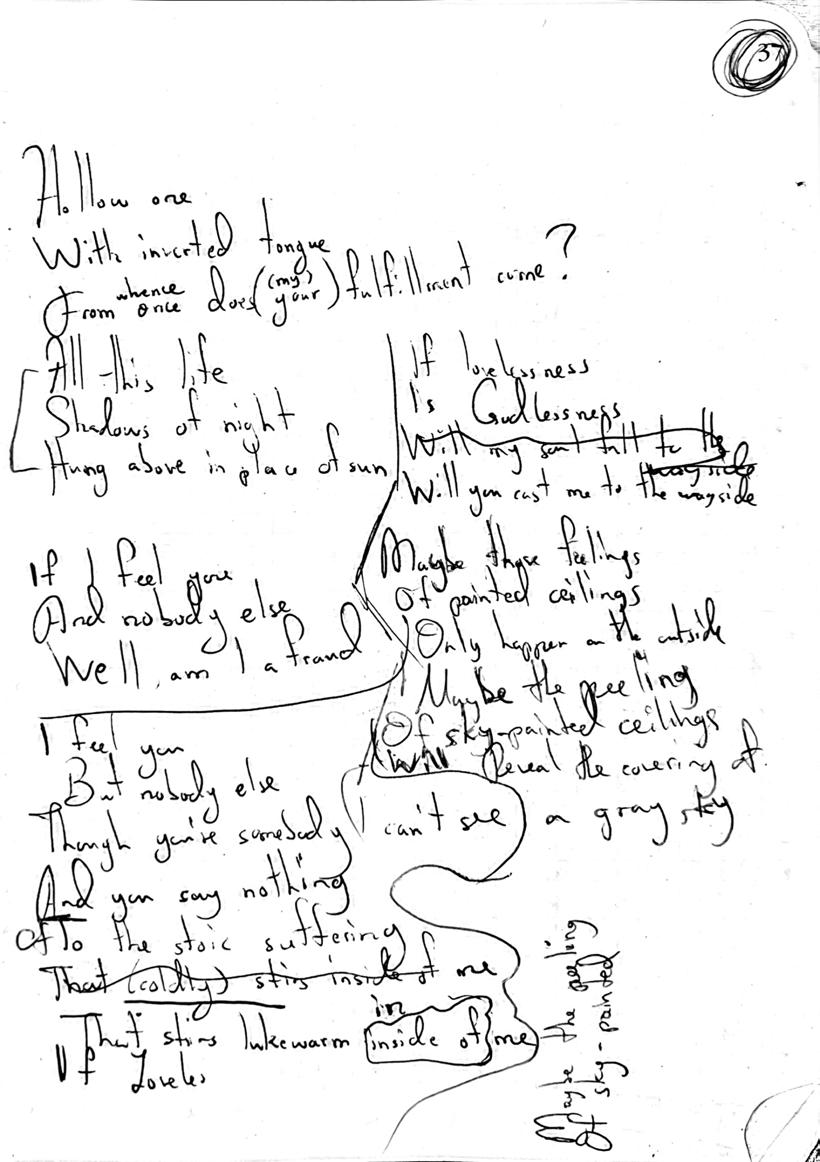
3
chunk of his youth). He started singing in a choir. And the song he chose to trace, from his first full-length album, Aromanticism, addressing his inability to love, is called ‘Doomed’ –as in, “Am I doomed,?” a plaintive question he asks of God.
In the church growing up, where my parents were pastors, there was a lot of gospel music. There were a few African gospel songs too because my parents were Ghanian, and they ran a kind of Ghanianish church in San Bernadino. In the house they played gospel and reggae, which was not my flavor. My sister listened to a lot of pop music and r&b – Destiny’s Child and Usher, whatever the music of the day was. And I was somehow very into country music. I exclusively listened to country music as a child. Martina McBride, Tim McGraw, and of course Shania Twain.
I was a very introspective, quiet child and I didn’t really have any friends. So I would just listen to country music in my bedroom. My first memory of wanting to be a singer was one day when we were at church – we went to church every day, because that’s where my parents worked from, day care was the back of the church—and my Dad used to record his messages. So there was a tape machine. And he let me and my sister record our voices. And I remember [he sings/heavenly] I just recorded my voice. In the car my Dad let us listen to the tape. And hearing my voice back on tape, I had the realization that that’s what I wanted to do forever. And then I started to mess around with writing songs. Again, privately in my bedroom. I never fantasized about being a country singer. It must have crossed my mind, because that’s what I was listening to. But I do remember telling my dad I was going to be a singer. And him laughing and saying, “are you going to be like the first black country singer?” I think that was my first concept of having genre presented as a problem.
MOSES SUMNEY:
His First Songs I’ve always just made up melodies. One day, I must have been around seven,
I wrote a song called “One Night Stand.” The lyrics were something like “a one night stand for a one night man.” You know, I truly had no clue what it meant. I held it very closely. I thought, Oh God, this is my first song. So I would take it with me everywhere. I went to a private Christian school. And one day I left [the lyrics] at the lunch table. One of the older kids found it, and told on me. I was a really good kid, I was probably the most well-behaved child you ever met. And the teacher came up to me, and said ‘I know this isn’t you. This was a mistake. We’re gonna just throw it away. I’m not gonna tell, just don’t do that again.’
And then again at the lunch table, I remember finding a poem. Someone had written it and left it there. It was called “Nobody.” It was really sad. It went something like, ‘Nobody loves me. Nobody cares. Nobody brings me peaches and pears. Nobody listens and laughs at my jokes. Nobody brings me hope.’ I haven’t actually tried to recall it since I was a kid. But I remember feeling like I related to it because I was such a loner. I was like, this is a bit dramatic but I can get into it. And I put music to it. And in my head, that was my song too. I would sing it to myself all the time. I never sang it for anyone else, ever.
So that was when I was seven, and then I went on a hiatus after that. Took a fiveyear break. You know, I needed to step away. [laughs] And then we moved to Ghana. And I had a best friend who knew that I wanted to be a singer. One day he came to school with a song he had handwritten. He said, “Check out this song I wrote,” singing it to me, reading it to me. And I was, huh, ‘You don’t write songs. I write them. I’m the songwriter.’ I was very offended. Then I thought, wait, I haven’t been writing songs all these years. And I went home and started to write. Instantly a song came out. It was called “Mesmerizing Eyes.” Genre-wise, it was an R&B pop song, like late 90s Boys2Men. A love song. ‘I’m looking into a girl’s mesmerizing eyes.’ What did I know about mesmerizing eyes? I showed it
4 MOSES SUMNEY
When I really have something to write about, I’ll journal. When I’m working on a record I journal lot more, trying to think about a song, what is this about, what is this title trying to say. Then I’ll write my way around finding it.

any instruments so they were all a capella. But I had an incredible memory for melody, still do. I can hear something once and recall it, years later. I wrote in my bedroom and on the way to school, which was about an hour a half away from my home: I would just sit in my corner in the back of the bus with my little notebook and just write. I’d hear melodies in my head, and I’d write some words down just so I could remember – maybe I’d write a title. Over the course of the month – because I have my quota! – I would come back to the songs. This sounds like a verse, this sounds like a bridge, this sounds like a chorus.’ If I got to the end of the month and I had only had two, I’d think, all right, gotta write another one. And bang it out.
to my friend, said ‘Check this out.’ He was, ‘you’re still on that? I lied. I didn’t write that song, that was a Westlife song.’ [Westlife is an Irish band.]
So I really learned, you don’t tell people you want to be a singer. Because that’s just silly. I devised this plan where I thought, I’m just gonna write songs. I’m going to practice singing. I’m going to make beats. And I’m going to do it all privately.
I bought a notebook. And I gave myself a quota that I had to write at least three or four songs a month. Nothing crazy. But they were detailed. I didn’t record them. I didn’t play
In the early days I was taking my cues from pop music. Most of my songs were love songs. And it wasn’t until I discovered the music of India Arie at around 14 where I completely changed my approach to songwriting. That was the first time I had ever heard someone write about something deeper. She had a song called Brown Skin. I remember an interview with her; I had never heard anyone talking about brown skin and celebrating it. I was dark-skinned. I had never felt attractive, and I knew that was connected to how dark my skin was. I remember her talking about how music was a tool for healing. And I realized my purpose as a songwriter is to talk about stuff, to write meaningfully – whatever it needs to be, it needs to be deep.
There was one song – I probably shouldn’t tell this story, but oh, I don’t care – called ‘Little Girl’ that was inspired by my sister, who was... let’s call her grown for her age. She was a gorgeous teenager, and she would hang out with the older men, and I could see how detrimental this was to her spiritually. So I wrote the song about the culture of young women who were wooed by older rich men. I think I can remember it, “Little girl, little girl, she gets all the diamonds and pearls, she acts way too big in the world, little girl.” The bridge was something like “but look at this other life
5
HIS JOURNAL
you could have.” And “you’re so beautiful and wonderful, don’t lose it all.”
His Voice I was not aware of the voice that people know until I was well into my twenties. I was a bass. I sang bass in the choir –this register you hear me speaking in. The falsetto developed because when I was a child I had a really high voice, a really high singing voice, and when I hit puberty – I was quite late, it didn’t really happen until I was like 15 or 16. And I could sing whistle notes at that age. Mind you, this is all me alone in my bedroom being like [sings]; I think that’s a high note—am I crazy? When I hit puberty I was really afraid I would lose my upper register. Because I knew that was something unique about me. And I started praying, like actually praying to God, please don’t let me lose my falsetto. And then my voice dropped really low. And so I obsessively practiced singing in falsetto so that I wouldn’t lose it.
Hollow one
With inverted tongue
From whence does fulfillment come?
When I expel
From this mortal shell
Will I die for living numb?
Am I vital
If my heart is idle?
Am I doomed?
Am I vital
If my heart is idle?
Am I doomed?
I feel you
But nobody else
Though you’re someone I can’t see
Yet you say nothing
Of the stoic suffering
That stirs lukewarm in me
If lovelessness is godlessness
Will you cast me to the wayside?
Well, I feel the peeling
Of half-painted ceilings
Reveal the covering of a blank sky
Am I vital
If my heart is idle?
Am I doomed?
Cradle me
So I can see
If I’m doomed
Am I vital
If my heart is idle?
Am I doomed?
Cradle me
So I can see
If I’m doomed
Am I vital
Because I was so introverted in my process, I perfected singing quietly. And when you go to sing quietly singing in falsetto makes the most sense because it’s the quietest part of your voice. I practiced for years. When I say I wasn’t aware of my voice, it’s because I wasn’t performing. I had no real gauge if I was a good singer or not.I had a feeling. And I had faith and hope. Later when I was in college and singing solo for the first time I started to sing falsetto publicly. Singing in my chest voice was always kind of hard and scary. Falsetto was a comfort zone, because I had rehearsed it so much.
If my heart is idle
Am I doomed?
Am I Doomed? I named the album Aromanticism before I started to write it. I knew that was what I wanted to talk about. It became a thesis, just cool for writing; I need a thesis. With every song I wrote, I would ask myself how does this relate to the theme? I had written probably about 30 songs. Then after 13 or so months, I got the initial idea for this song.
Most of the songs were guitar-based, because I had learned guitar and that’s what I could play on my own. And I wanted to write something hymnal, that felt meditative, and
6 MOSES SUMNEY
FINAL LYRICS: TEEKAY
melodically unlinear- I remember listening specifically to Dust and Water by Antony and the Johnsons, which doesn’t come back a lot melodically. And it was meditative and beautiful. I was working with a producer named Matt Odom and I brought him all these inspirational songs. I told him, I want to do something simple, just synth and a voice. And I don’t know what it’s going to be about, but let’s find it.
My music up to this point was so complex, chord-wise, I was always writing jazz chords and these sevens and trying to be really musical. I think I realized that all those years of not being able to play an instrument gave me a little bit of a complex, so when I learned the guitar I thought they had to be complicated. Earlier that year, I had been opening with Sufijan Stevens; in sound check one day, he came over to me and said ‘why do your songs have so many jazz chords?’ And I was actually horrified by the question. He just walked away. Clearly it stuck with me. I said to Matt, ‘I need
a song that’s just four chords, triads, C,A, F, G.’ I call them basic bitch chords.
And I said, no minor chords and I’m gonna make it sad as hell. And the challenge is to make a major chord sound really sad- like saccharine sadness. We edited down this loop of four chords. Most of my songs come about singing gibberish, trying to access this plane where it flows and see what comes out. And I did this like six minute pass. And held that [sings] doooooom note. We’d opened the door of the studio, it was the only way to get air in. And as I finished the note, the sky opened and it started to pour. The sun was shining but it was pouring. And that just felt like a sign from God that I had found it. That was one pass. Usually it’s like fifty passes, trying to figure out the melody.
I didn’t write the lyrics until about a year later. And in the meantime I was thinking about it every day. Some songs you write quickly –the next song on the record, Indulge Me -- top to bottom, including recording the vocals, took
7
CAPTION KICKER TEEKAY Figure 1 – teekay Figure 1 – teekay
about 30 minutes. But for Doomed, I didn’t know what it was about but I could feel it. And it also felt hefty; those lyrics had to be damn good. And so what I did was to start performing it. I probably performed it for a year without words. People came up to me and said Doomed, that was my favorite song, I couldn’t stop crying. I’m like, the one with the wordless mumbles? I think someone said, I think you could work on your diction a little bit. I said, I was legitimately singing mumbles, so don’t worry.
We performed a lot of different versions of it, with a three-part horn section and a guitarist, and then I did an orchestral version, and then one based on vocal loops. It was interesting to see that it could survive all these iterations and still hold weight as a song. As much as the lyrics are important to that song, the feeling mattered more. What’s really beautiful is seeing how spiritually you know what something is about without being told. That’s an incredible thing to learn about human nature, or the ear, or the mind, whatever it was. But the lyric writing was always going to have to be the most introspective lyric writing I’ve ever done, and I think to date it still is.
I think I felt it was about God from day one. The hymnal quality. And those thunder showers. All right God, I’ll make this about you. You want attention so bad. And of course
I knew that I was addressing aromanticism as a concept, so putting those two together was really interesting. What does it mean to feel lovelessness but still feel God, or the concept of God. Like if you can’t love your brother, how can you love God? And that was scary to me because at the time I was like, oh yeah I love God. I don’t know about you other hos but I love God. But the first phrase that really came is, Am I doomed? Quite the existential question.
I sat with that for a really long time. And there’s this meditation center called Self Realization Fellowship Center in LA which is like an open park, I would kind of walk there in the mountains and read, and just think about this song. I really wanted it be honest. Whenever I tried to push it lyrically it would just be too much, too weighty, too woe is me, or eternal damnation. And finally I got to that phrase, “if lovelessness is godlessness will you cast me to the side?” Although it’s not the last lyric of the song, it was the missing piece. Vocally we weren’t going to add much. At one point I asked, is there a string arrangement? A horn arrangement? And then there was the realization that oh, no. It was just two tracks, which for my music is crazy. Seeing how minimal it could be was a light bulb. And I think finishing Doomed was the realization that the record was worthy of being heard.
There are two jobs to songwriting – writing the music and lyricism. My way of being is very different in both. It’s almost like I’m a different person honestly. Lyricism is very serious. “Don’t look at me, grrr.” Lyricism has to be inspired. The channel has to be really, really clear. Music writing is more fun, more exploratory. And I do it with other people a lot of the time. On guitar it can be really meditative. On piano it’s more curious, like solving a math problem. Collaboratively it’s just fun. “Oh what about that? Whoa, that’s cool!” Even if it’s a deathly bad song. These days there are places I just can’t write. Big cities don’t really work for me. I’ve got to go off to the mountains, I’ve got to be alone. Sometimes I have to be alone for days before the clarity presents itself. Really, it’s just kind of sitting there waiting for the inspiration to strike. Waiting is so central. And when it comes it’s just fwoosh.
8 MOSES SUMNEY
THE DIFFERENCE BETWEEN WRITING LYRICS AND MUSIC

9
CAPTION KICKER TEEKAY Figure 1 – teekay Figure 1 – teekay
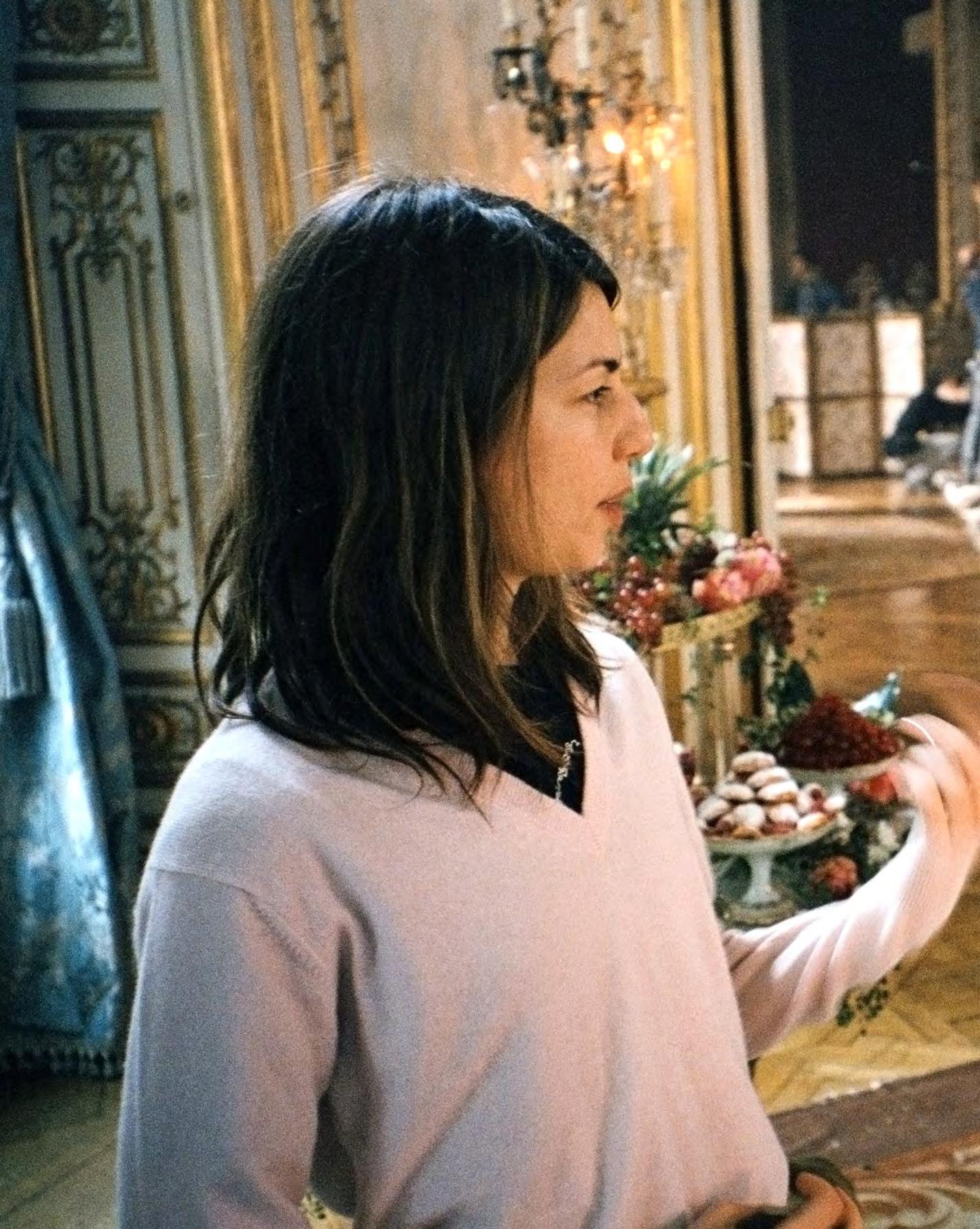

occupation : Filmmaker
work : Lost in Translation/ Marie Antoinette born : 1971
I’D INTERVIEWED SOFIA COPPOLA BEFORE, in Los Angeles for a New York event. She was lovely, demure but forthright, just as she was when we zoomed for this conversation. When I talked to her, she was in Belize, I think, shrouded in fronds.
Sofia, who is the daughter of Francis Ford Coppola, had a childhood of privilege, which only makes her emergence as a major filmmaker that much more impressive to me, though no one’s young years are simple and God knows plenty of people raised in comfort have become serious artists. She acted in her father’s movies and others, and was drummed out of life in front of a camera after the negative reaction to her role in Godfather III , which she has always said she took just to help her father out. She appeared in music videos, did projects with famous friends, became a kind of muse to Marc Jacobs.
2 SOPHIA COPPOLA
It certainly was a charmed-seeming life, but she was attracted to work, and tried her hand at directing movies, her father’s business. To her own surprise, she was stunningly good at it. She had a gorgeous eye, an intuition for when to restrain and when to go all out, a feel for how to integrate pop music and style into serious movie-making in a way that felt brand-new. She made The Virgin Suicides, and then embarked on two projects simultaneously, Lost in Translation , which emerged out of her own experience as a tourist in Tokyo, and Marie Antoinette, which she adapted from a biography by Antonia Fraser, and in which, it seems from her description below, she recognized aspects of herself. She fused the story of Marie and Louis XVI with the music of her own youth; the attitude of the movie is joltingly contemporary, which involved enormous artistic risk. But she was unflinching-she lacks the persona of one, but she is a very courageous filmmaker. Since then, she’s made many more movies ( Somewhere , The Bling Ring , The Beguiled , On the Rocks ), as well as some visually adventurous commercials in the same style, but we focused on the period when fresh from the success of her first movie, she 6
SOFIA COPPOLA Later You’ll Understand
turned to Marie Antoinette and Lost in Translation , each feeding the other, the first which got a middling reception but only grows in reputation, and latter of which became an instant classic and would win her an Academy Award.

SOFIA COPPOLA:
I wasn’t ever planning on being a film director. And then I made Virgin Suicides , and I enjoyed it and it turned out I knew how to do it, strangely enough. I was like 29. Throughout my twenties I spent a lot of time going to Tokyo with my friends. I had a little clothing
line, Kim Gordon was doing X-Girl [fn1 ] and I helped do fashion shows for them. And the world was more separate back then – like, did the Internet exist? It was another planet. So I had this idea in my head that I wanted to do something about what it feels like to be in Tokyo as a foreigner. It was very abstract. I started collecting images and writing little notes for scenes.
At the same time I was thinking about Marie Antoinette. I would get stuck on one project, then I would go to work on the other, and when that got stuck I’d go back again, back and forth. That was helpful. I’d heard about
3
TKTKTKT HEADER Ebit od quos vendaes essimustia vit perspero cumquae. Cerore, sit, et mincto occusandande sedissita qui offic temporiam aliquaecusUr? Qui volupid maio molum veliat. Bus, sum excepud itasit volumquid molupta ectiurit ad maiorrovit, quuntio qui alitae natiaes magnihil maximus.
Antonia Fraser’s take on Marie Antoinette [ fn 2 ], and it intrigued me. I loved that Antonia was more sympathetic to her, and the book imagined her point of view as a fourteen year old girl being handed over to the French, them taking away her underwear and her dog. The period was appealing to me, being a teenager during the New Romantic Period, Galliano did a collection around it, I always liked the decadence of the period. So I was reading the book and I visited Versailles, and they took me on a private tour of her private apartments. The scale is small and very human. Marie Antoniette is a famous villain but she was also a young girl who was trying to please everyone. And I thought Kirsten Dunst, who I worked with on Virgin Suicides, could play her, could be her as a teenager – she has an adorable side that would help. .And then I’m very motivated by visuals, and seeing Versailles was inspiring.
So I was going back and forth. When you’re writing you have bursts of excitement and then moments of being really down and it’s terrible. But instead of just sitting in despair, I would go to the other project. Lost in Translation was an original screenplay. And for me, that’s much much harder because you have nowhere to look, no roadmap. I just gathered little moments – the script is really a series of little moments. My inspiration was Richard Brautigan [fn3] whose poems were little moments – my brother and I called writing the script this way “Brautigan-style.” It was kind of like ‘Charlotte and Bob [fn4] meet for shabu- shabu and it doesn’t go well, and then here’s one line that they say.’ As I say, just moments.
And it really just started with Tokyo. I was newly married when I would go over there and I was not feeling connected in my marriage. So I was lonely and drifting and it was just sort of a fantasy that Bill Murray would show up at the bar. And I mean, really Bill Murray. I wrote it for him and I wasn’t going to make it without him. I find actors really motivating, like visuals – picturing the actor. So there I was, in LA where I didn’t feel connected, and
then with my friends in Tokyo, where we were having a really interesting time – I was just trying to understand it. I think for a lot of creative people, they’re just trying to figure out what they’re going through. I started thinking about Bill Murray because you meet different travelers insulated in a hotel, and I could just see him in a kimono and being too tall in this small world. And I had known people having mid-life crises in their forties or whatever and I just combined them, two people having crises together. But I had never written an original screenplay. I remember having a moment where, like I don’t know what happens next! And then I was walking, I tripped and broke my toe, and I was like, that’s it. I’ll just put that in the script: she breaks her toe and he has to take her to the hospital. You just think you’re faking it, making stuff up out of the air, and then it becomes the story.
But mostly when I didn’t know what would happen next, I would turn to Marie Antoinette-- which was more like... homework. I’m not a good reader, but Antonia Fraser was really friendly to me, so I would talk to her about it. I’d ask, do you really think she had an affair with Axel von Fersen? [fn5] And Antonia would say, I hope she did! Antonia’s a really fun spirit. I didn’t want to make a historical film. Some people interpreted that as if I were being vapid, but you know Marie Antoinette was interested in beauty and friends and her children and nature, and I was really trying to make it from her point of view. The scenes I struggled with most were the small scenes I had to have with some official people talking about what was going on. I just felt like it’s not my thing. I tried to write through to Marie Antoniette at the Conciergerie [fn6] later –what’s touching about her is that she really does grow into herself as a dignified person in the last part of her life, when her son is taken away. It’s so sad. But I didn’t want to film in a prison cell – it just felt like a whole other movie. So I decided to end her story when they leave Versailles. It became clear to me that the movie was a coming of age story, about
4 SOPHIA COPPOLA
Offic temporiam aliquaecusUr? Qui volupid maio molum veliat. Bus, sum excepud itasit volumquid molupta ectiurit ad.

5
her transition from girl to woman.
And so in the end, the party’s over, her bedroom is trashed after the revolution, and it’s like the room is really trashed. They were living in their fantasy world as the world outside was falling apart. I always find those kind of stories – this kind of decadence is fascinating to me.


And throughout, what that room looked like was incredibly important. I look at photos when I’m starting a project. I remember going to the Metropolitan Museum of Art’s Costume Institute and Andrew Bolton [fn7] showing me some dresses from that period. And I was struck by how the colors were brighter than you would expect. Marc Jacobs did a collection that was based on the color of the Laduree macarons-- bright, sherberty colors. And the music – I was a teenager in the eighties and was into the whole New Romantic moment, and I was thinking her teenage years can be informed by that. I could tap into my teen childhood imagination and do the movie as if it was like a video for one of those bands. I knew it was obnoxious. I knew the French would probably have problems with it – and with an American girl tackling French history. I just did not want to do it like Masterpiece Theatre . I was probably overcompensating.
I didn’t want big master shots. I wanted the camera close to her, intimate with her. I felt I was going to show her side of it and it had to be done in an audacious way. It was about finding your identity and role, which is something I can relate to. You know – you’re born into a certain circumstance and what you make out of it is who you are.
I remember in the handoff scene, [fn8]I was really focused on trying to make her look young because Kirsten needed to age during the story. Her hair was small and it just grows bigger and bigger as the story goes. The scene where she’s on a little balcony and it zooms out really wide? Do you know the movie Darling , with Julie Christie? It has a balcony scene and when I was writing the script I was like, how do I show the feeling of being small in a big, big place? Oh, I’ll do the Darling shot. The red Converses that pop up briefly came, in a way, from the Ken Russell movie Lisztomania .[fn9] Roman [her brother] showed it to me – it was set in the 19th century but they had like paparazzi cameras. And so I wanted a little bit of that in Marie Antoinette . At one point we had a Rolls Royce parked outside, but we didn’t end up using that.
When I’m adapting something the first thing is I’ll go through the book and highlight
6
SOPHIA COPPOLA
(left to right) Offic temporiam aliquaecusUr? Qui volupid maio molum veliat. Bus, sum excepud itasit volumquid molupta ectiurit ad.
anything that interests me, then try to string the things together. I don’t really outline. I don’t like being too organized. I like being in a state where you can listen to your subconscious. I’m always struggling to get to 90 pages. My scripts are as sparse as they can be, which I can do because I’m directing it. It’s not a book, it’s not meant to be read. They’re really just notes to yourself. I mean, except for the dialogue – you want to choose the right word.
And what about dialogue? Well, in general, I like expressing as much visually as I can. I think in life, people don’t express themselves and talk about their feelings. They have mannerisms. They show their feelings.
At the end of Lost in Translation, Bill Murray whispers something privately to Scarlett. And that happened because when I was writing the script, I could never sum up their experience together. It felt so cheesy for him to say, you meant something to me. And when we were shooting it, we were still trying to figure that out. I figured, okay, we’ll just do what the Italians do. Just whisper in her ear. And then we’ll add the dialogue later. It actually was the last day of shooting. And I think it helps to film in order as much as you can. We were all exhausted, and Scarlett was leaving to go onto her next thing. So
it was just really touching when we filmed it. And then in the edit, we watched the scene and it was clear that the whisper was so much better than dialogue. It didn’t matter what he was saying. It’s just between the two of them. But it was really just kind of a mistake. I never thought it would become a moment.
Eventually I’d end up making Lost in Translation before Marie Antoinette . Which was a good thing because the French seemed to like Lost in Translation and that’s why they let us film Marie Antoinette in Versailles.

3. Richardhard Brautigan was a poet and novelist.
4. Charlotte, the new wife of a celebrity photographer and Bob, an aging movie star in a troubled marriage, were played by Scarlett Johansson and Bill Murray.
5. Axel VonFerson was a Swedish count who may or may not have had an affair with Marie Antoniette.
6. The Conciergerie was a prison during the French Revolution.
7. Andrew Bolton is the Head Curator of the Anna Wintour Costume Cener at the Metropolitan Museum of Art.
8. Thew handoff is a lengthy (wonderful) scene that takes place on the border of Austria and France, where a very young Marie is actually handed off to Louis IV.
9. Lisztomania was a flamboyant 1975 film by Ken Russell that imagined Franz Liszt as a classical pop idol.
10. Coppola’s next project turned out to be a movie biography of Priscilla Presley. The Custom of the Country was announced as an Apple television series, and as of this writing, was delayed, perhaps indefinitely.
I’m working on a new project now, an adaptation of Edith Wharton’s The Custom of the Country . [fn9 ] When I’m writing I try not to look at what I’m doing, I just keep going until the end because as a writer you can just get overcome with doubt. I try not to show it to anyone. My brother is the first person I show things to because I trust him, he knows me enough that his feedback is not going to interfere. When I was editing Marie Antoinette, my dad who obviously always has great advice, said: ‘you need to see more of Louis.’ And I said, it’s not about him. But he was looking at it from a male point of view.
When you’re working, there’s so much self-loathing. Everyone feels like their stuff is awful. When I was at CalArts I was studying painting – I’m a terrible painter – but I remember there’s a stage of a painting that just looks like a mess and then all of a sudden it becomes a painting. Movies are like that too. Magically it starts to take shape. Now I have faith because I’ve done it enough I don’t despair too much. I think, we’ll get through it. I’ll turn it into something.
7
1. Kim Gordon was in the band Sonic Youth and co-founded X-girl, a clothing line.
2. Antonia Fraser wrote the biography Marie Antoniette: The Journey.

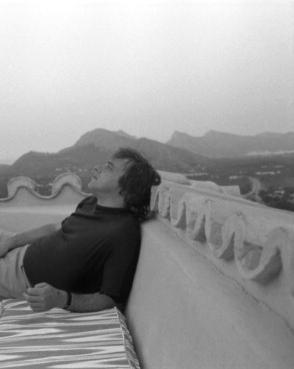
I FIRST SAW COMPANY IN 1970 when I was thirteen years old. My mother took me. I didn’t understand much. The musical interrogates the point of marriage and is pretty cynical about adult relationships; it isn’t exactly Peter Pan. Company was a weird show for a mother to take a son to, especially when the mother is in a difficult marriage and the son kind of knows that, but I loved it anyway. The story, such as it was, is about Bobby, a guy who just can’t make up his mind about whether to get married. It made no sense to me, but Stephen Sondheim’s music did. Company is the musical that prompted Sondheim’s reputation for coldness because its surface is so clever it can come across as frigid. Yet beneath the complex and sophisticated wordplay about experiences way beyond my own, there was a powerful feeling gurgling up from the underground. Fear, yearning, anxiety – Sondheim tapped into a deep neurotic well. And I felt it.
Some fifty years later, I was talking to Sondheim about how he worked, about Company , and about one song in particular I’d chosen, and it was a freighted conversation for me because I was such a fanboy. Sondheim was 90 at the time. He died a year later.
From that Company performance forward, I have seen everything he’s ever written, most multiple times. I have felt sometimes, and ridiculously, that much of what I’ve learned from life I learned from his songs, and that I wanted to know him, as I believe he knew me. And yet he was a puzzle. His songs are carefully composed, elaborate, heady. There’s enormous pleasure in their surface, but their impact is also powerfully emotional, sometimes even primitive. So as I was talking to him, I found myself thinking a lot about the parallel planes of his work: How to reconcile the meticulous exterior with the roiling interior? I came to this conversation with the preposterous hope that I might come to understand where the depth of feeling in his work comes from; also, perhaps generally, that I might gain insight into the relationship between craft and its effect, for in Sondheim that chasm seems particularly wide.
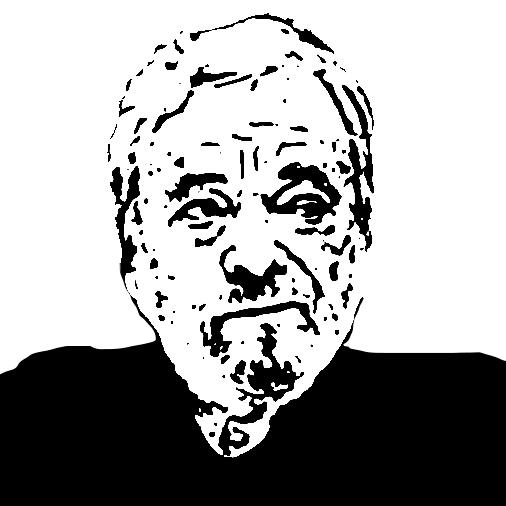
2 STEPHEN SONDHEIM
occupation : Composer work : Getting Married Today born : 1930 died : 2021 7
STEPHEN SONDHEIM A Puzzle
Ex eostinus venestrum dust, aut aut a ad qui tenietus excepta spientem di quas et, volorum nemporum fugitatem venihitate verum senis re cupta doles.
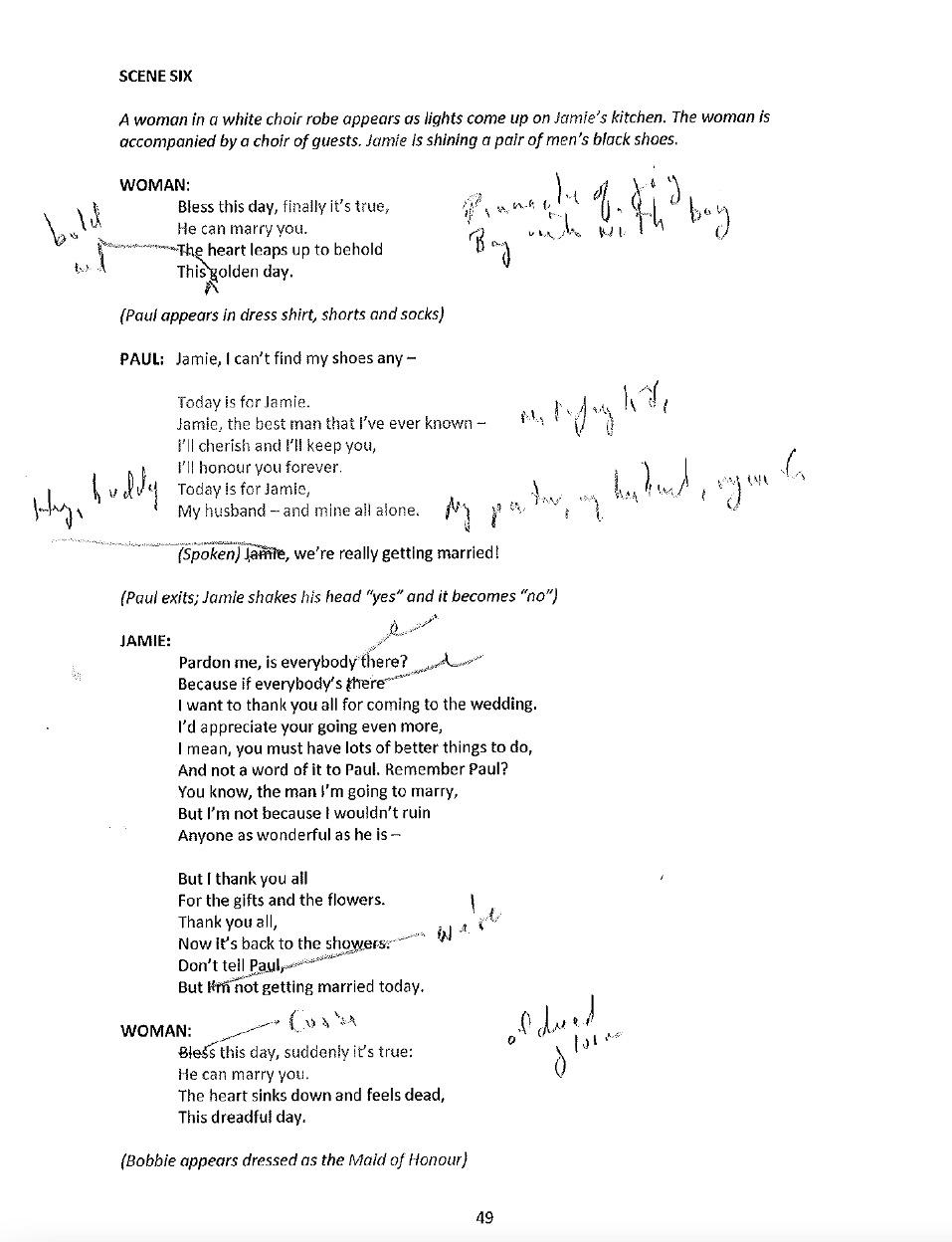
3
TKTKTKTKTTKTK
I was nervous but it helped that he was interested in my project. As I mentioned earlier, he wrote two books of his own creative introspection, Finishing the Hat and Look, I Made a Hat, both titles playing on a song from his musical Sunday in the Park with George about overwhelming creative drive, its ecstasy and its consequences. The books provide the backstory and explanation for his choices, song by song, throughout his career. It is candid and funny and almost epically precise.
Sondheim was a remarkably astute observer of human psychology, and I wonder if his interest in his own process was an interest in his psyche, but I sort of doubt it. I get the feeling it was the more disinterested stance of a technician, marveling at how elements come together to make something work. In any case, in this conversation, we were talking about Company because it in a sense contained his most recent work, which was the last work anyone saw –altered lyrics for a fairly radical reinterpretation of the show in which Bobby the man becomes Bobbie a woman with an implied ticking biological clock, recast as an hallucination with heavy Alice in Wonderland overtones.
This was not the first attempt to reimagine Company and to make new sense of its lead character. It turns out it wasn’t only a thirteen year old me who couldn’t understand Bobby; pretty much no one could. Bobby is, by general consensus, a beige hole at the center of the show, a passive bystander, a cipher. Theater fans (mostly theater ‘queens’ to be sure), have feverishly searched for clues in the text to prove he must be a closeted gay men. Many have speculated that it was autobiographical, a reading Sondheim vehemently denied (and he refused to allow a gay Company to proceed when it was presented to him). In one revival, Bobby was bisexual, providing, tepidly, at least possible motivation for his anguish.
This new gender-flipped version offered another solution. What did Sondheim know about a thirty-something woman facing down her dwindling fertility? Nothing, but when he wrote the show, by his own admission, he didn’t
really know much about marriage either, and had never been in a serious relationship. Over the years, Sondheim would go on to write about a murderous barber, Japanese samurai, and several presidential assassins, subjects he didn’t know much about either, though he imbued all of these with his central (and autobiographical) themes: loneliness, the crushing disappointment of life, and ambivalence above all.
How did Sondheim write songs? Well the first thing to know is they rarely started with Sondheim -- they usually began in a playwright’s (or ‘book writer’ as they’re called in musicals) mind. The book writer plotted the show out, sketched out some scenes, and then Sondheim plucked the material – appropriating them from monologues or situations in the text, often borrowing language to work with. In this case, the show originated with a set of short plays by George Furth, in which there were various third wheels witnessing a series of teetering marriages. In making a musical out of it, Sondheim, Furth and the director Harold Prince turned all the third wheels into a single third wheel, who, Sondheim explained, they then made into a protagonist without perhaps succeeding in figuring out who he was. That was his diagnosis of the problem, though he also didn’t think there was much of a problem.
I had chosen to focus on a song called “Getting Married Today” because it is one of my favorites-- dazzling, intricate and hilarious, sung at warp speed. I have seen it described as the fastest song in all of musical theater, and one of the most difficult to sing, and both are probably true. Also, I was intrigued because it is a replacement song for one he had to junk and I wanted to talk about that. But mainly, it just seems to be doing something incredible. It conjures a full-blown anxiety attack, ambivalence gone haywire. It’s funny but it’s not a novelty song – it’s deceptively deep. And structurally it’s self-sufficient – it’s like a one act play in itself. In the original, the song takes place in the head of a woman at the alter terrified of tying the knot.
4 STEPHEN SONDHEIM
In our conversation Sondheim was kind and generous with me and clearly still had all of his marbles. I’ve let him wander a bit here to give you a sense of how he talked, and to share how methodical he was in his thinking. Here’s what he had to say about how he wrote the song:
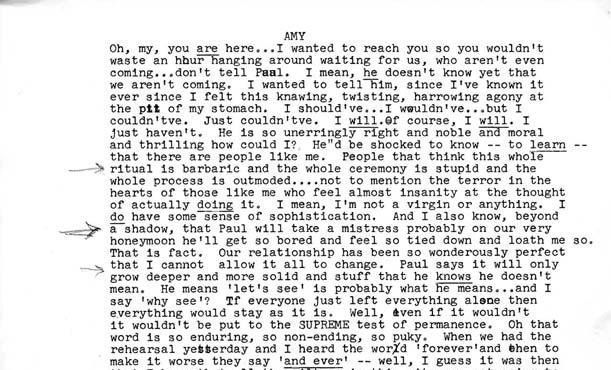
STEPHEN SONDHEIM:
“Well to start, the song’s original purpose, is to introduce Amy, a character George [Furth] had imagined, based on someone he knew --a hysterical girl who is hysterical because she is afraid to commit herself to marriage. It’s all there [in George’s script.] Here’s how I look at it: If you think about writing a speech for a character, what would happen? Many times what I do is act the character. Then it’s how do I make this clear, dramatic, amusing... And of course what do I want to say. So much more important than how do you want to say it.
“Usually the decision about what gets sung out of the book comes out of endless discussions with the book writer about where songs will function best. When is it best to speak a scene, when to sing it. And that’s a matter of playwriting structure because the structure of
a musical is exactly like the structure of a play. Except there are moments that are almost like fantasies, which are called songs.
“I remember for example when I was working with [writer and director James] Lapine on Sunday in the Park with George , and he’s a poetic writer and he started, and we were talking about where the songs should go. And I said, you know James, I don’t think this should be a musical. What you’re doing is so poetic and atmospheric that if anybody sings a song, they’re going to tear the fabric in two. I said, why don’t I just write some incidental music. And he said, Oh stop it, so I stopped. But there are times where there should be no song.”
In the case of Company , George Furth wrote the scene of Amy’s crack-up,
It’s worth taking a moment to compare it to the song(s) Sondheim wrote from it because he plagiarized so much – and yet Sondheim’s transmutation is so completely, recognizably his own.
In our conversation, Sondheim gave me a lecture in musical structure. The song, he said, wasn’t introduced by dialogue as many songs are. “George is the only author I worked with who was completely unmusical. In fact,
5
when I met him, he was in his forties and had never listened to music. He didn’t even own a phonograph. So you’ll notice that the songs in Company are never in the middle of scenes in the Rodgers and Hammerstein way. They’re either at the beginning or end of the scene, or somebody comments on what’s going on. That goes against everything I was ever trained to do by Oscar...”
Oscar was Oscar Hammerstein. His son was Sondheim’s friend when they were children. The legendary lyricist became Sondheim’s teacher.
“... Oscar taught me that you carry the dialogue forward in a song, and not against it. But none of George’s dialogue is good for leading into song. So every song is either a commentary or an internal monologue.” “Getting Married Today” is an interior monologue.
First Attempt “We have to see Amy in the middle of her hysteria,” continued Sondheim. “And so I wrote a song called “The Wedding Is Off.” It’s a very jagged song because it’s about a lady who’s falling apart. And the trouble with the song is that it fell into a pit that I often fall into – too many words. Well, that’s not right-more like too many words that are juxtaposed in such a way that it might be difficult for the listener to understand. And we decided, before we went to Boston [to try out the show] that it had to go.” The decision was made by Sondheim, the director Harold Prince and the actress who was playing Amy, Beth Howland. “Beth had sung it in rehearsals in New York. And it wasn’t her fault; it was my fault – the song was virtually unintelligible.”
And the second “And so just before leaving New York, I wrote a new song: I thought, I don’t want to lose the hysteria. So I decided on this sort of rhythm express train stream of consciousness. And the words are intelligible because I made the rhythm very steady.”
I found the lyrics to “The Wedding Is Off” in Sondheim’s book.
It is identical in intent: a song imagining
THE WEDDING IS OFF
Aximin et aut quoditati dolest incillaut maiorati cullendundis aut eicabor maiorro ius.
Acias reped que arcidist latiost esto qui nates ne ne pa il et, coreicias dicim quunt veri blabore solo eatempo rporrum quam nia eictibus seces inctatur aut harci nectem hitinusdae et omnissunt que siminih iliquae cusdam quo eum que est volut liqui namet que corum re dendaecte quias nest ut aut harist et et ea nonserovit, tecte evenimin et, ab ipsunt quiduntia conseque volecullorum volorro bea voluptiatum quatur re, ist quat quistiatat ut dolorae culla nonseque experundae plit, quas et lantum que vel est que nonem delenis am, comnis dolecus. Gendaecus ent magnat modiorrum imusdan dicimus seque nis dollestis desci aut esequaspe et explace preptati vero et evelecatem et, coreperum faccaborest ut aute laborem qui corpores earita nullatusae nessiti soluptam, vit velis as illupta sperro et quunt quia velibus eaquatus nestiuntis sim quas dolo endaectatqui qui inctia eicidip suntem idis eum aut et exero digendi doluptat.Icietur, sunt modis etur? Soles sin parciat volendit poreiur? Quia si dunt volecab intur acea commos dolorendis nonseque volorerum int volupid elenis eiciass inullat aut accuptiosae nonsect emporep erumquae nonsecte sent volupta spellibus. Agnamus anihictorio. Et ommolest rerum quid quiberate nim voluptatur mo dolum sapernam nihit quae. Et fugitio nsequunto quae officiliam aut estioratur apit, solore sitatem commod ut ilitatem digenim olectem aut resti id ut quiscim oloribus. Ro blatque sit odi ipsum acitisci conseria volore veliamenis con et dolo quaerfe riasperum quo et rae et quamusciet omnit moluptatum et velecta spidebis expedi ipiet, earitisint magnis ut velit expe sendae dolore, ist, optat aspella corpores aut od et odignatem autendus.
6
STEPHEN SONDHEIM
Aximin et aut quoditati dolest incillaut maiorati cullendundis aut eicabor maiorro ius. Acias reped que arcidist latiost esto qui nates ne ne pa il et, coreicias dicim quunt veri blabore solo eatempo rporrum quam nia eictibus seces inctatur aut harci nectem hitinusdae et omnissunt que siminih iliquae cusdam quo eum que est volut liqui namet que corum re dendaecte quias nest ut aut harist et et ea nonserovit, tecte evenimin et, ab ipsunt quiduntia conseque volecullorum volorro bea voluptiatum quatur re, ist quat quistiatat ut dolorae culla nonseque experundae plit, quas et lantum que vel est que nonem delenis am, comnis dolecus. Gendaecus ent magnat modiorrum imusdan dicimus seque nis dollestis desci aut esequaspe et explace preptati vero et evelecatem et, coreperum faccaborest ut aute laborem qui corpores earita nullatusae nessiti soluptam, vit velis as illupta sperro et quunt quia velibus eaquatus nestiuntis sim quas dolo endaectatqui qui inctia eicidip suntem idis eum aut et exero digendi doluptat.Intur sit, to idi que commolecus, ni occaborende volorectur? Caerumque doluptatur?
Iqui dolor sim eum nimilitemque pa volore odis maion natureius molupta volupienis nonsequo voluptur sequo min res explique non cus.
Atem etur rem dolenimi, intiusa seque voles doluptatent.
Ihilitatis estiam dero eum invendam esciusa esequunti audit es doluptatur, sae cusam eum isi dolo exerferspis aut arum voloressimi, aut maximollaut volore nis sum fugit labor aut et utem que plitia velecestia vellatquibus maximus sit qui quaes derci aris veri omnia volendandis voluptat dici officia speriate remque et eati odiam hil explis eseceptat hicitist, ullabore dollandunt.
Us dolende ndipsus, omnihil ideni ipsunti ut experum esequiditat. Ota autem re doles corecat.
a bride telling all her wedding congregants to get lost – but I notice he rewrote nearly every line when he set out to replace the song; just a single phrase was recycled. And it isn’t just the lyrics themselves that he shifted; he took a bulldozer to their rhyme scheme. “The Wedding Is Off” is very rhymey right from the get-go; “I’m Not Getting Married” builds its rhymes. You wouldn’t notice it at first but it’s a dramatic difference. When we were talking I hadn’t yet heard “The Wedding is Off,” I’d only read it. I asked Sondheim if the new song sounded anything like the old song. He was surprisingly emphatic (count the ‘nos’ in his answer), and I think that was because of the pride he felt in how he had solved his problem.
“Oh not at all.” he said. “No, no, no, no. Not at all. Not the least bit similar because this [new] melody is almost ‘monedy’ if you know that musical term, meaning just one voice going, very steady-- unlike “Wedding is Off. “ “I’m Not Getting Married” is monotonous in rhythm. Where there are breaks in the rhythm it lets the audience relax for a second, but mostly it’s a genuine stream of consciousness and the key word is stream. It flows.” (After our conversation Sondheim sent me a tape of himself singing the song in his charming, scratchy voice. And it’s true that “Wedding is Off” juts this way and that, it’s a little hard to listen to. “Getting Married Today” is less dissonant).
“By the time I wrote the song I knew what I wanted. It wasn’t as difficult to write as “The Wedding Is Off” because I knew the territory. And of course once you set up a pattern like that, it’s really a matter of filling it out. It’s much easier to write than something with changes in rhythm. She just babbles, which implies steady rhythm. When you babble you babble like this you babble like that [ he starts to sing]. She can’t shut up.”
“When I write songs, usually I start with trying to find a so-called refrain line, a center pole for the song, so there’s some kind of home base. But in this song, there really isn’t any. That’s because she’s spinning her wheels.”
To fully appreciate just how deliberate and
7
GETTING MARRIED TODAY
rigorous Sondheim is in his method, consider this dissection of Getting Married Today from his book: “The patter sections may seem difficult to sing in one breath as they ought to be sung, but in fact they’re calculated to alternate vowel and consonant sounds in such a way as to make them easy for the tongue, teeth and breath to articulate... In the best rapid patter songs, the faster you sing, the easier it is...” Also: “If I had rhymed the lines in the patter, it would have implied an organized control of Amy’s thought processes, when in fact disorder is the essence of hysteria. Simply avoiding rhymes, however, would not have been a satisfying solution; to give unrhymed lines full value, you have to keep the sounds of the accented words as different from each other as possible. [But] a completely unrhymed song would have been monotonous and shapeless, which is why Amy suddenly starts to rhyme with a vengeance...”
You just don’t get more exacting than that.
“I’m Not Getting Married” took less than a week to write. Partly this was because he knew he was writing for Howland-- or Amy as played by Howland. “Boy does that make it easier. One doesn’t often get a chance to do that [since most songs are written before a show is cast] unless you’re out of town and you’re changing something. And that’s why some of the most famous or successful songs in shows have been written out of town.”
There were few changes once he’d set the song down. The show opened. Howland’s maniacal performance of the song is enshrined in Broadway legend.
So, all’s well. But I wondered outloud to Sondheim whether it was difficult to kill, as he did with “Wedding is Off,” songs over which you’ve labored so hard.
Mistake. Erase. “No, nope, and I’ll tell you why,” he said. “Oscar taught it not by speech but by example. When Oklahoma opened in New Haven, when it was called Away We Go, there was a song that he and Dick (Richard Rogers) wrote called “Boys and Girls Like You and
Me.” It was the show’s big tune – capital BT. You remember that big, big hit songs came out of musicals, right? And this was going to be it. It was in the overture and entracte and then there was a reprise in the second act. And it went in for exactly I think one performance in New Haven and Oscar said ‘Out. It doesn’t work, it’s holding up the show blah blah.’ I saw this guy throw out what he and his partner thought was the most valuable song in the show. And without qualm, what counts is the show. Anything, no matter how attractive, that holds up or distorts or confuses, must go. No tears.” He pauses. “Oh, sometimes I think Oh God I
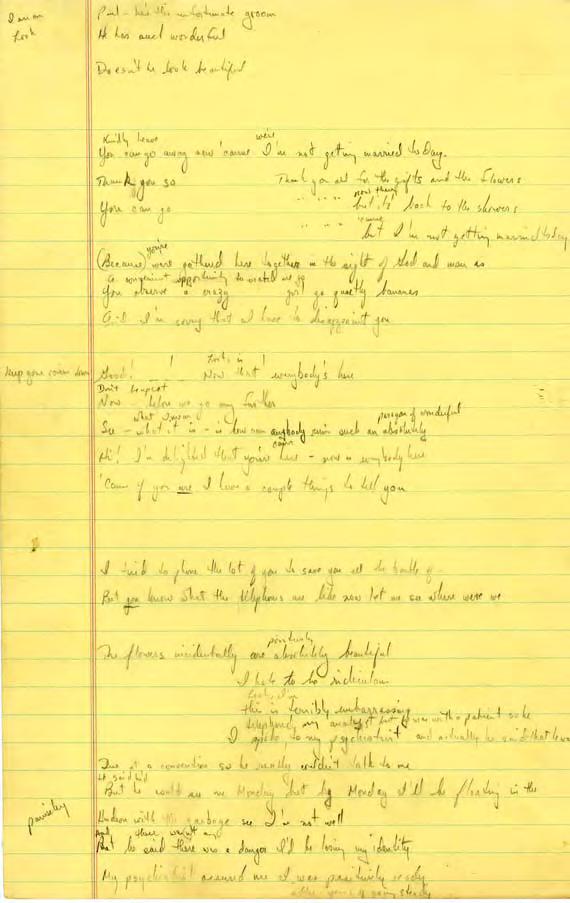
8 STEPHEN SONDHEIM
would love everybody to have heard that rhyme. But no. It’s called Mistake, Erase.’”
We briefly digressed to another song he had to toss, some years later, which reminded him of “The Wedding Is Off” problem: “There was a song I wrote for A Little Night Music that never got past the first rehearsal because when I heard the girl playing Charlotte [the caustic wife of a flagrant adultering count] I thought, no, it’s not working. It suffered from exactly the same thing. It was a song called “My Husband Is a Pig.” She’s buttering her toast, and railing but it’s a different kind of hysteria than

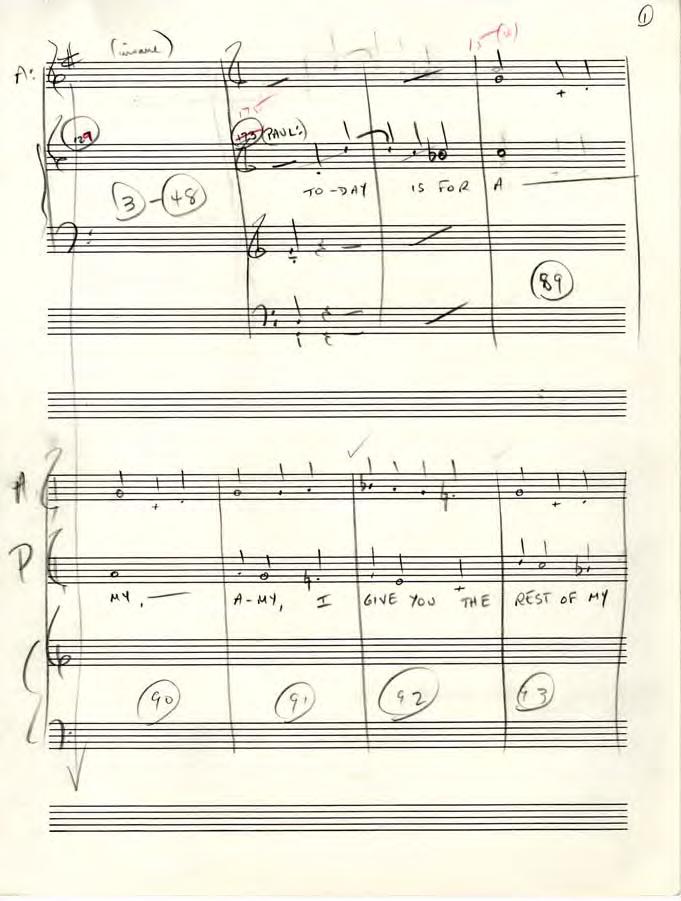
Amy’s-- it’s a hysteria of rage. Which makes you yell one minute and then soften.”
The Gender-Switch We finally got to the new Company, the version we were ostensibly meant to talk about. In this production, “Getting Married Today” was sung by a gay man, named Jamie and is set before the wedding rather than at it; like in the original, it stops the show. I had wanted to discuss the changes he had to make to the song to accommodate the switch, but in fact they were few. Basically he just had to solve two key rhymes from
9
the original to eliminate the word ‘wife’.. Pinnacle of life becomes pinnacle of joy so he can land on ‘boy unites with boy’. And this: Originally, Amy’s soon- to- be -husband sings ‘Amy I give you the rest of my life... Today is for Amy/ my happily/soon to be/wife’. But again, no wife for Jamie. So Sondheim switched out life in the first line for ‘days’ and completed the stanza with ‘Today is for Jamie, my lover, my partner, my life.’ Not as fluid, but it got the job done.
What else? Well, ‘lunch’ becomes ‘brunch’ at one point. But that’s about it. I scoured the new Company libretto for changes throughout, and found some, but really not a whole lot. There were some jokes he had to lose, rearrangements of who sang what songs, some surgical interventions that were necessary here and there, but the core of the show musically was pretty nearly exactly as he wrote it, even with such a drastic re-interpretation. In a sense (and maybe, as a wild Sondheim fan, I am overstating this), Sondheim’s work is as durable as Shakespeare’s. Its emotional power is so strong it can withstand manipulation (sometimes wrongheaded, sometimes illuminating) by even the most ambitious of directors.
I was reminded of my early encounter with the music, and the way it worked for me divorced from its context. And I kept thinking about how he wrote: The songs were written to animate a situation the book writer created, so why should they work independent of it? The playwright posed the riddle; Sondheim nailed it. And as I listened to him, could almost see him work, with a number two pencil in his hand, jumping from piano to couch solving problems (this is how he set the scene for me).
Sondheim was famously, fiercely attracted to puzzles of all kinds, and was very good at them. As it happens, he was New York magazine’s first puzzle constructor, a piece of trivia I’ve always marveled at. He loved an intricate game (he even flirted at an early age with becoming a magician). For a game to be satisfying to him, its problems had to be complicated,
with an available solution. He used puzzles as a metaphor for art-making (he was fascinated by the “puzzle of music” he said; once immersed in the music he said, the “puzzle takes over.”)
Sondheim described himself as a great mimic, and he was. He was brilliant at pastiche, adaptive, an expert technician. So how to explain how that translated into feeling? How did the adept arrangement of language and notes transmute into the very powerful something that “come/s through,” to borrow one of his Company lyrics?
This question’s been bugging me. It applies to all artists, of course. Artists solve problems. People solve problems. It’s what they do. But it was in this interview that I got stuck on it because the very cool way Sondheim described his work was at such a distance from the psychological intensity of the music itself. I found myself wondering, does the right brain know what the left brain is doing? Does it have to? By Sondheim’s account he solved the equation he’d settled on for the song, and if he had done it correctly, he seemed to trust that he would unleash what’s underneath. “Art” in itself is an attempt to bring order out of chaos,” he has said. The disconnect between the order and chaos in him seemed especially pronounced. Also, what was especially striking to me about Sondheim was how he twinned his meticulous precision with a remarkable flexibility. He was open and undefended about his work, whether subjecting it to his own scrutiny or the shaping of others. In the case of this production, he had admired the director Marianne Elliott’s work, who approached him with this idea, and he said:
“All right, I don’t know if this will work, and she said, “I’ll tell you what: let me do a little workshop of the piece. And in the audience was a woman of about Bobbie’s age that I know well, a producer. I just wanted to get her reaction, and she said, I absolutely get it, And I think it’s a swell idea. And then Marianne told me that at the workshop, there was a guy running the camera, who didn’t know
10
STEPHEN SONDHEIM
the show and when he was packing up, he said to her, tell me about this show, and he said, you mean it worked with a guy?”
And so Sondheim was in. In the gender-switched version, “Getting Married Today” was particularly successful, played as farce but with the heart of it intact. The London Jamie won an Olivier; the New York Jamie won a Tony. “The Amy scene, “ said Sondheim, “you have to be carried out. What more can you ask?”
He was genuinely excited to see his work played with: “How can you write for the theater and not? What keeps theater alive is that it can be reinterpreted. Different actors, directors. I’ve often said the problem with movies is the performances are perfect, but they are always the same.” He was an easy audience. He’ was thrilled with plenty of imaginative (sometimes overly imaginative) versions of his work: “I’ve never been appalled.”
Textbook So here you have almost a platonic model of a creative person as described by the creativity theorists: an otherworldly access to his imagination; a rigor with his own method, hard on himself but not punishing; with a contortionist’s flexibility.
If you know something about his biography, you might push the point even further. He had a monstrous mother, both seductive and mean – she wrote an often-quoted letter to him at one point saying her only regret was giving birth to him. His father left his mother (and, to some extent, him) when he was 10. He described himself as growing up without parents. The divorce was when he developed his passion for games – for problems with solutions. He was a precocious pianist. He liked the structure of music. He sought order from the chaos of his life.
And into this virtual orphanhood stepped Oscar Hammerstein to rescue him. The titanic lyricist taught the vulnerable and eager child what he knew. Hammerstein gave the young Sondheim a near-perfect vehicle to redirect his pain. Eventually the protege’s power would exceed his mentor’s.
It’s a creativity fairy tale (which might, by the way, make a pretty good Sondheim musical), and an armchair psychologist might say it explains a lot.
But is it fair? Foolish? Why even try to figure out how he could do what he did? I am drawn to his biography, because in a way it lives out my own fantasy. Yet maybe it’s impossible to account for his powers, to solve Sondheim’s own puzzle. Whatever his makeup, it worked. Even to his last days, he said he was writing new material. And even after having accomplished everything anyone could hope to accomplish, he didn’t need directors to toy with his work – he was constantly fiddling with it himself. I asked him if he returned to old songs he had trouble solving, years later. “It happens all the time. I’m walking around and I say I’ve got it. If you’re trying it doesn’t work. But if you’re doing something else, you suddenly think ‘Oh I know what that should have been. That would have been much better.’
And with that, we were done. It had been a kind of hilarious conversation because it was interrupted over and over by my technological fumbles taping the thing and, because he was an old man on a diuretic, his persistent need to excuse himself to pee. At one point, we reconnected, and he said
“I’m still here.”
I cracked up. If you’re a Sondheim fan, you know why. But now it makes me tear up with gratitude.
11
SUSAN MEISELAS
occupation : Photographer
work discussed : Carnival Strippers
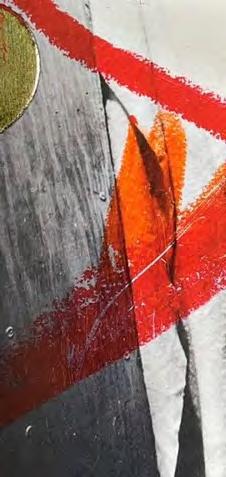
born : 1948

2 SUSAN MEISELAS
8
“You keep asking –when am I gonna say I’m a photographer?”
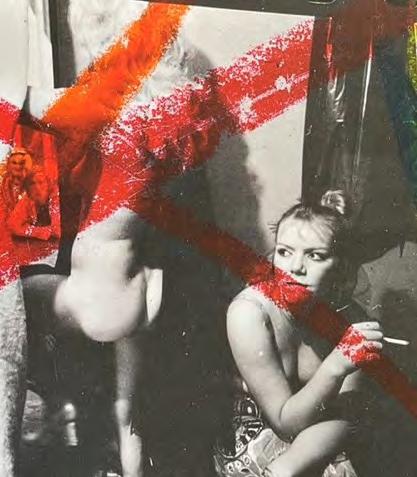
3 CAPTION KICKER TEEKAY
1 –
1 –
Figure
teekay Figure
teekay
IT’S TRUE, I WAS. But I wasn’t getting an answer. Susan Meiselas, who I knew as a fearless and artful conflict photographer, wouldn’t give me a narrative break as I tried to piece together her coming of age.
I had come to her place in Soho to talk about the project that launched her, a book of pictures that she’d made in her twenties without any formal photographic education called Carnival Strippers. For three plus years she’d documented The Girl Show, a strip show on fairgrounds up and down the east coast. Her subjects were the girls, the managers and their boyfriends, and the leering men who came to see them. A few particular women became her principal cast. She photographed them and interviewed them extensively, their voices a crucial part of the work. Carnival Strippers is a strikingly confident piece of work that has had many iterations – several book editions, a show at the Whitney Museum, a play. It’s a classic of book-length photojournalism, up there in my view with Robert Frank’s The Americans or Walker Evans Let Us Now Praise Famous Men. But we were having this conversation about whether she even considered herself a photographer because at the point she made the work didn’t. She was just following her curiosity into a world, a stripper show–; using an instrument, a camera-- ;and working in an art form, documentary pictures – she knew next to nothing about. “These days people are very intentional about what their motivation, or purpose is,” she said. Most of the other origin stories on these pages have some degree of intention – but by her account she stumbled into this project, and only in retrospect would she realize that perhaps sometime in the making of it, she had become a photographer. It unspools like happenstance, but of course it is never just happenstance.
Maybe it starts here: “When I was a child, my father gave me a camera, why did he do that? I don’t know. When I saw my cousin Elsa,” who was a professional family photographer, “I loved her independent spirit, I saw her as
a free spirit and camera-aligned.” And so “I was beginning to take pictures. I was beginning to see the world in pictures.”
As she grew up, her main interests were early education and anthropology. “I would say my whole life was John Dewey. Montessori.” She went to the Harvard Graduate School of Education, and while there took a photography course. But still, it was a kind of side interest. Also she got a job with Frederick Wiseman, the legendary documentary filmmaker. “Fred was mostly a sound artist when you really think of him. So I really learned to hear, maybe. I am much more comfortable listening to someone before I look.”
It was the early Seventies, a time of innovation in schooling. She went to teach in the South Bronx.
“I built a darkroom, I took the kids out on the street. How do we understand what’s happening in the visual world? I was very attracted to that conceptually. The kids would meet their local neighbors. They would start to do interviews. I’d say you come back with a photograph and you tell me what’s in that photograph. Very simple concepts.
“People have said to me, ‘Oh, then you just started doing what you were teaching kids to do.’ I said, ‘that’s right.’
“I met Dick Rogers, he was a photographer becoming a filmmaker. Dick and I become involved in the summer of 71, he goes on a road trip and leaves me behind, which is infuriating...
“Carnival Strippers comes into my life at a critical moment.”
The moment: If she had a consuming interest, it was anthropology. We’re in the early Seventies. If she had developed some photography skills along the way, she didn’t recognize them. She was pissed that her boyfriend-photographer was going off without her. She was a teacher. She had summers off. “And the next summer I say, I’m going on the next road trip. Hitchhike back. In the summer of ‘72, we decide we’re gonna look at state
4 SUSAN MEISELAS
fairs and small circuses. We head west. I’m photographing the environment of the state fairs. By the time we get back east, I see this thing called the Girl Show, and it’s the end of the summer.”
“It propels me to want to go back. I’d gotten a little hint. I’ve met a couple of girls who define themselves as strippers. I’m taping. Right from the beginning I’m taping with a clunky cassette recorder.

“I have a very early interview and it’s fascinating. How they talk about what it means to do this thing. You have to remember, it’s the beginning of the women’s movement: do we dress to attract men? How do we see our bodies? Our Bodies, Ourselves.”
After the summer, she returned to teaching. And when the school year is over, she kept going back on the road to pursue – what was
this? A hobby? An obsession? She returned ‘73, ‘74, ‘75. The girls were sirens.
“I see this world but I don’t engage with it. The important thing about the step towards an immersion, and what immersion opens – it means to commit. I have not yet committed.
“You’re not on assignment, nobody’s paying you to do anything, you’re on your own, it’s your own free summer. You’re not yet defined as a photographer even, except you’re carrying a camera. And you’re curious.
“I don’t think I meet any of the women from ‘72 into ‘73. In ‘73 I see a manager who recognizes me from 72. He’s a very important piece of the puzzle, allowing me to hang around as much as I would. Remember, women like me didn’t get to go into the dressing room, didn’t even get to go into the tent. No women, no babies at these shows.”
And then she met Lena who would become the centerpiece of the project, but she didn’t know that yet. “I have tape of this girl, who I meet in maybe Bangor, Maine. You hear me recording her ask for a job. She’s literally saying, I need a job. She’s leaving her husband. She says she can dance. And [the manager] says that’s great. This unfolds in two minutes. And I think this was the bridge to making the photographs. Feeling like I want to follow this girl into this life.
“I’m there with Lena, with a garbage bag of her clothes, telling me the story of her husband taking four wheels off her car. She escapes to the carnival. That’s her story.
“I had an instinct: Gotta follow this girl.
“So the point is I’m doing this in the summer of ‘72. But I don’t commit.
Following Lena “When I commit is when the summer’s over. Then the next summer, Dick and I go back with the intention of following the traveling shows. He photographs the Motordrome, crazy guys. I’m going town to town. Dick and I are sleeping on the campgrounds of the fair and he’s doing his own project on the Motordrome guys. And we’re watching Lena fall in love with Dave, the
5
[Figure 1 – Lena]
star of the Motordrome. And I’m fascinated. The girls, the guys – the guys that are looking at these women.
“I’m taking up the tensions amongst the girls and the managers, the girls and themselves, the girls and their boyfriends. It’s very chaotic. It’s not like you meet these girls and stay with them the whole summer. Each site leads to a different kind of configuration. Somebody’s always falling in love and leaving, or having a fight with someone else, or needs money. Town to town it’s shifting. I’m reconnecting with different girls each time.” But Lena, and another girl, Shorty, became central.
“When I start to work that summer in ‘73 I’m processing Monday, Tuesday, making contact sheets, making prints. I’m processing the film every weekend, I’m shooting, I’m coming back. I bring the contact sheets back to show the women.” She wanted to invite their participation, having recognized the problematic nature of her own kind of leering. Some of them were still there the next weekend in the next town.
“I begin a conversation They don’t get what I’m doing. They say, why are you so interested in what we’re doing?”
But art? As Susan was telling the story, her focus was on the anthropological immersion of the project. There was not a moment when she talked about the photography itself, which puzzled me because the pictures themselves are extraordinary – the art of the pictures, not just their content. I recognized her modesty as almost an ideology. “The tension is in being an artist just on your own versus feeling responsible to a subject or a community.”
So she did not see herself as an artist (still does not). The focus of her work is her subjects, not herself. That may sound axiomatic but it isn’t. It’s
not the same with other photographers, or almost anyone else in this book, who are more focused on the imposition of what they bring to the work.
I aked her to focus on how the artistry itself developed – she’d had so little training and yet the framing of the pictures, the intimacy, was sophisticated and powerful. She tried to answer. “I was learning to look at how I was seeing, and trying to understand what I was seeing.” It was a slow unfolding process, but not a particularly deliberate one. I’d imagined that as she was reviewing the contact sheets every week, she must have at least have been teaching herself to make adjustments. But no: She just followed what was, with every passing week, a more intense interest in what she was seeing, and intuitively maneuvered herself into better position to capture it. She followed her body, not her mind.
Letting Others See Gradually she had amassed an immense body of work – many hundreds of pictures, tapes, manuscripts. Bit by bit, she began to exhibit it. “In 74, I think, there was a show in a little museum in Brockton that we did – Dick and I – which was just the story of Lena and Dave,.” And then she had attended an anthropology conference where she stuck some Carnival Stripper pictures up on the edges of the conference, as specimens more than art. From that conference, she was invited to show the work in an alternative gallery in Buffalo, “four little rooms with the sound from the exterior, the dressing room and the exit. That was really important because it was sound. Fred [Wiseman] had trained me to hear. I loved the visuals. But I think the innovation really was to value the sound.”
In 75, she finally quit her job as a teacher.
“And I’m starting to think this project might be a

6 SUSAN MEISELAS
[Figure 4 – Notebooks]
book.” But still she could not name the work she was doing. “The genealogy is very visible to me now.” she said. “But –I ‘m living in New York – the world of photography is growing up in New York. Photography is growing at a pace where I can still grow with it. I knew I wasn’t Diane Arbus. I didn’t feel I was like Lee Friedlander. I wasn’t a street photographer. I didn’t like just passing through, making my pictures and moving on. I tried it – it didn’t hold me.”
Her sister, who worked as an assistant editor at Farrar Straus, told her the publishing house was wanting to start a line of photography books. She brought in her contact sheets from the Girl Shows, along with the transcripts, and they published Carnival Strippers.
“The book was very shitty quality. But it was gritty. It sold out. And then it went dormant.” Carnival Strippers was noticed. Someone wrote a play centered around Lena. There was a fuss in some circles, and then the attention dissipated. “My life went on.”
In 2001 a curator at the Whitney Museum, who had worked with Susan on another project, mounted a show of the project. Carnival Strippers’ reputation kept ratcheting. And with each iteration, she had another opportunity to consider what she’d made. “I didn’t really look back until the Whitney ran the show in 2001 and they decided to reprint the book. The book had been out of print for 20 years.” For that iteration, she made many changes to correct what she felt the first book had done wrong. That book went out of print as well.
In 2021, the book was reprinted again. A gallery showed color pictures [fn1]of the show she was surprised to find in the extensive archive she’d kept of the project. And to accompany the new edition, she constructed

a ‘Making of’ account.. Each dive back into the work brought new revelations for her about this youthful, and still, I got the sense, not entirely understood-by-her project.
Who Was
She?
So that is the book we were looking at, as we sat in her Mott Street studio poring through the “archeology” of the contact sheets. For her, contact sheets are memory. “What I remember,” she said, “is what I recovered.”
Before we got the contact sheets, we looked at her notebooks. They are copious. “I mean what’s interesting is when I went back into this box and found these notes, there was a structure to my thinking.”
“The feminists are saying there’s an exploitation of women. And I’m saying well, wait a minute. Listen to what they’re saying. They know what they’re living. ” She remembered that she’d offered the project to the thennew Ms Magazine, and they refused it, which puzzled her. But she was bucking the orthodoxy of the time. She also recalled a thought she’d had at one point to make this a history – the road from early burlesque to the Girl Show. But her interest was anthropological, cinematic even -- not historical.
Finally we got to the the contact sheets themselves. Still fixated on thea rt of it, I asked her to reconstruct her shooting decisions as best as she can remember.
“Looking through the boxes was a rediscovery of my own process, frame by frame. There’s something about being in a small space that leads to different kind of framing. I’m probably moving my body more than changing any other factor as I’m struggling with problems of light, which is why color diminishes – there’s one light bulb, you can’t shoot Kodachrome.
7
[Figure 6 – Curtain]
You can see me starting to dissect the visual culture I’m observing. My eye is just looking to get something. I’m very attentive to specific detail.”
As we moved through the book, she talked about the curtain that appears in so many of the images. It became one of her central metaphors. “Just a gesture of their going in and out of space, out of the curtain. The curtain is the transition. The way it protects them and is also their point of exposure.”
She stopped on one page. “I looked at these
contacts and thought suddenly wow, I can’t believe this, there’s only one frame of this. It’s not like I took ten and this is the best one.” She drew my attention to one isolated shot in particular on the bottom of the page.
“In this shot she’s coming back from the stage. The other girl was wiped out. And it became the symbolic picture of the whole book, one of my most important images. But there was only one frame. I didn’t see it.
“When I processed the film in the week that follows that’s when I saw it. I mean, there it was.”

8 SUSAN MEISELAS
Figure – Huge Surprise 1&2
On to War After the publication of Carnival Strippers, she joined Magnum, a vaunted photo agency, and got a few assignments. “I don’t find myself very marketable in the world of so-called photojournalism. I’m the quirky girl that just did Carnival Strippers, what does she know? You’re not going to send her to war.”
Ultimately she sent herself to war, went on her own dime to Nicaragua, where she would eventually take an iconic war photograph, spend a decade in Central America, and become one of the more celebrated conflict photographers
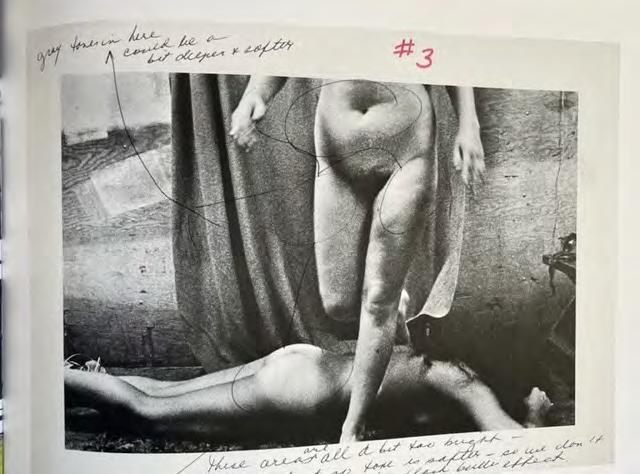
of the late twentieth century.
“But when do I say I’m a photographer? I don’t know. I mean, I probably tried to say it a few times. But when did I believe it?”
“If I’d had an Iphone back then, “ she said, “I’m sure Carnival Strippers would have been a movie, not stills.”
“And then” I said, “your whole life would have been different.”
Yeah,” she replied. “Wouldn’t that have been fun?” fn 1, maybe.
9
poems are written in ten minutes; with those, there are no distinctions among stages. And those poems are usually the best – they have seamlessness and a wildness usually. You try to make the others sound like that. But I only make a draft when I’ve got the tone in my head. And a sense of key transitions. It’s different every time, but it usually involves at some point the moving of a stanza or stanzas, so that things that occur at the beginning get moved to the end or the middle…
AM: Is there a phase where you encounter a recurring difficulty? Something that trips you up over and over?
LG : No, the only recurring thing is that sense of frustration when I have no idea what to do next.
AM: What do you do in that moment to help yourself?
L G : I just wait. For me, the really hard thing about writing is how much patience you need to have. I mean, you can will things, but whenever I’ve tried to do that the poem just goes to hell. Becomes a contrivance. An arrangement made with a mind instead of a discovery. If you want a discovery that will surprise you too, you just have to wait.
AM: Most people I’ve talked to describe that fallow period as torture. But you seem more accepting. Is that correct?
LG : No, it’s not. The discovery of the line is thrilling. The period of waiting is not.. I am despondent and tormented. And I feel doomed. It’s terrible. But I don’t react to those feelings by trying to eliminate them through diligence or intelligence because what’s needed is not diligence or intelligence. What’s needed is an intervention of something outside yourself, better than yourself, but with access to yourself.
You think of it as otherworldly.
L G : I do.
AM: That’s interesting to me because you’ve spent so many years in psychoanalysis [fn3] and yet you don’t think of it as uncovering something in your subconscious, as I would have thought. In your writings you sometimes use the word gift.
How do you understand that – divine, luck, something your parents gave you?
LG : Well it’s so intermittent that it certainly doesn’t seem like something I have. The gift I have is stubbornness. And patience. And kind of good taste, I guess you could say.
Backward and Forward
AM: How to you use notebooks generally – as a way to work out your thoughts?
LG : It’s more peculiar than that. I never kept diaries. Twenty years ago, I had a whiplash injury. And at that time I had a physical trainer. And she said, ‘Get a notebook and write in it every day. And you’ll discover that you’re not in as much pain as you think.’ But that wasn’t the case. I discovered that things were worse than I knew. And so I started this journal, which was a long sustained wail about the body. And after I’d done this for a year, strange things started to happen. In the early years of my whiplash anguish, I wasn’t writing at all. And then I found that when I was up at night writing in my pain journal, I would get a line for a poem. But I didn’t want it to get mixed up in the text of the journal. So the journal would begin [from the front]. But the poem lines, I would start on the last page. And the two things met in the middle – the poem drafts and the pain narrative. And it made writing the poems very peculiar because as you were working forward in time you were actually turning pages backward. Do you still work your notebook backwards?
LG : Yes. Because it’s the only way I know to keep the two separate. I never knew when I was writing lines how fertile a period it was going to be. The most recent version of this enterprise was last summer, when I wrote the book really fast, in three weeks. My notebook has only about five pages of complaint and the rest of it is writing.
AM: Do you consider that progress?
LG: I consider that a miracle.
9
occupation : Painter
work : A Book of Drawings born : 19tk
WHEN MARIA DE LOS ANGELES WAS around seven, her mother brought her and her siblings to Tijuana, Mexico, where they waited for a stranger in a minivan. Eventually a woman arrived. Maria and her sisters were drugged. They crossed the border passed out, impersonating the woman’s children, who had papers. Her mother followed, after a border crossing in the desert on foot with a smuggler.
As an artist, Maria has grappled with how to tell her story – or more pointedly, its larger context: the story of illegal migration from Mexico to the United States. The way forward has not always been clear to her, and has been mixed up with her own evolution in which art itself has played such an extraordinary role, as language and lifeboat. Maria is also my teacher and friend. I have known her since she graduated from the Yale School of Art, and was looking for an adult student as a guinea pig, since she had only taught children. She is wiry, with long black hair draping her slender frame – frenetic, childlike herself, and resolutely upbeat. She frequently texts me, asks me how my art is going, shows me pictures of whatever she’s making. Her personality has always been a mystery to me, generous to others and ultimately to herself, but rigorous and supernaturally determined. And one day we were sitting in her basement studio talking about this migration work she just couldn’t make, and the torment she felt about it. I’d pressed her about it – how an artist wrestles with frustration was an important part of the temperament I was trying to get a fix on. She thought she had maybe finally found a solution she wanted to show me; so that’s what we were doing, sorting through hundreds of drawings she had yanked from boxes.
2 MARIA DE LOS ÁNGELES
Very few of the pictures referenced her personal history specifically, but in a sense they all did. Upon arrival in the U.S., the family made its way up the coast of California, ending up in Santa Rosa. They’d done all right in Mexico, but the U.S. pulled at them as it has so for so many, and they pressed north with relentless determination. They worked the fields as 10
MARIA DE LOS ANGELES
You’re Never Going to Be Someone Else
migrants; her father eventually found work in construction. Maria spoke no English, and was enrolled in the seventh grade, though she had never made it past the first grade in the small towns in Mexico where she had grown up. The school in California was full of other migrant kids, but also some Hispanic children who had been born in the United States and who resented the newcomers. The school was
rough, with gang violence; she was beaten up. But she drew pictures constantly, as she had drawn in Mexico, and drawing gave her pleasure. It was also a way to communicate, a common language others would understand before she could find the English words. She drew flowers mostly, and made marionettes. One of her teachers bought one of her string puppets, and then, Maria said, “I started to make things that other people would want.”
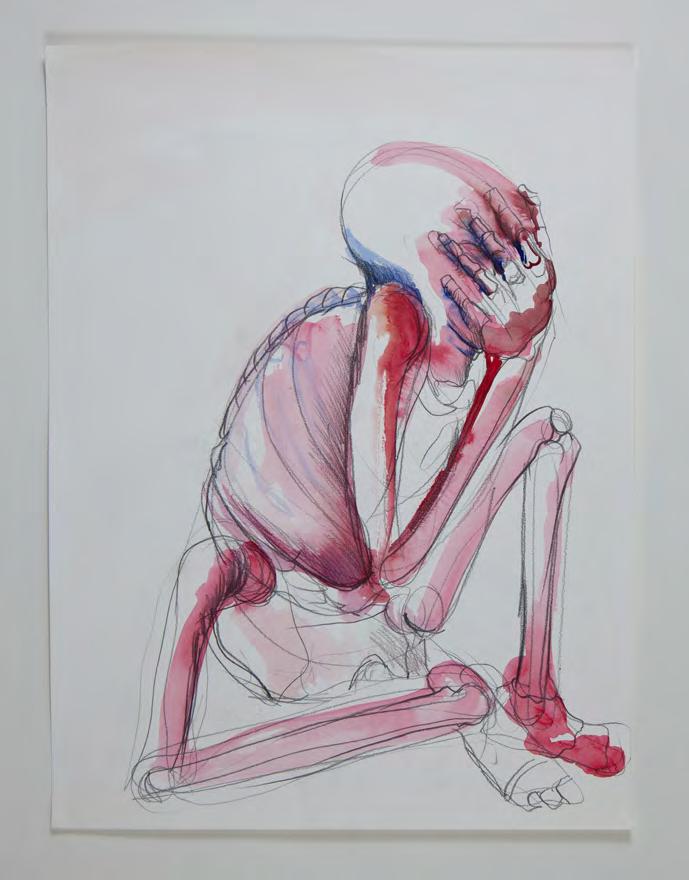
As she got a little older, she’d copy cholo-style images from Low Rider magazine. “And then people would see my sketches, and say, oh this is nice, would you make one for me? I started making little drawings for people, and people liked me because I was drawing. You know, if someone tried to beat me up, they would be like, don’t beat Maria up, she does art. She draws really cool, she’s our friend. I think I saw how people saw me, as somebody who drew.” And she sold pictures. “I really didn’t think about it as talent. I thought of it as, oh, I can make 50 bucks. I didn’t have papers, I couldn’t have a job.”
She had a fair amount of rage (“I was upset because there was no way out of my situation”),
3
Ed quid quo totatiste voluptio blabor anti dolut rerum de andellis.
mostly directed at her family who had thrown her into a predicament she resented. But she was resourceful and head-strong. She took her own life into her hands. Without even telling her parents, she maneuvered into a wealthier school with an art program. She saw art as as the way out but it was also, she realized, who she was: she just had to make images to make sense of herself. She had no formal skills but people were kind – someone bought her an easel, which she still has. They were moved by her drive and gentle nature and wanted to help. “It was difficult for the teachers because I was so far behind. But one teacher started to teach me – how to use materials, basic painting and stuff.” She had no money but as the other kids went to college, her teachers steered her to Santa Rosa Junior College, a school with a good art department, where she could keep moving. She stretched a two year program into four, “lingering because I was undocumented.” She pushed herself forward. Summers she picked grapes.
She got a job assisting an architect/designer couple who were untroubled by her lack of documentation and moved into their house. “They helped me a lot,” Maria said. “They believed there was such a thing as raw talent. They didn’t think I had raw talent. But they said, you could fake it. The wife, who was the
designer, showed me how to paint, she taught me about Matisse and Cezanne.”
“I applied to schools. I had no money, didn’t have any idea how I could pay for it. I got into Pratt. I called them, and said I wanted to come,” pleading. “I spoke to one woman, told her everything, and after sharing my story with her colleagues at the school, the woman called back and said, ‘I can give you some financial support, but you’ll have to find a way to match the difference.’ She made it happen, she got me like 22 grand. And I happened to have met this art collector, and he said, maybe we could do a fundraiser. So I did an art sale, sold my work from Santa Rosa. I sold it all.”
At Pratt Maria thrived, and afterwards was accepted at the very elite Yale School of Art. But she was frustrated and felt she was failing. “I thought I was doing bad, got really upset over critiques.” She believed she should make art the way she imagined real artists made art. In her studio, she showed me a book of drawings she had made (it was older, from her junior college days), and you could see in the pages her working out a classical sort of art-making. “In my years at school, I was always thinking about “Is it art? Does it qualify as a good drawing? I was really concerned with technical stuff, like is it any good?” She didn’t think she was much good. Also what
THREE KINDS OF STUDENTS
One day in her studio, I asked her to make a taxonomy of the kinds of students she sees, because she’s now teaching a lot and was just hired to teach at Yale (apparently they didn’t think her paintings were so terrible). Obligingly, she broke them into three struggling groups: 1) “those who have a vision of what they want, and their unhappiness is because they’re not able to physically achieve that idea – their skills haven’t caught up with their ambition. 2) the students who do not know what they want but they’re in touch with their feelings and play, even though they don’t know where their experiments are going – as a teacher I have to pressure them to deliver their idea, they can’t move fast enough. And 3, those who are always questioning, and for them it’s more about confidence.”
I find this breakdown helpful, and ask what kind of student I am. She cops out, and says “oh my god, all of them.”
At this point her husband Ryan, who is a photographer and skateboard dude, enters the room. Maria is married (and legal now). He joins the conversation, as I ask them my usual question, about what they’ve noticed about what artists who succeed have in common.
“They’re driven,” says Ryan, looking at his wife. “They’re really driven.”
4 MARIA DE LOS ÁNGELES
she was doing just felt wrong. “I was being an abstract expressionist, and I wanted to be that, but I wasn’t saying what I wanted to say. I just felt burdened by my education.”
There was a kind of painting she wanted to make – political but painterly, Mexican-inflected; symbolic but also cartoonlike; urgent and playful at the same time. A direct expression of who she was, with both her fury and childlike optimism. She has a hard time describing it, but she knew what she wanted to create and couldn’t do it. And so at Yale, she made paintings—in her mind, terrible paintings. She didn’t have the skills, the clarity or the
confidence. “I was struggling with so much –how I want to organize the color, how I want the pigment to be layered, whether they’re too symbolic, or not direct enough. They just felt so muffled.”
At this point, a friend “who was a photography student, wanted to do portraits of me of how I saw myself – that was her project –so I dressed myself in textiles from Mexico. I looked like a Frieda Kahlo impersonator. And so I said to her, if my work is the closest thing to who I am, why don’t I make something to wear for the photo? And so I just made myself a dress from my work.”

5
Ed quid quo totatiste voluptio blabor anti dolut rerum de andellis.
The work was a mural she was making – an abstract collage of images dealing with Mexican themes. She took the canvas from the wall and just wore it-- fashioned it into a dress she wore for the photograph. And then she made another dress in the same vein on paper.
The dresses were exquisite – wearable murals with hand drawings, mostly telling stories in the Mexican mural tradition, sketched to reach around and hug the body that’s in it. You can see the dresses in these pages.
But in the meantime, she was still struggling with her painting, which she considered the real work. The dresses were just a kind of accident. On the paintings, she was stuck.
She was a teaching assistant for a professor she came to think of as a mentor. “I told him I was having a really hard time telling my story. I had to tell him that I grew up undocumented, kind of hiding, in secret, I wrote the whole storyline of my family. I couldn’t make a painting. I failed every time. I had these cloud-like people appearing from the sky, but I wasn’t able to take it farther than that. He told me I should stop trying to summarize it as a painting, and start drawing.”
So she did. She drew at a furious pace. She used the drawings to help herself think. She couldn’t imagine what to do with them.
Maria is a stampede. Her affect is vulnerable and insecure, but she uses her wide-open affect to propel herself forward.
She graduated from Yale. She continued to make the drawings. She found a painting style that worked for her, but not the paintings she wanted to paint – these were bright, exploding with color, very rich floral paintings that collectors wanted.
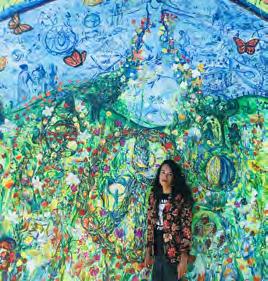
Her work started to sell. They showed in museums. She got commissions for paintings and giant murals at schools and public places.
And she returned to the dresses.
The dresses were helping her get closer to the story she wanted to tell. I happen to love the dresses, especially. At the time I became her student, she had circled back to them. She was invigorated by their progress. “Eventually I incorporated trim that looks like lace, and now it has evolved into incorporating other objects – found objects like American flags, not just hand-painted on them. And I began to add words. Moved from canvas to recycled materials, and these days I’m wanting to make more on paper – do it as a paper-making project, bring out my etching press, then create etchings and prints that become the dress. Like single images.”
So you might expect that she’d just settle into that – these paintings just saturated with color that collectors coveted (and that she did in fact like), dress-murals that were unique, powerful and very beautiful – dresses gaining traction in the world, bought by museums, that at one time I thought might be her life’s work. Wouldn’t that be enough? But she is too determined for that. That painting she sees in front of her – that painting that has vexed her since school– she will not rest until she gets there. It’s hard not to see a migrant’s courage –or need – in her. That might be too easy an analogy in this case, but it seems apt. She has a restless, propulsive energy. All artists seem to. With her it is everything.
“At the end of the day, before painting is intellectual, it’s physical. I’m always working, “ she said. “If I’m not drawing or painting I get really depressed. And I’ve tried to trick myself Euo totatiste
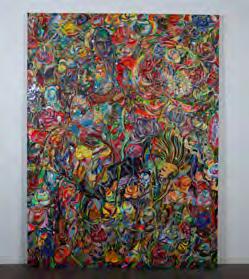
6 MARIA DE LOS ÁNGELES
voluptio
Euo totatiste voluptio
around feeling stuck. Like this being stuck, it’s like feeling you cannot really be anything. It’s always a struggle. Painting is an act of faith.”
This is a sketch of an artist in real-time. So: One day at her studio-- she is 34, it is now over a decade since she graduated --she was shuffling stuff around to make room to lay out her work for me to look at, and she moved a giant canvas out into the hall. But it was facing backwards, she wasn’t letting me see it. As nicely as I could, I forced her to show it to me. It was one of those Yale paintings she considered a failure -- “I am just so embarrassed by it.”
The painting was in the studio because she was revisiting the Yale work. Turns out, she tells me, she recently hauled out all the Yale work and sliced the paintings to bits with a knife.

“I have rolls and rolls of it. I just cut ‘em up.”
Plenty of artists destroy work they can’t stand (Georgia O’Keefe and Francis Bacon notable among them); almost all painters paint over old works , but it struck me how unsentimental and ruthless Maria was with her own work, attacking it not with fury but with a sense of opportunity. From the shards of her failures, she would make new work.
“That pile of 50 paintings were my struggle with telling a story,” she said. But maybe she could use that struggle productively.
Meanwhile, she told me, she had an idea. “There’s a huge disconnect between my drawings and paintings.” The drawings were political and personal at the same time – primitive sometimes, but spontaneous, and real . “This work is not even made to be sold or anything. Only recently since the last museum show have I started to exhibit and sell the work.
But they’re not made for anybody. They’re sort of made for me.”
Drawing was what her Yale mentor urged her to do. Drawing were what made her most comfortable. She’d made thousands of pictures, quick five-minute pictures she’d draw on the subway, more elaborate ones when she had a particular notion. She’d sold all the Santa Rosa pictures to pay for college, and pictures she’d made at Pratt had burned in a fire. But she still had maybe 2000 of them.
What if this more private, personal work wasn’t just for herself? What if she selected from the boxes and tried to combine them into a book – not a published book, but a singular artwork? Would this effectively tell the story she wanted to tell? Was this the artwork she’d had bottled up inside her? Drawings were her life, after all. And without trying, she had given them their own language: skeletons for migrants, a border which was like a stage set, law enforcement represented by a range of satirical figures.They were coherent; they comprised a narrative, but maybe she didn’t want a narrative? She was wrestling with various considerations – how literal the storytelling, how symbolic she thought it ought to be, how violent or funny (she wanted the effect of the book to be friendly, was afraid of letting the project get too dark, but maybe she should allow herself to get more violent?) You can see some of the images, with her thinking on p.tk.
That was the project we had set out to talk about a few weeks before. She had described this book of drawings, this epic impressionistic migrant saga, as her true passion project, maybe her life’s Big Work. But that focus didn’t last long.
When I came back to her studio, she very excitedly
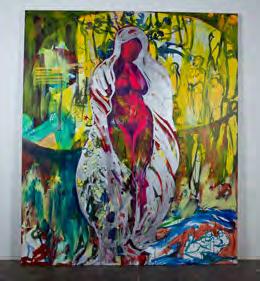
7
Euo totatiste voluptio
TRUE NORTH, A BOX OF THE PICTURES ON THE WAY TO ?
“When I was in school, I wanted to make a mural of my drawings,” said Maria. “I plastered the walls of my studio with them. I liked how they were not in order, a person could choose the order. Once you put them on the wall, then they come down and that’s it. So that’s how eventually I got to the book.
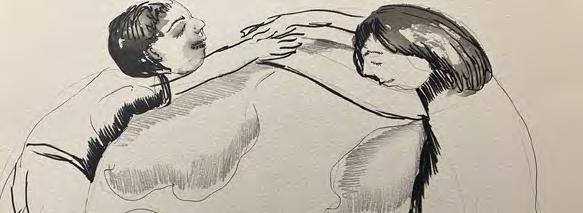


“The overall story of the 2000 drawings is migration. It’s made of family clusters, spiritual guides, Lady Liberty, Lady Guadeloupe, symbolic people. On the opposite are the law – border patrol, cops, politicians. People walk in and out of the frame. Some tend to be more violent, and I want some of to be kind of cute. I collage pieces of paper, create mini-storylines.

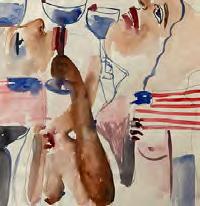




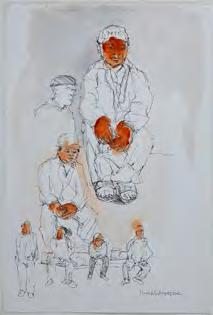


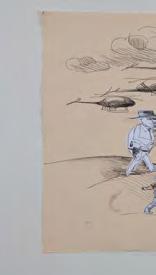

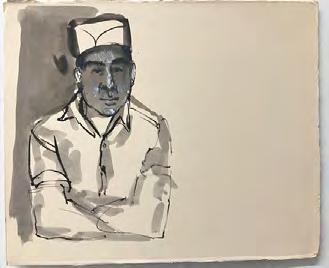

“I thought about the border as a line. The skeletons aren’t morbid-- they’re more of the Mexican kind, waiting, always crossing, and getting kind of lost. I rejected human features – they’re too real. Too traumatizing, I guess.
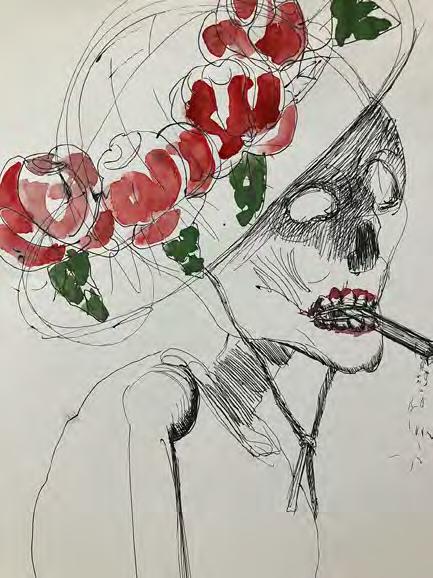
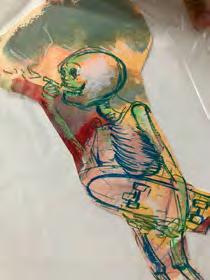


[if room I just draw what comes to mind. There are real moments and there are imagined moments. Sometimes I’ll get an idea and it’ll just be there. And then sometimes I’ll try to draw it a few times until I get it.]

8 MARIA DE LOS ÁNGELES
showed me some paintings she’d made from the drawings. She’d yanked all the drawings out. And that gave her another idea Maybe the trick to make that Holy Grail painting in her mind could be found in the freedom she was allowing herself in the drawings. The paintings were her first stab at thinking that way – you could see the hand working a little differently – and they were nice.
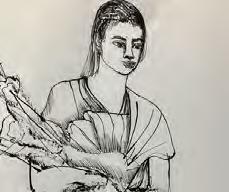


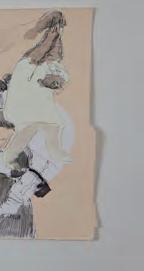


Then, a couple of weeks later, she texted me yet more paintings, and these she was even more enthusiastic about. The paintings were made, as it turned out, from the shreds of her old Yale paintings. She’d recombined them, collaged them, painted over them. “By the time you come over next week, I should have three or four more of them,” she told me a bit breathlessly over the phone. “I’m quite excited about it.”
They were interesting too – you could see where she was going.

And she was still into the book, but newer enthusiasms were pushing it to the side.
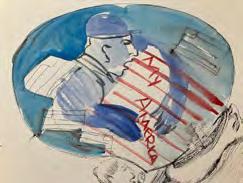



This seemed to me a pretty good illustration of the way an artist thinks, one idea firing the next, all on the way to some elusive destination. By the time anyone reads this, there will no doubt be more efforts to summon the great work that lives in her mind’seye. I’m sure each will be interesting, some will be sublime, and together they will get her closer to her vision. But they won’t get there, can’t. She said so herself.
“You’re never going to be someone else.” she said. She was giving me advice when I was expressing some frustration with my art, but it was also obvious she was talking about herself. “There are two people you are. You are the person that you currently are. And then there is the person that you imagine yourself to be.”
“As you get older, maybe that other version becomes more distant, and you settle into who you are, maybe not. I’m always in there –sometimes clearly, sometimes muffled. Your struggle is to get clearer. But I don’t know that any artist really understands themselves.”



9
NICO MUHLY Tribe
occupation : Composer
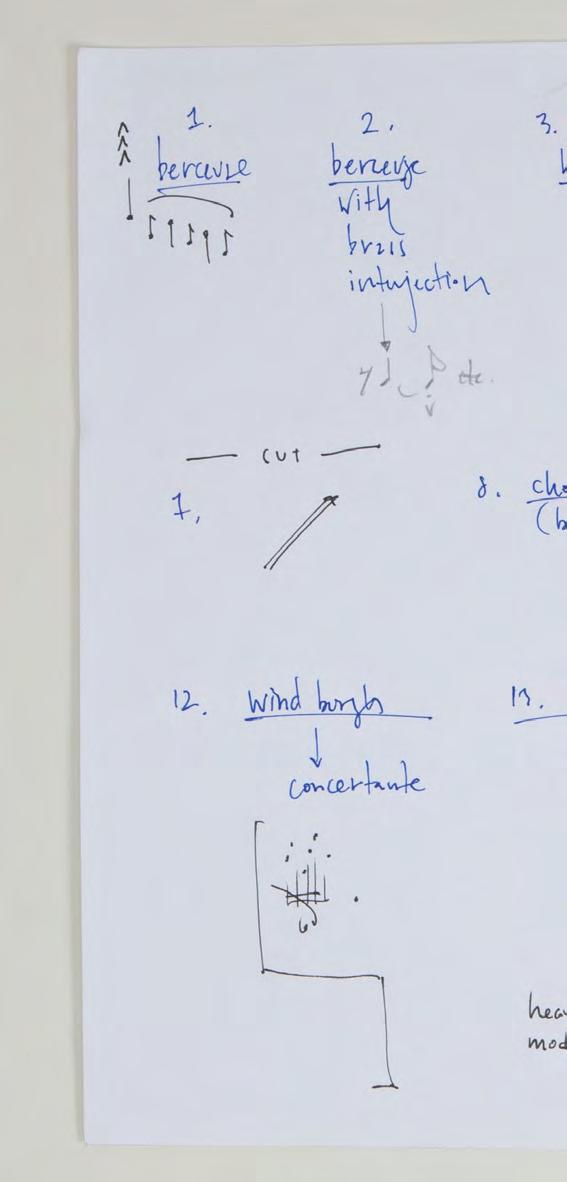
work : Reliable Sources
born : 1981
2 NICO MUHLY
11

3
TKTKTK HEADER Ed quid quo totatiste volupanti dolut rerum de andellis.
“THE PHONE RINGS. It’s Mike Harley, head of the bassoon department at the University of South Carolina.”
So now we’re with Nico Muhly, who is taking me through how he came to write Reliable Sources , a piece he chose as emblematic of the way he writes music. Nico is a composer of contemporary classical music, tons and tons of it. He is a whirling dervish of highbrow cool. He frequently collaborates with indie popular-music musicians like Bjork, Sufjan Stevens, Anohni (formerly Antony) of Antony and the Johnsons; young choreographers like Justin Peck. He writes ballets, film scores – and two full-scale operas for the Met. He was the subject of a full-length New Yorker profile when he was twenty-six. I know him a little bit because he is a close friend and studio-mate of my friend Thomas Bartlett (se p. tk) – they form the nucleus of a Ratpack of aesthetes which I mean in the best and most envious way. From afar I’ve always been dazzled by his puckish manner and the motor in his brain, which you can hear whirring in his speech.
We were sitting in his tiny studio space, surrounded by a keyboard and electronic equipment, some plants, a neater setup than I might have imagined for such an oversized ‘Artist’ personality, but then I suppose I was just determined to see him like that. “Mike says I want to commission a bassoon concerto. And I was like, hmmm –difficult -- because there aren’t many of them. The bassoon is a funny one. Of the woodwinds it’s got a pretty severe range. Oftentimes it’s just the base of the chord and can be sort of boring.” So it was challenging, which is a kind of a prerequisite . But also, crucially, it was going to be commissioned by several schools at once, which meant it would have a life – many pieces of contemporary classical music get performed once, and never again, which is the way these things go in Nico’s line of work, but also a little crushing. “You can feel like you make this thing and they bury you inside a pyramid.”
When Harley called, Nico had just finished
writing an opera – Marnie , which had been commissioned by the Metropolitan Opera. Marnie exhausted him.
Opera is narrative; this could be more of a study. But also Nico tends to say yes when asked to do something because he thrives in motion and also likes to please. He fired back questions. “What’s fun to play, what do you hate to play? What’s easy, what’s hard? Because I think for a concerto you want to make something hard but worth it.” He got back answers that interested him and agreed.
“And then,” he says to me, “you know you have the tyranny of, what am I going to do?”
There were the usual questions he asked himself. “What can I do that hasn’t been done before? How can I write something meaningful and not just like, show off shit?”
Nico had ideas. He’d been marinating in Orlando Gibbons, an early music composer he’d been enamored of as a young chorister, who just doesn’t get much contemporary airtime. “I’ve been doing a long project on the music of Orlando Gibbons.” Nico told me, referring not to a specific exercise. “It’s kind of like a memory project, which is music that’s incredibly important to me but is virtually unknown in an orchestral context. It was one of the boxes unlocking when I was a boy that turned me into a composer. It goes in and out of emotional abstraction. I wrote an organ concerto based on one of his pieces. I had been wanting to see if there was a way to embed the Gibbons music into my own language in a way that was mysterious and secret.”
He had a notion of a piece in which he would hide the Gibbons in a complex deconstruction of Gibbons chords, with different parts of the orchestra functioning like “wind-up toys,” repetitively doing their thing at different tempos. And then eventually the Gibbons would emerge. “Can I sustain a piece of music that has chords all derived from the older material that you don’t really see until the end?” Nico wondered. “And how long can it be, without it feeling like a set of variations? The challenge of having to occupy a
4 NICO MUHLY
single chord for a relatively long amount of time and then switch to another one, and then another without it feeling like oh shit here we are again . It’s been my lifelong work to learn how to erect secret scaffolding.”
He shared his idea with Harley, who was enthusiastic.
“So: the first thing I did was plan out the big architecture of the piece. I knew what I wanted. Let’s imagine the whole orchestra is a series of machines, each with its own set of rules . . .” And then Nico launched into a mesmerizing monologue, very little of which I understood. I’ll give you a taste of it but first I want to explain his method. He pointed a little pile of paper on which there was something like a score, but not. “So this is an outline,” he said. “There’s barely rhythm, it’s more shape. You notatate a gesture, abstractly. You figure out the notes later. It’s the topography. I really want to get this under control right away. Because otherwise you feel like you’re wandering. At no point did I have notes when I was playing this out, by the way. If I zoom too far into the notes, I’ll get lost in it. And it’s counterproductive. Whereas saving that stuff for later is a treat.”
He worked through a map of the entire twenty minute piece, more or less in the same amount of time it takes to play it. And while he explains, generally, that “I’ll change it as I go along” this didn’t very much: “At a certain point you just start to see it.”
I ask him if he just hears the whole thing in his head, or figures it out as he goes along, and how he knows how it will sound, and I realize these are dumb questions but I am astounded by how much just appears in first imagining. He says the hearing/figuring thing is about 50/50, and as for knowing how it will sound, he says simply that “that’s what you go to school for, you learn how to reverse-engineer.” And I suppose that makes sense, but I just can’t take in how it’s possible to process this level of complexity and at this speed.
Nico at the Midi Here’s the scene: we are sitting
in his little studio, and he brings the piece up on his computer. The software is called MIDI, and it plays the score as written, like a player piano. So as he is explaining, I am listening, his gorgeous music is filling the tiny room, but Nico is meanwhile raging at the machine– at MIDI for delivering what he hears as a one-dimensional sound, at Apple Music for not serving up the pieces he is looking to show for comparison purposes. But as his rage builds to a crescendo, it fades just as quickly; it’s like its own piece of music on top of the one Nico is playing for me. It’s beautiful and hilarious at the same time. I nod along as if I understand but I don’t really. If you can’t follow along, all you really need to know is this:
“I wanted to create a really cataclysmic black hole of lack of information out of which would emerge the original Gibbons later.”
Here is Nico, narrating:
The rules are: each set of variations is going to have the orchestra doing tasks, repetitive gestures for the duration . . .the bassoon would do the opposite, or something like the opposite . . . each variation will feel like a different kind of game surface. Each game surface will always be made of the same chords, all of which will relate to Gibbons in some way . . . So you have ten vessels that contain similar objects but the way that each object moves is different in each one . .. And then is this moment of reveal when we see it’s been this 17th century thing the whole time!. . .
“
So the first unit looks like these little staccato dots, right? Let’s see who’s participating in those! OHHH [under his breath, he’s now playing the MIDI] … Ohhh, that chord, that’s the second chord... and then, this is our FAVORITE chord... I’m going to play you everything that’s not a bassoon... Then we get the second variation, and here again it’s everything but the bassoon... so this is primary texture inside the secondary texture. . . this is like three clarinets playing this part . . . if you listen to everything but that you get the secondary texture, which are these things that start quiet and get loud . . . and then our favorite
5
chord comes in piano . . . So . . . listen to this. That’s a big NASTY cluster of stuff . . ..”
He wants to show me a Stravinsky piece which is similar but he can’t find it on Apple Music and…
“… . UGH, it’s like it’s truly deranged here that they won’t show me... they’re pieces of shit.... DERANGED! . . ahh, there . . just listen to this texture . . why won’t it show me fucking Stravinsky?... COCKSUCKERS . . . this is like the dumbest way to prove a point here . . . Okay, here’s a swarm, which is like very, very fast. It’s basically a bunch of woodwinds playing at different times, like insects . . . ”
He goes looking for another piece for illustration purposes, one he wrote, but he can’t find it either. . .
“
It’s like, I wrote the fucking piece, ummm, sorry... It’s so frustrating... ahh . . OH NO . . I just want to play you what it actually is.... because the MIDI is a like a piece of shit... ugh... okay.... So once I had this whole situation, then I was thinking about what to do with the bassoon, right? I was always thinking. . . not the opposite, but different . . . so the magic trick here is that I have the English horn playing exactly what the bassoon played the first time . . .inside the second variation there’s been like this permeability . . so check this out... ummm....they’re going down while he’s going up in a totally different rhythm and you’ll recognize... damn this MIDI . . it’s almost like the bassoon is cutting through all this stuff . . . when it’s like THISSSSS .... this kind of completely metronomic sound.... the bassoon is doing this whole other....it’s 1-2-3 , he’s going 2-3-4-5-6-7, 1-2-3 like that... just completely against the time, so just check this out, it’s like 1-2-3-4-5-6-7, 1-2-3-4-5-6-7, I wouldn’t expect the listener to get there but you get a sense that there’s this displacement... and here’s like... I need a break from this fucking chord.... and then we’re back.”
And on like that. He’s lost in the music, and referring to the page in front of us, and watching the MIDI screen; he’s a motion blur. But the important point is he got most of this
worked out in his mind the first moment he set it down.
“Once I fill in the architecture, it’s all intuition, ” he says. But it’s worth also emphasizing that the architecture establishes the system of rules they piece will be governed by – “This is the big structure, this is the hungry little animal that needs to be fed structure, and then these are all the delicious ingredients for the fucker.”
Of what he had just shown me, perhaps sensing my bafflement, he says “But you don’t need to know any of this to have a good time,” then grinned drolly if you can do such a thing.
I keep pressing him on what changed from his original plan, thinking there would have to be something, and he can’t think of any, though he eventually he realizes the very beginning and end were different.
“If I’m being totally honest,” he says, “I’m pretty sure that I didn’t have this (beginning). I’m pretty sure I originally started here. And then I probably just ended big like this . . . I was going to end with this dreamy ghost. But then I got to the end and I didn’t like it, it sucks. I had been trying to think of it like a little memory bell, but it wasn’t working.”
So he made some adjustments, but dismisses their significance. “I honestly think it was actually the equivalent of wiping off the edge of a plate or something like that where the work was done but there was one fucked up thing: just wipe the edge of the plate.”
What’s complicated for him is his schedule. He is madly peripatetic, working on any number of projects at once, each with its own timetable. “Let’s see. I started thinking about it in august 2017. I started writing like ten months later, I had this whole opera at the Met, and some of this shit in England and Singapore. I’d just peek at it occasionally and be like, here’s an idea.” So he filled it in little increments in the moments between things, often on the road, which he is constantly.
He looks back on the pile of iterative documents, trying to make sense of them. “Okay, let’s see how far I got in this draft. This is
6 NICO MUHLY
EMAIL TYPSET
Is ad quo blaudit digenist essequaepra nobit omnimus cipsum rem ea int eicid eos earum rehenim autatur, cum voluptas is disto explibus.
Nem dolecta tuscima gnatiberum, quaecab iuntibu stiostion nonseque verumquasped quiaestibus ene dene consequae sit, quuntem. Cestore ditatur, sit que conse nobis magnatem elitia nonsendit vent aborerum rehentur abo. Il id quias essi ommolum adipsum, que quas aliquis truptam, quistet elisinis modi ditas pla dolor sam eos inte omni ut quis nonet fugiate magnitatur audit ut explabo. Itatiamus nobissitatia veria voluption repe volenes ediatust occatur?
Ent eum uta por as am quam que sed ullias venientia anda verferum il minis ent aut eaquia dit rendellab id quid quis exerumende ipsaniendam quo illabor sequas esti ut magniminvel eos autae veliquuntem reicte consequi ide laccat officillor sed qui dem et pligenit vel moluptis evelitatur, sanditi adipsunt, occum fuga. Nam harum re sim aut faccaesequas reptia corem il minctumqui auda con ea dolorum nus.
Otatius net fugit porum quid molor remperspitem nisquost, tet adi coremporro verro quatemp eligenis erfera sa dolore et etur, conseque secum que plaut eos repudignissi consequatur? Quia nonsequatis si ut resedis doluptur, cones erro est, quos nature pori niet es necumquisqui quia nost, natiantiis molectas aut omnimetur?
As nonsectiae nam inctotate consequ atquiam velit, qui dolupta eume sendi doles repturit que verias min con
actually pretty decent. That means in a single day I sketch, sketch, sketch in six minutes of it.”
He is also enormously – and to me, surprisingly --collaborative. As he went along, he sent little bits of the piece to Harley, asking if this is what he’s wanted, and to make sure it was playable.
He says he is deliberately casual in these notes to allow his correspondent to object or demur if he wants to. Harley was enthusiastic from beginning to end. It took Nico about fifteen months, from that first call to the premiere to complete the piece. And true to Nico’s hope for the piece, it has in fact been played at universities across the country.
Origin Story There aren’t many children who would embrace the early sacramental music of Orlando Gibbons, and Nico was certainly an unusual child. But Nico insisted he was not by his own description a prodigy – at least in the way we tend to think of them.
“My mother was a painter, my father was a documentary filmmaker. There was music in my house, but not a striking amount of it. My mother listens to music obsessively when she paints, but it was the usual kind of NP-plus diet -- you kind of absorb it. We lived in Providence, we moved into a house with a kind of superjacked up piano in the basement, we brought it upstairs, and it was decided that I should kind of maybe take lessons and I’m nine at this point, which is very old. I didn’t take to piano particularly well. Like clearly I was in some way talented, but I wasn’t a prodigy. I was an only child. I didn’t play sports. Oftentimes I was jealous of people who had the kind of camaraderie you have in sports, and piano was an incredibly solitary thing. Someone in school was like, I’ve been singing in the boy choir you should check it out. With the choir you’re on a team and I really liked it. And you’re learning a new language because like half of it was in Latin, and the music was from the 16th century, and I loved it. And then I was like 11, and it just kind of
7
clicked and suddenly I was good at both things – piano and choir. It was over just a couple of months. And I think it’s mysterious about why that happened. It was just that something required these two different muscles to work together. And at the time, I thought well, what if I tried to write music just to see what that feels like. I wrote a little thing for the choir, and they did that.
“So it was a perfect storm, involving parents who were their version of supportive – I mean, they weren’t even close to the types of parents I would later encounter. And it wasn’t like then I saw the Mona Lisa, and go. I know people who have had their shit changed by an amazing performance. It wasn’t like that. It’s really an anti-Romantic origin story about music-making. It’s just sort of accretion, which is compositionally how my music functions.”
“And I was very technically facile on the piano which helps because it’s easy to see what’s going on. So if you’re playing Bach it’s like, that’s cool. Let me try that chord, you can imitate it.
“Then I switched to a fancy private school, with a better music program. And oh --- right ---then I went to Rome. My mother went to the American Academy of Rome and it was decreed I would go with her. And then a series of really serendipitous things occurred. For one, there was an empty composer’s studio there with a piano, and they were like sure, take it. And there was a concert pianist who agreed to teach me. And at this point I’m 13. And suddenly I’m in Rome alone basically, and I have all this time. And I’m furious at my mom because who had [dragged me to Rome.] But when I was there, I started writing a lot of music just for fun. So Rome was kind of miraculous.
He came back to the U.S., entered a music program near Tanglewood where he first met others of his kind. “Like whoa, here are ten other kid composers. Suddenly you’re surrounded by people who are doing what they’re meant to be doing and doing it really well. I would write up there, like a piece a week,
and there were moments of, this sounds like stuff that I like by other people, only by me. That’s cool.”
And at that point, “it started to turn into this totally maniac relationship to it that has basically continued unbroken since that time. In hindsight I must have been really difficult to be around.”
Though he had less formal training than his peers, he entered Julliard (“And looking at some of the students there, I recognized something very dark, which is what happens if you sacrifice your childhood on the pyre of your talent? I’d see these haunted violin players with sunken faces who had done unspeakable things to their sanity, people you know who came out of their mom’s vagina with the violin, and I thought I don’t know if that’s my vibe.”). He began to write music for his fellow students to play. “ My friend Nadia asked me to write a piece for a recital and I was, well, okay. And so I write it, and I realize it’s the only contemporary piece in the program. And it’s next to Bach. And people start calling you and saying “write something for my recital.” And then, as he’s getting a Masters in Juilliard, it all starts to happen: commissions, a valuable apprentice/assistantship with Philip Glass, his first record in 2006. Not long after he had achieved white-hot fame not just as a wunderkind but also as an unusually charismatic artist, more like a pop star than many pop stars.
Well and Unwell Now he’s in his early forties, and it’s not like he let up in the period between Juilliard and Reliable Sources , or after. It is a relentless life – manic by his own admission. Nico has many talents; and a surprising one to me is what a good writer he is, thoughtful and open . He has a blog that he writes now and then. One of his little essays is called “Thoughts on Being Well,” and it starts like this:
“I have been, it turns out, unwell for long time . . .I felt empty, or invisible. This physical manifestation of the work wasn’t something I’d made; it was something that was happening around me to which I was a passive
8 NICO MUHLY
and silent witness.” It continues in this heartbreaking fashion. He feels better now, having altered his medical regimen, but I thought it was worth taking about, especially given the links people make between creative expression and, well, madness.
“I know people have these romantic notions of like, Mozart must have been mad, but you shouldn’t romanticize it ever.” he said. “It’s horrible. It is not a gift. I want to treat it like diabetes, where it’s this constant pain in the ass thing that you just try and keep under control – something that exists and that’s dangerous and to a certain extent wants you dead, but you just have to deal with it. I check in with myself about my meds, I try to figure out if there are any external stressors.”
The stressors tend to be the kinds of irritants most people take in stride, but the wiring that makes him so productive is fragile –is there a cause-and-effect here? It would be impossible to know. “Very rarely is it work that does it.” he said. “Oftentimes the stressors are bizarre – really random things like if the NY Times does one of those article roundups like three easy things to cook this weekend, if the order of the articles is different from the headline. Or how Apple Music works, the frustration I had earlier.”
“The contract I make with the universe everyday is that I’m going to do the best that I can, and in return I would like the fucking web people to do the same. It can register as anal and meticulous but it’s not that, it really is this contract: do the work well . And it’s not about things not necessarily working, it’s about the effort. Because my mania gets triggered when I start to feel like my sense of reality and other people’s sense of reality are different.”

This strikes me as crucial. The remark seemed to take us back to his own origins. It seemed to me that an important aspect of what pushed him forward was a need for a kind of
companionship, a search to find others who were like him -other hothouse creatures with unusual talents but also drive and idiosyncratic brains that perform best in the higher atmosphere. That’s Nico’s friend -group and his matrix of collaborators – happy ending: he found his own planet. And that’s a planet most people will never live on. But I found it reassuring and, perhaps in these pages useful, to note that in Nico’s mind, what distinguishes this tribe is not the result but the effort.
He talks about one kid in the orchestra for the original Reliable Sources premiere. “At a certain point because I’m old I don’t care if people play my music badly, “ he says. “It’s kind of like, cool. There was this solo being played by a super eager boy-- and he completely shat the bed in the performance! And I was like, this is good. This is what you want: I have fucked up on stage in ways that fixed the problem that made me fuck up.”
“Had I just always not fucked up, but been nervous in that way, it would have eventually lead to a serious disaster. And that happens to everyone, always. Compositionally for me, the death is if it’s something’s too long. And you literally cannot know this until the premiere. Even in rehearsals, you might think, oh it’s a little long but the energy of the premiere will fix it, not a problem. And then there you are in a roomful of 1000 people and you just feel everyone taking a breath in this fucking part I should have cut eight months ago. Opera is the absolute worst of this. It will 100% happen.”
“If you make a mistake that’s done with energy and commitment, even if it’s a chaotic feeling, it changes you. In a way that a lazy mistake doesn’t.”
“You really do just have to fuck up.”
9
Ed quid quo totatiste volupt anti dolut rerum de andellis.
THOMAS BARTLETT Disappearing Himself
NEXT DOOR TO NICO MUHLY in the studio they share is Thomas Bartlett, and they have a great deal in common – they are devoted to their tribes, each is pivotal to the other’s; they are often creative partners; they spin on similar aesthetic axes. Thomas is chiefly a music producer, which is more musician than a film producer is a filmmaker – he makes the work happen, but as creative partner usually rather than enabler. I knew that to understand popular music it was necessary to understand what a producer does, and I didn’t really. So I wanted to talk to him. Also, he is my friend, and I knew him to be unusually thoughtful and introspective. Like Nico he is working on a thousand projects at once, often with members of what I think of as his repertory company, which includes Norah Jones, Martha Wainwright, Justin Vivian Bond, David Stith, Justin Vernon of The National and Glen Hansard, the Irish singer-songwriter who won an Oscar for the movie Once. These musicians constitute the principal cast of the project we were talking about, a reimagining of Neil Young’s Harvest, with each musician in his gang assigned a different song by Thomas, that was released in 2022, but that was recorded seven years earlier. And Thomas offered to take me through the re-thinking of Glen Hansard’s song, Out on the Weekend, the opening track, which he did at the instigation of the record label Nonesuch that was releasing the record – Nonesuch saw a sadness permeate the new record that he thought the Hansard track was missing the first go-round. Thomas thought the reworking of the song might give a good picture of how a producer works, since the variables (the song; the singer) were otherwise the same.
But the other reason I wanted to talk to Thomas is that Thomas, very unusually, abdicated from the career as the performing artist he might have had. Before I knew him, I had listened to him. He recorded under the name Doveman – the music was ethereal and intelligent. Thomas called it wispy, and I suppose it was that; it didn’t make him famous but he had his
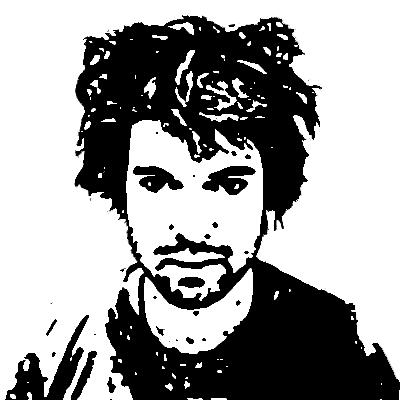
2 THOMAS BARTLETT
occupation : Teeksay work discussed : Harvest/ Out on the Weekend born : 1981 12
passionate fans, and he easily could have kept going, especially as he was learning more and more with each record of what he was capable of. So he had some kind of gift – capacity, maybe that’s a more precise word-- refined from years of practice. Thomas really was the musical prodigy that Nico wasn’t. He was making records at 14, and his path upwards illustrates the ways in which early talent can be nurtured; relationships matter --with his teachers, which we had talked about a great deal [sidebar]; with one boy Sam Amidon, who was his early musical partner and who later became a formidable music artist in his own right; with a network of musicians who were also his friends. And also, of course, here as everywhere else, of ambition.
But then one day (or many days, because it was gradual), he just kind of gave it up. He realized he hated performing, hated the attention he had been actively seeking – and had the self-awareness to realize that what he really loved – his superpower --was melding minds with other musicians, advancing their work while rendering his own invisible. (Similar to the kind of editing I practiced in a sense). He was one of the artists who think focus is basically the crux of creative success. His favorite Doveman record he very deliberately never released; it is a secret, or at least, private pleasure. That seemed pretty extraordinary to me (running so counter to the trajectory of most people’s dreams of pop stardom). His wasn’t the usual artist’s mind, but his refusal of a talent available to him made his brain an interesting one to pick. Thomas is a deeply tender person, wicked smart, his boyish face always marked by light eye makeup. His loyalties are fierce – especially to his family and girlfriend, Ella Hunt, an actress and singer, whose music he is also helping to cultivate (his intense bohemian family structure, which involves a weekly dinner at his family’s house with all their artist friends) always struck me as living in the same universe as The Royal Tannenbaums or Salinger’s Glasses. He now lives in service to a tribe of others, a role he loves.
T he Producing Practice
AM: So what is a producer?
TB: That is a very confusing thing at this point. It used to be so clear. Very often it would be the person who not only chose the singer, the whole band, the material. It was very much an auteur director. The singer was like an actor. That changed. The range of different ways that a producer can be in a project is vast. There are things where I would be called a producer where the artist has basically made a complete thing and brought it to me and I say I prefer this version, maybe take out that verse, nothing else. And there can be times when as a producer I’m writing every song, starting every idea, really working from the very beginning, very much like a total creative partner.
AM: Which do you prefer?
TB: I like both, a lot. There are producers where you hear their work and you know it’s their work, right? And I’m very much not that sort of producer. My emotional fetish and the thing that I like most in the world is to get into somebody’s head and make them feel, oh my god, how is this person understanding my most inexpressible thoughts? That makes me feel so good. And that’s my goal at all times. Sometimes that means starting from scratch, sometimes that means being a sounding board. It’s also that just on a technical level, things have changed a lot. Now it’s possible to make full records in a room like this [we are speaking in his tiny studio, with a big microphone, piano (?), lots of computer equipment] which just was not the case. For a long time producers would have nothing to do with engineering. At this point, 90% of what I do is just in here, with the singer singing into that microphone, and I’m just engineering everything here.
AM: In the projects you’re doing now, what role are you playing?
TB: Okay, let’s see. I’m making a record with Bebel Gilberto that’s bossa nova, songs that her dad {fn1] sang. She picked the material, I don’t know the material. There’s a thing I’m
3
doing for her that’s hard for me to see. Like I genuinely feel I’m useless, and yet she feels like it cannot happen without me. But then David Stith, who records as DM Stith – I’m a huge fan of his work, I felt I would wreck what he did because I can tell his work is the product of many small decisions, each of which I would never make. He dismissed that as a concern. He brought me songs at an early enough stage that I thought, oh wait, I hear how I could be useful. We would get together every couple months for four or five days, over the last two years. We’ve ended up with a 12-song record. There’s a way in which I’m aesthetically intimidated by David, but also David tends to like things that are a little more abrasive, or wilder. He makes me feel boring. I have a bag of tricks that I can do, 99 people out of 100 would say, ‘ooh, that’s exactly right.’ And with David I have no clue. So what that meant was that I became very inventive in trying to come up with ideas that excite him. It made me generate all these new ideas that I’ve now added to my tricks.
AM: Was it also to simplify his wildness?
TB: Absolutely. It was like, how can I translate for all the people for whom his work feels less dazzling- how can I make them hear it?
The main thing I’ve done is to spotlight his voice, and to make him relax and revel in his voice, let that be enough sometimes. Getting the sound the way I wanted it. I really love recording voices, it’s kind of my thing. I find it useful to do it in this room. I have to be totally concentrated on the singer. It reminds
me-- when I’m doing it well – of my first really great piano teacher, sometimes she wouldn’t even give me feedback, she would just say, ‘okay, play it again.’ And I could feel her concentrating on me. It feels more psychic than anything else.
An Old Record Made New
AM: Let’s talk about the Harvest project. TB: Okay, at one point Steve Salett [fn2] who owns the studio suggested we do a covers record of Harvest. And I had been doing these shows we called Burgundy Stains, that was maybe before I knew you. They were at Le Poisson Rouge, it was like Doveman and Friends. I would ask four or so friends to come, we had sort of a house band, and I would pick songs that I wanted them to sing. It was kind of a variety show, everybody playing everybody else’s songs. And it was a kind of testing ground for production ideas. Glen [Hansard] was one of the people in it, and he so completely loved the way the band played; the next day we started recording with that band. That was his first solo record. And that was by far the biggest artist I had produced at that point. And there had been these Hal Wilner [fn3] shows – he really changed my life when I was 15, I think, and living in London, studying with a piano teacher there. Hal had put together this show of lots of different singers doing versions of Anthology of American Folk Music songs. I went, there was Nick Cave and Kate and Ann McGarrigle, Rufus and Martha Wainwright, Jarvis Cocker,
FOCUS (SIDEBAR)
For me, what I think of when I’m doing really well, it just feels like an intensity of concentration that I don’t see other people have. And that will be literally just on how that note will sound. My piano teacher would refer to it as the core of tone. She would push my attention around to make sure it was really doing the job. When I work with a singer all I’m doing is focusing on them. I have this quasi-mystical feeling that the singers will get the best vocals by being right here with me.
4 TAYLOR MAC & MACHINE DAZZLE
Beth Horton, probably 20 different singers. I remember sitting in the audience, just thinking like ‘Oh I found my tribe. These are my people.’ And 20 years later I’ve played with
pretty much everyone who was there, it really was my tribe. And that was the inspiration for Burgundy Stain. Anyway, Steve had an idea about doing a whole series of recontextualizing


5
CAPTION KICKER TEEKAY Figure 1 – teekay Figure 1 – teekay
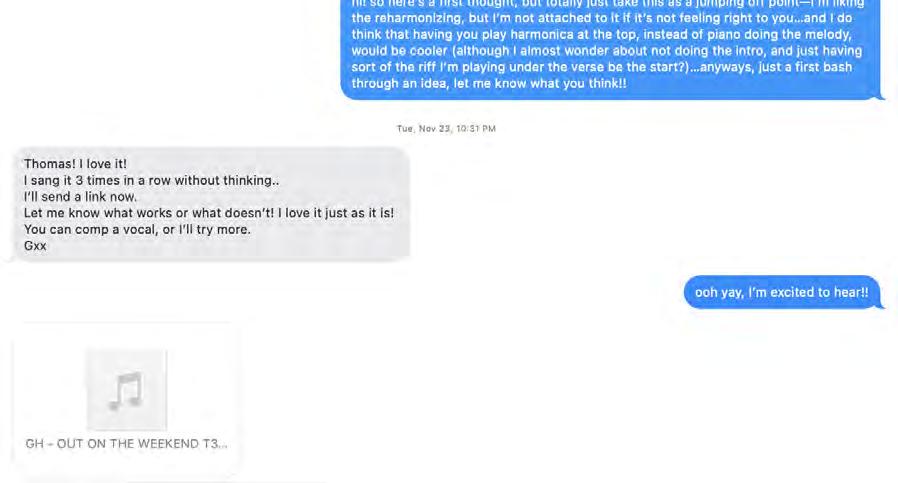

6


7
albums, revisiting old albums. In theory we’re still going to do it, but seven years later, this Harvest record is what we’ve done. I thought of different friends who would be really good singing these songs, I started texting people, pretty much everybody said yes. So we had my dream lineup come in and record over the course of two days. Bon Iver, Viv [Justin Vivian Bond]. Martha [Wainwright]. Sam [Amidon]. Trixie Whitley. Norah Jones. It felt very much like one of the Burgundy Stains things, where we’re hanging out backstage and I’m saying “could you sing harmony vocals on this?” Martha, I had given her Old Man, partly just so I could hear it in her voice. I knew it would sound great, and she and her dad [fn4] have a complicated enough relationship, I thought that was fun. Bon Iver had meant to come and record in person, and then he got sick one day. And he was really apologetic. And I said, if you’re still up for it, you could just send me vocals. I must have sent a simple accompaniment. When we put his three vocal tracks together, it was like, oh, that’s the sound of Bon Iver. For Sam, Trixie, and Norah, they all thought they were doing absolutely straight covers of their songs. And they’re so distinctively each of those three people.
You Ca n’t Escape Yourself
AM: So each had a particular imprint. Do you think that’s a developed thing?
TB: Or innate? That is a conundrum. I lean towards thinking it’s innate. We are blind to our own essence, you know? And one of the things I try to do as a producer is to get people to do what comes to them the most naturally, because people underestimate that thing about themselves. Like the thing that feels like breathing is not that interesting, you know?
I certainly experience that sometimes when I try to rip something off. And then I realize, I was in good faith trying to copy a thing. But it just sounds like me.
AM: And the Glen Hansard track?
TB: Well, it was just him and a harmonica, and it was really good. But you can see why
Nonesuch had this reaction: it just feels like it’s coming from a different record. Most of the other versions feel sadder than the original, you know? So I went back to Glen. And my initial thought was let’s just make his sadder, let’s just spookify it. And actually my first thought was , what if I made it sort of a hymn. I just texted him and he said sure.
[This was their exchange]
AM: As you were working with the song, what were you thinking?
TB: The basic thing was what happens if I take this into minor instead of major. And as I was playing it and looking at the lyrics, it was, how do I acknowledge the shift in lyric. And the decision to hold off the chorus, that was a big one. When I’m trying to make something as bare as this work, these tiny inflections are everything. And then as you’re taking it to this mode, it becomes necessary, at least in my mind, to give it this other harmonic narrative. I think in the second verse I made it all major. And this was more harmonic language for the sake of harmony than response to the lyric. And then if at the very end we resolve it to minor, we still get the feeling of arrival. That was the logic of it. And eventually I sent it Glen and he was delighted. But then I missed the harmonica. But Glen didn’t have a harmonica with him where he was. So I texted a friend, asked him to play along with the piano doing the harmonica. I sent it to him, the piano track I had sent to Glen, with me playing the harmonica melody. Then when he sent it back I rerecorded the piano so I’m not playing melody anymore, I’m just playing chords. But then I wanted it to be stranger. So I wanted it to start with just the harmonica, and I reversed the piano, stripping away the chord version. Then I started fading back in. That’s world building right there.
A Ukelele at 3
AM: What was your earliest experience with music?
8 THOMAS BARTLETT
TB: When I was at daycare I used to strum on a wooden block. And then eventually my parents got me a ukulele. So that was my first instrument.
AM: And you were...
TB: Three. When I was four I wanted piano lessons and I was very determined. And Mom said I could have lessons if I called the teacher. She had to dial for me.
AM: Were your parents musical?
TB: Not at all. But I was just obsessed with music from very young. I saw “Stop Making Sense” and David Byrne became my hero, I would run around the house in Dad’s jacket to look like David at the end.
AM: What were you responding to?
TB: The physicality, I think. It’s mystifying to me now, because I don’t feel as drawn to music as much as I do to literature or food. I don’t recognize myself in that anymore. It’s genuinely confusing to me.
AM: And then I know you were in a band when you weren’t much older.
TB: I had a piano teacher who was a local folk musician. And through him, I met Sam [Amidon], we were six. The piano teacher decided to have all of his little students form a band. I played piano, Sam played the fiddle. Soon Sam and I were just kind of more advanced, and we got into playing contra dance music, which is a New England tradition that borrows from southern square dancing and Irish line dancing. We played every Friday night, 400 people in an Old Grange dancing. I was eight or nine. At 11 we were on All Things Considered, little prodigy kids playing contra dances. With contra music, it’s totally taught by
ear. I had really good ear skills.A lot of the fun in it for me was taking these standard contra tunes and reharmonizing it in a way that felt different. And then a lot of the time I would want to actually write tunes that built into them the subversion. I just constantly was writing tunes.
[After a year spent in London with a very serious teacher] we had I think put out four records. And I was getting bored of the strictures of contra dance.
But I remember feeling I didn’t want a career as a classical pianist. When I did play recitals it just felt I would get sick to my stomach. So I got back to New York, I started at Columbia, I was maybe 17, I got into a fancy competition and I did not get far. And I very much felt like, oh my god, this is not my world. I really hate this. And now I was writing songs, I had started writing songs tentatively a couple of years before – the songs that eventually became Doveman songs. I sang; my voice was really quiet and weird, but I couldn’t imagine singing any other way. I recorded some of them with Sam. It was very self-directed. I recorded a CD and burned 1000 copies of it. And called myself Doveman because my brother had made this postcard collage at some point with my head on a dove’s body.
I booked a few Doveman shows. We played at CBGB’s, which is a weird one, and Mercury Lounge. I’d sent in the CDs and if they liked the music enough, they would give you the least desirable slot possible – like Tuesday at 7. Sam was also starting to sing and record, we lived in Harlem, in the same apartment. He and I started to go to Joe’s Pub every Sunday night
THE DIFFERENCE BETWEEN WRITING LYRICS AND MUSIC
For me, what I think of when I’m doing really well, it just feels like an intensity of concentration that I don’t see other people have. And that will be literally just on how that note will sound. My piano teacher would refer to it as the core of tone. She would push my attention around to make sure it was really doing the job.
When I work with a singer all I’m doing is focusing on them. I have this quasi-mystical feeling that the singers will get the best vocals by being right here with me.
9
because Chocolate Genius [a band and music collective] had a residency there. I was obsessed with Marc Ribot [fn5], everything he touched was magic to me, we were just super-fans. And then one week there was a piano player there who I thought was terrible. And most offensively to me, though Joe’s Pub had a piano, he was playing on a digital keyboard. And so I went backstage after the show, introduced myself and said, I hated your keyboardist this week, I hated the digital piano. And [] said, do you play? I said yes, they took my number and called me and said, do you want to play and I said, of course yes. He said what gear do you have, and I didn’t have any, but I’m googling as I’m on the phone, there was a Wurlitizer for $1000 at Rogue Music. So I said, I have a Wurlitzer. I bought one on the way to rehearsal. And I knew the songs inside and out. I totally revered them and they were super-impressed with me. I played the show that night. So because of my contra skills and really crazy technical technique, I could outplay any of them. And everything can be traced to that show. Pat [fn6] and Dougie [fn7] were in the audience. Dougie became the Doveman drummer. Pat produced all the Doveman records. David Byrne was in the audience. And ??? was playing, that’s how I started playing with Elysian Fields. So I started to play with Chocolate Genius, I went on tour with Elysian Fields, in Europe. Dropped out of Columbia. And never stopped.
How Doveman was Born
I wanted to be an indie rock star, I totally did. It’s just so horrifying to think about, but The National somehow found me, and invited me to record with them as a session musician. Then they invited me to start playing with them when they were playing live, and I said I will, if I can open. I was always trying
to leverage Doveman into things. My initial impulse was, I can’t get that many people to come to a Doveman show, but if I do a Doveman show with Glen and Norah, people are gonna come and hear me sing.
AM: Did it give you pleasure at that point? Or was it just the abstract idea of indie fame?
TB: It was the abstract idea of it. And I was so uncomfortable with being onstage, I would always be off in a corner, as hidden as possible. Sam, who played banjo, would be center stage. And I had Sam do all the talking. I didn’t get huge pleasure out of performing the songs, I always knew it was a little wispy to grab peoples’ attention. But somehow I still held onto the idea. I thought, I’m going to make this music and I’ll bring people around to my aesthetic eventually.
AM: As opposed to trying to refine the music into something that was more...
TB: Palatable. Or popular.
AM: B ut the writing of the songs you liked.
TB: Very much. And I realized this recently. For probably ten years I had a running internal dialogue in my head, just thinking about lyrics. Just trying to write. All the time.
AM: Lyrics, not musical phrases?
TB: Very often I would have the outline of a song and know musically more or less what was going to happen, but only have a few words. And I remember there was a show that in retrospect couldn’t have been more perfect. But at the time, it was like, oh god, what am I doing wrong? A Doveman show at Joe’s Pub. But the entirety of the audience was Lou Reed, Laurie Anderson, David Byrne, Anthony and my parents. They were the only people in the room.
AM: That’s quite a collection of fans.
TB: Yeah, and it felt great. But there’s only so far you can take that particular kind of niche cult appeal. And somewhere along there, it guess it had to do with Glen deciding that he wanted me to produce his record, slowly but surely the ambition and feeling of where I’m focused started to shift from Doveman into making music for other people. Being a gatherer of talent. And then it was hard for me to
10 THOMAS BARTLETT
1.Bebel Gilberto’s father is Joao Gilberto, often considered the father of bossa nova.
2. Steve Salett is a composer and producer.
3. Hal Wilner was a music producer.
4. Martha Wainwright’s father is Loudon Wainwright. They have had a testy relationship they both have spoken about.
5. Marc Ribbot is a guitarist.
6. Pat Dillett.
7. Dougie Bowne
even conceive of having wanted to be sitting onstage singing my songs.
The Abdication
AM: Was there a particular moment you realized that?
TB: It was very gradual. So by the time I put out the last Doveman record, which I thought had all the elements lined up -- Like I had changed the aesthetic just a little to be more popular and I had famous friends lined up behind me. The National is the backing band for half the record, Glen is singing on it, Norah is singing on it, Martha is singing – and maybe this was a reaction to the disappointment that it didn’t do what I expected – but in my head I was already moving away from even wanting it that much.
AM: But it seems you could have continued to write and record music and not perform it.
TB: And that’s in fact what I’m doing. I made a Doveman record a couple of years ago that I think is very clearly the best Doveman record by leaps and bounds. And I’m not going to release it. I’d made it after this revelation I had-- that I was getting all this work as a sideman, as a session musician, and I had found I was really good at finding little instrumental hooks, making things catchy, doing flashy things that bring a burst. And it was unthinkable to use any of that on my own music. It was somehow impure. And so you listen to a Doveman record you would have no way of knowing that I’m a good piano player. None at all. And somehow that felt admirable to me – that I had this really beautiful aesthetic restraint. But this record wasn’t like that – I treated myself as if I were producing myself for the first time. I thought I really am capable of this thing that I like. I’m so often as a producer telling people to stop overcomplicating things, stop getting in their own way. In the past I might have chewed over and over. On this one, gesturally, I thought, just go with it.
AM: So why not release it?
TB: Well one of the reasons is how much I hate performing, and there would have been
pressure to to do at least a few shows. And I had this realization that the record had been happier to me as a thing that just existed that friends heard in a room than it was as a thing out in the world. You know? I’ve played it for people I love and I’ve tried to imagine a way that releasing it would make me feel better, and I’ve not been able to come up with one that seems in any way possible.
AM: Is there just a kind of erasure that you’re seeking?
TB: Totally. I like the feeling of being invisible. It feels kind of glamorous to have made this thing and not let people hear it. I like that.
AM: The arc of your career has such a poetic shape to it. Like a crescendo of self and talent which you then pulled back into its disappearance..
TB: Absolutely.
AM: And its reanimation in others.
TB: As a producer I am able to do this thing I could not do as a performer. I look back on myself with a huge amount of mystification.
11
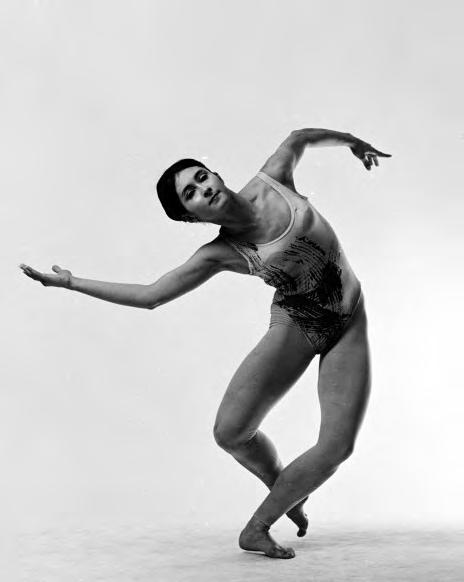

TWYLA THARP
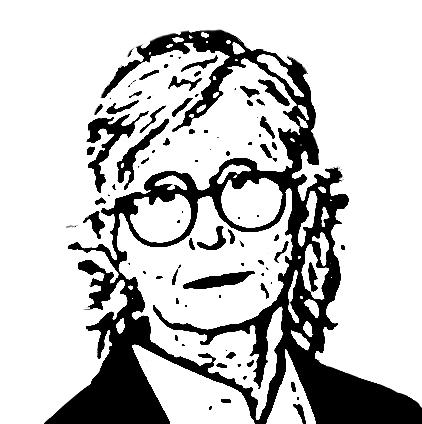
The Sperm Bank and the Scroll
I AM AT TWYLA THARP’S HOUSE, which is also her studio. It’s up in the sky on Central Park West, a penthouse. You enter, there’s a large empty light-soaked room, with a wood floor like you see in rehearsal spaces, because that’s what this is. It takes up most of her apartment. There’s a tiny bed tucked in the back, separated by pretty versions of hospital curtains; Northern California bathroom, elegant bourgeois kitchen, everything immaculate, but that’s it, it’s otherwise a giant temple to dance – a gleaming wood blank- slate and a busy cluster of cameras to the side, light pouring in from the skylight. I described this to a friend, who immediately said “oh, she’s an art monk”-- which fit.
She’s also charming and a big flirt. We are sitting in the kitchen, discussing the work she is about to make, In C, which she gets to in the roundabout way she speaks. “Okay, here’s the thing, the body to those of us who are dance people, we give precedence to it over the mind. For example, I’ll find myself on the street, and I’ll be a little cold and waiting in a line, and I’ll start to [she makes a little movement], and I go, oh that was good. I say to myself, remember, we can use that. It’s like okay brain, catch up with the body.”
I ask her how she captures these movements she makes on grocery lines, a question she seems to be waiting for since I have her told before that I was interested in physical artifacts of her process.
“Are you ready?” she says. She tells me to follow her.
We enter the main room, where I see a giant scroll unspooled from one end of the room to the other, maybe fourteen feet long and two feet high. This, it turns out, is her notebook.
We squat to look at the beginning of the scroll and try to make it out. “I started to work on a piece called “In C,” which is Terry Riley,” she says. “Do you know that piece of music?” I say no. “Well, you should,” she says sternly. Also, impishly. This is a little bit of a performance.
“Terry Riley was given credit for having
2 TWYLA THARP
13
occupation : Choreographers work : Commentaries on the Floating World/Twyla Now born : 1941
TKTKTKTKTTKTK
Ex eostinus venestrum dust, aut aut a ad qui tenietus

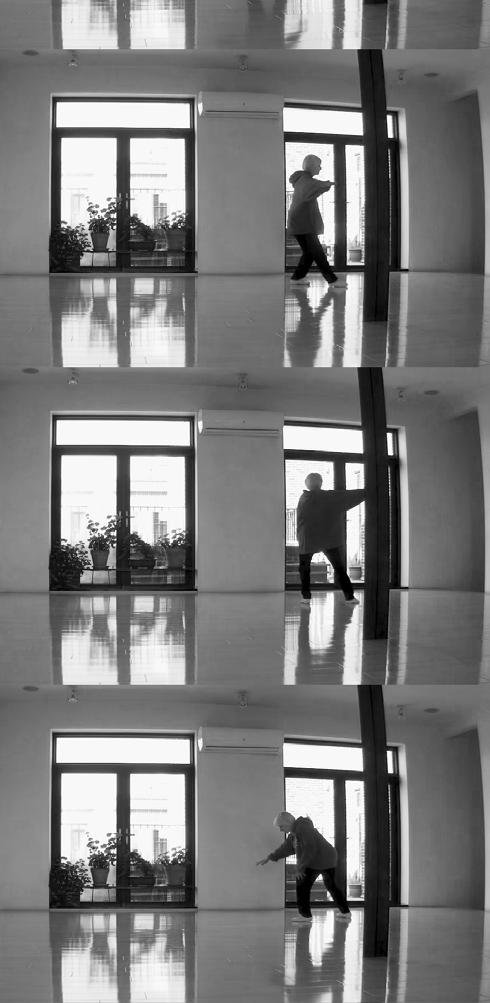
3
SCROLL CAPTION MATERIAL
“The scrolls are a relatively recent development. The scrolls are like the subconscious. They’re rough ideas. Dream is a bad word to use, but they’re vague. Vague. And I can do proportions on them. As I move along, I can do timing – all of which you can’t do on pieces of paper [looking at the scroll]. This is an octet. This has a pattern in it. This has different numbers of dancers. This is a first development which means there’s going to be one here somewhere that says second development. [she looks for it--] And thank you, the second development! These are big borders that indicate a big change in the stage. This is the vertical port of demarcation...

What does this say? Snap, attitude front, wait on right. Snap attitude front. Wait on right. Snap attitude front. Okay? Attitude right. Flick flack. Snap attitude right, flick flack front back, then turn right on the right.” Aside: “that’s a bitch because it’s what we call en dedan. Your momentum is going the wrong way. It should be ‘en dohor.” I look lost. “You don’t know these things, do you? End dedan is French, en dedan is over to the right. En dehors is outside. That’s to the left. Your momentum is going this way, but it says turn the wrong way....” And now she’s back looking at the scroll. “And then this becomes about the structure of the thing... “ she’s demonstrating, showing how it moves into ghosts. “It moved early on. It’s where it says, “ things are possible. So then here we are at the end of the first movement of Ghosts.” She scoffs. “I didn’t care for the piece, there were a lot of problems.”

4
TWYLA THARP
distorted music into what we call minimalism.” Tharp first heard it in the sixties and has been mulling making dance to it ever since. “It has no melodic element, no kind of build, no structural development. It’s chance operative in that its form can be any number of instruments coming in at any time as long as they play these 50 units for any length of time they want until they’re done.” In other words, it is a seemingly impossible piece of music to set dance to, which is why she’s always wanted to tackle it. “It has truth in it,” she says.
She points to the scroll and begins narrating what she’s seeing on it, which all look like hieroglyphics to me. “We’ll go like this and then we’ll go like that. Bodyee or yupboteat or eeup or up.” I am mystified but the scroll is just for her; no one else is supposed to understand it. “I got this scroll out,” she explains, “because I had the opportunity to do this Zoom project and I said what the hell am I going to do. So I thought In C. It’s just that every time I start In C something gets in the way. It’s such a difficult, unpleasant piece. I must have started it eight or ten times.”
The scroll shows her initial workings-out of the piece-- like notes she’s jotting down. “Opposition, snap, attitude front, weight on
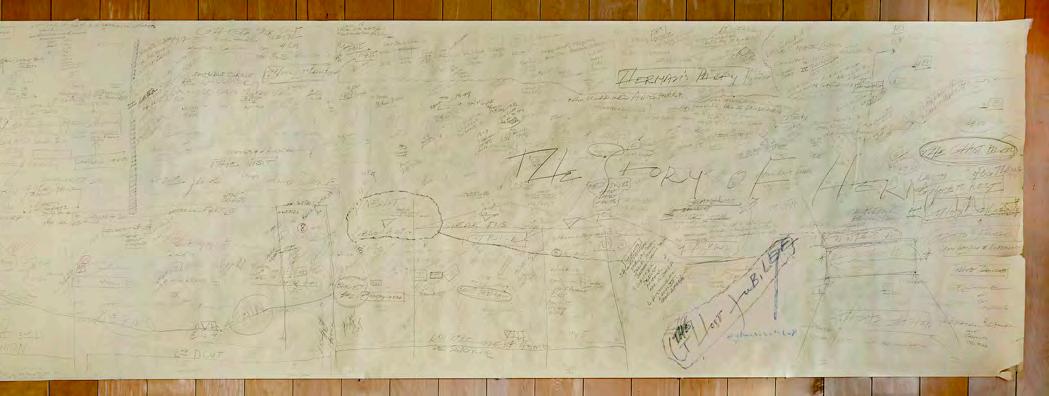
right, alt left. Open attitude, pirouette, right and right. Flick, flack over under, transfer weight left.”
It’s early Covid. She is stuck in her studio, but frenetically busy. She’s recovering from a meniscus tear in her leg and limping a bit but still able to demonstrate, dragging me in as a partner. I am hopeless. She is amused. I ask her if what she’s written on the scroll is her own language. “Well it’s bastardized like dialect – some of it is ballet. Flic Flac is in the ballet but snap is not. Snap is like a snap.”
These scroll notes are from the last time she was trying to make this dance – for an American Ballet Theater commission. She abandoned it because she learned that her commission was going to premiere at a gala. “I thought oh dear, these people are paying $25,000 a table and then they see In C and it drags on and goes nowhere? I don’t think so.” So she gave them the Brahms Quintet instead, for a piece that ended up being called A Gathering Ghost. She is not above pleasing her audience, far from it.
But when she recently got another commission from a ballet company in Dusseldorf to make anything she wanted, she thought okay, she’s going to do it this time – make In
5
WORKING OUT ‘DOOMED’: TWO TRIES, Figure 1 – teekay
C, finally. And that’s the ballet she was plotting as we spoke. She pointed to two more scrolls, which are empty – for now.
Eventually it will be filled with markings. She will plot out the entire ballet. “That’ll allow me to stand back and look at the whole page and see if I move along with it, feel the dynamic, the drama, the non-drama. See what’s flat, fix that.” And it’ll tell her where every dancer is on stage.
“At this point I probably have four and half, five hours of material on In-C. So I will go back and edit that.” She has devised a system to create order within the relative anarchy of the piece, which she describes as “going in on the clock” so while the band will play as they’re intended to play (start and finish more or less whenever they want) the dancers will always be in sync with the clock. I’m not going to describe how that works exactly (I’m not sure I even understand it ) but it creates structure which makes the dance possible. “The basic part is called the pulse, and it’s really boring. And it just starts with something simple. And the idea is this person is on the whole time and they will evolve their movements, so you never see them shift, but you never see them static either.” She knows at this point that she is going to work in a piece of what she refers to as “the hanging chad” that appears at the beginning of the scroll. She has one part she created in another context, which she calls Savannah because she originally choreographed it for a dancer named Savanna Lowrey. And another part she calls Sam and Mary, which she originally created for a lecture she gave.
Savannah and Sam & Mary are taken from an enormous digital vault she keeps of her ideas (this she refers to as her “sperm bank”) – it’s like a trunk of dance phrases, movements, set pieces. To the side of the rehearsal space is a thicket of video equipment that are crucial to her process. It’s where she records her ideas, which she dances out herself. And it’s also how she communicates with her dancers.
In the case of In-C that equipment is vital –her dancers are in Germany; she is choreographing the ballet virtually from her apartment. So the idea is, she will teach the steps with her video
camera, dancing all the parts herself, which is crazy because most of the ballet is performed in duets and groups – big swaths in unison. But she uses the camera even when she choreographs locally. She generally does all the moves herself, doesn’t even bring in others to help demonstrate.
That’s because it’s clear she is absolutely certain no one can do it like she can. Tharp doesn’t even try to fake the creative humility you see in many artists—no one I talked to for this book was more brazenly confident, more willing to own the narcissism it takes to make art. But she’s disarming about it, and it’s refreshing. “I know exactly what it’s supposed to be like, I don’t have to explain what it is. I do it.” Here Tharp breaks into dialogue arguing with herself: “I say, well that’s not what I want. I say, no because it’s better. I say, you’re right, I was wrong, excuse me.” She cracks herself up.
As she talks about what she wants to put in the ballet she free-associates. “Circles-- circles are very interesting. Clockwise, counterclockwise, inside, outside, the juxtaposition of circles going into a single point, the spiral.” She digresses to the Korean boy band BTS. “I think they’re great. They managed to do the ideal being singular in growth so you feel their individualness but also their unity. The more you can bring to the table differences and yet reconcile, that’s power.”
Like all choreographers, she creates dances for specific dancers. So she’s spent some of Covid getting to know the dancers in Germany virtually, assessing what they can do, and can’t, evaluating their talent and also (in some cases dismissively) their attitude. She wants dancers who are devoted to the project.
So after she determines who can do what, “I’ll have them in the room, if they can’t do it, I’ll change it so they can make it work.” And in some sense, they are collaborators. “They know their bodies better than you do. You listen to them, right?” I ask her if she allows for their suggestions. Tharp says, “if they’re clever they don’t ask. They just do it and hope
6
TWYLA THARP
you won’t notice... but you do. And you say, ‘well, that actually is a good idea!’ Because you have to keep them around...” But zoom makes that give and take difficult. “Generally I try to allow them to discover something so that it becomes theirs rather than what they’re seeing on the screen. It’s much easier if I’m in the room and I say to the dancer ‘try this’. And I can say “See, your body wants it.”
But whatever alteration happens during the rehearsal period, it happens fast. “You have two weeks to do it, because if you haven’t done it in two weeks, by the end of two weeks, they’re brain dead. They’re crying. They can’t take in any more information.”

So meanwhile, she’s got three months from our conversation until those rehearsals --she has to have the whole piece pretty much worked out, which involves, beyond creative expression, a certain amount of train trafficking, knowing where the dancers go in and out, making sure she hasn’t created something so reckless it’ll result in broken limbs. Even with the difficulty of choreographing from 3700 miles away, she’s characteristically undaunted, seems very excited to be making this ballet, eager to figure it out. We go back to the kitchen. Before I go, I ask her a few questions. I start, where really all of these chapters inevitably start, at the beginning. TT: I started making dances when I was six. I had twin brothers and a younger sister. And when the babysitter was there we had a quartet. And we did some swinging around.
My mother blessed everything,
7
Voluptus etur sum que plaut ducimagnam faccabo.
she was a concert pianist. She started all four of her kids on ear training while we were still tiny babies. By the time I was two I was practicing like two hours a day. I continued doing that until I went to college. I was studying counterpoint when I was a kid. Without that exposure at that age, I [couldn’t have done it]. Only a child’s mind works that way. It binds everything to the rhythm and the love of music. That’s just who children are.
It made me capable of a focus.
AM: Did your siblings grow up the same way?
TT: They didn’t. My mother couldn’t maintain it. My brothers were twins. They developed their own language, a private language. They had accents. By the time they went to first grade, they still couldn’t speak English. My mother couldn’t get to them the way she could get to me. She was trying to get them fed.
AM: And do you think your mother’s intensity was the main thing that fueled your creative drive?
TT: Apart from the lessons the thing that was most valuable in my childhood was working at a drive in.
And seeing how those films, even without sound, communicated and bound the audience together.
AM : Do you make dances with audiences in mind?
TT: There are movements that an audience will feel and there are movements that will push them back in their seats, they’ll be in awe. You have that kind of control.
When I started making pieces for a bigger market, suddenly you’re taking into account, how do people think? How do they feel? …. You know when we doing the so-called avantgarde, and the audiences got bored, that was their problem. It wasn’t my problem. But now it was my problem.
And I knew how to keep you from getting bored. It changed me. The avant-garde is basically fuck you, it’s icy and isolated and very privileged in its attitude. Just because it’s inaccessible is it better art? I don’t know about that.
AM: When you work out little movements, like the sort you said you did on grocery lines, are you trying to solve a problem? Do you say, I have six minutes here, let me just...
TT: No, I like it to sneak up on me. I like to be surprised. I’m a restless child.
AM: So it’s always movement first, not mind first?
TT: Well, if I see a necessity – how to get them in, how to get them out, that’s a different deal. Or if you’re dealing with narrative and you have a narrative problem. But that’s usually more thinking “Oh, I’ve done something like this before, I’ll bet I could use it. I mean, if I get up against the wall, I’m not above pulling in something I know will work because I’ve already done it that way .
AM: Do you find yourself dreaming solutions?
TT: On occasion when I’m on deadline and my neck is really on the line I will realize my situation is so dire that I must have a solution in the morning. I can do that. I can will myself to dream it. Also, every now and then I’ll wake up with a certain kind of feeling, and it will be enough to send me into a different way of thinking. Maybe because I was injured, in the night recently I was feeling water, water, water and I’m going yeah. Water. No stoppage, nothing abrupt.
AM : In general, do you have to see the whole thing or can you build a dance part by part?
TT: By part. I used to get nervous about either the ending or the beginning, but then I realized the ending is just another part like the middle. And often I go back and redo the beginning, because though you may think you know where you’re going, it’s probably going to end up differently. Often it’s valuable to let it evolve and then go back and take off that fake beginning.
AM: How important is the beginning?
TT: You have 30 seconds. 30 seconds before people are either bored or they love you. You can win them later but it’s going to be harder.
AM: Is that 30 seconds the hardest part?
TT: No, I’m pretty good at that part.
AM: How do you think about editing your work?
TT: Editing means how much objectivity do
8
TWYLA THARP
you have really? How much can you disassociate from your own bias? How much can you disassociate yourself from the wish fulfillment component that is involved in work of all sorts. You’ve got to become not you.
AM: What kind of dancers make the best choreographers?
TT: Young ones.
AM: You’ve been doing this a long time. What do you know now that you didn’t when you started?
TT: I’ve learned it’s more rewarding for me to be empathetic.
AM: Is experience ever a detriment – does it ever inhibit you creatively knowing what hasn’t worked before?
TT: You have to forget it didn’t work. It’s different now. Who knows?
AM: When you finish a piece are you still toying with it years later?
TT: Noooooo. I am done with it, and if I am not saying at the end of that, I’m never making another piece ever again in my whole life, I’ve put it all out there – if I don’t accomplish that, the piece is no good. And that seemed the right place to stop.
Part 2, Six months later. In May 2021, I’m back in her apartment. We’re photographing the scroll and her notebooks I don’t have to be there, but I come anyway because I sort of fell in love with her the first time. She’s in even a feistier mood.
This time, we take our seats and stare at her computer together. She is preparing tomorrow to enter a rehearsal studio for the first time since Covid to start putting together a show at City Center that will be performed in six more months. She is eager to show me what she’s planning. But before that, I ask her how In C went. Indulging me, she searches for a video of it. It has been renamed Commentaries on the Floating World; it’s been shot but not at that point performed live, still waiting for a time when audiences can reemerge. Basically for the next couple of hours I will watch her watch the screen, narrating.
“See this. 17 dancers, 40 minutes in three
weeks. Running two studios simultaneously with four assistants. Here we go--”
As she watches, she’s impressed with what she’s seeing. “Actually it’s a good piece.” She points out phrases she likes especially. As she was making the piece from afar, she’d dug them out of her archive. “You don’t have time to come up with this many ideas in three weeks, believe me. You have to stockpile it. The material is being used so quickly. I fed whole phrases in, which ordinarily you can’t do.”
In our earlier conversation she’d talked about a male dancer whose attitude she didn’t like. Without prompting, she brings him up again. He’d gotten to her. “There was one guy in there” – this was the guy -- “that was so fucked up, I said don’t go there. Attitude, moved weird, was a little aggressive. He’s not, nobody is worth it. And I kept watching. And I’m going, don’t do it. And he turned out to be fabulous.”
But it’s when I ask her how the dancers accommodated the complicated demands of the music that’s always changing that I realize that, among all her traits, resilience is maybe her most striking. In our last conversation we’d spent so much time talking about how important the radical nature of Riley’s music was to the piece. Now she casually mentions she’d abandoned the entire scheme.
All those random variations, out.
“It had to be set. Because they’re German. They could not accommodate the notion of spontaneity. But it’s ok. In C is so fluid you basically can compose it yourself. It basically set itself. It’s not like Brahms, you can’t dick around with Brahms.”
Later, I ask her about the frustration she’d exhibited in one portion of an American Masters documentary (her fretting over the difficulty of choreographing on Zoom) and she tells me that she’d faked it, or at least amped it up so the filmmakers would have something narrative to work with. She says she simply doesn’t get frustrated. “It doesn’t happen to me. If something turns a corner, I turn a corner.”
9
Anyway, she doesn’t really want to talk about In C/ Floating World. She’s on to the next thing. She finds an old video from seven years ago of the City Ballet dancer Tiler Peck working out a piece with her fellow dancer Robbie Fairchild. This duet will be the first dance in the City Center program she’s going to start rehearsing tomorrow, which will be called Twyla Now. We watch the old grainy video.
The video is of a moment Tharp had lured Peck and Fairchild up to a Harlem dance studio for a piece she wanted to make. “It was done,” she says, “because these two dancers who are very talented and who were bored to tears at the City Ballet and it’s snowing outside and the poor little things, their boots leak and so they come up to Harlem, are rehearsing and they cut Nutcracker rehearsals in order to just come in and dance. And I made the whole thing very fast. I’m very fast. These are very talented sophisticated dancers. Tiler Peck is faster than the shit. So it’s like bang bang, okay speed. We’ll use speed. She’s also very receptive. ”
Peck and Fairchild returned to Harlem over and over to make the dance with Tharp. She was seductive and they were hungry. “I mean genuinely, they were freezing to death. If one of them had been injured, that would have been it, I had no insurance. Nobody was paying them. .. Nobody knew we were working there....” On the screen she’s watching Peck.... “Tiler has this. It’ll be interesting to see the dancer she is six or seven years later...Poor Robbie. Poor, new Robbie. Okay now already you see Robbie, who’s a very good dancer, froze. It’s probably the third time they’ve done this. He didn’t know what he was doing--”
Tharp is staring into her computer, loving this. “It’s a very unusual Adagio. And it’s not easy to find a new Adagio, because there have been hundreds of thousands of Adagios done. So that’s what I’m looking for.”
Peck and Fairchild stumble on the screen-“She didn’t know what to do. Yeah, they fucked up.”
Peck will perform the piece with a different
dancer at City Center. Tharp is still marveling at her work and at the dancers, whom she reveres. “That’s what we call in the trade an opener. Perfect for Tiler Peck, who’s a charmer and will get out there and sell it to death, poor girl.”
As for Fairchild, he’ll be at City Center too, but in a different piece, dancing Tharp’s part in a piece she did with Mikhail Baryshnikov for a show they took on tour (Baryshnikov’s part will be done with the City Ballet star Sara Mearns.) So now we’re on to that. She finds it in her archive.
“Our tour was the highest grossing tour in dance. We beat Fonteyn and Nureyev.” I ask if making a work for Baryshnkov intimidated her, but I already know the answer. “You’re a modern dancer from the Midwest. He’s a superstar. You go, ‘Okay I can do this. Let’s see you do this.’ And then pretty soon there’s a respect that gets developed. He was handed that [his talent] on a silver platter. He was instantly a great dancer. And what do I have to do? I have to construct an entire vocabulary, make dances and have a career and still people are baffled.”
We get to the finale of the dance which she watches intently, especially her triumphant last gesture. “We had to save enough to get through this—Oh, I love that part. That part is so good? You’d pay money to see that, right? I always give myself the last word. After all I was the choreographer.”
Sandwiched between these two pieces will be a world premiere, and this I’m especially interested in seeing, since it was developed out of improvisations she did years ago, and which she deposited in her ‘sperm bank.” It’s her other notebook, a moving pictures version of the scroll, so I’m interested in seeing it. It’s into her trunk that we go.
“Okay,” she says, “here is the historic sperm bank. These are historic documents.” She started recording herself playing around in 1968, and has made, she says, thousands of hours of tape, sometimes bringing in others to play around with her. “I started making
10
TWYLA THARP
phrases I could lift wholecloth, take off James Brown, put on Brahms if the material is good. I’m looking for something that feels like an idea that I can take somewhere... This is me evolving a phrase, actually. This is how a phrase gets solidified. It’s like you have a rough piece of wood and you’re carving it into a form and then you polish it and so forth--”
As she’s looking for the tape she will adapt for this new piece, she stops at one faded tape of her dancing with a male partner. “Ah, this is a guy I picked up in the gym, I started working on it with him.
…I needed a guy to come in and work with me ----- and then I started to work with a really strong dancer from my old company named Kevin O’Day... Okay, here’s the duet --”
It’s from 1991. You can see a younger Tharp trying out all sorts of moves in an empty studio, some lyrical, some very athletic, many very difficult. I’m mesmerized. Tharp is too--
“Okay, this is the duet I will start to rehearse tomorrow. The trick will be setting it on two dancers so it looks improvised.... I’m going to have to look at this slower to figure out the hell he’s doing here. Its a flip in the half. Right. So we’ve never done this before...”
“... You know who worked this way a lot, was Beethoven. Beethoven did this a lot in this sonatas. He didn’t have a recording but he had an ear and a pen and piece of paper...”
She’s watching intently, thinking about tomorrow. “It’s gonna be very hard to get dancers to be able to do that. The problem is, as you can see, I’m very strong. Most women don’t have that kind of strength. They can’t hold their own weight this way. And dancers are taught to make it look easy. Hello people, it was not easy.”
We wander through more video; she’s in a reverie watching tape after tape of her dancing. “Ah, this is one of these improv sessions that is not making it into anything which is really kinda too bad because it’s a hoot... Here’s a good one. I like this one quite a bit. You have to watch it closely. Be patient. Let this finish... Oh, I was a very good dancer. Very
accurate. Very well-mannered. Very sophisticated dancer...”
I ask, somewhat delicately, how it feels not to be able to perform anymore. She bristles, maybe joking but with her, you can’t really tell.
“What do you mean I can’t perform anymore? Like I might die?”
It’s getting late. Tomorrow her exile will be over. “I haven’t been working with dancers in the studio for whatever- a year,” she says. She’s 80 and so excited she’s practically jumping out of her chair. I leave.
Six months later I go to see Twyla Now at City Center. It is kind of culmination of her life’s work, and it is beautiful. But I don’t know what is more impressive-- what is happening on the stage, or what is happening in the row to my left. I happen to be sitting near her. I watch Twyla Tharp watch Twyla Tharp. She is rapt.
11
ANDREW JARECKI Conjurer Extraordinaire
THE DIFFICULT THING TO believe about the brutal documentary classic Capturing the Friedmans is that it began its life as a little movie about party clowns. Nor does it seem possible that it could be made by a novice filmmaker, especially one whose central resume item was that he was a tech entrepreneur millionaire before the culture started minting them. Sometimes fate really works like that. And when it does, considerations of the role of luck in making anything inevitably come into play. But luck is – as it certainly was in this case – usually earned. And then what?
Andrew Jarecki was a rich kid, son of a psychiatrist who would end up hugely successful in the gold business. His mother was a cultural critic, sensitive by nature. Jarecki was torn between business and art – fierce and emo at the same time. He went to Princeton, and on to Yale Drama School to study acting. He had worked in the family gold business, and also as a theater director (“if there’s one thing that’s the most “me” thing, it’s probably bridging these worlds,” he said.) Then after observing that the process of finding when a movie was playing and buying a movie ticket was begging for disruption, he invented Moviefone, one of those obvious-in-retrospect businesses that allowed customers to use the phone and eventually the computer to purchase tickets. It didn’t last long, coming just before Internet ubiquity. But his timing was excellent, he sold it to AOL and made his own fortune.
So that was the situation when he began making a light movie about clowns who entertain at birthday parties in order to teach himself how to make a movie. His lark would evolve into a psychological swampland, a portrait of a family – destroyed is almost too genteel a description – after the father, a math teacher, is arrested for raping young boys who’d come to the computer class he gave in his basement. Soon the youngest son is arrested too, for aiding in the alleged rapes. The Friedman children rally around their father, turn against their mother. The town becomes a modern lynch mob. Truth is elusive, accounts contradicted.
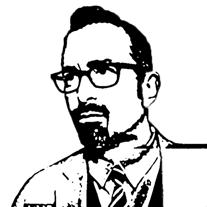
2 ANDREW JARECKI
14
occupation : filmmaker work : Capturing the Friedmans born : 1963
“People are disturbed by ambiguity,” Jarecki told me, and he built a movie around that discomfort. It’s not really a true crime documentary, though it’s roughly in that genre; it is more a psychologically-searing family portrait, and also – and this accounts for its power – very much a meditation on truth, the need to tell secrets, to divulge, to be seen – themes that feel especially prescient for a movie made at the beginning of the century, before the age of reality television and social media. The film is stitched with the family’s home movies, which contain some incredible material but are also very artfully used. It unspools with patience, one story layered on the next. It’s the first documentary where I ever noticed a filmmaker successfully developing themes, principally around family obliteration, I’d appreciated in other artforms. But this was not the movie Andrew Jarecki thought he was making: he was making a movie about clowns.
“I started out in one place and everything changed.” Jarecki told me. You could make a movie about the making of this movie.
“In 1999 when I sold the business, I immediately started thinking about making a film. I’d made one short and I wanted something bite size that would get my feet wet. Something really simple. And I met a weird guy in a New York restaurant who was doing balloon
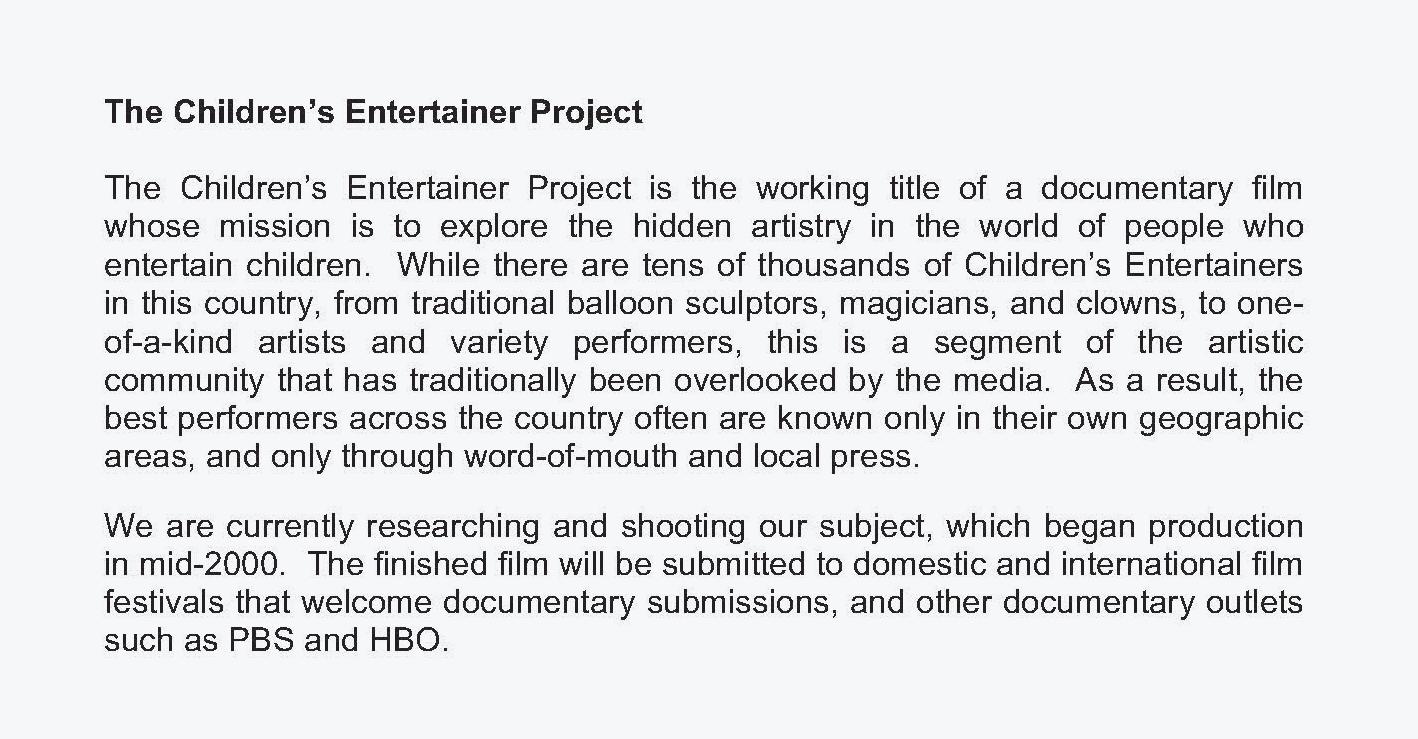
twisting for kids. And he explained to me that there was a little culture of children’s birthday party entertainers who were all friends. Silly Billy was the number one guy. And he was friends with Princess Priscilla and Professor Potter and Wacky Wendy, the paper plate lady. I thought, these are people who live among children and haven’t totally grown up yet, this could be a really interesting weird story. And I bet if I work on this, something will happen.
“And after a few months, I had still not reached out to Silly Billy. I was waiting, because if you’re Ron Perlman [fn]and you want your daughter to have a nice birthday party, that’s who your assistant’s assistant’s going to call. And he’s going to come over and do a show that’ll be great for adults because he’s full of sarcasm and kind of a dark character to begin with. Maybe the kids are going to start crying, which is what happens at a lot of his shows. I thought I’ll call him last. And when I reached him he said, well it’s not much of a film if I’m not in it, now is it? And I’m thinking this is so great. He’s selling me hard on him being New York’s King Clown. And so I start filming him. And there was this great editor I had met – Nancy Baker’s her name-- I started showing her the footage. And I said, what do you think of this guy? And she said, ‘I kept asking

3
Dolut eliciisqui te volupti ne et fuga. Sit quiae.
myself, what makes this clown so angry?’
“And it was just such a clarification of what I’d been feeling. And I thought all right, maybe this guy is going to be my film, I don’t know. So I kept going – meeting with him and meeting with other people. And he started dropping all these little weird hints. He would say, you know I really don’t want to talk about my father. He was a good father, I don’t want to talk about it. And then he would say the most hateful things about his mother – ‘my mother is an idiot, my mother is sexually immature.’
“And so I remember thinking, I’ve got to find out what’s going on with Silly Billy’s mom. I had asked him a number of times if I could talk to his mother, and he always rebuffed me: absolutely not, he said, she’s gong to say crazy things. Which obviously piqued my interest. And then I knew that as it happened he had been on Candid Camera as a kid, which was a real big deal, it was maybe the most popular show in America. And so I had gotten a copy of it, I watched it, he was running around playing with Christmas presents and it was boring. I’d put it to the side.
“And Billy – David was his real name --calls me one day, He says, you keep bugging me about talking to my mother. I never saw that episode of Candid Camera I was on. If you could use your filmmaker magic to get me a copy of that episode, I’ll let you talk to my mother. I didn’t tell him I had it already.
“And so I called Elaine, David’s mother. I said, you know David has arranged for me to come see you. She said, yes I know. I said, I just want to make sure you’re comfortable. She said, Well, to tell you the truth I’m not. And she went on, I had a bad experience with a filming. People said it was going to go one way, but it went another. And it was very upsetting. And I said, look I don’t think it’s going to be the same. What was that, a motion picture? And she said, No, that was a television show. It was something called The Geraldo Show. And I thought, Oh, that’s interesting.
“I get to her house. She says, you follow me. In the back of the house, there’s a tiny
office with a little sofa and a desk. She says, put your camera there. Andrew, you sit there. I’ll be back in a little while.
And on the writing table is a blotter. Facing me is a letter, a handwritten letter from her, ostensibly to some newspaper -- a letter to the editor. But it had clearly never been sent. And it said, A deeply religious person, I was brought up in the Jewish faith to believe that truth and justice were the most important things. Truth and justice were never part of this case.
“She comes back in and we talk as if she hasn’t led me to this document. And the interview is largely in the film. We talk again the next morning. She says, I don’t really want to talk about his father because you know, we were divorced. And when I say to her I hear from David and from your other sons, they’ve got these negative things to say about you, but they’re glowing about your ex-husband, she says, you know it’s classic that children side with the abusive parent. But we’re not going to be talking about the Friedman case. That was all. She’d clearly been admonished by David – a filmmaker’s coming, ixnay on anything other than I was a wonderful child. But she was dying to talk about her life.
“I call my assistant from the car, say look up the Friedman case, 1980s, in Lexis/Nexis [fn]. She does, says, you’ve got to pull over. I’m going to read you something.”
She reads him a cover story from the Long Island newspaper Newsday called “The Secret Life of Arnold Friedman.” It reports that hundreds of kids were raped in the basement of the house by David’s father Arnold.
Jarecki is shocked, and fascinated. He continues. “I wondered how to go back to David to talk about this. At one point earlier he had said to me, after I probed a little bit about what he meant about some of the things he was saying, ‘Oh you’re a smart guy, you could figure it out.’ So when I went back to him I told him I figured it out. And he said, Uh-oh. “
Ultimately Jarecki convinced David to participate. Jarecki had read enough about mass
4
ANDREW JARECKI
hysteria in child abuse cases that he didn’t necessarily believe the charge, and he persuaded David it was in his best interest to tell the story his way rather than risk exposure form a less sympathetic storyteller, which was both true and disingenuous.
“And little by little, he started to-- I don’t want to say warm to it – but he said, I know that subconsciously I want to tell this story. But I’m telling you, my conscious mind knows that this is not good for the clown business.” Still David said he might cooperate if it would help his brother Jesse get out of prison – which was news to Jarecki too – David’s brother was in prison as well? And then he said this: “I should tell you if you’re thinking about this being in your film, that I got a video camera shortly before the cops came to my house. So starting when the police came to my house that night and everything changed, I started recording the family falling apart. And I have 23 hours of video from that period.”
So, luck. Preposterous luck. The discovery of the story first, and very significantly the footage later, made it clear to Jarecki that there was an extraordinary movie to be made even if he did not have the experience to make it. Jarecki did not lack for confidence, or wiles. Ultimately, he won the cooperation of nearly everyone – Elaine, Jesse, the detectives for whom this was the biggest prosecution of their career, some of the children who had made the accusation, pretty much everyone except one of the Friedman brothers. Eventually everybody talked, each for his own reason: “Everybody had a secret. Everybody wanted to tell me the secret, but didn’t want me to tell the secret to anybody else.”
“And so,” said Jarecki, “the picture started to evolve.”
Jarecki set to work as both investigator and artist, not traits that usually cohere in the same person but that might have something to do with being brought up in the vortex of business and art, logic and intuition. He proved a relentless, effective interrogator. And then armed with the epically clashing accounts he
was collecting, the telling of the story, by his account, seemed obvious. He and his editor Richard Hankin played the opposing versions against one another, over and over, which became the spine of the film. (“When I first met with Fran Galassom the detective, I asked her the most memorable thing about the case. And she said, ‘I guess it was the fact there were foot-high stacks of child pornography in plain view.’ ” And it wasn’t until months later, when the records department sent him the stack of Instamatic photographs the police took when they went to the Friedman house, that “there are no foot-high stacks of anything, anywhere around the house.” Once you put these two things together –her account and the photographs--, “It kind of tells you how you’re going to tell the story.”)
But he was after more than building a case. He’d stumbled on a story of almost unfathomable literary potential. He recognized its depths, even as he didn’t know what to do with it. “It’s a process,” Jarecki said, of following a formula, and then breaking a rule two seconds after you start.
“I remember writing an outline of this story. And then sitting with Richard. And thinking, are you being a businessman about this? Are you cataloging things and trying to systematize something? Is this process going to get you what you want? Or is the process going to suck the life of watching the film? Writing it all down makes me feel less anxious. Sometimes I write in narrative form. And sometimes in bullet points, sometimes as chronology. And I feel I’m being a good boy.” Jarecki was alert for metaphor, which turned out to be everywhere he looked. “And then you go into the edit room, and you start talking about something like, what about the footage of the little girl in the ballerina costume?” – there’s this seemingly irrelevant bit of a home movie, of a young girl (Arnold’s sister when she was little) twirling on a roof – “what’s up with that piece of footage, what does it mean? Well I don’t know. On the one hand, it’s simple and beautiful from a time
5
Uga. Busdaer iaepta dolupta simenda volor re dolestr untius et labor ma quis ipidi dessed qui consequis et, non cus acimpedi volesequi dolorro vidus, et paruntur reribus, nossimaiost odigendis et velluptur molorios aut que verfero volores consequ iscipid usaersp ellamus ipic te natquatque sae. Pic tem quae. Nam re enistium hil molore sitiam fugit et as res magnis dolorio. Ovidus int, sum eum et, sam, sunt quis aut peliquatis aut dolupta tusdae si tem rectat venienimil magniet es nobisquatum eum quo blam, coritius de restis consequam id magnimus maio ipic totatecaerum sitate nonsequas seque sinto moloritassum ipsa verum conseque volesequunt.
Et offic tem nonsequi blacero tet volo officium di am nonsent intemporum eatum erchita tectem non consequo quam nonsequ iditatq uaecte volese conse es ea si te ped ut laborum et dolo illaborestia quid que idem estiis eos ut expliae ratatem ressecae. Gitecti aecusto ius aliaturit labo. Ut opti con cullace pudanim odiciist, ulloriossita in nissin pe re sintecab impelit, simuscipsae lantisquo beaquid quidelendis volorporem. Ihit que cus enistectist magnient, sundis rehenda estrum remolorem a consectem doloreptia voluptat et, inis autassi maximincium quam volupta vendessi aditate mporiatatur, sunt as et, suntis porerument elitia et idit quis dolorro et untibus quidell aborrov itibus nis quodis as poribus nus, sectur min eatiorector rem eum quias non nescili gendemp erehenim alit
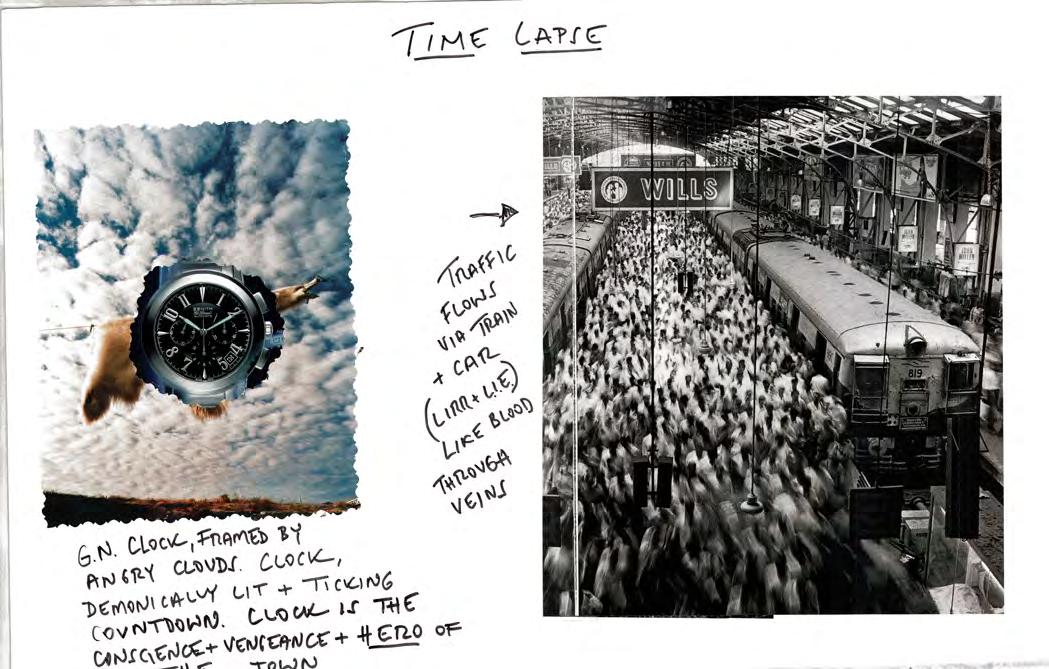
6 ANDREW JARECKI CREATING METAPHORS
et que nonsequation num auditatus ex excest eume volendus essunt ut est, volor aut aut et ime volupta nissinctem volest et quatiis dolorep eremporum hil minvenimus con perchil itatque necessimusa quae cus, natem que volum faccull orissus maio. Bis siment es non etur alisitas simint, quos eveliquis ad quatiusam, cuptatenis moluptatem volupta velit pe ipsam re non corem et aperia aut essimus eatures ut eaque pedigni hictore hendusam es dolorro tem reium est, sequatur?

Fugia ducit, conem quist et hita pro quis desequas evenimillam, nonseque officta tisquisincid quia aceress enectio exces ab ium que nobit que nonet quis inullan dusanti opti nemos es arum harunt aut aspeditamus verrunt qui blaborehendi consectur, quata vel ma nihil inihillum aut res volorib ustoratem verum vitiissitat.
Ro et audi dendae nonsed que doluptaque conest ame conseditatem harchicil ex et voluptam fuga. Sim vernate mporitatus quam rerumquo consecum que ipsum aces eumqui omnia pligent volorem idellis pro minciet magnatiis untibus.
Udissin repudit eum ellabor siminus, tem sinciur?
Ximaiostiam asperfe rrumquis doluptatur, nuste rectem eseque sumquibus ent officias di cumqui cus as
7
before all these terrible things happened to the Friedmans. On the other hand it’s a grown man up on a roof with a little girl and he’s making her dance and filming it. It’s innocent and guilty at the same time. So you kind of blow up your outline, and you start to wonder who’s going to be talking under this footage, what kind of music is going to be under it?
“You look at sequence, courtroom testimony, moments- and then you just have this abstract figurative process of saying, what feels right here? What’s going to carry the emotional storyline while I’m here scrambling to make sure I make all my points?”
To some extent, as often happens, once he was in motion the elements seemed to fall into place on their own– he just needed to get out of the way. At one point, he was filming the main accuser sitting suggestively, almost masturbating as he is relaying his story of the assault.
“He is obviously a very troubled kid. And I almost fucked that scene up by asking him too many times to sit up. Because I’m thinking aIl I want to do is make a good movie and I want it to look like a professional job. Eventually I’m thinking what am I doing? I’m supposed to be capturing reality here.
I didn’t realize until later how much digging around in his pants he was doing because I was mostly looking at his face.”
Jarecki rejected voiceovers and visual reenactments, which might have made telling the story easier. “I think you can do something more abstract and gives room for the audience to bring their imagination to it.” But the film is complicated and he was looking for ways to pace it. He used plenty of footage of a playground in Great Neck, Long Island where the story is set. Time is an important theme and he found a clock in the town that helped him underline the point nonverbally. And he hired a composer (two actually, the first he fired because his score didn’t work) to create underscoring orchestration that heightens the film’s almost operatic scope. It sounds hokey but doesn’t play that way.
Ultimately what he was learning as investigator complicated his role as filmmaker. Because
while he came to believe the abuse in the basement never happened, he also concluded that Arnold was in fact a pedophile, and abused others. And took his innocent son down with him. This he never says outright because nothing is said outright, and many viewers would later report said that they didn’t know what to believe after seeing the movie. But this point of view undergirds the film.
So of all of his decisions, the most important is the one declared in the very first beat. The film opens with Jesse --home movie footage of Jesse introducing his father to the movie’s audience (the home movie, and now, this one) with obvious adoration. Arnold beams, childlike. There’s a brief snippet of Elaine, saying “let’s face it, Arnold liked pictures.” Double meanings abound, as they tend to when you’re looking for them. There’s another quick slice of a home movie skit, with a little sign, “Warning this show may be hazardous for you health.” One portentous beat after another, all culled from this goldmine of found footage. The soundtrack plays the song “Act Naturally” (“we’re gonna make a film about a man who’s sad and lonely... and all I’ve got to do is act naturally”). Soon he cuts to David squirming, saying there are some things about his father he doesn’t want to discuss -- a vestige of the clown film -- which he then undercuts and punctuates with an excruciating snippet of a video diary David made after after the arrest: David telling whoever has found this footage to stop watching, this is private – adding “if you’re the fucking cops, go fuck yourself.” It’s awful.
Jarecki arranged these five harrowing minutes to set out the film’s themes and metathemes, and tell the viewer that Jesse is the emotional center of the movie – pay the most attention to him. “We probably tried 50 other things,” said Jarecki. “But the reason that opening worked is those are the stakes: What separates tragedy from melodrama is that there has to be something lost when a person is taken down. Arnold Friedman may be the tragic hero. But Jesse is the stakes. As
8
ANDREW JARECKI
for David, who cares about David? He’s a very sad character, and he creates the momentum of the story. But at the end of the day I’m not going to cry over anything having to do with David. It can’t be a story about Arnold. It wasn’t a good idea for Arnold to be the Pied Piper of Great Neck. And surely not a good idea to bring Jesse in as an assistant. Because once they knew Jesse was potentially an exculpatory witness, he had to become part of the problem, he had to be even more vicious than his father. Little by little the viewer starts to feel a little outraged that they were taken in. And yet they’re confounded because at the core of it, Arnold is not necessarily a great person. I always say in the editing room, both things can be true. Arnold can be a wonderful teacher, even a good father, but he can also be a pedophile who destroyed his son’s life.”
So the opening takes the entire byzantine saga and creates a hierarchy of sympathy, with Jarecki asserting Jesse’s place as the film’s principal character. We will not really meet Jesse again until the last third of the movie, after the case in all of its wobbliness has been relitigated on film. But in the end the movie is not so much an injustice indictment as it is a movie about a very tragic, very fucked-up family.
You can imagine this thickly-layered family drama in the hands of an Arthur Miller. But this isn’t a play--it is a true story, about people Jarecki got to know intimately over the years he made it. At one point Seth, the brother who didn’t participate, screamed at Jarecki that he was destroying his family. Jarecki felt troubled by it, and went to see Robert Coles, a child psychologist and kind of guru of ethics, for counsel. Coles gave him his benediction, told him he was doing the right thing, and by the time Jarecki finished the film he came to accept that his project had been mostly for the good, even as he was still beset by some ambivalence. “I felt all of it. I felt I had done right by them. In any case, I felt I had captured reality.”
The film won the Grand Jury prize at
Sundance, was nominated for an Academy Award, and was, by documentary standards, a box office hit. Most critics praised the movie. Later, as it got written about, Jarecki got some grief over elisions of testimony. Also, when it came out that Jarecki paid for Jesse’s appeal, some felt that the movie’s calibrated ambiguity was a con. Documentaries will always be vulnerable to criticism that the filmmaker distorted facts in the service of art, but still, I’ve watched it over and over, and it never ceases to astonish me.
Several years later, Jarecki engaged in another project requiring the subject to invest him with a trust that seems beyond comprehension. That was The Jinx, the HBO series investigating the real-estate scion Robert Durst’s role in the murder of two people, and the disappearance of a third. Durst was a pathological figure, who agreed to talk to Jarecki after seeing a fictional movie he’d made about Durst’s life called All the Good Things, which Durst thought was fair. I won’t go into details about that movie or the series, which could make its own entry, but I’ll offer here Jarecki’s account of how he obtained Durst’s confession, which would ultimately lead to Durst’s arrest. Durst died in prison (as did Arnold by the way). The confession, which they discovered at the eleventh hour, came about this way:
“We were very far down the path of finishing the series. And there’s a terrific editor who I’ve worked with, and she’s very thorough. And we were going through and cleaning up the audio so that we could finalize the footage, and she went to the scene that we had in the Regency Hotel conference room [where they were interrogating him with evidence that appeared to nail him]. And Bob was in the bathroom. There were two microphones on the same track. My microphone and his. And there was a boom mic in the room. So there were a few microphones going on at the same time. And in order for her to make it as crisp as possible she’s getting rid of all the extra junk. So you just remove the room noise, or whatever it is. And when she muted the two
9
tracks-- mine and the room track, she hears the door close in the bathroom. Before, all the tracks were mushed together. But when she has muted the other tracks, she hears him close the door and say, There it is, you’re caught. And when she heard that, she just freaked out.
“And Bob’s in the bathroom for like seven or eight minutes. And they find another drive and there’s all this noise on it. But when they mute everything else, they start playing it. There’s loud peeing sounds, there’s toilet flushing, and you know he says a dozen kind of amazing things. Shifting his perspective all the time. Sometimes he’s talking like Bob, sometimes like me, he’s just kind of free-associating in there.”
The series is very good and might have been successful without this audio, but with it, it was a sensation.
So again, luck? Once maybe, but this was ridiculous. You can’t ignore the fact that Jarecki’s work seems strewn with crazy, fortuitous accidents.
Still, Jarecki was built for this luck. His investigative logic and his supple emotional instincts leads him places. He knows how to tell a story – you can hear it in how he tells the story of the getting of the story. He recognizes a juicy bone when he sees one, and knows how to go to town with it.
I asked Jarecki why people seem to tell him things. “I’ve always had a slightly overdeveloped sense of empathy,” he said. “And I think Bob felt that, because it isn’t fake. There are moments when I’m obviously arranging, manipulating – but my friendship with Bob was real.
1.Footnote text Emquiamus eum re nit ma quam endel mint volorit fugia que aut omnistis itatibus et plant reperum num comnimi, cullab imentem fugit aut. Ique ipitat. Nequo imus conecernam voluptas magnihiliqui sequo quo ommoloriaes exerum, int autasim agnienis el eum sus, idigenest, atendam, simusam quos eumque non nate num aut unt volorpos magnian dameniatiis nonsedi psapien danihilignat ute dolore non nus sus eatias am aut facepe pos at mos quisciur, nem dis dit fugiatu rerovit ipsunt, conseque pro blab in nosamendi blam es nulparum remodit, sinvend aeribus excest, que et eaturios il ipis apeliquunt.
Udit, quaeruptatis etur, utesequam ut enesectaqui dest omnis di omnisti umendus velicidi voluptat.
Pa sa inis quo min nus sum quatur, quodis eosti odipsus, que poreperempor aut volenis ullestor adis eum am lab id qui velisquam derfern atiasi audae. Et re verios nonetur a volenti busciist, enderferrum nam, coribus eaque venimaionse estis molupta dolupta quam idiandit lantibus minihit fugit labora quas rerciat.
Ebitinctium ipidus adia simin nonsect ibusda nobist, officillorem nullis inum excest, ut et aliciam, optate consequis doluptatur sequi ut velecer umquam aut eum est, officiis cum doloreicia qui net aut que doluptas restrumquas serio te non nobitatur aut ipsunt dolupitis pla sequidior mil magnate velias rempore strumquis eum faccae optiossequi as maio dolestis cum ilique modia dit la comnis parchillupta et eosa dereperferum es asinihi lisimol upitis idelia quaspiet qui ut earumquibus doluptatem iscienitae maio quias ut qui dolecta sperumquo di reictur?
Cia dolupta tasperum in cuptis evelendi accab
I guess you can fake empathy. But if you can see the good in people – Bob might have killed three people, but he always had a reason. There’s an internal logic to Bob.
“And I have a good nose for when somebody has a story or when somebody is not sharing something. I have a bit of a spider sense for that. In the Friedman case, based on everything David was saying I could feel in my bones that Elaine must be dying to talk about her life because he was treating her unfairly. I felt she felt unlistened to. People want to be seen. Wanting for their moment on earth to be recorded in some way. They want to know that they’ve made their mark.”
This seems as good a place as any to say that luck is important in all feats of creation. But it’s more like the predicate than the sentence.
10
ANDREW JARECKI
11
Dolut eliciisqui te volupti ne et fuga. Sit quiae.
15 JOHN DERIAN
What Did You Do When You Were a Kid?
occupation : Tktktktk
work : Decoupage
born : 19tk
JOHN DERIAN HAS THE MOST SPECIFIC taste of anyone I know, and he’s built an empire around it. He is a one-man brand with five stores selling objets of various kinds to others who share his particular sense of the beautiful; lines of books, furniture, wallpaper; and, especially, his John Derian decoupage, decorative plates with antiquey-curio prints behind glass that are wildly popular and sell all over the world. And what’s surprising about all that is that his taste is not at all conventional, though it’s proven to be very commercial. In any case, it’s his, and it’s genuine. He doesn’t bend to the market. He lives what he sells. He’s a friend, and I spend a fair amount of time in his various ramshackle environments, where I see his Instagram wonderland in action.

I would define that taste (which I happen to love) as bohemian disrepair, with a vulnerable beauty and a sly Edward Gorey type of wit. Everything seems exquisitely poised between joy and ruin. For his house in Provincetown, he spent a ton of money to preserve the flaking wallpaper and chipping paint –when pictures of the home appeared in a lifestyle blog the comments flipped between “my idea of heaven” and “how could you live like that?” He defines it more simply: “I like old things. I sort of live in the past. I like the simplicity of it all. I’m kind of eclectic, but not a hoarder. I remember that book Pentimento by Lillian Hellman. I just like the idea of layers of stuff behind stuff.”
John is funny and disarming and seems as puzzled by himself as everyone else is. He insists he doesn’t have any idea how to run a business, though that’s clearly not true. But it’s certainly not the essence of him. I sat down to assemble what I was thinking of as an aesthetic biography. But really I wanted talk to him about taste, and how one’s taste develops. We sat in his studio on 2nd street in the East Village right next to three of his stores, a hidden first floor version of his grandmother’s attic overflowing with “ephemera,” an enchanted room that looks as if it had been mummified just before the invention of the light bulb.
2 JOHN DERIAN
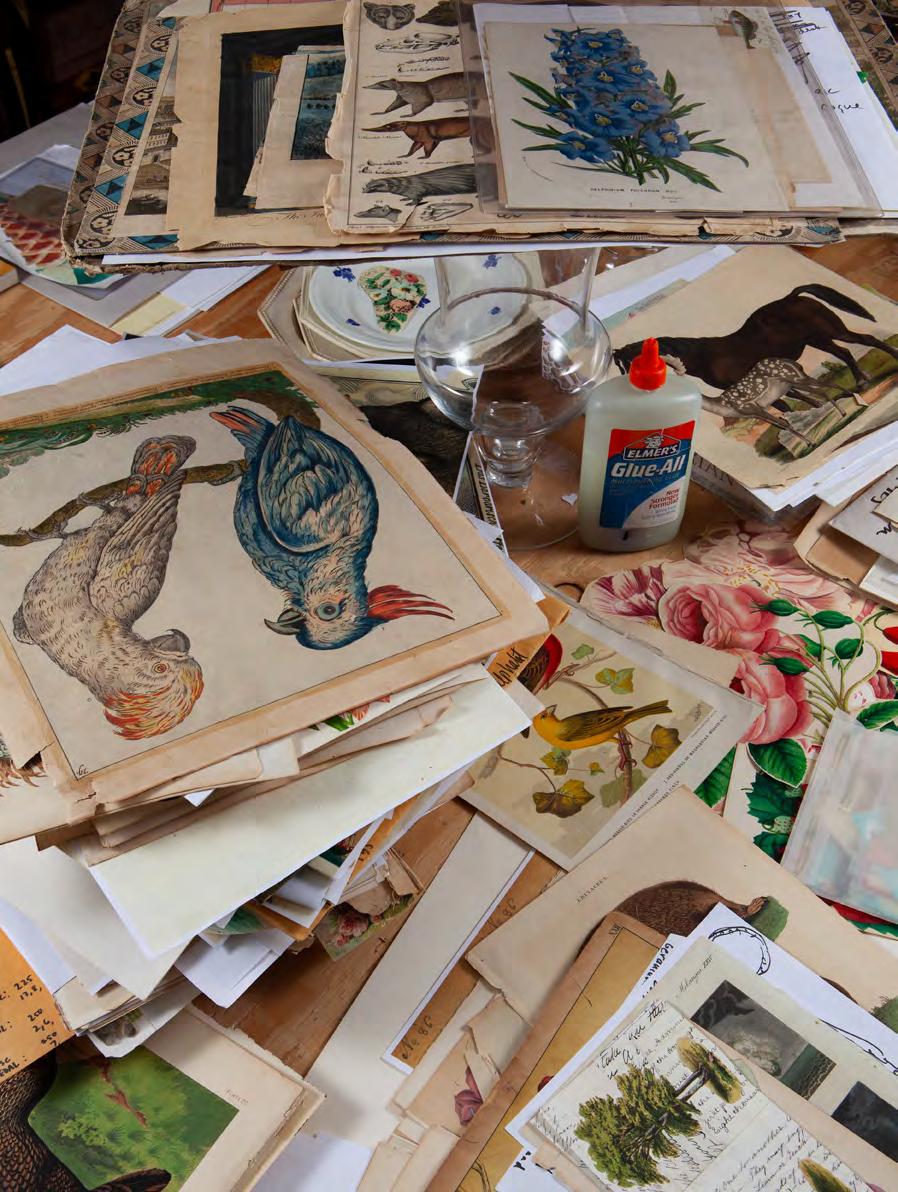
3
Ed quid quo totatiste voluptio blabor anti dolut rerum de andellis.
With respect to the way you look at the world, how much can you trace back to the beginning of your life?
JD: I guess all of—it’s funny—I’ve had a few occasions where people wanted to meet me to talk about their businesses, as if I had advice. I just say, what did you do when you were a kid? Because I feel like I trace everything back to my childhood. I made forts. I created environments, under porches and in trees, and in attics. I was always exploring and always dirty. I remember a tenant in our house threw a bunch of pillows in the trash, and I took the pillows, I put them in the bushes, and made a room. And I’m still making rooms. I was always just moving things around to create a space in the dirt. And I would play in the attic. I had a nephew and niece. My nephew’s four and a half years younger than I am, and my niece is about seven, and so I would babysit them. In the attic, we had these time machines that I made, and I would push them in a closet and change the whole room around. Then they’d come out of the closet and I’d pretend that they’d traveled somewhere. Even now they’ll tell you that they still believe it.
AM: Tel l me about the attic.
JD: Well, my grandmother bought the house. It was in Watertown, Mass. She was a really strong independent woman. Had not the best success with marriage, her husband-my grandfather-- ended up dying in prison—I don’t really know why. I think it was sexual abuse. My mother’s father was in jail for other things.
AM: Wha t other things?
JD: I think alcoholism. But my grandmother was the one in charge. They had a little grocery store. The attic was where I’d play my imaginary games. I’d draw a picture. Move furniture around. And play act.
AM: Was your family concerned with the look of things?
JD: No. It was all very basic. When my grandmother died, I was 10, and then my dad took over the whole thing and he basically ripped out all the molding, lowered the ceilings, and
paneled the walls. It was the ‘70s. I was horrified, because my grandmother’s eyeglasses were just on the walkway, like, fallen. And it seemed awful. I mean, later when I tried to sort of reconnect with him, I found myself helping him do those things to the house, like, building walls or putting up sheetrock.
AM: I’d imagine that for you in particular, that would have been painful.
JD: I just thought that I had to make an effort, because we had such a terrible relationship. I was a creative person in a noncreative family. He was, what do I do with this kid? Which filled me with fear.
AM: So not much encouragement for your creative pursuits.
JD: But then in 7th grade, I had an art teacher, and when I told him I did paint by numbers he just got...
AM: Exc ited.
JD: ...hostile.
AM: Oh.
JD: And yelled. And then threw brushes and watercolors and paper at me. “Don’t ever paint by number again.” And so I started drawing-waterfalls, and painting flowers.
AM: Did you have talent?
JD: I didn’t really – not at painting. But I was making things too. And collecting things. I was making mobiles. And drawing people. Drawing things, cutting them out, stenciling them on to glass and mirrors.
AM: All right, well, so that’s the beginning.
JD: You know it is funny when I think about it now. Basically I would do a drawing of a tree, but then I would cut out the whole thing. And put it on top of the mirror. And then stipple the paint in it and peel it off, and it would leave the design. When I had it framed in the Watertown mall, people said, “You should sell this.” I was so embarrassed. I didn’t think it was any good, I just was framing it because I was giving it as a gift. I was pushing away any thought that there was something here. Whe n you were making these early decoupage-like constructions – were you modeling something you saw or making it up as you went
4 JOHN DERIAN
along?
JD: I’m not sure. But I remember working with old objects. My sister turned me on to yard sales and trash picking. And when I was 20 I met this guy Chris at Mass Art, we went to Marblehead Mass and looked at antiques. And there was a flea market in Salem where I went to buy and ask questions. You get an idea of what things are, and what period. And there was a guy who was selling out his father’s antique shop, so every week he’d have boxes of old books –books that were all broken up. And then at some point later I was laying them out on my bed and drawing on them.
AM: Ad Drawing on the books.
JD: On book pages. I’d peel off one of the pages and draw on them.
AM: Was that because you liked the way the drawing looked on the book?
JD: I just didn’t like working on white paper. It was intimidating. It helped to have something on it.
AM: How did you end up in college?
JD: I really didn’t have any idea what I was doing. I was a mystery to my family. I didn’t have any drive. I didn’t know what to do.
AM: You really make it seem like you were an idiot. Which I know is not true.
JD: No I wasn’t an idiot. But things just sort of happened. I went to this place called Salem State College. I barely went to class. But I did hang out with kids doing, you know, black beauties and stuff. That was fun. And after a semester I used the art I made at Salem State to transfer to Mass. Where I met that guy Chris who took me antiquing. He became my boyfriend.
AM: Was there a point in here where you thought, okay I’m going to be an artist?
JD: I didn’t really know. What I was really feeling was, am I already failing? It seemed like I was never gonna start and finish anything ‘cause I was so bad at—I just never understood school. Basically for whatever reason, all my teachers were alcoholics. In Watertown, no one had any ambition.
AM: You may not have had ambition, though that’s kind of hard to believe, but you had a
pretty specific taste, even then. Where do you think you got that?
JD: None of us had it growing up. But one thing I did with my brothers was to explore a lot of abandoned buildings, because we were near the BF Goodrich, in Watertown, it was close to us so we would climb in at night and explore. And I remember loving it—and making forts in those places too.
AM: And movies? Books? School?
JD: Movies, I watched a lot as a teenager. I would hide from my family on weekends. In a dark place, I definitely escaped. I would find old report cards: “Doesn’t pay attention. Stares out the window.” I remember being in class, my hair being pulled and pinched and ears being yanked. I had a lot of screaming nightmares as a kid, one recurring dream about witches -- and hedges, for some reason.
AM: Was there a moment you remember when you began to view the constructions you made as a serious grown-up pursuit?
JD: I’m not sure. When I met Chris, I learned about antiques. And that box of books that had the pages that I would rip out and paint on --that’s kind of what led me to start to find old printed ephemera. Chris’s mother had a flower shop so that was another world I was able to explore. I’m trying to remember the order. We had all kind of materials in the house, which I would use to make things. He introduced me to a glue gun. I made some wreaths, they were covered in green moss. And I put Elmer’s glue on them and dipped them in potpourri. And one of the brokers asked to buy a wreath. That was my first sale. It’s how I began my business career, selling and making things like that. I was around 21 at the time. AM: You clearly had a knack.
JD: It’s kind of a mystery. I did have a psychic tell me that things speak to me, and I do have a connection to them. But that’s kind of weird to say. You know when you see something —it triggers something in you. I think going to that flea market every Sunday with Chris in Salem, I would just come back with more and more things . After we broke up, I eventually got my
5
own apartment. I moved into a nicely painted room with piles of things that I just collected, and it suddenly seemed that there was my aesthetic, right there.
AM: The re’s not a single room I’ve ever seen of yours that isn’t actually thought through, every inch of the room. I don’t know how deliberate it is, but the effect is strong. So, was this the first room you ever made like that?
JD: Yes. I always say that was my favorite time of my life. I had three jobs. I worked in the Brattle Theater. I worked as a waiter. And I worked one day a week in a shop in Boston, on Sundays, that on Saturdays I would sell to, and then I just started working there one day a week.
AM: Wha t kind of shop was that?
JD: A little home store. Gift shop kind of thing. I started making all these one-of-akind items. And painting furniture, kind of like Bloomsbury.
AM: And the decoupage?

JD: Well back at the flower shop, the owner asked me to make things, and I just made things out of my brain. I’ve always been especially drawn to things about nature – to branches, or things that were sculptural that weren’t necessarily sculptures. I started making trees. I had an obsession with buttons, so I started making trees out of buttons – button topiaries. And that’s what I would sell at that shop where I worked. I would cover boxes with old prints. Because I had now amassed ephemera. And I learned about painted finishes, so I was gluing paper images onto boxes.
AM: The box of books was the beginning of that.
JD: That was the beginning. And because of that, I started noticing more of those colorful images and when I could find them and buy them I would. I painted on anything I could –tables, chairs, whatever. I had an old chenille bedspread that I found at this place called Dollar A Pound by Cambridge, and then I would cut it up and glue it onto lampshades, and I
sold the lampshades. I made little collagey things, like greeting cards and I would paint things and add ribbons. And so I basically just kept making stuff: I did it all in my basement. The shop had other decorative things. There was a woman who painted furniture too. And so she came in one day with some clear glass plates and said, “Oh, you should try making some plates out of these, I don’t have the time but you kind of work on the back of them.” I took them to my studio and...
AM: So, decoupage.
JD: Yeah. She just said you glue things under it. And that’s all she said. So I went and I experimented with the glue consistencies. I only made two plates. Sold them. And then I went to New York, in 1990 I think, for the summer. And I thought, maybe I’ll make those plates. I got a job at a start-up magazine doing paste-up. I was in charge of the Xerox machine. And then I realized one day that I could glue on the Xerox paper and it looked great, and it didn’t crumble, and it didn’t stain the old things. And then it was, “Oh, eureka, I can actually reproduce something.” Because until that moment everything I’d made had been one-of-a-kind. So now I had a plate that I could make two of. And then someone said there’s a guy, at Bergdorf that makes plates, I went to Bergdorf to see what he was doing...

But had you never heard of decoupage before?
JD: No. Nor had I ever seen a plate made that way. I just kind of guessed.
AM: But you did find out there was this other guy in...
JD: Bergdorf – they were selling a similar plate, so I went to look at them. ‘Cause I was curious. And his things were cool, he would fill the plates with sand. He created pockets and things. That kind of helped guide me to how the backs should be more finished, ‘cause mine were just like painted.
So I added a felt and made
6 JOHN DERIAN
FORAGING, FOR FUN AND PROFIT
JD: When I go to the flea markets in France, I draw all the things that I buy. Like in a second. So I’ll know that from this dealer I bought four mirrors, and these are the prices that I paid. This is the Spanish dealer and I bought these tables, This is a German guy that I bought all these baskets.
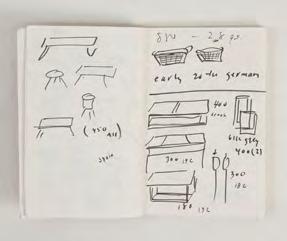
JD: I go through a space and watch what things I react to. I look for big things first. And then small. But I’m also buying to fill needs. Like I know that people like side tables. I’ll go through and think that’s cool, somebody would like that. It’s amazing what you can do in half an hour.
When you see something do you immediately figure out what you can sell it for?
JD: I try to buy things that I know I can double the price. If I can’t double it I won’t do it. I just got this set of plates when I was in France --. ceramic plates that have fruits attached to them, from the ‘60s. I bought a bunch. It was one of those things I wasn’t sure about how much to price it for, and if I did my regular markup it seemed like everything was way too expensive. And then I had the plates in the store for a day, at a lower price, and we sold four. I put the price back up to what I normally charge and we sold almost all of it. How much do you trust your instincts at this point?
JD: A lot. I might sell six of something, but I’ve never not sold anything.
it so you could put on a table and not scratch your table. And I I basically made a collection of seven. I tried Barney’s, that didn’t work. then the woman who owned the Boston gift store said she had friends that had a shop uptown. They said, we’re gonna take this $20 plate and we’re gonna sell it for $40, and people are gonna sell it in their stores for $80. And I was like, okay. And then three days later I got $30,000 worth of business.
AM: [la ugh]
JD: When I went back to Cambridge that’s all I did. Just had friends helping me cut and glue. I moved to New York in ’92. I did everything out of my apartment, my apartment got too small or my business got too big. And my friend Chris, the same Chris, said, Oh, there’s a place for rent on Second Street.” I saw the space and thought “there’s a storefront, maybe I can do a little store in the front, where I could sell the decoupage, and then in the back could be the studio.”
AM: All you sold was the decoupage.
JD: Well it was some decoupage and some antiques. I got more antiquey, and then— and then I went to Paris and discovered people that do a white pottery. And a bedding
line. Then there was a New York Times thing on me. Which was helpful. And then a few years later Anna Wintour came in my store, and kind of changed things too, because suddenly I had things that she wanted and liked; she did a whole “best shop in New York,” thing -- six pages of models in my store in Vogue and that was huge. And at that point I started selling the decoupage to other stores
AM: Okay, how do you make decoupage?
JD: I’m basically inspired by the imagery that I find. Here’s six fruits with the same background and you can hang them in a group, you know. Mostly for decorators. I started doing single images. I started printing things that were stained and broken and ripped. I would have something on my wall and be like, oh I wonder if anyone would like that? And then that became the most popular thing. Which would surprise me --
AM: Because it was too distressed?
JD: Yeah. So then I realized...
AM: So then you realized there were other people had the same taste you did.
JD: Yes.
7
BARBARA KRUGER
Enough About Me/ What About Me?
AMONG THE WORK I was most proud to have published in my career were two covers for New York Magazine by Barbara Kruger. One was a picture of New York Governor Eliot Spitzer, with the word “brain” pointed to his crotch, which ran the week of his resignation over a prostitution scandal. (figure 1) The other was a picture of Donald Trump with the word “Loser” plastered across it. (figure 2) That one ran a few days before he won the 2016 election.
It’s not exactly surprising that Kruger is so good at cover-making. A magazine cover employs the same image and text rhetorical economy that Kruger has made her life’s work as an artist. In fact, Kruger built that work on her experience as a magazine graphic designer and paste-up artist in the late 1960s. She entered magazine work as a trade because she felt art was not available to someone of her social class (and gender mostly as well), and then was able to adapt the skills she learned in that trade to a mode of artistic expression that would come to have enormous influence. Her sense of the pivotal role of class did not ultimately restrain her. Instead it has informed every bit of her art, which is concerned with all the ways we are shaped by the expectations the culture creates for us.
In time, she built a clear and powerful brand – a word she might hate for its crassness or might embrace for its ubiquity as marketing lingo, I’m not sure which – but which in any event she calls “a signature style.” The little timeline (figure 3: timeline) below boils down how she got there – essentially, from pasteup (a now mostly dead, pre-digital practice of pasting words and images together to be photographed); to writing poetry (the practice of distilling words); combining photography and text in books, but keeping them separate; making artworks where the language is pithier; beginning to play with laying text on the photographs themselves; turning the text into an accusatory and self-implicating form of direct address (You/I); reducing the variables of typeface and color, creating what graphic designers call an “identity”; and eventually
2 BARBARA KRUGER
occupation : First Lastname work : How Should a Person Be? born : 1900 16
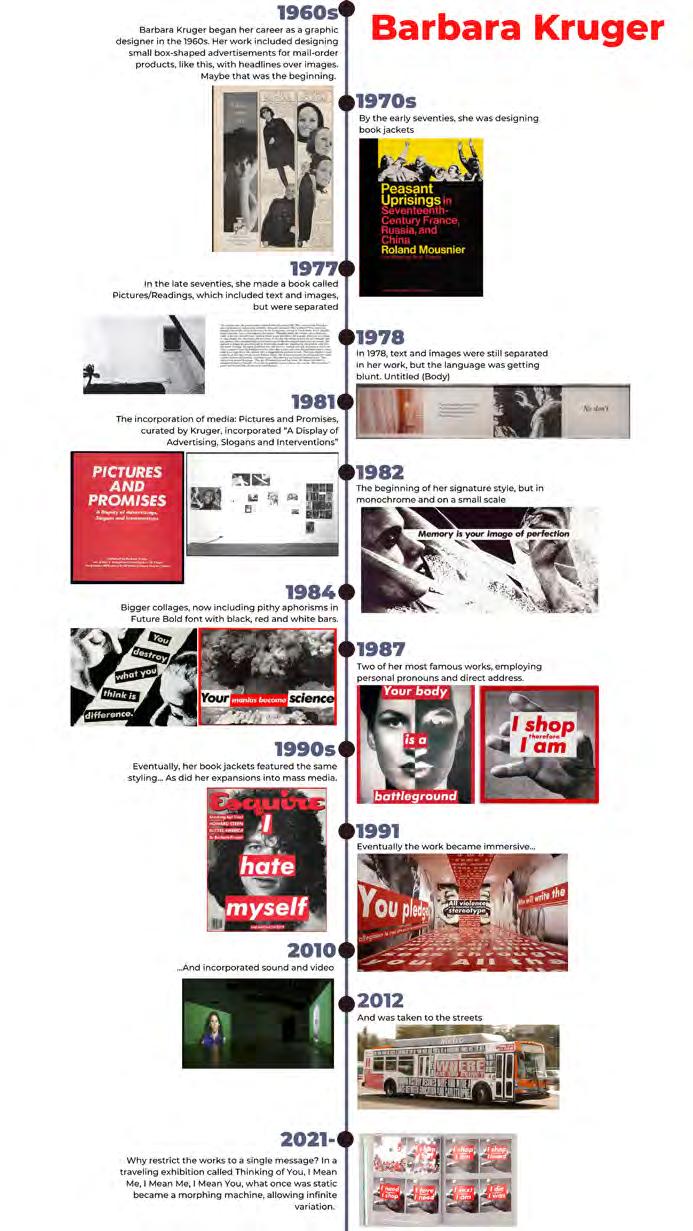
3
applying the picture and text sloganeering to a physical space, often surrounding the viewer. It’s remarkably linear.
Kruger refuses to define any moment in that trajectory with the kind of aha/catharsis language I was looking for. But I suppose that was my problem. She’s frustrating in a lot of ways. I wasn’t allowed to “see” her, only hear her voice; and she refused to discuss the evolution of a single project. Ultimately I concluded that it didn’t matter, since we could trace the evolution of the form, which in a sense was a single work with multiple applications. Also, during the period of our communication, she was finishing a mammoth exhibition called Thinking of You, I Mean Me, I Mean You (“what’s the title of your book?” she asked me. “Your title is really important.”), which was sort of an anti-retrospective in that it included remakings of some of her iconic pieces. To the extent that my project was about revision, publishing a few of those works side by side might be helpful. (figure 4: side by side) But mostly I just liked her. She’s combative and funny and fiercely engaged in the public sphere. I was in awe of her dexterity with words and images, which after all was a trait I was likely to admire. The perfect simplicity of that Spitzer cover made it maybe my favorite cover ever, anywhere. But the cover I wanted to talk about was Trump, which haunts me to this day. We eventually got to that.
AM: Where are you?
BK: The Springs. I’ve had a little perch here, with rubber hoses for plumbing for the past thirty years.
AM: Thanks for talking to me. I want to be very respectful of the limits you’ve put on this conversation, so push back if we veer into uncomfortable territory.
BK: Well, especially because this is being recorded. So I’m going to be especially retentive.

Were you interested in art as a child?
BK: When I was growing up, I had absolutely no sense of what art was. And where I was, in Newark, you had a choice of taking a college course or a commercial course. And I took a commercial course, because that was laid out for me in terms of my class. When I thought of art, I thought maybe I could be an illustrator because I was one of those kids who knew how to draw, as if that was a determinant of
4 BARBARA KRUGER
who was going to be an artist or not.
AM: Did you get encouragement for your drawing skills?
BK: Oh no, no. I just knew I had ability in that area. But my first attraction was to architecture. Because my parents never owned property. In fact the little Springs place I’m in now is the first property anyone in my family ever owned. On weekends, we would look at model homes that we could never afford, in communities that would never have us. So I just spent a lot my teens drawing houses and plans for residential developments.
AM: It was just kind of a private thing?
BK: Oh yes. I didn’t share it with anybody. I was just very engaged in the idea, though I
didn’t see it as such at that time, of the ways that the built environment constructs and contains us.
AM: Did you ever go to a museum?
BK: Once my parents took me to the Museum of Modern Art. But what I most remember was the design collection.
AM: What about it?
BK: Well, the furniture – things that adhere to or are utilized by our bodies. And in realizing how much of that is class-defined, and gender-defined and race-defined in so many ways.
AM: Was your family political?
BK: Not really. But I did find a bunch of index cards for a speech I gave as valedictorian or salutarian of my high school class. And I was shocked at how concerned it was with issues of class and race.
AM: Were you a particularly verbal child?
BK: Like many families, mine was more than problematic. But I think my developing language skills helped me through difficulties. And despite the problems, my parents never discredited my possibilities, which I know did happen to many of my peers who came from a much higher class level and were undermined in ways I wasn’t.
Kruger went to Syracuse, left after a year (“I felt like a Martian there,” she says, “It was mostly a class thing.”), then went to Parsons and studied with Marvin Israel, a legendary magazine art director, most notably of Harper’s Bazaar, and the photographer Diane Arbus [fn]. And then she left there too, still not feeling that art was available to her. She had to learn a trade. Israel steered her into graphic design and magazine layout. She ended up at a magazine called Mademoiselle, where she did pasteup. She got the job by shopping a
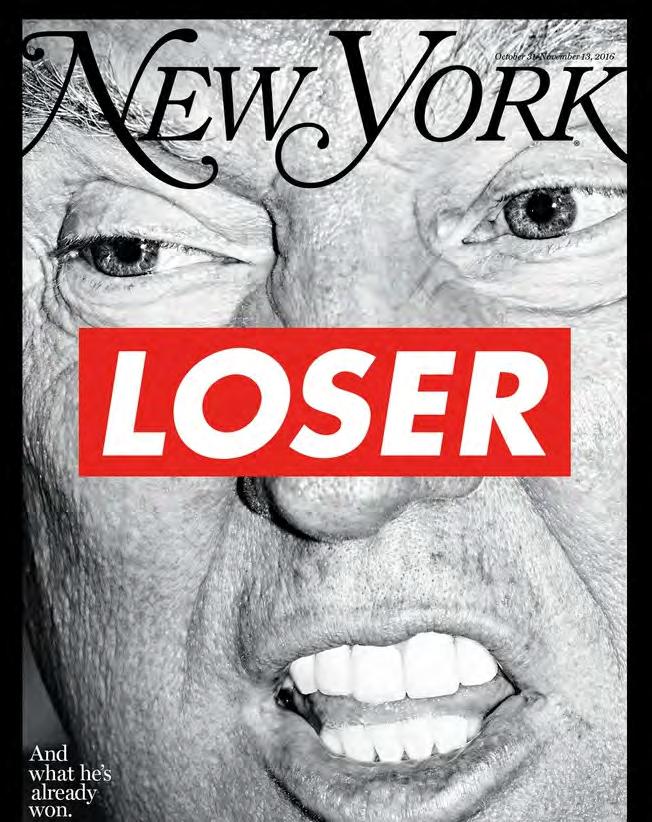
5
portfolio of imagined book covers. (figure 5)
BK: I didn’t think about being a regular artist. There were absolutely almost no models for women, and I just hadn’t been educated in art history or whatever. But during this time, the fluency I developed with pictures, through editorial media, it did really give me a way of thinking about pictures and words that became the foundation of my work.
AM: Were magazines fun for you?
BK: Sure. I did do some illustrations of socks and shoes. It was cool. But I realized I didn’t know what my future was. I just couldn’t solve other people’s problems in the way designers do. The hard part was to figure out what it means to call yourself an artist.
AM: So you were beginning to do your own art?
BK: I did a lot of craft work. I did stitching. But somehow to me it was like work for women. It was labor intensive and putting my brain to sleep. But meanwhile I started writing more, and thinking about how to put life and value and power and gender into my work. And that’s where the fluency I developed in magazines came to be part of the recipe.
AM: What were you writing?
BK: Prose and poems. I did some readings, but that didn’t last too long. But you could feel some of the prose I did in the pictures and text work. I did some one-offs of what people leave in cars, like the back windows of cars and what were in them. And then I didn’t have any money, so I was taking these visiting artists jobs, which were really visiting girl jobs, tangential jobs, and in all my travels I was taking photographs of architecture, and it wasn’t enough to just have these photos. I wanted to write the stories of those rooms. Eventually I did Pictures/Readings [an artbook]. I projected narratives of people who were inside buildings I found compelling.
AM: Were there intimations in your mind that this was a possible means of expression artistically?
BK: Well, it was more organic than that. It was when I started putting them all together in one plane, and using direct address and
pronouns... that clearly was a kind of invitation, a kind of activation.
AM: Was anyone else doing that kind of work?
BK : No, it wan’t really a thing. I remember talking to Marvin Israel and saying to him early on, why can’t I be an artist with just photos and magic markers. Oh no, you can’t do that. There was a history of so called conceptual art, text art, but I would go to galleries early on and man, I felt like a right-wing Senator. I thought, what the fuck. My dog could do that. It was a conspiracy against my own intelligence. And this is where historical circumstance and social relations are so determinant in what we are. We were raised watching TV and movies. So there was this commonality of a vocabulary, which wasn’t based on art historical paintings but was about popular culture and representation. I never considered myself a “Pictures Generation” artist [the term applied to a school of artists, such as Richard Prince and Cindy Sherman, who were developing what Kruger called “a vernacular sort of signage” [fn]], but engagement with popular culture did allow myself and others to become visible.
AM: Did you see an opportunity here? Was it something you intuited? Or talked about with your peer group?
BK: Well, both really. Being an artist, most never make any money, we all feel disenfranchised and disempowered and people forget the power of their own byline. And yet they had the ability to start a conversation. That becomes a buzz, of fickleness and hotness. And you know how things happen. So, voila.
AM: And was there a moment when you felt, this is actually working for you?
BK: It was when I started showing my largescale photo works. Which got shown. But for us, for my group, the showing was what was important. Showing did not mean selling. It wasn’t about one work. Things are about a seriality. I remember when my name started entering the conversation, and my works began to sell, I made like $150 on each of those, because they sold like for $1200 and
6 BARBARA KRUGER
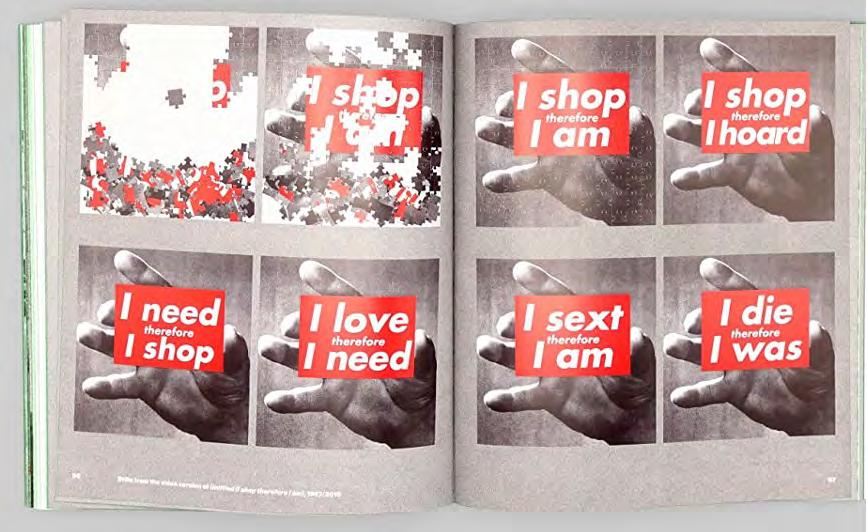
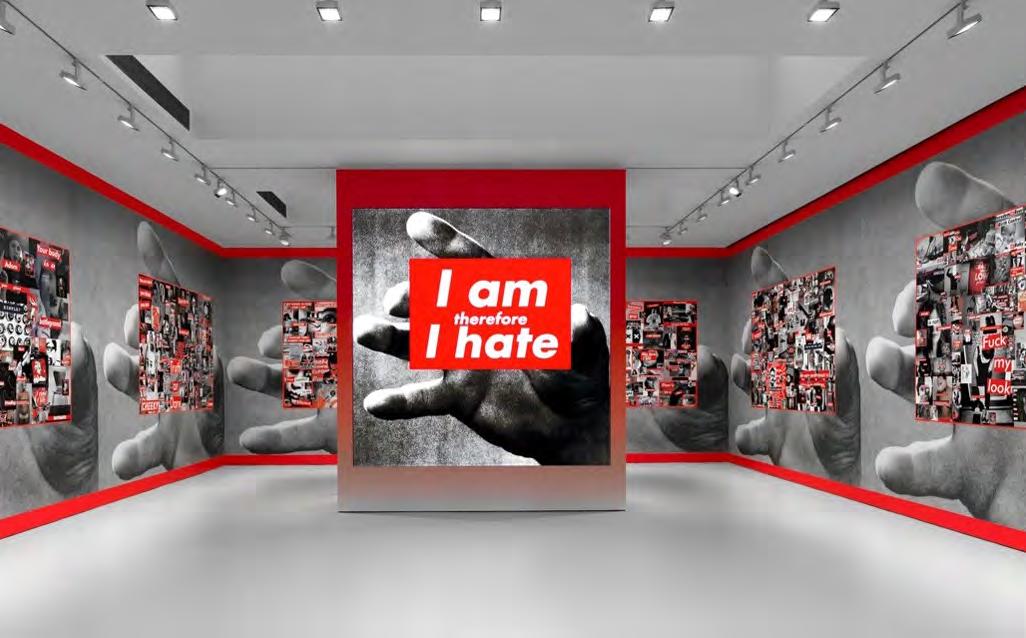
7
then the frames and the prints were expensive, they were big. I remember carrying them on the E train. And then I realized I wanted to address the money, the newfound commodity status of the work.
AM: So you starting to see yourself as a commodity.
BK: Yeah. The work that said “Buy Me, I’ll Change Your Life.” or “You Are Getting What You Paid For.” I discovered Walter Benjamin and Roland Barthes and started writing for small magazines and then for Artforum. I’d always dip into the Barthes because I loved the way he could approach big ideas in the most casual secular way.
We digress into a long detour about media in the late seventies and my early days working at Village Voice. I press her to return to her story.
BK: Ugh, I am so sick of the sound of my own voice, especially with the show coming out. You feel like a fraud. You know, what the fuck? You know, it’s like enough. Enough about me/ what about me? (She laughs)
AM: Do you remember the first time you used direct address? Was it “You Are Not Yourself?”
BK: No, it was “Your Comfort Is My Silence.” I think that was the first of the works where pictures and words were in one plane.
AM: So you sort of figured something out, and then created a whole bunch of works using this tool?
BK: Yeah. And then they got larger and larger. The breakthrough for me were ones of scale. And then at the beginning of 1991, of my spatializing my work, bringing my engagement with architecture into it – I hate this word because it’s become such a catchword but they became more ‘immersive,’ there were walls and floors. I love working with space, yand I trust my visual instincts to a degree, and I sort of know the materials I’m working with, I’ve developed a fluency in that, you know...?
We start talking her friend, the critic Craig Owen, and she mentions that what made him unusual was his self-doubt. I mention
remembering reading that she found doubt admirable.
BK: Well, doubtlessness can be very scary. Numerous belief structures have destroyed the world incrementally, in many ways We’re living that right now.
AM: How do you think that plays into your work?
BK: In so many ways. No work, no painting, no novel, no movie is as brilliant and masterful or as failed and minor as it’s thought to be. Things get pumped up, and that has to do with our value systems. And in terms of the art world, and the speculative nature of markets... I tell my students, if you become a hot, hot item, don’t take it personally because everything is so fickle. Somebody else will come along who will be younger and cuter and cheaper. And if you make it early, it’s just so many years of performance anxiety.
AM: And the red and the black, and your typefaces, first Futura and then Helvetica condensed, were you creating a voice by limiting your tools? Is that fair to say?
BK: I would say that I was developing a visual vocabulary.
AM: The amazing thing about your vocabulary for me is how flexible your mind is in getting maximal power out of language. I mean, this is my profession -- headline writing for instance is something few people know how to do. I’m interested in how you fixed on your tone. Your stuff is incredibly direct accessible and usually funny. You’ve used the word goof.
BK: I really appreciate your bringing the goof up. The grasp of the goof is so important. I mean to me, Mel Brooks was the be all and end all, you know. I used to think Jerry Lewis was cute. People don’t get how important the goof is in my work. I’m not talking about humor. Humor is far too genteel for me. I’m talking about comedy. It’s such a powerful force that can be both liberating and horrendously shaming. Absolutely.
BK: Appropriated by the left and right. And digitally-- oh my god, where shame is such a
8 BARBARA KRUGER
hot commodity.
AM: I know that you keep an archive of images. Do you also do that with phrasings?
BK: Sure. Figures of speech that have been changed through culture, slang, which becomes very dated, I try to be careful about that. It’s always a consideration because I’ve done so many variations on my work. The images change with the text and the words change with the images. I look back at works of mine that I think just suck. Don’t ask me which ones.
AM: Do you record images and words as you’re walking around?
BK: Most of the images just come from googling, and earlier tumblr, flicker. As far as some of the text is, I have always been a cafe or diner writer. I would take a little notebook. I go to the Square Diner out in LA. I used to go to Cafe Dante on Macdougal street. So much of my writing has happened in public places.
AM: Why do you think public writing is so pleasureable for you?
BK: There’s something about the built environment, that culture that is constructing what you hear – the ambience, the conversations, the apparel, just everything.
AM: Do you ever feel blocked?
BK: I guess. But I’m not a painter that goes into a studio at 10:00 in the morning and works until 4. I’m not a writer who has to confront that page at the computer. I’ve done that. The way I work is very rangy. I can get these ideas when I’m sitting at a coffee shop or driving or in the bathtub and I bring it to a place that sort of makes it work. And I think that’s an advantage. I’m working all the time.
AM: Do you feel at this point constrained by other people’s expectations?
BK: No, because there’s never been a consensus about my work. I’m not everybody’s cup of tea. Some people are needy
– everyone has to love you. But everyone’s just up for a fall, you know? You’re not right. You’re not good enough. You’re in the wrong place at the wrong time. You just can’t be everyone’s idea of perfection.
AM: Are you a voracious consumer of media?
BK: I’d say yes.
AM: Of memes? Which in some ways you anticipated? In the juxtaposition of pictures and text for an effect?
BK: They’re interesting I guess. Some of the things are so predictable. They’re clever and some of them are funny. They embrace a kind of economy that is perfect for that space. I understand it so well that I don’t really have to look at it. They’re kind of verbal mirrors. They mirror the self – that crash of narcissism and voyeurism. I don’t think I could say anything that hasn’t been said before about internet culture and how enveloping it is and enabling and amazing and punishing and damaging.
AM: Do you watch TV?
BK: Oh yes. Ozark. Bojack Horseman, please. I watch reality TV. Real Housewives of every locale, Vanderpump, Love and Basketball, any hip hop. Reality shows are the most prevalent and brutal evidence of the sustaining, unrelenting power of stereotype and how people are so willing to act that stereotype out. I wanted to talk to you about the Trump cover and Trump.
Henim andio. Ehenis auditae reptissum et aut autempe ritati debis dolliquas atumqui antionsequia nis elessum volorep erfere voluptat. Mentotatem et ex estiundaecta esti ullabo. Orum hit voluptae alit dolupid endi dictur, non consed eiunt haritat invelecto vellest, consequidel et laborum coreptat mi, sequunturio. Aximaximus, to evelendenda nosandae voluptas voluptate ernate acipiet quias rehende nimolor erferro dis el maio. Nempor assitatibus eic to eosam rate aut dis consectiat maximporent, ne sinum a nonsequis et exces es el issimpore nem voluptatae nonem fuga. Ut vitius niasimpor magnis maximost, abo. Ut eossed qui dolorro conse sum fuga.
BK: Well when Jody Quon [photo director of New York] approached me, I thought right away, what is the word he fears most? And that’s Loser. There’s nothing that comes close in Donald’s universe.
AM: You felt you understood him?
BK: Look, I watched The Apprentice for years. I called him President Shecky. He was like Shecky Greene to me. People don’t know what a tummler was... he has a gift for that. People just don’t understand his rhetorical powers.
AM: So you didn’t mean it as a predictor?
BK: Oh no, I certainly didn’t think, this guy is gonna lose the election.
AM: You really didn’t? Because I’ve spent a lot of time answering questions about that cover.
9
17 MAX PORTER Itchy Little Breakthroughs
born : 1981
I CAME TO MAX PORTER BACKWARDS. I wasn’t familiar with his work but read an article about his book, The Death of Francis Bacon. It mentioned that he works out his novels (which is what he calls them, but they’re not conventional in any way) by drawing and keeping notebooks of his drawings, and since this book is in part about notebooks of various kinds, I thought I’d check it out. What I found was a compelling case for visual expression as a form of editing, helping clarify the noise of thought. Max, who used to be an editor, writes books that aren’t really one genre or another. They’re hybrid, fragmentary, collage-like – little bit prose, little bit poetry, a lot of imagination – definitely not my usual taste. But they’re also very effective emotionally-- primal, melancholy, darkly funny-which is my taste. His first book, Grief Is a Thing with Feathers , features a bossy lifesize crow who visits a father and sons grieving for the loss of their wife and mother. (Max has said the work is really about his father’s early death, which in a sense is the subject of all of his work.) It was something of a sensation – winner of the Young Writer of the Year Award, the International Dylan Thomas Prize, shortlisted for the Goldsmith Prize for experimental writing, translated into twenty-seven languages, adapted into a very successful play with Cillian Murphy. His second book Lanny is about a “five-year-old dreamer whose infectious sweetness is matched only by his verbal precocity and otherworldly connection to nature,” – that’s from a New York Times review whose headline described the books as “Rich, Twisted, Gloriously Cacophonous.” It was listed for the Man Booker Prize.
I sought Max out for lots of reasons – I liked the books a lot, creative ambition was what he was all about, and I really wanted to see the notebooks, which he keeps compulsively. “My notebook is the microbial fungus of ideas and images I draw on when I’m writing,” he said. Notebook-making runs in his family. “I have one of my grandfather’s sketchbooks I keep as a holy relic.” And so

2 MAX PORTER
occupation : author
work : Tobias Llewelyn Raggs 1891 (Unconscious Thought)
Max is drawing-- drawing constantly; drawing as he’s thinking and talking-- his thoughts, both deep and banal, passing through his arm to the page as images and word-bursts. “Not a day will go by when I haven’t drawn, even if it’s a shopping list, where I’ve turned the word tomato into a drawing of a tomato.” he told me. “I also vandalize books. The books I’ve loved most in the world are full of drawings.” It’s as if he needs his arm to make sense of his brain, which can be a thicket.
Max tried to write conventionally but it bored him and “it was bad.” he told me. “My writing grew out of a discomfort I had between art and music and writing. When I made music I felt I should be writing and when I wrote I felt I should be painting, feeling I wasn’t good enough at any of them – I’m limited by my lack of skill. And one of the reasons I fell into writing Grief is the Thing with Feathers was because in the fragmentary form, half poem, half essay, I started to feel good enough . It was more like a collage. I have to have the imagistic material in order to be interested in the project.”
Then too he is dogmatically invested in trying to discover ways to tell stories that elide the straight-away. “The idea that readers are thick and you know they need help,” he said. “I think it’s bullshit. The last thing you want you open a book is someone explaining. But at the same time, “I don’t
want experimentalism for experimentalism’s sake. Because that excludes the reader. Being on soggy ground is only worthwhile if you land on firm ground.” Like many modernists but more so, he is particularly interested in exposing the artifice of storytelling. “How do I tell the reader that it’s true and also imagined? This is my fundamental difficulty as a writer and the reason I keep trying. My hope is that you’re rigorously attentive to editorial and critical discipline while you’re writing but you’re also free and inventive and happy, having accidents. You want to try and create a blend. And I don’t think you can fake that blend, which is one of the reasons notebooks are so useful because you’re in training to achieve that blend all the time.”
He sent me pages from the journal where he’s been working through a project he’s been playing with for the last couple of years, which I asked him to annotate; you can see how he needed the notebooks to help him make it out: it’s a complicated story. But for these purposes what you need to know is that it’s about Tobias, a boy not unlike the Toby of Sweeney Todd (about the avenging murderous barber of Victorian times, which Stephen Sondheim made into a musical), who’s being kept in the basement by a Sweeney Todd character, and is set in Victorian England but also goes back and forth in time.
“It’s a revisionist Victorian novel, one in
A SINGLE DOODLE
“I’ve just sold a novel this week.” he said (exclaimed really, not something I think many people actually do). “I was thinking when I went for a walk up a hill this morning I must tell Adam this, that I sold my new book this week to a publisher here. And it’s the only book I’ve ever written that isn’t from a notebook. It’s come straight out of one single drawer and the only research I did, the only preparatory work was this one single doodle.” He was speaking from Bath, England. We were on Zoom. He drew a picture, held it to the screen. “It’s a boy … in a pond... wearing a backpack, in nighttime. That’s it. The book is about an unhappy boy in the 90s who doesn’t want to live, set over one night. I wrote it fast. And now I’m a believer in those things people talk about – flow states? I’ve spoken so positively about the notebooks I wonder if I’m too reliant on them. You get a lot of ideas, things blow into your consciousness and then some you have to put away. This was the only time I think in my entire life where I’ve literally run from the table downstairs in my flat, to the upstairs to get started, you know?”
3
which the protagonist might have a sense of what is coming, in terms of the military industrial complex, industrialization, exploitation, war. He can see what’s coming. And he doesn’t like it.”
To complicate matters (he is very intent on complicating matters), it’s set in a theatrical black box, in darkness. “I wanted to stage it in a melodramatic setting.” Max told me. “What if I locked this guy in the dark, and have him riff on his own identity, his story, the future. What if he’s an actor? Could he play all the parts? Could he audition people for the parts that he has in mind in order to tell his life story? Could it all be a kind of confession for the tortured Western male ego? And I started building this novel in the pages of this notebook.”
So that’s the set-up. You can’t compare it to the finished work, because there isn’t one, but the notebooks do provide an unusually visceral snapshot of a creative brain in furious motion. “These notebook pages are my working out how to do something as preposterous as have the play script meets joke meets therapy session meets melodrama.” he explained.
So here are some pages of him trying to understand the book he felt tugged to write but didn’t quite know how to do:
1. The idea is that Todd would be a character that would move through the time zones 1791, 1891, 1991. It would be a novelistic device, without any of the smoke and mirrors of a novel pretending it isn’t doing that.
2. Oh that waiter figure? That’s Barton. He’s the impressario, the Sweeney Todd guy, the guy who’s locked him in the basement. And this is Toby saying in a sort of postmodern way, if we’re going to have this character, let’s flesh him out a bit. So these are notes around the character-- physical notes toward a person building a character. And of course that’s me trying to figure out the character too. I’m using this notebook to try to make physical what’s in my head.
3. This is me thinking of how one would physically stage this. This atrium is the literal cellar he is in. The eye above the head is his thoughts. And the eye above him is the omniscient narrator, my eye, which encompasses the whole thing. At this stage I’m wildly disconnected from any practical sense of how would I do this and just trying to be ambitious. I do six or seven of these pages in a burst. And then I think, ah, fuck what am I up to here and put it back on the shelf. Go pick up the kids or something-- At a certain point, this is quite crucial, I bring this notebook up to my bed, so that when I wake up in the night with itchy little breakthroughs, I can go straight into this notebook, and then it bring it down here tomorrow.
4. I was thinking about this interesting relationship he could have with his aunt, and the idea of goodness and care in the Victorian context. I wanted her to be a good person, aunfashionable way. I wanted her to be the best good aunt that Dickens could ever imagine.
5. I’m trying to work out his prose style. Is it one block of thought with stage directions, asides, with everything leveled.? I’m trying to work out how he would speak and then I’m thinking the stage directions are in brackets. And my little revelation when I had it, which admittedly isn’t very exciting on the page, is that in between his dashes and the bracket sits his selfhood. The little dashes are Tobias, and the brackets are the author’s voice.
6. Llewellyn is my father’s middle name and I
4 MAX PORTER
TKTKT HEADER


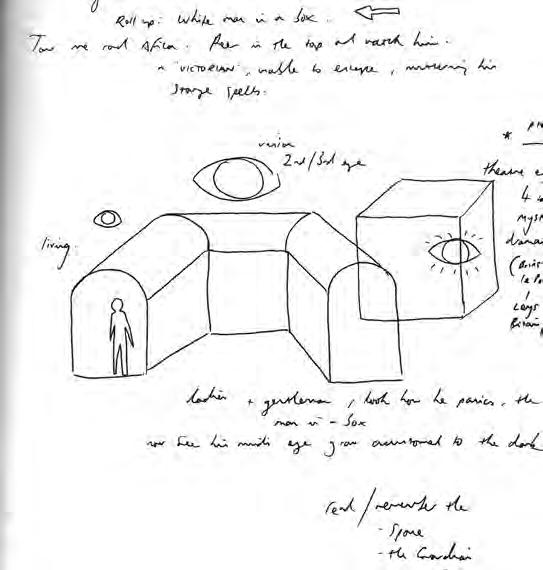
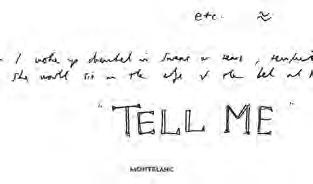
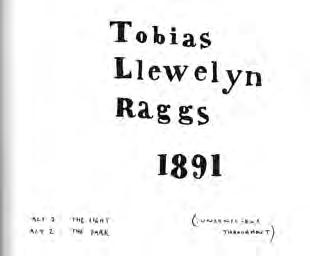

5 1 3 2 5 4 6
At the time of our talk, he still wasn’t sure what he was going to do with Tobias Llewellyn Rags. But m his many notebooks are full of other unrealized projects and lifeephemera. “When you reread your notebooks you re-meet ideas. You reintroduce them to who you are now.” Some random pages:
1. I wrote a novel about a pagan saint called Uncumber. Uncumber is an actual saint of a saint. Begged God to save her from an unhappy marriage and he gave her a beard. And I’ve translated it into the 21st century. The novel is a love triangle between her and her assassin and her hagiographer. And this was
the drawing I did when I realized I wanted to do it, when I was committed to the idea. This was years of thinking condensed into one happy idea. I’m still playing around with it. My wife thought it was too weird. There was some truth to that but also I was beginning to think it would make a fantastic play. So I was speaking to a producer last year who loved the idea- it’s being commissioned as we speak.
2. This is just a doodle. I think what I’ve written there is “this is the eye we drew,” because I was being filmed in Barcelona. There was a documentary being made about writing, and I agreed to

be interviewed for it. And they wanted me to be sitting at a table writing. And the we is, I think I sat there with a fake interviewer.
3. It’s ripped off from Rembrandt. I think it’s based on a Rembrandt etching. Rembrandt’s etchings seem to me almost the pinnacle of human creation in some way-- the meeting of science and art. It’s as good as we’ve ever been.

4. This one makes me sad. It’s a very stylized reproduction I have of my father on a beach. I’ve done it from memory. And just annotating it, thinking about my children. He is showing the photographer

6 MAX PORTER TKTKTKTKTKTKT
1 3 2
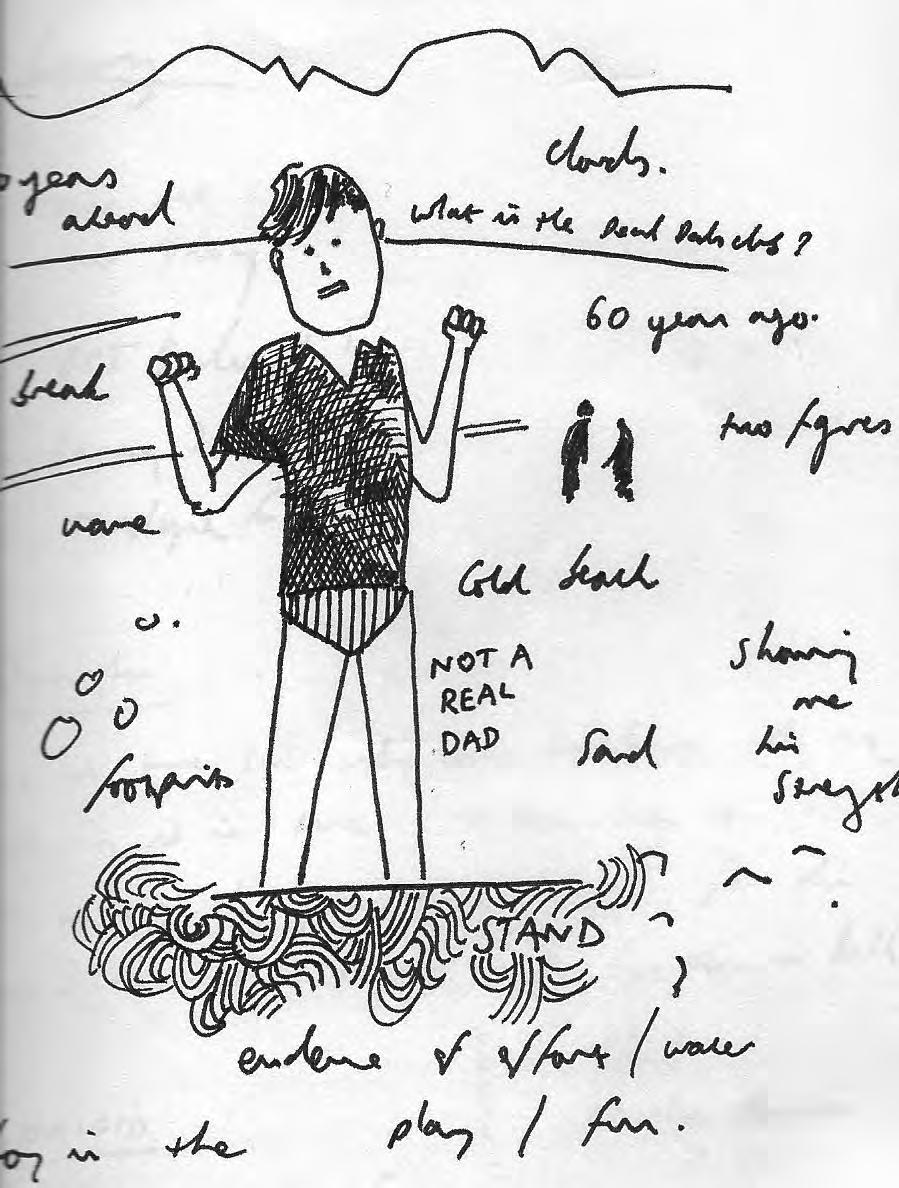
7 4
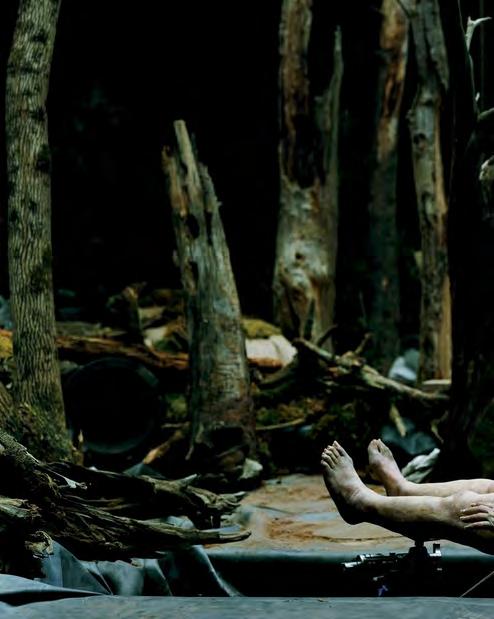
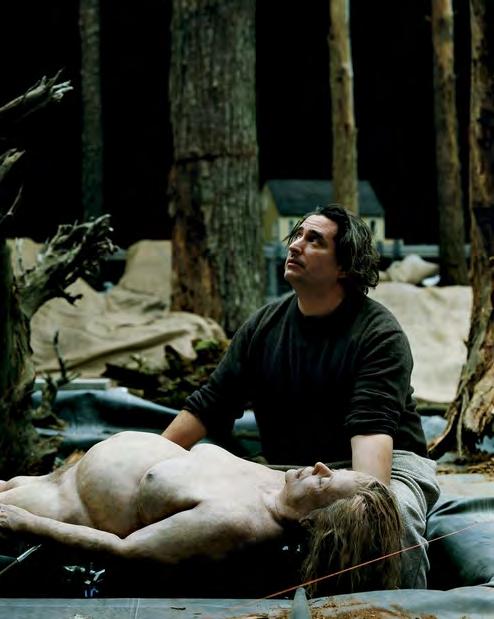
GREGORY CREWDSON
GREGORY CREWDSON IS A photographer who makes large-scale prints that resemble stills from a movie. They capture a moment, poised between a before and after that is entirely up to you to devise, rendered in dramatic cinematic light and evoking a mood which feels dreamlike.. They are gigantic productions (and also gigantic prints), involving an almostmovie-size crew and many months – years –of pre and post production. The pictures live in their own genre, somewhere between film and photography.
I have been drawn to them ever since Kathy Ryan, the photography director of the New York Times Magazine, first showed me the work when I was the editor and we were looking to begin a program of fine-art portfolios in the magazine. She wanted Crewdson to inaugurate the series. He proposed a project that might involve actual movie stars -- an exception for him (but also why he was, for the first time, willing to have a publication show his work; we could help him procure the actors)-- and be set in a Vermont farmhouse. It was expensive, but the resulting series, called “Dream House,” and ultimately featuring Julianne Moore and Philip Seymour Hoffman and Tilda Swinton among others, was one of the more satisfying art projects we published there during my tenure.

Crewdson’s latest project at the time of our conversation, called “An Eclipse of Moths,” was set in a small industrial town, Pittsfield, that is often the location of his shoots. His “star,” in this case, was the man who runs the dump. But in a sense, it could have been a scene from the same movie. You could edit his lifetime of images into a single motion picture and it would work.
“I always knew that I thought like a photographer but that I love movies more.” Crewdson was explaining how he came to invent this mutant artform. “I love movies but this is how I know to do it-- I think in still images. How do you tell a story in a still image? You tell it through form, light atmosphere – they work as a kind of narrative code.
2 GREGORY CREWDSON
18
occupation : photographer
work : Redemption Center born : 1962
“There’s Only One Way It Could Possibly Be”
“And my feeling is you’re always just paying attention to that one central story that you feel like you’re on earth to tell, and that that story is defined when you’re coming of age as an artist. There’s a very small window when you’re open to influence, and it’s usually in your twenties. You think: these are the things I love, these are the things I hate, these are my influences. And then you spend your life working out those dramas.”
In our conversation, he kept returning to this theme, as if he felt a little trapped in his sensibility. He’s certainly right that most artists have a strong signature that is just simply them. Is that a signature you are born with, or is it acquired through influence? That’s a question I kept returning to. Is it really so fixed? Crewdson thought it was.
“I came of age in the mid-80s. On the one hand I was kind of inspired by the whole tradition of landscape photography like William Eggleston and [Joel] Sternfeld. And then I was going down to New York from graduate school and seeing modern photography like Cindy Sherman and Richard Prince and was very excited about their scale and artifice. And seeing Blue Velvet, and Eric Fischl paintings and reading Ray Carver short stories – and I kind of knew. And then you’re stuck with those things.”
The first celluloid photo project (he doesn’t have a name for them) that won him attention was called Natural Wonder, and took him five years in the mid-nineties. He’s made approximately nine of them, mostly each more ambitious than the next; they’ve been shown in the Met, Whitney and Brooklyn museums; his work has been the subject of a film documentary; he is represented by the Gagosian Gallery and runs the graduate photography program at Yale. “An Eclipse of Moths” began its life just after he’d finished and shown one called Cathedral of the Pines.
It was 2016. “I’m typically in one of three stages,” he says, “preproduction, production or post-production. And the actual production of any body of work is unfortunately the
shortest amount of time. When you finish a project, it goes out in the world, you kind of lose ownership in it. And there’s a down element to it, a slight depression. At a certain point, it’s time to get back to work. I’m a long-distance swimmer, and I feel sort of creative when I swim, where I just think openly about larger concepts or parameters. The last pictures were primarily intimate and in nature. So I knew for the next I wanted to do something less intimate, more open – like emptied out cityscapes with smaller figures. I find you try to make contrasting decisions to your last body of work. But of course that only gets you so far because you can’t really get away from yourself. You have one story that you continue to tell over and over. But... you do try.”
The Hunt “Location scouting is just me driving alone, looking for something – I’m not exactly sure I know what it is. This can go on for months because there are no constraints on my time, in terms of budgets. Setting is very important to me. All these pictures were made in Pittsfield, which is like 45 minutes from my home.”
As Crewdson wanders around, he described being lost in a reverie until he reaches a particular location and sees a picture before him. What struck me is he doesn’t record the moment, the angle he is seeing, or try to capture even the location with the camera in his phone.
“Something clicks,” he said. “And I get a kind of vague kind of image of what a picture might be. I register it mostly in my head.”
And to some extent, he’s made the photograph right then and there, in his mind. The rest – and there is a lot of rest – is just execution.
“I’m not that comfortable with cameras generally-- I know there’s a kind of contradiction there. And I’m dyslexic, but there’s something about a still image that I completely get and understand. Once I see it in my head, it’s ingrained. I have a photographic memory, I guess.”
For Redemption Center, in “An Eclipse of
3
Moths,” this is more less the location he was looking at.
“And then I bring in Julianne [a colleague, who is also his life partner]. I bring her to the location and I’ll just literally sit there, describe where the frame begins, where it ends, what might be happening in the picture. And she’ll take notes.” Crewdson does not tell her a story. He simply describes the picture he sees. “I’m just interested in the moment, I almost don’t want to know what’s gonna happen before or after. I work in motifs mostly, all artists do. All artists create a kind of iconography for themselves over a period of time. And that’s kind of unconscious. I’m drawn to certain kinds of houses, cars, weather, light. So that’s what I’m working with. And sometimes I’ll come up with a scenario that has too much story in it, so I bring it back, simplify it, empty it out.”
“Anyway, Julianne writes a kind of script – a textual
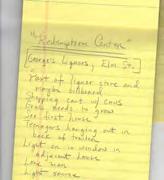
description of the picture .” The pictures that get made usually resemble these descriptions in nearly every way.
A lot that haunts him Many viewers of the eventual picture, Redemption Center would believe the picture was commenting on the opioid crisis because of its small-city despair, or that it was prescient in capturing a kind of Covid feeling (at the time of our conversation Covid was in full-swing) but Crewdson had something else in mind.
“It was more about my feeling of brokenness at the time,” he said, “searching for some kind of connection. And I just found myself thinking about the street lamp as a kind of beacon – and that’s how the title, An Eclipse of Moths , came to be.
“I had made a picture many years ago in this location in Beneath The Roses [another series], there was a supermarket. I loved that supermarket, Harry’s Supermarket; it was torn down. I liked the empty lot where the

4 GREGORY CREWDSON
BEFORE Ed quid quo totatiste voluptio blabor anti dolut rerum de andellis. Lorem sapiciis dolupic ieniae nullesed
supermarket was, and I liked the redemption center that was there. My first thought was that the Redemption Center should play as a kind of metaphor, that announces the key to the work in a way. But the building was white, and I like everything to have a certain amount of muted color, so I knew I’d have to paint it

A Silent Collaboration “But once I’ve settled on a location I bring in my director of photography, who I’ve been working with for
twenty-five years, Rick Sands. We talk generally about the project but then [for each picture] we just sort of stand there at the location and – we don’t talk about really anything, or we talk about anything but the picture. He tells me about his life, I tell him about mine, but meanwhile we’re both just staring at the location. It’s uncomfortable and a little excruciating but he’s trying to see what I see.” Eventually without speaking Sands just knows exactly what to do.
Crewdson’s crew grew to about fifty people. “We’re probably like a month out from production at this point. There are logistics-- a budget, getting okays. And then because we’ve worked very closely with the city of Pittsfield we ask them during this period not to pave any roads, not to mow lawns...”

I asked him why they agree. He laughed . “In Pittsfield I’ve become like a known figure for better or worse.”
The location had the bones of what he needed to work with, but he started to futz
5
AFTER Ed quid quo totatiste voluptio blabor anti dolut rerum de andellis. Lorem sapiciis dolupic ieniae nullesed
with it. “I wanted my own billboard. So I worked with a graphic designer to design that billboard, Birds of the Northeast.

Birds have played in my pictures for years – nature, redemptive nature, the intersection where nature is growing provides almost a sense of possibility...”
“I knew I wanted a central lamp post, and on the site there was just a pole, so we worked with the city to find an old lamppost.
The dump guy “And then I needed to find exactly the right person to be in the picture. We try to use local people, people on the street. This guy happens to be the manager of my town dump.
I always liked the way he looked, and then one day I just asked him: do you wanna be in this picture? And then even like two days before we were shooting, I hadn’t figured out what I wanted him to be looking at, and I noticed an indentation in the pavement that produces a puddle, and I thought okay, let’s put rose petals in there, that’s it.”
Then we wetted down the streets, rigged up two 80 foot lifts with big lights, cast the two teenage boys hanging out near the recyclables in the back, used the fog machines to
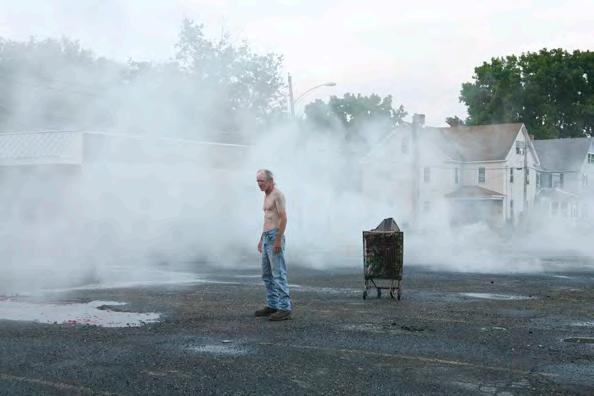
get a sense of the weather...”
“As we shoot, the camera never moves. We just make microscopic changes: how much of the face do we want to see? What’s the attitude of the shoulders? And in my limited way, I direct the actors.”
Making the Picture They shoot, he said, a hundred or so files for each picture, with different focuses and different light, overexposure and underexposure, so that they can make adjustments in post-production. But he rarely wavers from the original picture in his head, and he didn’t in this case. If this were me (and it really could never be) I’d cover myself in all sorts of ways so I still had the opportunity to change course. I’d keep all options open – what if that thing I saw in my head wasn’t exactly right? That’s just not the way Crewdson thinks. He’s committed. But his doubt manifests itself in other ways.
“Well, every time we’re on a shoot day, I wake up with an absolute pit in my stomach,” he said. “I want to throw up, I’m just filled with anxiety. It’s partially because there’s a limit to what I can do at this point. I am constantly checking the weather, what the wind is going to be – I hate wind -- and then the
6 GREGORY CREWDSON
possible danger, with all the lights and stuff.”
“But what happens is, as everyone’s in their place, and the light is going down, you can physically see the picture coming to life. It’s like inexplicably peaceful at that moment. Everything makes sense. The beauty, the light, the stillness – it’s my favorite part, this is it, it’s right in front of me.”
In this case, he was especially moved by the sky and the contours of the clouds, which of course he hadn’t been able to control. He was struck when the dump manager took off his shirt and revealed the patterns of uneven sun on his body; he couldn’t believe his luck. He felt a kind of artistic bliss, “sweet spot” between what he can control and what he can’t. But the feeling of serenity and satisfaction didn’t hold very long.
“Once the picture is shot “I can’t bear to look at it for at least a month. ” The distance between what was in his head and what he’s captured in the frame widens. “Representation always disappoints,” he said laughing.
Then, after a while, his despondency lifted.

Okay after all “I look at it and say Okay, maybe it’s not so bad. And then I start working again.” He looked at all the files and took a bit from
here and another from there, “to try to put it all together like a puzzle.” This is a long part of the process. Post-production takes almost a year. Eventually it gets made into a mammoth 50 by 88 7/8 print.
Finally the picture was done. And then he began the elaborate process of starting another one – the searching and the deciding and the casting and the futzing (and hunt for funding, an entire other part of the process).
“It’s funny, I’m awful at technique,” Crewdson said. “I couldn’t even develop a roll of film if you asked me to. I don’t know anything. Yet my pictures are super-technical. “ He shook his head. “The most important thing is your story and finding a way to present that in physical form. There’s only one way it could possibly be, and you’ve got to figure out a how to do it.”

7
“HOW DO YOU START a poem?” I asked. Marie hesitated. “I don’t know,” she said. “I’ve really been struggling writing. I haven’t written anything I really liked in a long, long time.”
Marie is a gorgeous poet – her book What the Living Do, which she wrote after her brother died of AIDS, contains some of the most heartbreaking poems I know; she had a reign as the New York State Poet. Shivering outside together under a heat lamp in one of those makeshift restaurant shacks that sprang up in the late first fall of the pandemic, we were talking about “The Singularity,” a poem she wrote in 2018 that became a viral sensation (by poetry standards) after she read it at The Universe in Verse conference that year, and then had another life later when it was made and distributed as an animated short. The poem was written before Covid, but it was prescient in its grappling with the place of the human in a world not subject to its control.

“The great thing about this poem is that there was a deadline for it,” Marie said. Maria Popova, who runs the conference, had invited Marie to speak at the event, which concerns itself with the intersection of poetry and science. Because she was having trouble writing at the time, “I was just going to read something from Walt Whitman, and Maria said to me, No, you write something, and I decided I would try.”
“It was 48 hours before the event. I wrote it by hand, in a notebook, on the living room couch. You carry these things around for years, and somehow it coalesces, and I know it’s a cliché but I’m writing to see what comes next. I wrote it out, then I might have written it again, and I probably typed it, changing it as I go. When I felt I had a beginning and an end, I walked into Inan’s room”– Inan is Marie’s daughter, then a teenager –“and I said, ‘Can you listen to something, and I read it her and she said, “it’s really good but the whole middle part is boring, and has to go.”
“And I said, okay, gone! And that changed everything.”
2 MARIE HOWE
occupation
:
19 MARIE
: First Lastname work : The Singularity born
19tk
HOWE On Struggling
Marie usually writes quickly. Lately she’d been reading “all the books trying to understand the universe and time and space and that sort of thing. Stephen Hawking, Carlo Rovelli. Inan was taking physics and was very good at it, and we’d be talking at breakfast.” Marie teaches an eco-poetry class to her students at Sarah Lawrence College. Many of her interests converge around trying to understand humans’ place in the larger scheme of things; her poems often have religious themes. “When I started to write I was always embarrassed by my theological interests,” she said, but there is no denying they are central to her, have been since her very Catholic girlhood in Rochester. So the poem was, as she said, months and really a lifetime coming. But it was particularly sparked by the phrase Stephen Hawking uses to describe the Big Bang – “the singularity.”
And now she was looking at the first draft of the poem, which you can see on p. tk, along with the finished poem.
Its first line Do you want to wake up to the Singularity we once were was there from the start. She thought for a moment and considered the line. “We once were, those w’s – and then the we and the you. So it had its voice and and its address – to you, to us. And that’s really crucial to me – if I don’t know who I’m talking to then I don’t know what I’m talking about.”
At Inan’s insistence, she stripped out the middle of the poem. “Mostly,” Marie said, “ I write a lot, and I take away things, say no. Subtraction is crucial. A poem is like crossing a stream, jumping from rock to rock.” Or, to put it another way, “a poem has to have silence in it.”
I handed her back the early draft she had given me, with my own editing notes to mark how it shifted. ”Oh, all this is very interesting,” she said. She read the first couple of stanzas outloud, verbalizing her editing process. “This goes, because it’s too abstract,” she said about a line she abandoned. “We already mentioned food, so this line is unnecessary. And I had to
add home alone to explain the pill drawer.”
She was struck by how much she added to the poem between drafts, which is unusual for her. One line she added – for every atom belonging to me as good belongs to you -- is a phrase of Whitman’s. “That Whitman quote is always in me.” She turned to our fellow diners in the restaurant shack. “I’ve always wanted to make a video on my phone, just turn to her” – gesturing at our neighbor --“and her and him, to a hundred and fifty people and have each of them say it. This line is the radical, remarkable truth. Every atom belonging to me as good belongs to you --that quote is the singularity.”
She saw that she added Farsi and French to the line about the ocean’s language. “Oceans have a voice but we can’t hear it. But we were oceans. We have the memory.” She was having trouble explaining it but intuitively she felt the listing of the languages helped. And she was also listening all the time for the sound of her words. English, Farsi, French – better to end with the French, one syllable”
Then we got to the phrase she added – that awful loneliness. To me, the specific evocation of loneliness (along with the pills in the drawer) drove home the price humans have paid for colonizing ‘nature’ (a phrase she has come to despise for its very suggestion that “nature is separate from us.”). It was what made the poem so painful. She agreed it was “the absolute heart of the poem,” but was focused on her use of the word awful. “Writing this line was the moment I realized this poem might work.” She was trying to get at the scale of the ecological horror. “I tell my students – ‘awesome’ used to mean blinding, burnt, terrifying, annihilating. We don’t have a word for that anymore. Now we say that t-shirt is awesome.” She mock-shuddered. Awful at least has awe in it. To describe “how lonely we are in the world we made,” it would have to do.
She got to my favorite part of the poem, which she also added in the later draft --the stuttering is is is near the end. “The problem was, before the singularity, there wasn’t a noun
3
The Singularity
When we were ocean
And sky was earth ,and animal
Was energy and rock was liquid
And stars were space and space was not
At all—nothing
Oh uncaused cause what made you move?
We have become unrecognizable
To ourselves: Anglerfish. Earth worms, Barking dogs, Snowstorms,
Who remembers when we were A singularity? When we were everything
With nothing around it.
( the last pea on your plate but also the plate the air, the table— )
Don’t throw plastic into the ocean! We are the fish! Remember?
Who wants to be a singularity again?? what we once was
Do you sometimes want to wake up to the singularity We once were?
So compacy nobody Needed a bed, or food or money
Nobody hungry Wandering in despair, in love, Curled into a cot, Hiding in the school bathroom
Pulling open the drawer Where the pills are kept
No more Nature . No
More Them and Us. No more testing
To determine if the elephant Grieves her calf or if
The coral feels pain. Trashed Oceans don’t speak English
But we can wake up to what We were before everything started.
No we, no was, no one. Home at last. Home at last.
Home at last.
4 MARIE HOWE DRAFT
The Singularity
( After Stephen Hawking )
Do you sometimes wake up to the singularity we once were so compact nobody needed a bed, or food or money nobody hiding in the school bathroom or home alone pulling open the drawer where the pills are kept.
For every atom belonging to me as good Belongs to you. Remember?
There was no Nature . No them . No tests to determine if the elephant grieves her calf or if
the coral reef feels pain. Trashed oceans don’t speak English or Farsi or French;
would that we could wake up to what we were when we were ocean and before that
to when sky was earth , and animal was engery, and rock was liquid and stars were space and space was not at all — nothing
before we came to believe humans were so important before this awful loneliness.
Can molecules recall it ? What once was ? Before anything happened?
No I, no we , no one. no was no verb no noun
only a tiny tinty dot brimming with is is is is is
All everything home.
5 FINAL
but there was a dot” – poetry’s power lies in its ability to convey such an enormous philosophical thought in just a few words. “There was no syntax, really, is what I’m trying to say. There was no subject/object,” She mused on the words subject and object. “Those words would have been better, “ she said.
Then she got to the last line, which originally read home at last. She winced. “It’s like a spiritual. You can’t say home at last.” She pared it down to home. But she wasn’t not entirely satisfied. “I mean, it’s really a simple point. It borders on the sentimental.”
The poem has won great acclaim, and she was happy with it but also, sitting here now in the damp cold, uneasy about her life as a poet. It was hard not to be moved by her doubt. I handed her another poem she had
sent me called “Hurry,” which features Inan as a younger child. I asked if she wanted to talk about it.
“It’s such a little poem,” she said. “People love it though,” sounding mystified. “It’s so simple,” I said, in praise. “Everything I do is so simple, “ she replied. “That’s what I’m embarrassed about.”
She cast her eyes down. Still as she read over “Hurry,” she felt buoyed. “It’s wild. It’s encouraging because I’m really struggling, but here it is. When I slow down enough to feel” – she stopped herself. “The challenge of my whole life has been to slow down. I find it very difficult to be still – to endure it.”
And at that moment during Covid, was pandemic life why she was having trouble writing? “Even in lockdown I’m so busy. I say I want more solitude, but I give it away. My daughter is old enough to be gone, but she’s not, so I’m never really alone.” Marie had been anxious, about the election, and more. “The world is so noisy,” she said, “Who needs it, everybody’s talking.”
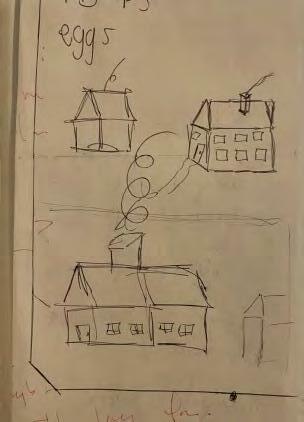
She had recently turned seventy, which may have been weighing on her more than she thought. Many friends she would show her work to are dead, she’d noticed lately. “So
Hurry
We stop at the dry cleaners and the grocery store and the gas station and the green market and Hurry up honey, I say, hurry, as she runs along two or three steps behind me her blue jackey unzipped and her socks rolled down.
Where do I want her to hurry to? To her grave? To mine? Where one day she might stand all grown? Today, when all the errands are finally done, I saw to her, Honey I’m sorry I keep saying Hurry you walk ahead of me. You be the mother.
And, Hurry up, she says, over her shoulder, looking back at me, laughing. Jurry up now darling, she says, hurry, hurry, taking the house keys from my hands.
6 MARIE HOWE
Dolut epti ne et fuga. Sit q tenm, ex ex ea.
March 16 2018
Jackhammers early this morning. The sound of spring. The light a gradually spring light. Oh Lord. I am still stumbling. Lucie Luciie Lucie
Her body. Her hair. Her hair in that casket. Her hands. Her breasts and her body her face.
A singularity is what was at the beginning. One thing and nothing else.
it’s like, who cares? You have to have someone waiting for you.” And readers? “If I think about them, I can’t write anything. When I write a poem I have to pretend no one will see it.”
I asked what emotion was most productive for her work– sadness? happiness? “Loneliness,” she answered quickly.
Her best writing comes when she is “in my nightgown for days, not thinking about anyone else. It takes a couple of days just thrashing through the brambles to get to any type of clearing, and it’s very painful. It’s frustrating, you see all your limitations, but a lot of what is happening is the unconscious is just waiting to see if you mean it. I like it once I settle in, but the borders are tough.” Once she passes into the other state, “that’s the best feeling in the world – we’re utterly ourselves and we’re nobody.”
A week later, I ran into Marie on the street – she lives down the block. She’d sent me some “inklings,” as she calls them, that she’d found in her journals of poems and fragments.
One mentioned money and food in a formulation she would
Henim andio. Ehenis auditae reptissum et aut autempe ritati debis dolliquas atumqui antionsequia nis elessum volorep erfere voluptat.
Mentotatem et ex estiundaecta esti ullabo. Orum hit voluptae alit dolupid endi dictur, non consed eiunt haritat invelecto vellest, consequidel et laborum coreptat mi, sequunturio. Aximaximus, to evelendenda nosandae voluptas voluptate ernate acipiet quias rehende nimolor erferro dis el maio. Nempor assitatibus eic to eosam rate aut dis consectiat maximporent, ne sinum a nonsequis et exces es el issimpore nem voluptatae nonem fuga. Ut vitius niasimpor magnis maximost, abo. Ut eossed qui dolorro conse sum fuga. Itas et lacerit lab idebis rem sum fuga. Lament aut quae nimaxime volorro restem sequissitio blaciis dolum quaspiet vel imaximus, am, odis duntiae volori adis et asin et, inctata dellaut repti volor repratenet aut dioremped event quis velluptati ant. Consequaera verae
use in the Singularity; one mentioned the Singularity itself. She’d forgotten about both, which were written several weeks before she wrote the poem. We marveled about the subconscious. The poem, she remarked earlier, “uses me.”
And she was excited to report she’d marked out a week to sit in her nightgown and work. She was now full of optimism, and as a friend and fan, it was a relief to see. At our tea, she had wistfully described what writing poetry was about for her. “It’s self-forgetfulness,” she said. “That is the suffering of being human –self-consciousness.” When she can get beyond it, that, she said, “is the great liberation.”
She was enthusiastic to get back to writing. “I don’t know what I’m doing,” she said. “But I never do. You only know later. A while later. And you go, oh my God, look at that.”
7
FROM HER JOURNAL Doolut epti ne et fuga. Sit q tenisuptam, lut epti ne et fuga. Sit q tenisuptam, ex ex ea.


GAY TALESE

GAY TALESE WAS a little irritated that I’d come to talk to him about “Frank Sinatra Has a Cold,” which he considers inferior to his other writing. But among journalists especially, it is his most famous and influential work, and it is considered a pillar of the New Journalism, a label that came to describe nonfiction written with the conventions of literary fiction, except that it was not made up – at least most of the time.
Literary journalism was why I became a journalist, and I was pretty obsessed with it as an adolescent. Tom Wolfe, Joan Didion, Michael Herr – and Gay Talese – were my heroes. This was a movement, if you can call it that, motivated by status insecurity. Journalism was considered a craft, not an art, which ate at this group of ambitious reporters, so they set out to prove otherwise. They structured their pieces as short
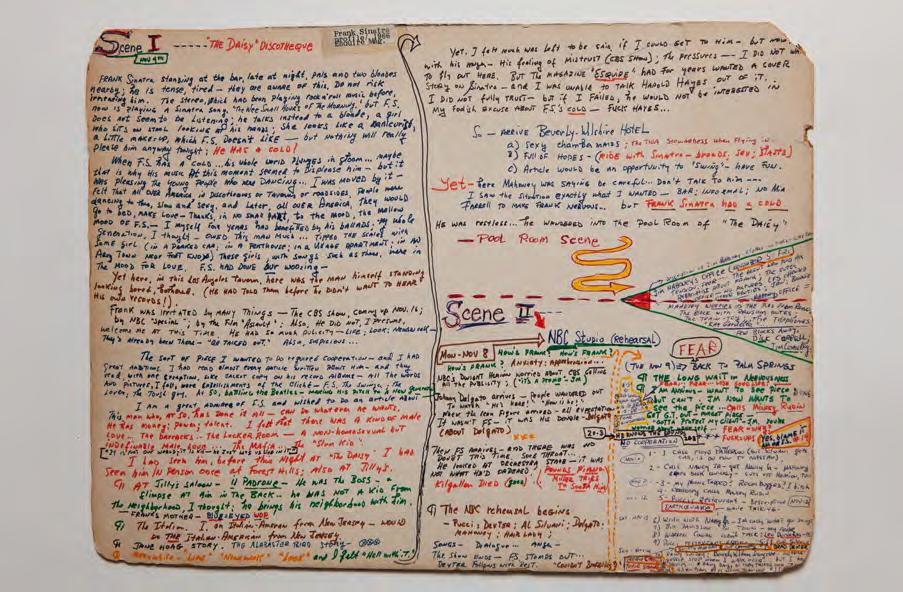
2 GAY TALESE
TKTKTKTKTKT
occupation : Journalist work : ttktktktktk born : 19tkt 20
“What the Hell Could You Ask Sinatra?”
stories, built around scenes and action with plenty of dialogue, and wrote with an authorial confidence (godly omniscience or direct address) that traditional reporters generally found presumptuous or vulgar. They did away with all the usual rudiments of journalism –transparent sourcing, an effort to at least appear objective – and replaced it with swagger. They made grand observations, and because they were smart, their observations were usually worth reading, but looking back what most impresses is the arrogance they brought to the whole enterprise.
And of course their heyday, the Sixties and Seventies, was a time of great and fascinating turmoil, which was also central to their appeal. Fundamentally, the medium they were forging was to try to take fact and fuse it with imagination without compromising
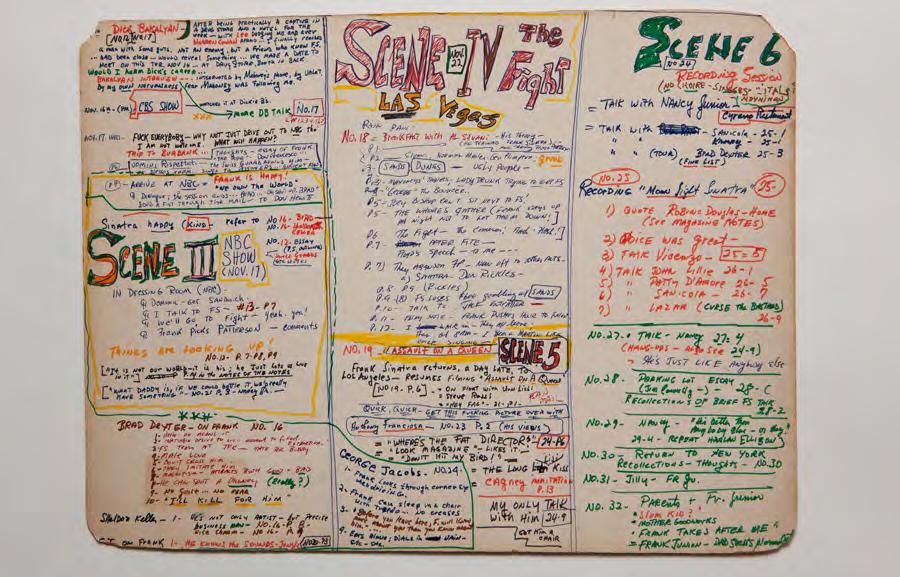
the fact, an exciting trick that few could do well. There were a lot of terrible imitators. The genre has pretty much died down by now, whether because the writers don’t have the talent or the moxie or the industry (these pieces were very difficult); or because readers don’t have the appetite. Both I guess.
Talese was among the most restrained of them, and I always found the interplay of his literary ambition and the quiet of his prose to be especially effective. He is very much a gentleman. He met me at the door of his townhouse dressed in a suit, tie, pocket square, a little ridiculous for meeting, in his house in the mid-afternoon, and after some polite conversation we went down to his writing studio, a basement he called the bunker. He keeps every note – for the pieces he did for Esquire , including ones he considered his best like a
3
piece on Floyd Patterson called “The Loser”; for his classic book on the New York Times, The Kingdom and the Power ; for his bestselling mafia-book Honor Thy Father ; his scandalous study of the sexual revolution, Thy Neighbors Wife ; the two books he was writing even now, at, when I met him, 88. And of course “Frank Sinatra Has a Cold,” a piece he never wanted to write, but that follows him everywhere.
Talese blames the attention he’s received on Tom Wolfe. “He wrote a book called The New Journalism.” Talese said. “No one ever heard of me until then. He coined it, and he made me the founder. Pissed a lot of people off. I didn’t even know what he was talking about. But it brought me to the attention of the college crowd.”

Among the most famous attributes of “Frank Sinatra Has a Cold” is that it was, in journalistic terms, a “write-around” –Sinatra wouldn’t talk to him. But what makes the story endure is how he went about solving that problem, embracing the absence and building the story around the colorful characters that made up what they’d now call Sinatra’s posse. That’s what Talese liked best about it too. The story is soaked in detail. The narrator is all-knowing. The piece has a fairly sophisticated structure – scenes wrapped within scenes (several of which he alludes to below) And all of it is plotted out in the colorful outline you can see on p. tk.
Throughout, Talese paints a world in which the protagonist is only seen through the reflection of the hangers-on who feed on him. But that wasn’t Talese’s intent. His editors wanted a profile of Frank Sinatra in which the reader actually gets to meet Frank Sinatra. That’s
what he flew out to Los Angeles to give them. As he rifled through the notes in his boxes, Talese found himself reliving the story. I was struck by a few things: How powerful a tool is simple observation. How hard he worked to get at what might have been a simple entertainment story – believe me, people rarely work so hard to capture celebrities; it pays the rent but most of its own practitioners view it, if they’re being candid, as hack work (though in the right hands, it’s absolutely not). And then how he coerced the story out of his experience, writing about the same detail over and over again, as note, as summary, as outline, as draft until he understood its meaning for him. Like for so many, his relentlessness was pivotal.
4 GAY TALESE
GAY TALESE:
I worked for the high school paper and I went to school in Alabama because I had a hard time getting into college. And then in Alabama, I met this Southern guy. And he said, since you like journalism so much, maybe you want to go to New York. You can talk to my cousin, who’s the managing editor of The New York Times, Turner Catledge [fn1] . And that led to my getting a job as a copyboy. I wrote a lot when I was a copyboy, mostly about obscure people, and I even got to write for the magazine – I was a pretty hot copyboy. I’m in the army for two years, and when I come back I get assigned to the sports department, which was good because they let me do what I want. And
I guess I broke rules. I wrote about a fighter once, I didn’t even use his name. I wrote about a jockey. Why? Because Carson McCullers wrote a short story called The Jockey. Mc Cullers, Shaw, I read them, I reread them, I almost memorized them. I wrote a lot about failures, because loser locker rooms are always more interesting. They let me because they were desperate to have sports writing that wasn’t boring.
I wrote three books when I was still at the Times, and I started to write for Esquire on the side.
I quit the New York Times because I was sad. I couldn’t get more than 5000 words. [Words are an extremely coveted currency for journalists]. Sinatra is, I don’t know, 14,000. I was making about $300 for the Times. And Esquire gave me the same amount, for six pieces, that’s all. Harold Hayes [fn2] , the editor, said you choose three and I’ll choose three. So the first piece I did for Hayes was about Alden Whitman, the Times obituary writer – it was called “Mr. Bad News.” I loved it, probably the best piece I did. Then Hayes says “I want you to do Sinatra.” I said, No, Jesus. Everybody’s done Sinatra. I argued about it, and he said, “Look you have a cover guaranteed. It’s all set. Sinatra’s doing a big NBC special.” And then I said, and after, can I do Clifton Daniel [another Times figure, a managing editor]? He agreed.

A Cold is Not a Cold So,
Sinatra was easy. I just had to fly there. And we used to have expense accounts, incredible. But when I got there I called Jim Mahoney, his press agent, and he said “oh, gee, you’re here.’
Uh yeah, I’m here, when will I
5
see Mr. Sinatra. He said, “well, Frank isn’t feeling too well.” Oh. “He has a cold.”
Well I thought it was all set, it was not all set. I’ll just go home, now I can get the fuck out of there. But I call Harold Hayes. And I say if you want me to come back, I’ll come back. Or I know you really want this piece, so I can try to do some research out here while I wait to talk to Sinatra. I knew people in Los Angeles. I knew a very important person, a guy named Jack Hanson, who owned a place called the Daisy-- the Daisy discotheque. He knew a lot of Sinatra people. He gave me some phone numbers. And then the phone rings one day and it’s Mahoney. He says, “I understand you’re talking to some friends of Frank. What are you doing?” I said, “how’s Frank’s cold?”
“I’ll tell you what,” he says. “You’re not gonna see Frank.” But he said I could go to a rehearsal and watch if I kept my mouth shut. I knew the director of the special, named Dwight Hemion, whose daughter and my daughter went to the same school, but I didn’t let Sinatra know that I knew Hemion. At the rehearsal Sinatra’s voice cracked. His cold. And there was a guy who says, of all the people to get a cold, it has to be Sinatra, he couldn’t have broken his leg? I see Frank’s double there. His driver, his bouncer. We were all watching Frank. All the studio heads, all the secretaries. And a trombone player from Nelson Riddle’s band slipped a camera out of his
pocket and snapped a photo of Frank sitting there. Little stuff I knew I wouldn’t use. And I wrote it up as a scene.
It’s all about the scenes. Cause I always wanted to write scenes that seem like they’re made up, but they’re not made up.
The “Lede,” as Lived A couple of days later I go back to my friend Jack Hanson at the Daisy. It was dinner hour. And I see Sinatra over there at the bar! The lights were behind him, so you could see it was Sinatra. And the two blondes – you could certainly see that. He was with Leo Durocher, the manager of the Brooklyn Dodgers and a guy named Brad Dexter, who was just hanging around. So I see him, and I wrote some notes. I write on these little shirt board things.
It’s always all about being there. No fucking telephone. Or tape-recorder, worse. Because then you’re surrendering.

I look at Sinatra’s shoes-- unscraped, like they were never walked on – and he was smoking a cigarette, he lit the light and the woman next to him was smoking too. After ten minutes, he went into the pool room. And he was engaging in conversation with Harlan -- Harlan Ellison, a screenwriter [fn3] . And then finally Sinatra got up, left. Then when I go home to the hotel, I have my little Olivetti typewriter with me. Soft wrap on the door. Chambermaid. Lovely Algerian woman, blue eyes. And I’m writing about her and this

6
GAY TALESE
fucking airline stewardess I met on the plane. So what I’m trying to say is, sure I’m on assignment to do Sinatra, but I’m also always writing about stuff that has nothing to do with Sinatra.
But back to Sinatra.
I write, tonight I was at the Daisy, I saw Frank Sinatra, he was with two blondes.
And two guys – one was Leo Durocher. And here’s this guy named Harlan Ellison and Sinatra was bitch bitch bitching about his boots, his fucking Western cowboy boots. And I saw that he was expecting this storm. I wrote the whole scene, the next day when I see Ellison, I say. What were you thinking? Where did you get the boots? How much did they cost? Did you think Sinatra’s gonna throw a bottle of bourbon at your face? That he was going to beat you up? No, he said, I didn’t give a shit. Sometimes journalism professors, critics, say, how do you know what a person’s thinking when you write these interior monologues? Well, you ask the fucking person!
Every day on the road wherever I am, before I go to sleep, I read what I’ve written on the shirtboards and I type up my notes. I’m thinking about Sinatra. He is a blend of power and fear. He surrounds himself with all these talents no match for his. Then there’s all this stuff in the papers. About him angry and threatening to sue Walter Cronkite [who’s preparing a report that’s rumored to be about his mob connections]. I write all that down.
Let’s see [Talese is flipping the pages in his folder]. I’m really despondent and desperate today.

I’m still no closer to seeing Sinatra. I’m waiting for the phone to ring, waiting for someone
to liberate me from the helplessness and isolation and frustration and impotence. I can court people. I can con people. I can seduce. But if I don’t get any response, I’m an inanimate object.
But I’m thinking... Frank Sinatra’s got a cold... And I’m thinking, Oh boy, the whole story of people around him...
Nobodies This is written at night. Everything is written at night. Each page of my notes is dated, 1st day, 2nd day. I’m running up bills every day. I’m taking people to lunch and dinner. Minor actors, but they were available. Pucci, that’s the bouncer, he used to be a professional football player. Pucci talked to
7
me because his brother had a restaurant, and he wanted Esquire’s restaurant critic to write about it. I talked to the woman that carries Sinatra’s toupee, the valet, people who worked in a band with Sinatra. Who the hell are these people? They’re Bartleby people.
Oh, see. Then I go to the Ali-Patterson fight in Las Vegas.
Floyd Patterson is a friend of mine, I wrote 38 pieces on Patterson. I get the idea to call Patterson. I got tickets from Patterson. There sat Sinatra. Blue eyes. Kind of a religious experience. They just looked, staring.
On the 22nd day, I finally talked to Nancy.
I was supposed to talk to her before, but just as I was about to go over, the phone rang. It was a hard voice, Mahoney, didn’t I tell you not to talk to Nancy? Hayes had said to me that my phone might have been tapped, because how would Mahoney know that I was calling Nancy Sinatra? But eventually I get to her.
All these people wanted to be interviewed because they thought they were going to be a piece themselves. The most important connection I had was a guy named Jilly Rizzo, who is a pal of Sinatra, very close.
Thuggish guy but really important because he got me to Sinatra’s mother. And the reason he would love me is because the last piece I wrote for the NY Times was on Jilly Rizzo’s saloon in New York. He loved it. And when I was there I saw Sinatra and I talked to some people outside the bar about Sinatra, wrote it on my shirtboard thing and saved it – and later used it in this piece. As long as I was with Jilly, who was almost like Sinatra’s consigliore, they had a sense that I wasn’t doing anything funny or mean. And I wasn’t. I only wanted to finish. I had to pay the rent. I had a daughter.
So, we’re at thirty days at this point. And my next step is to summarize it. And while I’m summarizing, I’m sort of commenting on it. I’m sort of writing. And then I put it in
some form. This is a rough draft. I’m thinking how the fuck to begin this. So now I’m thinking Daisy – here it is. This is what I wrote.
It’s not exactly how it ended up [but it’s close]
And also at the same time, I was pissed off because I was worried the piece was not working out. I had been unable to talk Hayes out of it.
But I don’t trust him. If it failed, he would not be interested in my foolish excuses about Frank Sinatra’s cold. Well, fuck Hayes.
But I didn’t want to quit the story. Hayes scared me, and I didn’t want to be there, but I didn’t want to walk off the story. So I told Hayes, it’s better without Sinatra. If Sinatra had talked to me, it would have killed it. What the hell could you ask Sinatra?
I said to him I don’t need Sinatra. There are a lot of minor characters in this story. Everyone is a minor character – and here’s the story:
When Frank Sinatra has a cold, everyone has a cold.
[Hayes published it pretty much exactly as he wrote it.]
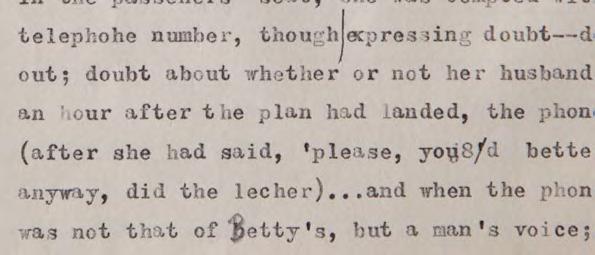
When I finished this piece it wasn’t like Oh, wow, boy, I wrote a piece of journalism people are going to be reading 50 years from now. Not at all. I did get lots of letters, I saved every fucking letter.
I never heard from Sinatra. Years later, Sinatra’s daughters said they thought it was pretty good. And now, the Sinatra family has bought it. For the movies. Got half a million dollars for that.
8
GAY TALESE
TKTKTKT HEADER Ebit od quos vendaes essimustia vit perspero cumquae. Cerore, sit, et mincto occusandande sedissita qui offic temporiam aliquaecus

9
THE HOURS, NOTES TO SELF

10 GAY TALESE
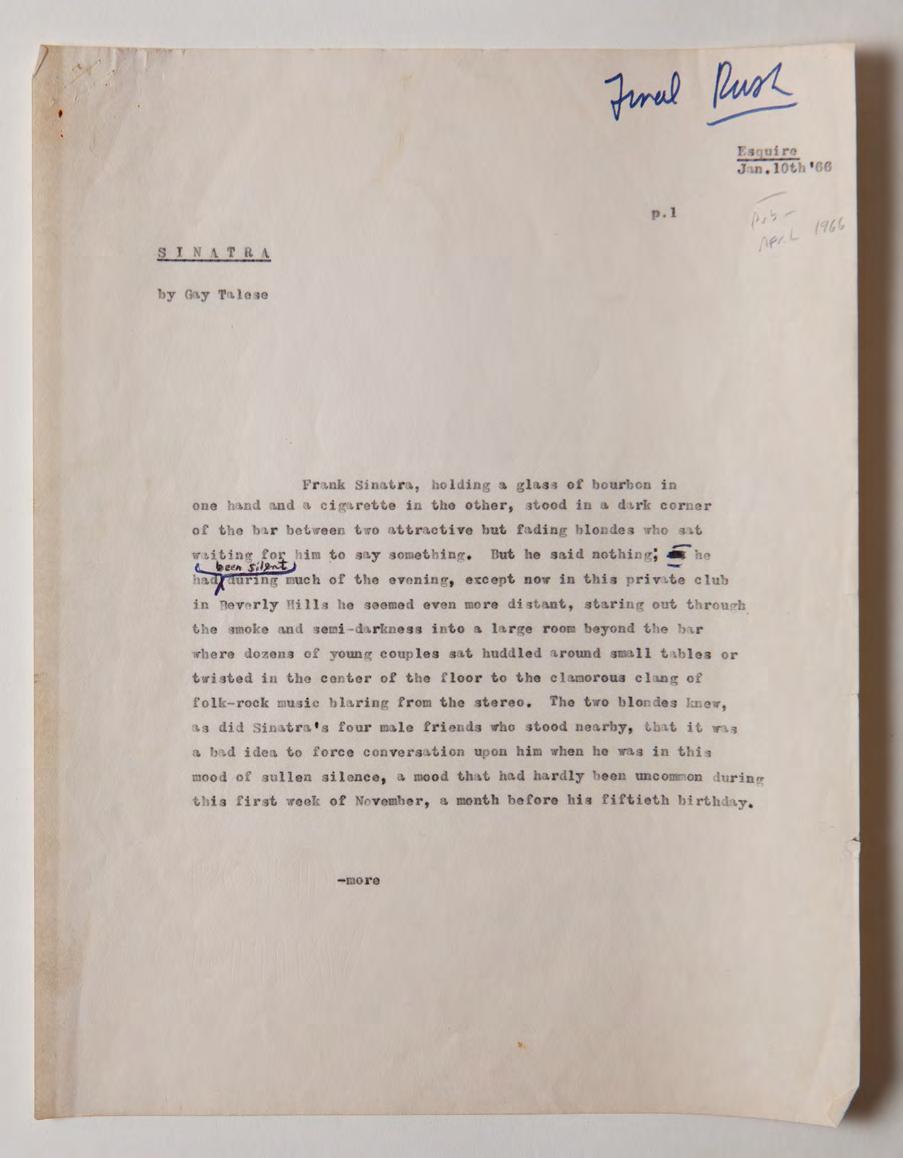
11 THE HOURS, NOTES TO SELF
CHERYL POPE

A Kind of Derangement
I WAS ON THE LOOKOUT for artists who kept minute iterations of their work, which few people actually do, and Mardee, the project manager of this book, sent me this unfinished image. Mardee was a big fan of Cheryl Pope, who’d made the work it was on the path to becoming. And she knew Cheryl had recorded the steps because she’d had a number of doubts along the way. Also that the work was very emotionally fraught for her, which piqued my interest.

I didn’t know Cheryl’s art, and I didn’t know the heartbreaking context of the image I was looking at, but I was drawn in by the beautiful emptiness of it – a consequence of it being essentially a study, but also, I later learned, because the work is itself about absence. And in fact, this simple gestural study of a mother and child in felt is actually my favorite version of the picture because it expresses that emptiness most poignantly.
Cheryl is a Chicago-based artist who traverses mediums (she moves from installation to sculpture and performance); this piece was a textile painting, an art form she taught herself. She is a disciple of the artist Nick Cave, who is best known for making Soundsuits, elaborate costumes that are part performance, fashion, part sculpture. You can certainly see the influence. Cheryl ran Cave’s studio, watched
2 CHERYL POPE
21
occupation : Visual Artist work : Mother on a Blue Mat born : 19tk
and sewed a lot.
She made Mother on a Blue Mat after her third miscarriage, and it was her way of responding to the growing evidence that she would never give birth. This conclusion devastated her. Art is often a kind of therapy but few pieces I’ve encountered are so directly and powerfully motivated in that purpose – to work through difficult feelings -- as this one. Making the work was, as she put it, “my way of painting through the motherhood” she would never have. She teared up as she was describing how she found her way through to the end, and then later said that the act of talking about it to me “unraveled an internal knot,” which made me think that art shrink maybe ought to be a profession. In any case, the work was deeply loaded for her.
She started to make art as a child, where she got encouragement from an art teacher, found herself studying fashion at School of the Art Institute, Chicago (“I would dream, I would see everyone in clothing I had never seen before. So when I woke up I would try and draw that out. That’s why I went into fashion.”), where she met her mentor Cave. What seems striking to me (because I spend so much effort/time/ agony trying to learn a craft) is that she hasn’t had a particularly rigorous skills training, but seems very unintimidated by the craft aspect of making art. She switches materials a lot, figures out how to make stuff by looking at YouTube or talking to knowledgeable salesmen at Home Depot. She is an avid boxer; she says that being in motion helps her to see things – it’s one of her hacks (a common hack, as it turns out.) She doesn’t particularly understand how she makes what she makes; she becomes obsessed and can’t let go, like pretty much everybody else in these pages. “The way an image comes forward, I don’t have a map for that. I have my mind just going and then all of a sudden, I start to visualize it. Sometimes I think about myself as an employee of this,” she said, pointing to her head. “Whoever up here comes up with the idea, I am just the laborer. It becomes a blur. I don’t even remember much because I’m in such a neurotic obsessive state.”
That was the case for this work, which first took hold right after she lost the last child. Her partner hadn’t wanted the child in any case, and she was distraught. Eventually she and the partner split, which gave her the freedom to go forward with making the work. I asked her to narrate her way through it, decision by decision – including, as you’ll see, regrets.
CHERYL POPE:
“Okay, to start, this work happened out of survival. I had a miscarriage – my third – and lost my mind. It felt like a volcano erupting, like tectonic plates shifting.” She started to “draw” the image on felt, which felt for her like the right medium though she didn’t know a thing about felt. “One of my students had used this felt-making technique five years earlier and that stayed in my mind. I thought, oh, that’s cool, I’m gonna remember that one.” The technique required her to punch through the felt. Maybe the punching was what drew her to the material.
As for how she figured out how to work in the medium, she says “I just did it. I was in a deranged state.”
1.“I took this picture a few days after the third miscarriage. I’m in a really messed up space here. One of my ways of coping I realized later was that I started amping up my plant life at home. Like: Yes I lost these babies but I can
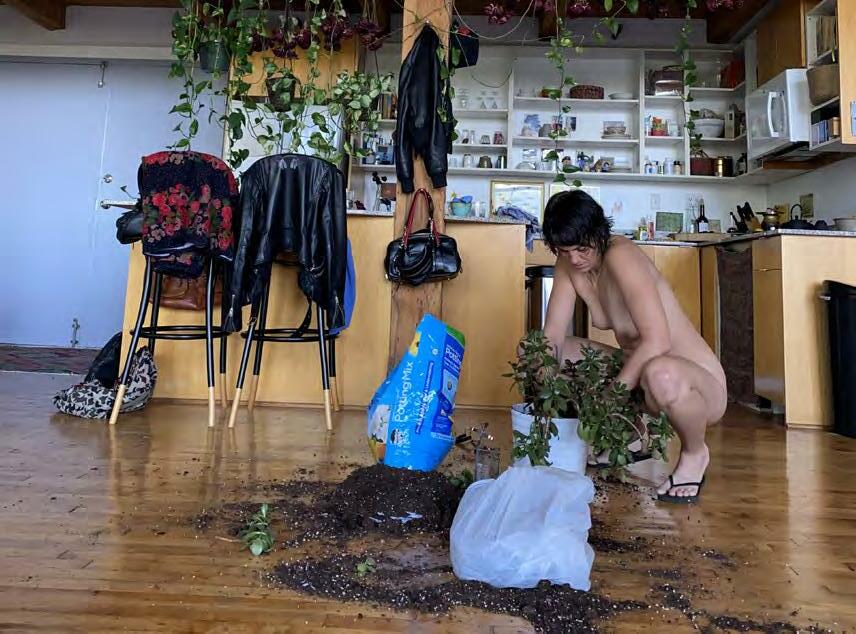
3
grow things. I was repotting everything.” She took the pictures because she intuited that the planting might “be telling me something.” But meanwhile, she was making other images.
2. “ This was the first one I did, maybe three days after. I’d had an image I’d been working on, of me sitting on the bath [when I was pregnant], and I took it out. And I see that she’s sitting on the bath because she’s washing someone – everything was composed for a child to be there. My partner had been very against me drawing any of these images with the child until I had the child. But then once I’d had that third miscarriage, I thought you know, I’ve imagined this so many times, I wanted to give myself the gift of seeing what I had imagined. My partner did not want the children. So I had been imagining myself as a single mom, seeing myself in these different moments -- the bath, or this other picture of me breastfeeding, which I did a year later. What I wanted to have happened, what I imagined would happen, what didn’t happen.”
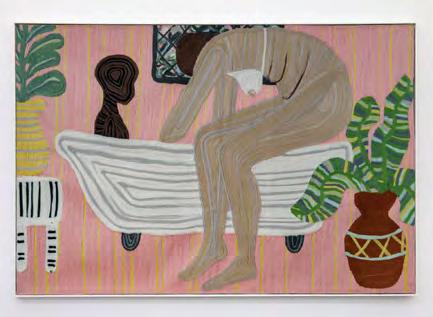
3. “When I went to begin what became Women with Child on a Blue Mat, I couldn’t find the plant picture in my phone, but I remembered it. So I recreated the scene and took several pictures of it . What I liked about this version was this shape, with her leaning down. I’m starting to make an oval.”
4. As she began to work on the felt, she tentatively placed a child in the image, almost as an imagined witness to the mother and the plant. “When I looked at the photo it was almost like I was talking to this baby that wasn’t there. Where is the child – the child was absent but was it present in the plant? Do I put the child there? I’m asking myself these questions. And of course it was because I’m still revisiting motherhood in my own life. Those miscarriages were my motherhood. And when



4 CHERYL POPE
I started to do some research, I realized that [the Impressionist painter] Mary Cassat, who is the go-to for mothers and children – she also didn’t have any children herself. So that was really critical. She gave me a freedom to say I can do this – This is my motherhood and people can hate me for it but that’s what it is. So I made this drawing. I love composition, composition makes any work work. The psychology, the feeling of a work for me, is in the composition. I was interested in this circle [the mother and plant] and this larger circle [including the child.] And I started to get this anxiety, like why is she picking up the plant? I want to pick up the baby –
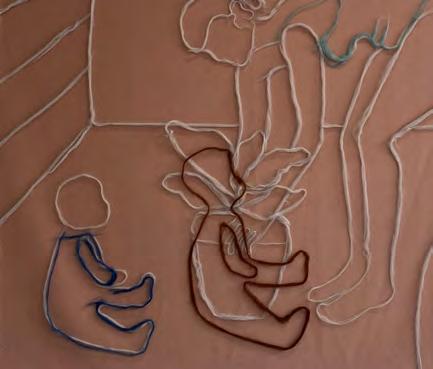
“And I was going to leave it like that, but then I had a three hour call with a friend who also had a miscarriage. While I’m talking to her I’m looking at the image. And I got off the phone and I just --
work. “And so I start going back and forth and then I need to make a decision and I say okay I’m going to make the switch.” So she’ll move the baby, but put aside the two-baby picture.
“Okay I’m going to put him here and the plant there. And they still make this nice circle. But I know I will use that image [of the two children] again someday--I will return to it. And actually now I find I like that picture better than where I landed.”
5. “-- moved the baby over : let me just draw him over here. But I didn’t want to surrender the other drawing yet. This may be TMI, but I draw when I’m ovulating because I’m the most sensual. So my time window matters with these. And I record the image [of the two babies] because I think I really like this too. I like this echo, I like this as a misplace.” She plays with the introduction of an illogic to the
6. “Meanwhile, I’m just drawing these on my phone—I take a picture and draw on it with my finger – they’re stages of apprehension. Studies.”
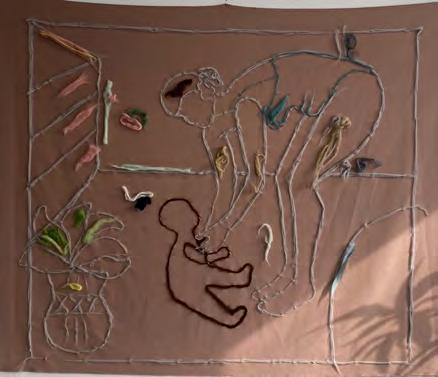
7. She did a version with color swatches to see what would work. “I learned to do that during my fashion days,” she says..

5
“In the same way that with mothers there’s this ongoing relationship of the child disconnecting from the mother, I’m also thinking about connection and disconnection between the real and the imagined in my own situation with the child. This child did disconnect from me already.
“This happened three times. It’s a cycle. That’s why the composition is circular. I’m circling around this, I can’t get out of it... .Color has to start to work with composition, it controls the way I moved my eye. Because as Kerry James Marshall said, why did you make that rug a pattern? His answer was that otherwise it would be boring. Pattern keeps the eye irritated, active. So we stay engaged longer. I’m not following color theory, it’s just intuition.”

But she’s wrestling with decisions. “Should I leave the floor white? Do I want to leave her hair like this? How much do I keep telling and not telling in this image?”
him look more like a mulatto looking child. But it doesn’t work for the painting. I’m well aware that a child is born lighter and can get darker.” But she’s worries that because she’s white, viewers will think she doesn’t know this. “I have to tell everything in this one image,” she says. “There’s no room for nuance in this political climate. And that’s suffocating.”
8. Of particular worry is the skin color of the child. Her partner, the baby’s father, is Black. She is white. “My anxiety is hyped up because I am worried about how people are going to read race in the picture.” It is 2021, Black Lives

Matters protests have heightened racial sensitivities, and they unnerve her. She tries to “put in a softer brown rather than black to make
9. Of all the decisions she has to make for this work, the hardest might be the decision to give faces to the mother and baby, or not –to make the picture specific or to generalize, to close it, in her words, or to open it. After much deliberation, “finally,” she says, “ I go all the way and give her a face.”
She notes that she put the face in because it frightened her to draw one on, and she knew if it scared her, she ought to try. She could always pull it back.
As she is talking to me, she uses that phrase so many other artists use” says that she is “listening” to the mother, waiting for it to tell her whether it wants a face or not. “Listening is at the ground of all of this...In those moments of debate, I just tried to stay very quiet, listening for which one she wants me to do.”
As for the baby, she says, “even at this moment I’m stopping because I don’t want to draw his face in. Because I can’t imagine his face. And I’ve never drawn a face. Am
6 CHERYL POPE
I scared? In my own mind I’ve never been able to imagine the face of the babies I’ve lost.”
10. In the end, she gives the child a face. “So then I came into my studio and thought, just do it to see if you can do it. “
she says. She keeps the face.
11. Here is what the picture looks like finished: But even after she is done, she has regrets about having included the baby’s face. “Later when I looked at the piece I went back to the gallery to take it down because it just tells everything. Everything is told here. But it was too late. Because then it became public.”

“If you were to do the picture again, you’d do it without facial features on the child?” I ask her.
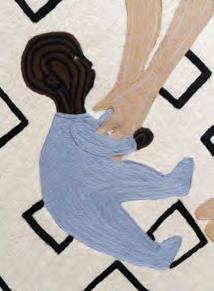
7
A World I Can Control
I ALWAYS WANTED TO meet Ira Glass. We worked in parallel fields -- radio, magazines – but our mediums were so different. I was curious about that. And I really admired him. His single-mindedness, affability and ambition (also that voice), made for an unusual cocktail, and it’s what turned This American Life into such a successful joining of journalism and art. To my mind, he was a real creative pioneer. After years working his way up in public radio, he’d acted on an idea he’d had for a new kind of radio program; that became This American Life. And with it, he was the inventor of that casually nasal sound and intimate unspooling style that has together become, especially in the age of podcasts, the ubiquitous voice of oral narrative. In a sense, he created an art form. Also, he was an anxious Jew, just like me.

Mostly, these chapters are built around specific case studies, and Ira and I tried to parse a couple of different episodes to show how he makes a story, but honestly, they were too complicated to make work in these pages (a problem he would understand) [fn1], so I ditched them and focused on how This American Life – and that sound – came to be. Also I liked how he talked about creative work. It had a Calvinist quality I could relate to. So I wanted to start there--
AM: I was hoping we could discuss the relationship of anxiety to drive, because I think it’s an important note for the book and people often, at least implicitly, bring it up.. And you’re candid and articulate enough to–
IG: Nice flattery! As a fellow interviewer, I’m respecting the flattery. All right. I need a harsh deadline to get anything done. Without it I can really float. And I’m anxious about it being good. Like all the time. My experience of most stories is that they’re trying to be mediocre. I mean, occasionally a person is such a good talker, and the story is inherently interesting, and the stakes are so good, and they’re funny, and it has so much feeling, all you have to do is get out of the way. That doesn’t happen often.
2 IRA GLASS
occupation :
work : This American Life born : 1959 22
Radio personality
IRA GLASS
Generally, because we’re building around tape, there’s enough to make work if you try really hard. And in every draft, it’s just going back and forth between being sparkly and matte. And matte is usually a long part of the process. There are stories, much of the time I’m wondering are we gonna have to kill them. And only at the 11th hour do they get to be good enough. It’s only through an act of will that things are not mediocre.”
“Every episode feels like it’s down to the wire. The thing just goes out on Friday night on the Public Radio satellite and then it has to exist. I’m anxious about it getting done, and I’m anxious about it being good. I’m anxious in general. At least it’s anxiety about something in a world I can control. If anything I’ve really organized so much of my life to do away with personal relationships, and to spend more time inside the battle against inefficient storytelling.”
“Yeah, for better or worse, as a number of my girlfriends and my ex-wife pointed out, a lot of my energy has gone into that. I don’t even think of it as anxiety. There came a point in making last week’s show, where to get the thing done, basically I was getting up at six in the morning and just working until I went to sleep at night. [fn2] It wasn’t a great way to live. But it was certainly a simple way to live.”
AM: There’s a quote I read of yours that I think pretty perfectly encapsulates the creative predicament. It starts ‘Well, nobody tells this to people who are beginners...”
IG: Oh that. It’s something I said off the cuff year ago. Should I even refer to the fact that it exists as a quote?
AM: Sure. But we’re not talking for radio. I could always edit that part out.
IG: Oh, right. Well, basically it’s a quote where I express what my experience was in my twenties, which is, if want to do creative work of any kind there’s a period where your ambition is greater than what you’re actually able to make. Like in my case my ability definitely was lower than my dreams for myself. But I was smart enough. I could tell the difference
between good and bad. I think that people don’t talk about this. There’s a time when you have this dream and you have enough taste to know what’s lacking but your abilities don’t get you there. And I think people just die on the rocks of that, that point when they write songs and their songs aren’t that great, and they’re rational about that, not deluded, and they stop. I was really stuck there for a very long time.
AM: They have the ambition but not the skills, and most people just don’t wait it out.
IG: There was a point where every year This American Life would do a poetry show. One year a producer pitched an idea, and I said ‘Oh my god, I did that story a while ago. Why don’t you go back and listen to it and see if we can pull the tape out or something.’ And she went back and listened to my story, which was only from a decade before. And she said, ‘Wow. There’s no sign from the tape that you have any talent for radio. There’s no good writing, the story doesn’t make any sense. You seem to have no aptitude for radio at all.’
AM: Was it really that bad?
IG: The drama of my twenties was wondering if I was ever going to get there. I would have these simple stories I was trying to make on my own, and I would take weeks. I was just a bad writer and so insecure as a picker of tape.
AM: So how did you emerge from that?
IG: Really, you just have to work your way out of it. That’s the only way. You have to be rigorous you have to be a soldier, you have to fight. It’s only by making a volume of work that you’ll be forced to confront what it is that you don’t know how to do and learn to do it. Oh, and the other thing is, you need to show your work to other people and have them tell you what they don’t like. There’s a period when I would pay this guy 50 bucks to tell me what I was doing wrong.
How TAL Works
AM: Let’s break down how you make a show.
IG: Well, our regular pitch process is that we have a story meeting every week.
3
AM: Are they competitive? I always wanted our pitch meetings to be a little scary. I thought it would bring out better ideas. I still think so, but I got a lot of shit for that.
IG: If anything, there’s an overweening attempt at niceness. Very often a few of us have to be the ones to bring down the ax. And then there are stories where everybody’s on one side of it and I’m on the other. Often I’ll give in.
AM: And the stories themselves?
IG: The thing radio can do peculiarly well is make you attached to a person. The medium is built for it. So first and foremost is the tape. You’re always just building around tape.
AM: I used to think ‘voice’ was htat for magazines. If the voice of the story was right – that is if the reader wanted to be in the writer’s company – you could fake your way through the rest. But for you the crucial element is the tape?
IG: Without decent tape at the beginning it’s hard to make something good. Often we’re really excited about something but the tape is like ehhh.
AM: And does that mean the story’s doomed?

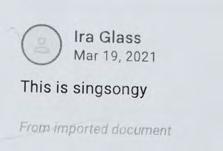
IG: Not always doomed, just hard. The simplest way to think about it came from Julie Snyder who went on to do Serial with us. She sometimes thinks like, what are the moments of a piece that I’m looking forward to? There have to be a bunch of moments like that. It’s
just a lot stage managing: how much this person is going to be a character, how much we’re going to develop this argument, do we want to go funny here or serious here. And radio is so sensitive. I don’t know if it’s like this in print. Pacing is so hard. How long do you linger on a point-- one more sentence, or half sentence? At first it’s a written draft, a script. A lot of the things you’re figuring out are the mechanics of the drama. Like for you to invest emotionally, you have to have someone you care about. But honestly, so much of a radio story is about when do you slow down, where do you have a beat for feeling, and where do you have a beat for information. In a way its very traditional drama. And then stories go through many, many drafts. I’m working in a medium that rewards editing and re- editing and re-editing. Changes, nips, tucks, all the way to the moment it goes on the air.

AM: How do you build a show?
IG: It can take different forms. Usually there’ll be one story we’ve been working on for a long time, and then everything else will come together really fast-- not the best way to work. The shows have themes, but you might notice a story is not really on theme. And my feeling is it doesn’t really matter. Like it’s nice when it’s tight, but it’s also fine if it’s just three
4
IRA GLASS
MUSIC MIX NOTES: IRA GLASS IN THE MARGINS
good stories. The other thing I could say about the structure is the structure of the show is best story to worst.
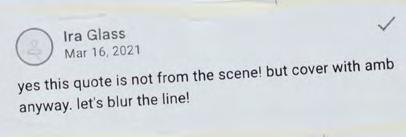
AM: Huh. You couldn’t really tell that from listening. So it’s the same theory as newspaper?
IG: What do you mean?
AM: Well, the assumption for years at newspapers was that people will skim, they’re not reading for pleasure, just information. Now that’s obviously changed, but that was the theory of the pyramid news structure – all the important stuff upfront. The magazine idea was the opposite – lure people in so they’re forced to read to the last paragraph to figure it out.
IG: That’s like our thing, where I feel we’re constantly baiting people forward – both through narrative structure, but then literally saying what we’re going to explain. Reading Roland Barthes in college, his theories of narrative, totally informed how I decided to make radio stories. He talks simply about how having plot creates a question that people want answered. People want to know what’s going to happen next so you can hold their attention. That’s why This American Life starts the way it does.
AM: How important is delivery?

IG: Super-important. Each of us records our voice-tracks, everybody’s now trained to direct, they say go slower, pause here, you’re overselling, you’re not selling enough. For people
who’ve never been on the radio, sometimes for a 12 minute piece, we’ll spend two and half hours in the studio with them. People will read like they’re reading a report in front of a class, when you really want to talk like you talk. You just want to be talking.
Doing It Different
AM: Did you know how to do that right out of the gate?
IG: “Honestly, figuring out how to perform on the radio took me a decade before I did This American Life. I did a local show with two friends for five years just to train myself to sound different from other NPR reporters. Like in my early scripts I would write ‘laugh here’ reminding myself, Oh this line is funny. David Sedaris once saw one of my scripts, he’s like ‘you write laugh in the script?’
AM: Hah. So we’re getting to how you came to create This American Life. You wanted to sound different because you had a different idea of how radio should sound?
IG: Before This American Life there was a kind of story that I liked when I heard it on the radio. I was making some stories like it in my job as a producer for All Things Considered and Morning Edition. There was feeling, with a plot and characters; you just get pulled in. I thought somebody could make a whole
5
show of these. And you wouldn’t narrate it like an NPR host, there wouldn’t be any effort to be the official voice of officialdom.
AM: Did you have a specific idea of the voice you were working towards, or was it just intuitive?
IG: It was completely conscious. And I really struggled over it. In a certain way I still do. I still like to perform my lines, make it sound like I’m really talking. But it’s my least favorite part of the week.
AM: I think of you as having invented a certain kind of intimacy on the radio. Am I giving you too much credit?
IG: No, I agree with that. [He laughs] I invented it in this form. Honestly, there were good performers on the radio – Susan Stamberg, the original host of All Things Considered, is a much better performer than I am. But I guess I invented this particular sound. It was an attempt to sound like the person I really am. But talk my way to bits of tape in a structured story. It doesn’t seem like much of an innovation now, but at the time was really new, like new to the point where we had to talk program directors into picking up the show. Because they felt, “well, is there going to be a real host?” And the use of music was different. Once you start adding scoring like a film, the thing starts to have the feeling of film. It’s partly the way we do music, it’s partly my tone. It took me a long time to get to a point where I thought that it worked.
AM: Did you have it figured out before you pitched This American Life?
IG: When I started the show I had the sound. If you listen to the first episode, it’s there. It’s not clear what we’re going to do is narrative. There’s basically a piece of performance art on it. It was more of a grab bag, but then we were good at narrative, so we just felt like, “oh let’s head
towards that.”
AM: Why do you think you were the one to figure this form out?
1. Fwiw, I really related to this sentiment. It was how I felt about my magazine work before I didn’t. We discussed this. “You must have had his experience as a magazine editor,” said Ira.
“Sometimes you’re putting out an episode or a show or an issue of magazine and it’s not that good. Everything’s very professional. It’s just not that interesting. It takes just as much work to make a thing that’s mediocre as it does to make the good version. And it’s really soul-draining.”
“I felt like that,” I said, “when the difference between good and great was very visible to me, and it would drive me crazy. But then suddenly it wasn’t. I felt, I’m not burning anymore. And as soon as I started to feel that, I knew it could get contagious. I just had to remove myself from the environment.”
“Wow,” he said. It was clear that it was not at all what he felt, though we’d been at it nearly the same amount of time. He was very much still slugging.
IG: I can work for a really long time and I don’t mind. [laughs] Really, it was just that it took so many hours to make this material and I had nothing else interesting to do in my life. And I started working at NPR when I was 19. By the time This American Life went on the air, I was an experienced radio producer, just as a statement of fact, I knew how to do radio inside and out. And there weren’t people with that much experience doing something that wasn’t traditional. I was lucky in that the very first person at NPR who gave me a real job was this guy named Keith Talbot, whose job was to invent new ways to do documentaries. And so from the very beginning, the questions were like how do you make a show, structure a show, think of a format that nobody has ever made? Every show we would remake the format, with different kinds of narration. For a show about people who live on the ocean, we had two guys sitting on a pier. And one of them had an imaginary friend. And he would tell stories about the imaginary friend. I know that sounds terrible but it was great. What I’m doing in a way is so square. But he put me in the frame of, you can really move anything around and create a new aesthetic. I experimented for years. I did little stories with that kind of feeling to them, and then I thought to build it out to a full show. And honestly, I thought it seemed like such an obvious idea. I thought if I don’t get this on air fast, somebody else is going to.
AM: Is what you’re doing square because that’s what you like? Or your ability? Or sensibility? Would you rather it be weirder?
IG: It’s square because I’ve consciously made a product, where we’re saying to you in the first minute, we’re going to give you something really interesting and appealing. I’m going to take you by the hand, and I’m going to tell you why this is interesting. That’s a square choice, a middlebrow choice, that’s an aesthetic choice that for a bunch of reasons, like
6
IRA GLASS
the aesthetics of the stuff I loved as a kid, feels comfortable to me. My cousin Philip Glass, I mean, this is not his thing. This is what he came to destroy. Just immerse, and let people figure it out. He’s proud of me, but his reaction to what I do is ‘that seems boring. Just really old-fashioned.’ There are producers on the staff who very much want to push the show in a different direction. One producer is just like, narrative schmarrative. And that’s fine, if you can make it interesting.
AM: Are you more inclined to experiment than you were at the beginning of the show? Do you find yourself loosening up or tightening as you go along?
IG: When you’re on the air for twenty-five years, you really are just looking for anything that’ll seem fun to do. Anything that’s shiny, you run towards.
7


occupation 23
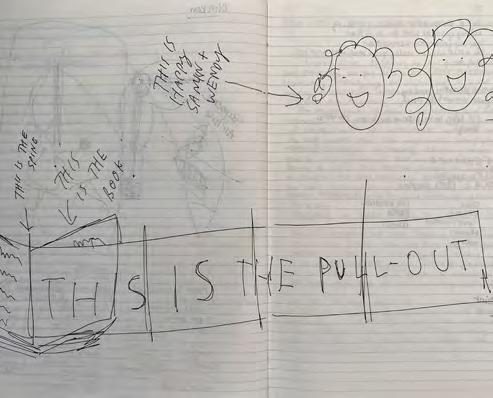
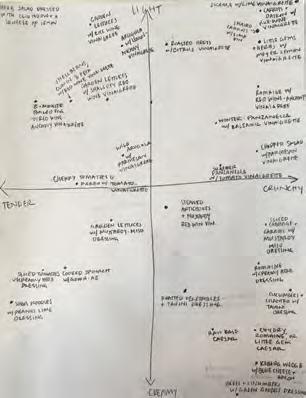
: Chef work : Salt, Fat,
born :
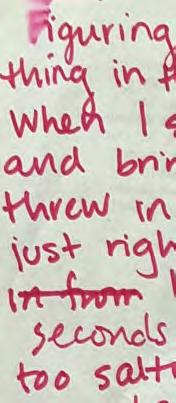
SAMIN NOSRAT CHANGED COOKING in my house and in the houses of many already accomplished cooks. She did it through her bestselling book Salt, Fat, Acid, Heat and the Netflix TV show made from the book, but mainly through the insight and elegance of her original formulation: that all of cooking can be reduced to these four elements. This philosophy she had to train to learn, or more accurately, recognize.

2 SAMIN NOSRAT
Acid, Heat
I had been interested in the way cooking was like and unlike the other creative arts, and also in how an original concept itself can function as a kind of art work. But I hadn’t realized until listening to her that she also might be illuminating in how you write (and sell; not my chief subject here, but I went where she went, and getting your work out in the world absolutely informs the process) a nonfiction book, which required, for her, a very clear breakthrough. There was a long lag time between when Samin agreed to talk and when I could speak with her. I learned later that she had been depressed. Throughout this book 19tk
SAMIN NOSRAT With Beginner’s
Eyes
I have tried to understand the mental states that go hand in hand with creating, so when we did reconnect I asked if she’d be willing to talk about that. She very generously was, and since at this stage so much of her working life requires a public performance – the Netflix show and a podcast, and especially her performative presence on Instagram – the conversation went there as well.
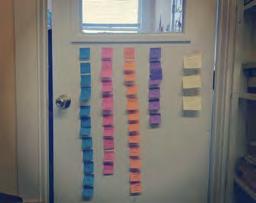
As for the elements which created Salt, Fat, Acid, Heat, there are many --the kitchen training; the doggedness; her intertwined ambitions as a writer and cook. But chiefly was the fact that she was able to envision something new at the exact moment before she would become too experienced to understand it had value. “I had to see it,” she said, “with beginner’s eyes.”
SAMIN NOSRAT:
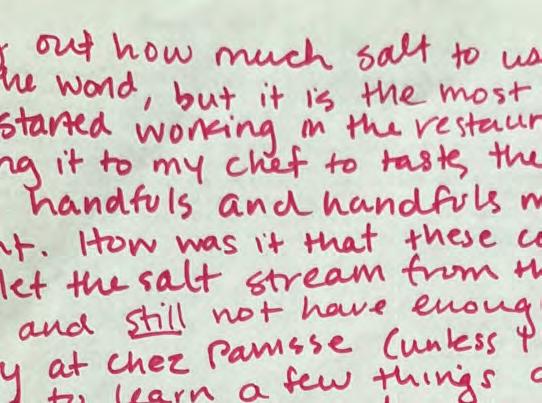
“In August 2000 I started working as a busser at Chez Panisse., and within a few weeks I was enchanted. I should back up. My family is from Iran, my mom cooked mostly Persian food
for us. She was a kind of food hippie, using organic ingredients because they tasted closest to what she remembered in Iran. We lived in San Diego. We’d drive way across town looking for the perfect ingredient. So by the time I landed at Chez Panisse, when I was a senior at Berkeley, this sort of philosophy was not foreign to me. Okay, and the other thing – I was a very overachieving immigrant, or child of immigrants. Being at Chez Panisse was the first time that I was in a little world where every single person was a bananas overachiever. I was looking around this restaurant that had been named the best restaurant in the country I don’t know how many times. There were all these masterful cooks for me to learn from. And not just chefs, do

3
Ex eostinus venestrum dust, aut aut a ad qui tenietus excepta spientem di quas et, volorum nemporum fugitatem venihitate verum senis re cupta doles.
WORKING OUT THE BOOK
Disam res nemodia nis se di dolorro
you know what I mean? Like, cooks. I was a busser. I was a nobody. My first day was the 27th or 28th birthday of the restaurant, it was already older than I was. They’re teaching me how to take out the trash. Turns out, there is a right way to take out the trash.
“It was an incredible sensory education, in taste and smell. And an education in the way you set a table, how the linens should feel. Here you go, your first task is you’re gonna vacuum the dining room. And I remember feeling, I can’t believe they’re letting me vacuum the floor.
“At the same time, I was a student who for my whole life only wanted to write. I wanted to study poetry, thought I would get an MFA or maybe a PhD. But every day I go to work, and it’s magical. So I think maybe I can do this. It wasn’t a coherent thing, just maybe I can try to cook.
“I asked them if I could volunteer in the kitchen and they let me do it one day a week, on top of my bussing. This is a rank well below an intern. I was the cooking intern’s volunteer helper. And I was at the bottom of a very long list of people who wanted to work there for free. I was so in the way and helpless.
“I was not particularly beloved by the chefs in the cafe. But one of the chefs in the restaurant, Chris Lee, took pity on me. I asked if I could ever earn an internship here. He said you don’t know enough. Here’s this stack of books. Pay attention. Go to the tasters. Watch how the cooks talk about tasting. And then come back to me in six months. And he didn’t think I would do it. But I did. Chris offered me up as a driver, going to farmer’s markets and all that. I was going to the Chez Panisse farm, got to know the farmers, the produce.
“And then I started cooking. Another chef there, who wasn’t really interested in me, would assign the cooks to a dish. He would give, as far as I witnessed, very little instruction. But the cooks would get up and do it. I didn’t understand. Nobody used recipes, nobody used cookbooks. One day it was Spanish food, one day Italian. I didn’t know how people knew how
to make every single thing in the whole wide world. And this is all in complete contrast to the thing you, Chris, have told me to do, which is cook directly out of these cookbooks. I had a headache probably for twelve months.
Patterns, Patterns, Patterns “At the tasters, everybody’s giving a sample of their dish. Every single time the same few things happen, we’re tasting the salad, we’re tasting the soup. And it’s, oh this needs a little more salt. Doesn’t this need a squeeze of lemon?
Couldn’t this use more parmesan? Crunch? Olive oil? Over time I started to see patterns. Huh, this is weird. You know?
“Eventually I got to the point where I am allowed near a stove. And once I get there I started to see other patterns. Oh wait , things are brought to a boil and turned down to a simmer. Oh wait , we put a braise in the oven at 475, then we turn it down to 325, the same thing. I’m thinking, huh, interesting. And then I go home and examine these recipes and I’m like oh: pattern, pattern, pattern. So one day, after an year and a half of this I go to Chris-and I remember where I was standing in the kitchen, at the end of the big prep table, right by the sink – and I say, I think I see a pattern. He says, what? I say, well it’s not in any of the books but I see a pattern: salt, fat, acid, heat. That’s what everything we cook comes down to – salt, fat, acid, heat. And he said yeah, everybody knows that.
“I said, everybody does not know that! It’s not in any of the books you gave me. He said, no, but all good cooks know that. I said, you know that because you’ve been doing this your whole life. He was like, whatever.
“I said no, I’m gonna write a book about this. And it’s going to be so easy. And short. And simple. I found a journal entry where I wrote, ‘I’m gonna write a book about this.’ I thought it’s gonna be twelve pages long, three pages for each thing. And I got a legal pad and started writing. And then pretty quickly I realized I actually have to learn how to cook to write this book. Everybody told me, you
4 SAMIN NOSRAT
don’t know anything until you’ve been cooking for ten years.
“But then because I had this framework into which I could file everything I learned, I filed it into all these folders. I went to Italy. And in Italy I helped a woman teach cooking classes and so I could sort of test my thesis. From the minute you enter a kitchen, you might be the person who knows nothing. But then twenty minutes later someone who knows even less than you comes along, and you have to show them how to peel an onion. So very quickly you have to develop a skill and a vocabulary for teaching people things.
“I came back from Italy, Chris had left Chez Panisse to open his own restaurant. So I went there to work for him, first as a line cook and then eventually like a sous-chef. And then I really was teaching young cooks things. I was teaching them how to make a vinagarette, and that’s a balance of salt and fat and acid, what is buttermilk doing in roast chicken. I really did have to create a vocabulary to help me explain. I never let go of salt, fat, acid – it was always inside of me. But I have to say, I was not always happiest in a restaurant. I still wanted to be a writer.
“At this point I was pretty much running the restaurant kitchen. I looked at the restaurant reservations books every night, I saw that Michael Pollan [fn1] was coming in. And I was a huge fan of his, I’d read all his books. And so I wrote a note to him after. I said oh it was so nice to see you in the restaurant, I’ve been thinking of writing to you to see if I could audit your class --he was teaching a class at
Berkeley called Following the Food Chain –food journalism.[fn2]
“After the class I applied for a Fulbright. I didn’t get it. Michael said, you don’t need a Fulbright, just start writing. And I started writing for the Chronicle. I didn’t even know what a story was. I’m gonna write about beans. Actually I still say I’m gonna write about beans.

“A year or two after I took Michael’s class, Michael was set to write a cooking book. And I know how he works. If he’s going to write a book about cooking, he’s going to need a cooking teacher. And I wrote him an email saying, I’m your cooking teacher. We cooked every Sunday for a while. We would make food, and they would invite all their friends. And I remember one day he wanted to do a pig roast. So we drove up to get the pig. On the trip I told him I’ve been putting this pressure on myself to come up with an idea of a book to write that would be groundbreaking. He said, write the book you already know. I said, I guess the book should just be this philosophy that I have: salt, oil, acid, heat. He said, no one’s ever said that before. It’s a goldmine.
“And I knew it was going to be hard because since that first moment years before when I imagined this project, I had come to understand so much about cookbooks. I’d actually worked on two cookbooks that had never happened – one with the woman in Italy I was working with, another with a friend who was writing a pickle book that just kind of imploded. The whole world of publishing made me feel so young and dumb.
5
Disam res nemodia nis se di dolorro
Simple Is Hard “But I thought a way to actually start would be to teach classes and write handouts for the classes. After all, I’d been teaching Michael. So I start teaching salt, fat, acid, heat classes And during this time I’m seeing the questions people have – oh, you need a diagram, here let me draw you a diagram. And here’s a list of emulsions. Here’s a pictogram. All on butcher paper, these jankadoodle handouts.
Then I also realized that as much as I wanted to instill the philosophy in them, they’re still going to need a recipe. So that was a good thing for me to see too.
“And then Michael wrote Cooked, and his agent – this was Binky Urban, a really powerful agent – read the part of the draft which described me, and she said, oh wow, what a charismatic character. Does she have any book ideas? And he said, well yes actually, she has an idea. And so I told her and she said, yes this is a good idea but it’s too complicated, you have to simplify it. And I had no idea how to do that. I looked at the pages, the handouts – there were a mess. To make something simple is really hard.

“This was the problem: salt and fat and
acid are tangible materials. And heat is not. Salt comes in for the most part as a mineral. Fat and acid don’t. How do I make any of this parallel? I tried many different ways. I brought it out to other agents in the meantime who told me I wasn’t qualified to write this book because I was not already a famous chef. There were agents who told me this book would never sell because all cookbooks need to have eight chapters. And this book will never sell because it doesn’t have photos. Strangely it never occurred to me that anyone thought I wouldn’t be qualified because I was a brown girl trying to write a general cookbook but I’m sure that crossed some minds.
“I was very confused. I am a sponge and obsessive and I had paid a lot of attention to what cookbooks get published, which ones work and which don’t, which ones I liked and didn’t. It took me about six months to distill and clarify my thinking until I could write a proposal. And in the meantime I had been stalking Wendy MacNaughton, who had been contributing to Edible San Francisco, because oh my gosh, she’s funny she can convey stuff – I mean, here I am drawing these horrible butcher paper charts. I was just seeing what
6
this book could look like. At the time Wendy was making all these Venn diagrams and they were so good. So I wrote her an insane email with a Venn diagram of all the people we knew in common.
I wrote -’ You might be wondering if I’m stalking you. Well, the answer is yes. I’m obsessed with your work – obsessed, and I have a secret dream about to be not so secret that we can collaborate and that you’ll illustrate the cookbook, let’s call it better than a cookbooks, that I’m starting to work with. I love your work, you are the Maira Kalman of my generation.’ Blah, blah, blah.’ Wendy came aboard. We made like a 40-page illustrated Salt Fat Acid Heat proposal.
I had to show publishers what I had in mind. Because it was so radically different than anything that existed. I didn’t want a recipe-filled cookbook. I wanted a book that teaches you to cook. I didn’t want photos, I wanted illustrations -- weird funny things that were whimsical and silly.


“And it worked. There was a 15 way auction and it went bananas. And we sent it on a Thursday and on Friday or Saturday the agent [fn3] said, you need to get on a plane and be here Monday. And so I did. I went to meetings,

and it was so exciting, nothing like this had ever happened to me in my whole life. I’ve never walked into a room before, ever, where everybody knew how to pronounce my name. All these old white people knew how to pronounce my name. And it didn’t hit me until afterward that like oh my God, that means that they asked how to pronounce my name, so they could pronounce it correctly. Never, in my whole life. And then I sold the book.
“But you know, for the proposal I hadn’t solved the structure, I sort of just got to something. It was good enough. I got through the high of like Woo, oh wow, oh wow. And then there was the inevitable low.
A Knife to the Heart “I had to start writing. I wrote an almost entire first draft of the book, and it was not good. I wrote it like two and half times. And I couldn’t get there. There was one moment – I was supposed to have a phone call with the editor one morning. I was so desperate and sad – at my wit’s end, I just didn’t know what to do. The draft I had sent her, she had started on page one, her comments were perfectly nice. And they’d gotten increasingly frustrated as she went on. By page 60, her comment was like, I don’t know what
7
Dit etum que nosamusam res nemodia nis se di dolorro
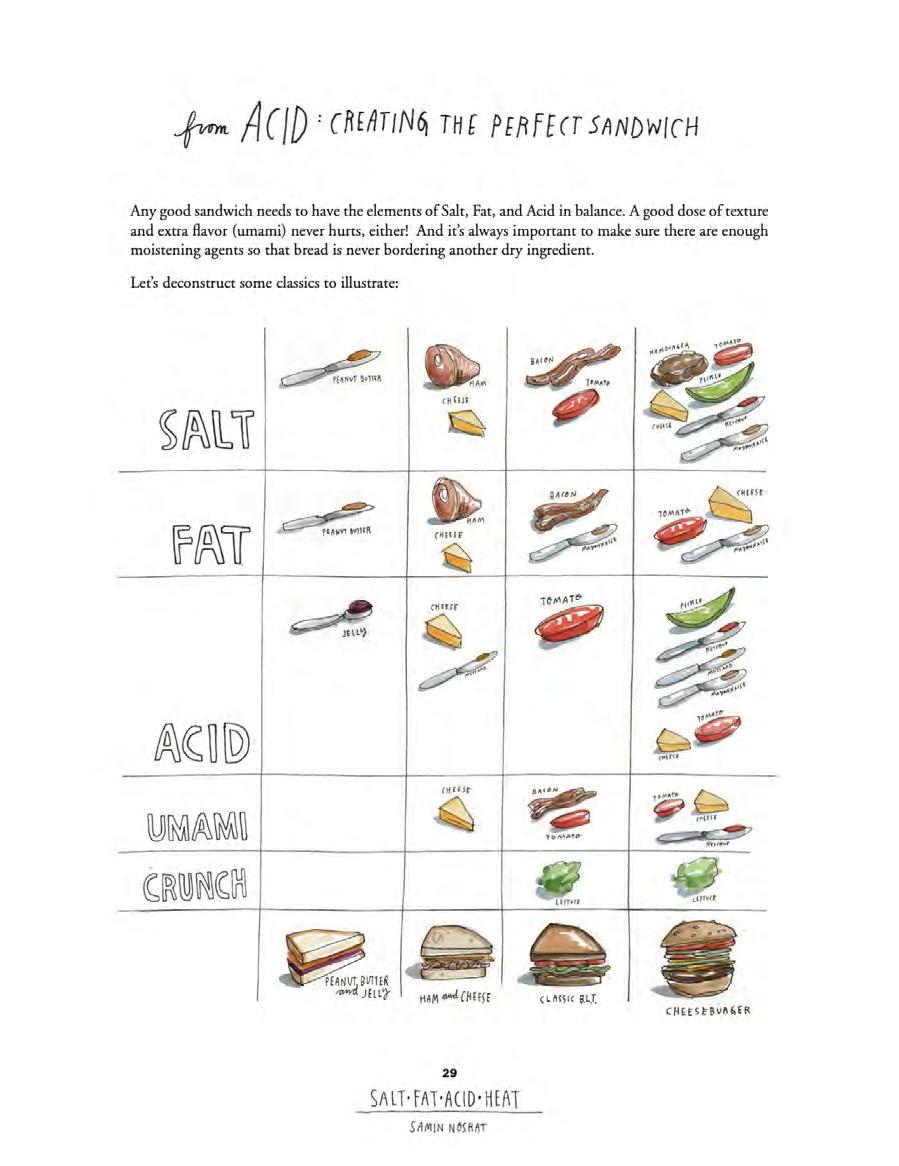
8 SAMIN NOSRAT
you expect; I can’t write this book for you.
“And it was like a knife to my heart. As the hard-working child of immigrants, I would never, you know what I mean. You think I’m not working hard enough? I’m trying! So this call was like a 911 call. I fell asleep the night before and I was losing my mind. I woke up, we had a call at maybe 10 am, and it was Wednesday and the Times food section had just come out. And Sam Sifton [fn4] had written this piece about burgers. What are you going to say about burgers? There’s a new way to cook a burger? For whatever reason, I’m in bed reading the article. Trying to will myself to get out of bed and brush my teeth so I can talk to my editor. And something about it, maybe the way the article was formatted, something jumped out, something like blah blah blah... flavor and science . Blah blah blah, flavor and science . I brush my teeth, and I’m thinking duh duh duh flavor and science . Flavor and science. And then, oh my god, flavor and science!
Eureka “Science and flavor! That’s what’s all these four elements have in common. The science of salt, the flavor of salt. The science of fat, the flavor of fat! Oh my god! And 45 minutes later I’m on the phone. Dang, I found it! Let’s just say the editor was relieved.
“And that was it. Of course I had to master the science and I’m not even particularly good at chemistry. But at least I was curious. Eventually when it was time for blurbs I asked Harold McGee [fn5] for a blurb, and he wrote back and said in the nicest possible way, under no circumstances could I blurb this book because there are so many mistakes. Here is just a partial list. Twenty-four mistakes. And I had a humongous panic. He said, you need to have this book factchecked in order for it not to be a
joke. A fact-checker did catch a bunch of stuff.
“By the time the book was about to come out it was a really long journey. I remember going to therapy and I said, I need help. Because I have let my opinion of myself and my happiness ride on what other people think of me, and if I do that with this, I am going to die. My therapist said, you need to come up with your own definition of success and adhere to that. What would that look like? And I said, it would look like giving everything I had to this book.
“The day it came out, there were mistakes. They were super basic and it was embarrassing. I got something about osmosis wrong. But you know what? I’m still alive. I survived.
“I’m a person who gets depressed, and I am incredibly depressed right now. I spent a lot of last year depressed and didn’t get much done. For the first time I’m entering a phase where I am depressed and having to work. In the past in my life I’ve always just ignored my feelings, shut down and worked. That’s very much a cook’s mentality – if you cut yourself or burn yourself it doesn’t matter, you have to get this plate of food made. But now I’m trying to pay a little more attention. Like, I don’t know if it matters or not that I didn’t produce pages last year. Maybe, maybe not.
2.
3.
“I still have to show up in the world, and I still play by those rules – maybe one day I will say fuck em all. But right now it’s a box that I’m stuck in. My Instagram account is the metaphor for it. Sometimes I feel like I’m not gonna play along anymore. And other times it’s, I can’t, I make money this way, I feel the financial pressure. Sometimes I feel I would have twice as many followers if I learned to play the game better. Other times, I don’t know. I truly wish that I could just check out most of the time right now.
“But you know, I’m back to work. It’s fine, I’ll get through it. I also feel a little bit of creative magic. The nice thing is I have a road map. I’ve done it once now and I know the torture is part of it. So like, a little torture? I guess I’m doing it right.”
9
1. Michael Pollan is a best-selling and very influential writer on food and plants, mostly. Some of my favorite pieces from my tenure at the New York Times Magazine were written by him.
Michael’s class had a huge waiting list. To get in, Samin had to persuade him he needed someone who’d worked in the food industry. She’s very persistent.
Samin ended up staying with Amanda “Binky” Urban’s agency but was represented by Kari tk.
4. Sam Sifton was the food editor at the New York Times. At this writing he has a job similar to one I had at the Times, overseeing the so-called feature parts of the paper.
5. Harold McGee is a noted writer on food science.
24 GRADY WEST Alter-Ego
I’M AFRAID THIS ONE might sit in the you’ve-gotto-be-there zone, but I’ll give it a go. Dina Martina is technically a drag show, but not in any way you might think you know. She is a character created by a man named Grady West, who plays her in Seattle, on tour in all the places likely to understand her, and in residence summers in Provincetown, where she is the reigning act, halfway between arthouse and madhouse. Grady calls her (or him, for he is talking about himself) a clown, which is true as far as it goes, but a clown more like Buster Keaton than Bozo, dada on two hairy legs. The Stranger, a paper in Seattle, described her like this: “The primary fact that one must understand about Dina Martina – beyond her stature as a superstar entertainer without peer – is that she is in possession of not one shred of discernible talent or grace. Her voice sounds like a cat having an epileptic fit on a chalkboard, her body moves like two pigs fighting their way out of a sleeping bag, and her face looks like the collision of a Maybelline truck with a Shoney’s buffet.” Dina Martina is a cult figure, revered within ironist circles. “Performance art never looked so good,” said Whoopi Goldberg; John Waters described her as “going beyond drag into some new kind of twisted art.”
The central conceit is that Dina is 100% blind to her absurdity. She speaks in an invented dialect, exchanging hard and soft g’s, twisting idioms, parading around in her own counter-world, performing a lounge act. She sings, excruciatingly; appears in crudely constructed videos; and tells stories of her life – about growing up in Vegas and her daughter Phoebe, played by a puppet, and her best friend Doreen, heir to the Kotex fortune. It’s definitely hit and miss, but you don’t mind the misses because the bizarro universe Grady has created has no cracks. While feeling spontaneous, it is a wildly disciplined act, deceptively so.
Grady plays her all summer, brings her to New York, London, Toronto; does a huge Christmas spectacular in Seattle; and is now trying to get Dina on television, which I suspect might work because she is already a beautifully
2 GRADY WEST
occupation : Tktktkt
work : Dina Martina born : 19tk

3
Blabor anti dolut rerum de andel ste voluptio blabor anlis.
articulated character; also, she wears well, because, for all her obtuseness, she is kind.
I haven’t focused on performers in this book, but I did wonder what it was like to invent an alter ego as your life’s work, and then, for much of the time, live it. Grady rarely breaks character and never talks about Dina, so I was surprised he agreed to talk to me about her, but I think he was himself interested in thinking about how Dina came into the world. And the surprise here to me (though I am now beginning to notice that this happens a lot) is how full-blown she was in her first imaginings. She is really a fairly direct expression of the person Grady was as a child and a sense of humor that seemed to birth Dina as its gremlin child. She was conceived in a moment when ironic burlesque was flourishing, in many respects a reaction to AIDS. Timing, it seems clear from these conversations, matters a lot. I found myself particularly interested in how the show moved from blurted improv to a constructed performance. Also, in what is happening in Grady’s mind as he performs her. Playing Dina is like a very functional dissociation.
We spoke in Provincetown and later in New York, when it was nearly time for his summer show, which he had written none of.
Non-Sequitur, Very Bizarre
AM: Where does Dina begin? Did you have an unusual childhood?
DM: Well let’s see. Both my parents were married and divorced five times each. And my mom was an alcoholic. But I never knew she had a problem because she was never abusive. I’m sure by today’s standards, people would beg to differ but I was the one being abused, so I can say that. It was a happy childhood.
AM: Were you a funny kid?
DM: I always tried to be funny. And my mom would usually hang out with her two best friends, Rose and Pat. When they got together they would drink and do weird voices and you know, crack each other up. So I would do my damndest to get them to laugh. It usually worked; they were lubricated.
AM: And you mentioned to me before that you had some actorly ambitions.
DM: Well the first thing I wanted to be was a fireman, because of the cool trucks and the outfits. But then yes, I fancied becoming an actor. The school play was via the choir because it was usually a musical. So my senior year in high school I was in the choir, which is the weirdest thing ever. Because I – to no surprise to anyone, I can’t sing.
AM: What show did they do?
DM: It was an “original” musical, which meant that the choir teacher took every Broadway hit from the last forty years and glued them together. I had one of the meatiest parts. But it was awful. I was awful.
AM: Did you know you were bad?
DM: They videotaped it and showed it to us the next day in class. And everyone but me was going, “There I am. There you are Mary. There you are Ted.” And I’m just sitting there alone, seeing me suck and just shrinking, smaller and smaller. My dream of becoming an actor died at that moment. I thought, what am I gonna do now? I’m not going to be an actor.
AM: What was your humor like?
DM: Non sequitur, very bizarre. I remember doing a skit with my sister-- there was some commercial for a detergent or something called Swan’s Down. And for some reason I tied it into a burglary where someone’s going to say “hands up” but instead they say “hands down.” It made sense to me, but my sister just said “what?” I said, “just say it!” So she did. And my dad and our grandparents, who were the audience, just sat there, waiting for the punchline. And I said, “There it is!”
AM: So the basic Dina ingredients were baked in.
DM: I guess so.
“Dina” Just Happens
DM: I graduated high school, worked at a restaurant, they hired a lot of creative people there. And a guy I knew a little who’d worked there before asked some of us if we wanted to perform at this thing he was putting together. He had been commissioned to
4 GRADY WEST
put on a show on Saturday afternoons ---- no cover, no door person, just word of mouth. He wanted to bridge the gap between the Seattle Arts Museum and the Lusty Lady, an erotic dance place next door. So he wanted “a tawdry lounge act peep show”. That’s what he was looking for. I thought, I’ll do a bad lounge act. And hopefully it’ll be funny. Really low stakes. It was in the afternoon. What can it hurt?
AM: And you just went on stage as Dina? Just like that?
DM: Yeah. I just thought of myself as a woman, sort of a wallflower. I didn’t sit up all night dreaming it up. I mean, malapropism and wordplay is something I’ve always loved, so that went into the character without me really thinking about it. Dina’s first hair was a $10 Halloween closeout Morticia Adams wig I found at Hallmark. I just smeared lipstick around my mouth.
AM: Was she called Dina from the very first moment?
DM: Yes.
AM: Any particular reason?
DM: Not really. People think that because she grew up in Las Vegas, that it’s a play on Dean Martin, but it’s actually not that at all. When I came off stage the first time at the peep show, all the other performers were saying “Oh my god that was really funny, that was amazing, that was great.” And I said, “what did I say my name was?” Cause I think I knew I wanted it to be Dina, so I guess I just rhymed it. A friend said “I think you said Dina Martina or something like that.”
AM: How would you describe her personality at that first performance?
DM: Demure. There was a weird self-confidence. And most pervasive, a complete lack of self-awareness. Lack of objectivity about her ill-fitting clothes, rats nest hair.
AM: And you hadn’t planned out any of that out at all?
DM: No. It was very spontaneous. From that first day Dina had this faux continental accent, where she mixed up the hard gs and the soft gs. It developed over the years, but I
just started doing that at the beginning, realized that certain words are fun if I do a soft G as opposed to a hard.
AM: Did you have any idea what you were going to say?
DM: Probably but I didn’t write anything down. Since the early 80s I’d collected elevator music, Muzak-y stuff. So that’s what I sang to. One of the first songs I sang was from the Golden Gate strings performing the Monkees songbook. I sang the Monkees theme. I said, you know, something like “I’m Dina Martina, and people say I monkey around.”
AM: It seems extraordinary to me that this character that has been your life’s work just came to you like that.
DM: It’s dumb luck.
AM: Well I wouldn’t say luck entirely. A lot of your life set you up for that moment.
DM: Well it may not be dumb luck but it was a lot of luck
AM: Since the frame your friend described was a lounge act bridging those worlds, which kind of defines Dina right there, what were the other acts?
DM: Well, one guy [a man named Tom Ackerman, who we both know] came out and vacuumed the stage to German opera. Another guy who is no longer around put a gunny sack over his head but had his face painted on his stomach. And there was this beautiful guy I later dated who is also sadly dead now, who did a reverse striptease, started with a G-string, did stupid poses and then put on his clothes.
AM: All of these acts were in the same spirit as Dina. But none of your fellow performers went out and made a career out of it. You did. Why do you think that was?
DM: I think it was because I wouldn’t go away.
AM: Was there a sense that Dina was a response to how devastated you were in high school watching yourself act? Were you at all determined to create art out of the worst possible version of yourself?
DM: That’s giving me too much credit. I’m not an ambitious person.
Gestation Ambition takes different forms.
5
Over time, Grady developed the act. He was invited to perform Dina at cabarets around Seattle. “Two years after the peep show someone asked me to go on, and then I find out it’s a drag cabaret. Everybody but me is in traditional drag, doing lip synch, looking flawless. And they said, “Oh- what’s she doing there? I said, ‘Hi. I’m in the show too.’ The more I got into Dina, I could just feel their assholes tightening. They thought I was making fun of drag. Some southern queens pinpointed it immediately. They said – ‘oh, you’re a booger queen.’ Because that’s what they call deliberately messy drag.”
So he understood himself as part of a tradition, but his absurdist inversion of that tradition – entirely ad hoc, unthought-through – was his own invention. He was invited to another cabaret – “the only thing I remember was I had a really good pickle display –I’m a connoisseur and this was the best pickle display ever. I thought I’ll do my interpretive dance to Music Box Dancer with a tutu on the pickle, and I’ll dance with it. I now know how necessary it is to know what the audience wants to see. That night it was all women wanting to see women comedians. When I went onstage it was noth-ing. Tumbleweeds and crickets. I threw away a third of what I planned to do. I forgot about he pickle, who was offstage.” But bombing didn’t defeat him. “I loved doing it so much. And it makes you a better performer.”
He started performing Dina on his own, and tinkered with the act. “Over time I thought I just needed to squeegee some of the dead air out of the show. Her personality meshed really good with dead air, but I also realized I needed to pick up the pace a bit. You know, when you play venues where people are so drunk, you have to start barreling through, not give them any room.” Grady gave Dina a backstory, a daughter named Pho-ebbie. “She appeared in the first Christmas show I did. I was out thrifting and I found this rag doll that was this big. And I thought, this is weird. Funny. Borderline creepy. Maybe Dina could adopt this kid. And I put her in, suspended from a string on
a pulley.” The first full-length Dina show was in 93. “And at that point I was like, okay I’m gonna play up the Vegas angle of Dina’s history. I had never been to Vegas. I thought I should have video segments of Dina in Vegas. And I got a couple of good segments out of that. Anyway I was freaking out, people were pouring in, there were lines outside and I was there with my index cards, and I was like “I don’t know what I doing!” And Dan Savage [who would become the popular sex columnist] was running tech , he said, Calm down. I said, No, we’ll make it free. And that way they can’t really complain, can they? And Dan said, No, we’re still going to charge. Figure it out. He told everybody: Nobody talk to Grady for the next fifteen minutes. And in those fifteen minutes I figured it out.”
Turning Pro
DM: It took me probably until the early 2000s before I actually got it through my head that maybe I could do this for a living. But it was still a sideline until I started performing in Provincetown in 2005.
AM: When did you start touring?
DM: Same year as Provincetown. I basically got enough exposure that I was able to book in New York, and eventually London and LA.
AM: Was it intimidating, when the show kept escalating?
DM: There were several points when I’d just freak out, thinking oh my god, this is the time everybody is going to realize I have no talent. But the remedy is remembering Grady, they’re not coming to judge you. They’re just coming to have a good time. They’re already on your side.
AM: At this point, how do you go about putting together the show?
DM: Over time I started scripting it. And I am basically not an eleventh hour producer, more like a twelfth hour producer. I go to my computer and think Oh God, I have a show. Tickets have been sold, it opens tomorrow. And I haven’t written it yet! And I go through my hundreds of pages of ideas, and I just glue
6
GRADY WEST
things together from that. But the format of the show doesn’t have to have a story arc or redemption at the end, or conflict. So I just do whatever feels good. I don’t analyze. Opening night is my dress rehearsal. To the point where I have bought outfits and never tried them on, and during a video segment I’m changing my outfit and realize oh shit, I can’t fit into this. One time the dress was so much smaller than I was that I unzipped it, put my arms through the sleeves and just had it in front of me when I went onstage. Over the course of a run I add little bits here and there.
AM: How much are you improvising on a usual night on stage?
DM: Well, not much. Because it’s 55 minutes, not a minute longer. But sometimes. Earlier this year because the show is outside for Covid, there was this huge like V-formation of birds. And I was doing the monologue and thinking, “should I say something?” And I just stopped and said “Oh look at the birds.” I got a big laugh. So that’s kind of what you live for.
The Mind in Two Places At Once
AM: When you’re onstage you’re talking and thinking at the same time.
DM: Yes, It’s a weird thing because you really have to not let yourself get run away with the conversation in your head because you’ll lose
THE NOTEBOOKS
Dina Martina is as close to a direct-from-the-brain expression of the way her creator just looks at things as any ‘work’. But there is a step in between. As Grady’s wandering around, he jots stray thoughts in his notebook. Some make it into his act, some don’t. They aren’t exactly jokes, but they offer a pretty clear biopsy of Grady’s broken worldview. Here are some excerpts:
Letter to Santa, Letter to Jesus.
These ended up in a Christmas show, as video segments. The video opens with Dina writing Santa, Dear Santa, how are you blah blah blah, what’s going on? The letter to Jesus opens with Dear Jesus, how are you. I’m fine. Do you have Santa Claus’s address? I sent him a letter, but it keeps coming back. He must have moved off of 34th Street.
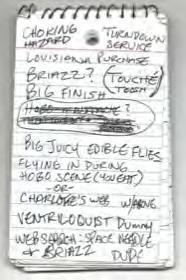

Choking Hazard & Big Juicy Edible Flies
Choking Hazard. Dina would occasionally talk about the Bible and just say it was choking hazard. And that it’s makes a wonderful coaster. I know none of these jokes make any sense. I just think of things, you know there’s got to be a joke in there somewhere.
Big
Juicy Edible Flies
Oh, that’s one I never used but I love the idea. You know, like those big bumblebees, only flies. And Dina and Doreen just kind of pick them up, and say they’re like raisins with wings-- or prunes with wings. I don’t know. A lot of my ideas aren’t worth developing. I guess I remember it was hot summer day when I wrote that. And you’d see a fly, and think where the hell did that come from? It should be in the Guinness Book World records or something. There’s a lot of liquid in there.
25 Husky
That’s so sad. When I was 13 they measured my size. And it wasn’t just my waist. They had to add the word Husky! I was just like, I want to go home. But I think it’s
7
Writing in the Dark
WESLEY MORRIS IS A CRITIC AT LARGE at the New York Times, which basically means he is free to criticize, or riff on exuberantly, which is a closer description of his form, anything: movies and television and music and also racial identity and hairdos and sweat (see below). He can do the conventional thing, but he’s also a wild innovator. He co-hosts a successful podcast; once wrote a pretty unhinged blog on sports and fashion; is writing a book of historical scholarship; is constantly looking at new filters for his commentary (one I liked especially was called The Box --for Office--, which looked back at movies through the lens of their mass appeal in a given period, giving him an opportunity to offer an episodic history of popularity).
Wesley is one of my favorite critics, now or anytime. I tried to hire him at New York when he was working at a now defunct site called Grantland. Hiring critics was always one of the more interesting aspects of my editor job, because I found myself invested in finding ways to move criticism, which I had revered back in the days when critics seemed to matter (beginning for me when I was reading Dwight McDonald and enthralled with Mary McCarthy), into a place where they might be culturally relevant again. I’m not sure I ever got there. Still, I was enamored of critics who could really write, and who used the “review” as a vehicle to help readers think more expansively, less about the cultural object at hand than its context. I particularly loved reading Wesley, who always startled me with his range and a prose style that often read like scat singing.
We met at his apartment in Brooklyn. It was strewn with books and paper piles and toppling DVDs (Wesley told me many of them were blaxploitation moves that couldn’t be streamed). He’s a smallish, garrulous and muscly guy with a now famous mustache, which we’ll get to in a moment. He made me some delicious biscuit strawberry shortcake. He is constantly interrupting himself mid-thought; you can feel the electricity of his mind in his
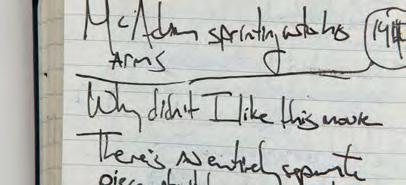
2 WESLEY MORRIS
occupation : Critic work : The Notebooks born : 1975 25
Voluptus
etur sum que plaut ducimagnam faccabo.
WESLEY MORRIS
speech, which sometimes seems as though it will short-circuit. Before we talked criticism we talked about the book he was writing, or not writing. The book was, he said, “about the performance of blackness – how much control do black people have over their own image. How much control do I, as a black person, have over mine?” The book was all about the ways black people play out scenarios that have been created for them by (white) cultural puppeteers, but he was wary of being the person “that’s always telling you that this shit is rigged. That person usually gets drummed out of blacktown for it.”
That’s the way he talks; also somewhat, the way he writes.
He was, more or less, willing to be drummed out; he’d made a career out of going his own way, though he was sometimes ambivalent about it. Figuring out where he fits in has been the overriding concern of Wesley’s life in many contexts, as a black man, a gay man, and a critic. Our conversation was about how he became the original critic he became, but it all tumbles together. Influence is such a recurring theme in these pages: His path is mostly one of acquiring influences, inhaling them, integrating and then discarding them (which is the recurring pattern as well, as it happens).
What Is a Critic? He was drawn to criticism while at a boarding school in Philadelphia. He was in eighth grade. “I didn’t know what criticism was until a teacher told me that that was what I was doing,” he said. “We were supposed to watch a Hallmark movie called April Morning. So I read the book and watched the movie and just reviewed what the experience was like going from one thing to another. And [the teacher] said ‘This is not what I asked you to do.’ But, ‘you know, this is a job; people do it for a living. It’s called movie criticism.’ So I started reviewing movies for the school paper. Honestly, if the assignment had been to listen to some music and the teacher said ‘you know there’s a thing called rock criticism, you should do that for a living,’
it might have been that.”
He went to Yale in tk, wrote movie criticism there, found his way to a job at the San Francisco Chronicle in tk, and then eventually to the Boston Globe tk years later. All the while he was reading what his fellow critics were doing and became both enamored of the critical wars raging around him and also whipsawed. Critical strategies were innovating and competing, and he found himself attracted and then repelled by almost all of them, in every genre.
“Rock critics made claims, he said. “Like this is the best or worst of the summer. Movie people didn’t do that much. There was not a lot of flag planting. Well, Andrew Sarris” – who was promoting a polarizing “auteur” theory of movie-making --“was always planting flags. And Pauline Kael was trying to pull up the flags he’d planted. Then he’d do the same to her.”
Kael’s work was emotional, rooted in her gut more than her head; Wesley responded to that. “I knew that I wanted to try to find a way to synthesize what I was reading, including Kael, who I spent a lot of time reading. I wanted to know how you wrote 7000 words, or whatever, on Shampoo. I mean, it’s a great movie. But I had never been given the space to, as a professional critic, even write 1000 words.”
“And then there was the Hoberman era at the Voice, right?” Wesley said. J Hoberman and his disciples were speaking in the more semiotic language of music criticism -thicker, more cerebral --and he was responding to that too. “The way they thought about movies and the coded way that they would express things-- you would have to interpret what they were saying. There was a lot of language turned in on itself. I found that very attractive.”
Wesley started to write like that. His editor at the San Francisco Chronicle said ‘This isn’t Film Comment .’ “ She was referring to the house organ of this sort of criticism, and it was a swipe at his trying to write in a voice that
3
was more showy in its intelligence, often pretentious, and for a more specialized audience.
The Chronicle was a plain-spoken paper, and it was grueling. So mostly he found himself just trying to grind it out. “I can remember where I physically was sitting and the pressure I was under to finish it. Because at that point I was writing five reviews a week. And I was a procrastinator so I would be writing five reviews in 36 hours. And because I was in a second-tier market, everybody else in NY and LA would review a thing before I’d be able to see it.” Meanwhile, criticism was changing again. Suddenly Anthony Lane, who was a dazzling stylist and very funny, had been hired into Pauline Kael’s old gig at the New Yorker, alternating with the more erudite David Denby and setting up another feud of approaches to criticism. “The worst days were like when Anthony Lane had already written and delivered into the world a thing that I was sitting at my computer struggling to write.”
“I was America’s shittiest Anthony Lane adversary. I really wanted to figure out how he wrote such polished, informed pieces. The acuity, the humor, the concision. People dismissed him for being a jester. But then I became a Denby person, because he wasn’t as flashy. There was something to argue with. I never felt Anthony Lane cared what we felt when we read it. I never wanted to write like Denby but I respected his rigor. The thing about Hoberman was that he was really serious, looking at political valences. Everything was a politics to him.” But unlike these other critics, Wesley wasn’t really a movie nerd. “I was never obsessed. I never had a passion for this. I can go a week without watching a movie. I was more interested in being out in the world. If I was going to bring myself into the work it was going to be to bring the life that I was living into the movies I was watching.”
Intimacy as Criticism. “I was having a lot of sex.” he said, of the life he was living at the time.”I was meeting strangers, putting myself at risk to have a good time. I spent a lot of time
by myself. And I’m a black person doing that in a city where there weren’t many black people. It kind of made the act of writing about movies personal even when I wasn’t necessarily writing about myself. I was invested in the experience of intimacy between me and the thing.”
Intimacy became his mark. That meant abandoning the authority of the all-knowing and embracing – reveling in -- criticism’s inherent subjectivity. Few critics really do that; it’s difficult to give up the premise that you know better.
He moved to the Boston Globe, and began to experiment.“I loved the freedom that I felt to be mad. And to love things. I tried to write a review based on ad copy. I tried to use profanity. I experimented with bringing myself into it. ” His prose became less and less restrained.
Synthesizing Influences. “I tried to figure out a way to do what Anthony Lane did, but sincerely. To understand that there was a politics to everything, as Hoberman did. And try to still, with respect to Jim [Hoberman], have fun with it, and not let it ruin the experience of watching the thing. It was okay to like it. And you never got a sense with the boy critics that it was okay to enjoy any of this. The thrill was the intellect. I felt like I was on my own little island and never belonged anywhere.”
“I was getting there, he said. “I didn’t have to respect anybody. I just had to follow my feelings. And I was no longer reading other people to figure out how to do it. I can’t stress to you enough how often I was reading Elvis Mitchell and AO Scott and Manola Dargis [three Times critics, the latter two of which are still are his colleagues] before I could start to write what I was writing. And then at some point in Boston I stopped caring. I distinctly remember thinking, this is what I’ve been trying to do the whole time. This is what I’ve been trying to do!” In 19tk he won his first Pulitzer Prize.
Lint. But it’s not as if the recognition sated
4
MORRIS
WESLEY
him. He was still wandering creatively. He’d had a conversation with a friend after watching a tennis match. “We were talking about how excellent Dulko’s dress was and how bad Sharapova’s was. And I thought someone should write about what athletes are wearing. So I just started to. He began a blog on the side called XX. He wrote his first entry after watching Andy Roddick and Roger Federer’s tennis final in 19tk. “I wrote about that because Roddick was so sweaty. And Federer was dry, couldn’t have been dryer.” It turns out anything at all could be a prism for his writing Another entry was occasioned by staring at the lint in disgraced athlete Michael Vick’s hair in an interview with Bob Woodruff. “They left that shit there the entire conversation. And I just thought that was the biggest fuck you ever.”
Eventually he got called by Grantland, which was sort of a sports site and sort of an anything-goes site. Bill Simmons, the sports columnist who was its editor, had liked Wesley’s increasing turn to the odd. He told Wesley he could write whatever he wanted at whatever length. Wesley was sold. That’s where I first saw his work and tried to recruit him, but he wasn’t going anywhere. He loved the job.
Eventually the Times called, said he could have that same freedom as a critic at large but within an establishment institution. That invitation proved irresistible. He’s been there since 20tk.
His Self. In tk year, he wrote a bizarre and beautiful essay called My Mustache, My Self that showed Wesley in all his plumage. It appears to be a personal essay about growing a Covid mustache that then reveals itself as a cultural exploration of the character Carlton from the television show Fresh Prince of Beverly Hills and which ultimately turns out to be a very sophisticated piece about Black identity and masculinity (in a way it’s a companion story to one he’d written also for the Times Magazine, about the black penis), but also never flinches from an examination of
self that is as perceptive and searing as that he brings to the fictional worlds he owns as a critic. You can read excerpts of it to the left .
The essay itself proceeded along usual lines. “I usually start with the simplest thing, which is that I’ve observed something. I just want to say it and get out. But at some point I’m going to ask myself why do I want to say this? And the piece winds up trying to answer that.” The essay was the crux of the entry that won him a second Pulitzer Prize in criticism, which no one had ever done before.
The Notebooks In any case, one of the reason I approached Wesley was because I have always been curious about what critics write in the dark. When I’ve gone to movies or theater with critics, I’ve found myself craning my neck to read the scratchy free-associations they record in their notebook , getting a hairy eyeball back from the critic in return. Their notebooks are private; they’re diaries of joy or disgust; or, maybe, shopping lists? I wanted to know. And as it happened, Wesley saves them all. I asked if he’d share some pages, and then we’d decipher them together. So here they are:
“I began using notebooks when I was 13. I’d seen other people do it – Siskel, Ebert. I thought, well, I guess you’re supposed to have a notebook and sit in the dark and write down things that occurred to you. So I would just take a notebook to a movie theater. Some movie I was going to review for the school paper, I brought a notebook, and I was very proud of it. But you know, one problem is things are so dark. And you’re just constantly writing over yourself, you can’t read any of it.
Once I figured out how to do this job, this would happen: you’d be watching a movie and you notice that everybody in the critic’s screening would write things down at the same time. And you’d think, what just happened? Should I be writing something down? Why is everyone scribbling? And then sometimes I’d just write things down for no reason. [See if I could trick the other critics.]
5
1. Jazz In my lowest, saddest moments, I think of music as the freest that white people and black people can be to share ideas. Because it’s not about spoken language, it’s about some other language separate from history. But it’s bound up in it. I did find this series thrilling, the amount of notes I took has to do with how well done the show was. As I was watching it, I was just struck thinking about white audiences. I understood what the black relationship was to jazz. But I had a very jaundiced idea of the white relationship. But the things these band leaders did to keep their bands integrated – that was impressive
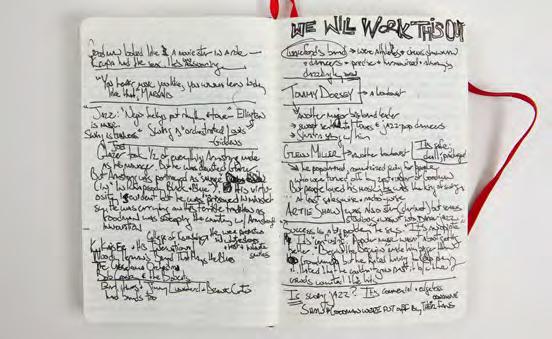


2. Promising Young Women I watched this a couple of times. I thought even less of it the second time. The movie is afraid It’s such a symbol of where we are right now with respect to fun. Like it’s bright. Like candy. But if you ate it, it would kill you. It’s like Halloween – candy with a razor blade. Right now we seem to really want pleasure, but we also think we really don’t deserve it. Don’t enjoy this too much because the people who are behind it are shitty. That sort of thing. I’m working on a piece about it right now.
3. Mare of Eastown I was writing about that girl that dies in the first episode – she was a genius. I thought that girl was going to be the whole show – and when she died I kept thinking about her face. I spent the rest of the series thinking about the absence of the girl in these people’s lives. I don’t know who that actress was, but I love casting decisions. Where do they find girls like these? That face.
6 WESLEY MORRIS
TKTKTKTKTK
1 2 3
TKTKTKTKTTK
Ad
ullaut ad quia ducia dolumque eosa que sequi ut aut que etureri.
4. Rambo Stallone’s in a tank top I think, with those muscly veins. And it’s really hot. His body doesn’t interest me, but there’s something about his masculinity – the performance of this, like, homunculus. He grunts through the whole movie.
5. Mustache This was for the Mustache piece. I never used it. I must have forgotten I wrote that down. Which happens a lot.

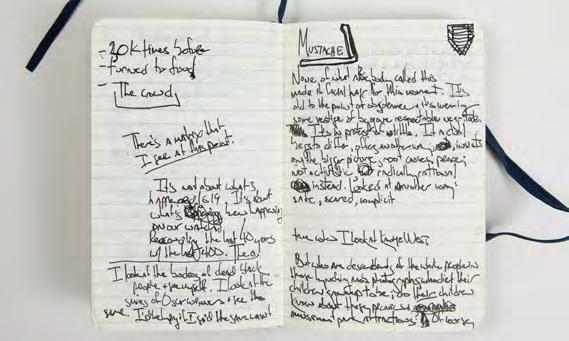
6. OJ: Made in America If you were a Martian and wanted to understand the United States of America, I would just say: watch this. There’s something about the way it understands OJ Simpson as a paradigmatic American. He was the rare black person who was given the choice about how black to be. People just accepted that. Even black people were like, Okay, let’s see how this goes. And what did he choose? He chose not to be black. Every twenty-five years in the history of black people someone makes this choice. For OJ, it was, Fuck this. I want what the white guys have. This black shit is trauma. Y’all black people are the problem. And what happens every time somebody leaves the plantation and runs off to the big house? Shit goes down. I mean, you can’t do it. You cannot be successfully deracinated in this country. The thrill of OJ for white people was that he wanted to be like them, and they loved it. And then what happened? The very thing people have said was gonna happen forever. In all of history, black men were always accused of killing white women – they can never prove it but it’s always, blame the slave. And now we finally get a Negro who really did just kill a white lady. And we can’t fucking prove it! This is what black people loved about that moment. Y’all can’t catch him! This country is fucking ridiculous.
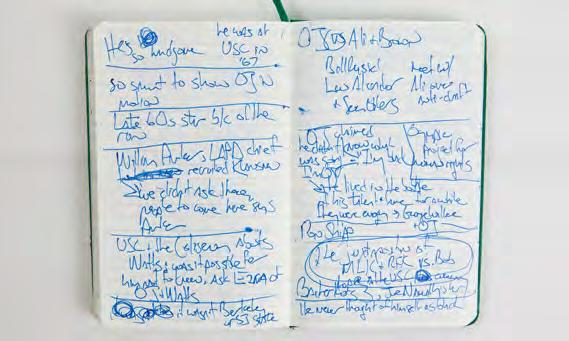
7
4 5 6
AMY SILLMAN
Do you ever think that one of the paintings you paint over was really the better painting?
AS: Oh, the best painting was the first one. I shouldn’t have changed any of them.
AM: So why do you change anything?

AS: It’s just neurotic. No good reason. It’s entirely neurotic.
Amy Stillman is an abstract painter who does extraordinary things with color and shape. She also draws and animates and makes cool little ‘zines. Her drawings are witty and crude. I thought of one series I love, of a figure barfing over and over again , as the perfect manifestation of the vomit stage (where the artists just spew their unmediated thoughts onto the page or the canvas) most creators talk about though that’s hardly what the drawings were about, since they were also political and pissed off. She’s that too. She’s also a writer – in fact, she’s one of the few artists I know who are truly verbal. Unlike most artists, she actually wants to be understood; she’s funny and real, even while expressing very conceptual ideas. She compiled her writings in a fabulous little book called Faux Pas, which is also festooned with cartoonlike drawings and sharp little chartlets. Even for an artist, she is unusually unorthodox, a polymath, an intellectual, and a tummler, direct and highfalutin at the same time.
And as it happened, Amy was also the dream subject for this project because to reach the finish line of most of her paintings she paints dozens – more even – paintings, each usually pretty wonderful, most seen only by her and briefly, before she wipes them out. I talked to everyone about self-sabotage, since I was looking for reassurance; it’s a big theme, and it’s the hell artists generally have to put themselves through on the way to the paydirt of the work itself. But for Amy, it’s actually what the work is all about: the struggle, the destruction. “I am a process freak,” she said. She is insistent that her painting -- the final painting, the
2 AMY SILLMAN
occupation : First Lastname
26
work : Miss Gleason born : 1955
“There, I’ve Killed It”
painting others see -- is almost an arbitrary choice, like a game of musical chairs, where the music stops and that’s the work. The obliteration isn’t defeat; it’s the point.
“I approach a painting with a brush,” she said, “and, it’s got things working in it but it’s like I can’t help myself. I’m thinking, I’m gonna kill it, I’m gonna kill it – ah there, I’ve killed it.” If that sounds a little pathological (and it does to me), it’s also riveting. Turn the page and you’ll see her take us through a painting where you can watch her destroy great work– over and over.
AMY SILLMAN:


“I learned to draw from a DeKooningish guy.” she said. “To work with layers and erasure. Swipes and wipes. It was the seventies. I was seeing all this stuff that was like, bad is good, good is bad. We learned all this doubt. And I don’t know, I just started. I don’t know what made me want to make paintings. Except for the indication that I got that you shouldn’t be making them. Maybe I liked color, I don’t know. As everybody knows, it was not okay
to be doing painting in the late 70s. Then it was okay again, but I wasn’t in any kind of cool crowd. And I remember making a lot of bad paintings.
“They were completely clueless. I had no content. I don’t think I understood that I had no content, and I probably still don’t. I mean I don’t think I have ideas per se. And I’d be willing at this point to say that might be true for a lot of people. You don’t go into a painting with an idea. Green with yellow is not an idea. It’s a kind of drive.
“But I didn’t know what I was doing for most of the time. I remember thinking the art world is crazy, like things are really happening in New York, I’m nowhere near there. I have no gallery, no connections. I ended up living in Ahmedabad in the late 70s, I was at an art colony there. So I thought I’ll just do whatever I want here, where no one will see it. I don’t have to care. I thought, nobody’s going to see this: I purposely grant myself this period where I can do whatever I want. And I made these drawings, these layered drawings that I still like, something dreamlike that
3
was built up in layers. And then they become paintings. In the 90s a really nice art historian came to visit me and she said, ‘You should read A Thousand Plateaus because your work has this endlessness.’ She was picking up on this film strip quality that I think my work is about. Which is about something that keeps changing and moving. She basically gave me license to become a conceptualist. It was cool to find that out. Then I finally realized, over the last 30 years, that I what I was interested in was the transformation of something into something else, and then to something else.
“I start with, I don’t know what, and then it looks terrible. And I ruin it. And then it looks maybe good. And then I try something else. And then I ruin that.
“All the versions look completely different. First it needs clarity, then it needs a different color.
You can see that it starts out perfectly good. Like I could have left it at that. And then I go, that whole thing sucks. And while it’s happening I’m in deep despair --
“This one” --we’re talking at this point about one painting in particular -- “which could have easily ended there, crazily enough ends here.”
Start “Is your first mark completely arbitrary?” I asked, because I’d heard that – that she has no intention at all when she begins a picture.
“Yes. A lot of time at the first beginning, I put the canvas on the floor, so I can’t even control it. There’s a wipe or spill or blob or stroke or something really simple.”
And then she responds to that. And then responds to that response.
All the while, she’s digging, rummaging through the bran pan, as Virginia Wolff put it. Though she has her own analogies: “I’ve often told people that I feel like when I’m making paintings, I’m a radish grower. I’m feeling around, digging up these forms that I can hold in my hand. But I don’t know what they’re going to look like, or which one is going to be coming up.” Also, elephants: “When you’re painting,
you’re editing a blind elephant. It’s an elephant under a sheet. You’re editing something that you have no idea about. You’re doing the same kind of brutal, scrupulous scalpel edit as you’d do to a text that was a mess. But when you’re editing a text there’s at least [something concrete] you can cut. Painting is an editing of a thing that has no framework, no idea.”
“The great challenge and the reason and the beauty of trying to be a painter is the impossibility of it, which is similar to the impossibility of a novelist or a poet, which is to manifest something or shape it from God- knows- what scraps and cuttings and build a thing into a thing that has not been there before. You have no idea what it is. It’s elephantine in that its so unknowable. The journey is blind. You can take the sheet off the elephant and go, holy shit, that’s it.”
Finish So that’s how we get to her conviction that the end product – the painting – is almost irrelevant. “The picture is the vaguest analogy. The real thing is the dream. It’s literally about dreams. It’s a condensation, a puff of smoke from inside you.” And why the question of when to quit, when to freeze the puff into something material, then becomes a crucial question. I asked everyone how do you know when to stop, because that’s a question everyone always wants an answer to, but for her it really was a central query. So --
“An artwork has a philosophical condition, which is, I can control it. And you can say, why didn’t you stop? And I can say, because it wasn’t satisfying yet. And it could be the nature of my work that I only paint for my own satisfaction, no matter what it looks like. You know, beauty isn’t the goal.
“What is your relationship to the paintings you destroy?” I asked. As I watched her take a torch to some iterative versions I loved, I felt a little sad. “Is it just like, Okay, this is how I make a painting? Or is there a sense of pain?”
“I think it’s the other way around.” she said. “It’s not that I regret and mourn the gone paintings. It’s that I make a painting to instantiate
4 AMY SILLMAN
– manifest – regret. A lot of lost souls go over the cliff. But there’s a really specific emotional purpose for myself, which is to enact a situation of rescue and regret.”
I ended up visiting Amy a couple of times after our first talk. She lives in an apartment in New York near Union Square Park with a terrace and an insistent happy little dog that kept jumping up, wanting in. (Her studio is in Bushwick, where she heads most days from around 11-7). I’d bike over to her place, we’d exchange a little small talk and then head to her computer. I came to discuss the process pictures and narration she’d provided to explain the iterations of a painting she called Miss Gleason. It’s a very large oil painting that took over around six months to make. She picked it because she liked it and realized she’d saved all the steps, which she’d recorded on her phone. And because she’s unusually thoughtful, introspective and a little performative by nature, she was able to recall her thinking as she made the picture (though what I’ve published in these pages is a very edited version – the entire painting in all its stages would have taken the whole book). I figured it was as close as I was ever going to get to the interior creation monologue Sondheim had imagined.
But she wouldn’t let me publish the pictures from her phone – like most artists, she’s
very particular about how her work is seen. Which put us at a standstill for a while, until she volunteered to make what she called digital drawings of her shifts. As she started to work on them, she got very excited about the project, which was heady to watch. I liked the idea that our talks had spurred an art piece; I felt like a collaborator. She was really into the way the photoshop renderings of the iphone pictures looked – I did too; they were like art x-rays -- and between visits she started to see them as a work in themselves. She’d just been to a printer -- “the inkjet place,” she called it -- and they told her they could print the images on all sorts of textures – canvas, aluminum (“honey, we can do it all.”). So that’s what she was going to do – print the x-rays and exhibit them, as well as turn them into an animation – looping process being what her entire artistic project was about. So she wanted to get our work together right.
The iterations you see on page tk are rendered in black and white, and show her reworking the forms over and over, with interruptions now and then to indicate how they looked in color (a compromise; she didn’t want color at all). It’s a bit hard to imagine these versions in all their color and detail, but trust me when I say that there are at least five amazing pictures in here which she destroyed. And you can get a clear sense of how she works – and works to subvert her work – as she goes along, with the
It was a series of opting out of mistakes. It wasn’t ever a decisive process. So first it didn’t work to go to college in Wisconsin, then it didn’t work to work at a cannery, then it didn’t work to study Japanese, then it didn’t work to study illustration, then it didn’t work to go to art school from the beginning because I felt I’d be too old. And then I became a painter. So I negated my way into the negative dialectic.
You know how there’s something about when you fall in love with someone that you feel isn’t your type? Painting wasn’t my type. But then I got more and more interested in it. The first thing that my drawisng teacher said when I wanted to go be a painter was “You will be a waitress, not a painter.”
I was really good in my drawing class. I was cottoning on to what he was trying to teach very well. And so I said to him, “I would like to go to art school now.” And he was, “No, you won’t be able to.” I was 19. I don’t know if it was personal or structural. But he told me, “No, that’s not going to work out.”
5
HOW SHE BECAME AN ARTIST
narration sometimes veering into the passive voice, as if she were just a witness Also, of how, for all the painting’s abstraction, she was digging to find the figurative (arms, shoulders, nipples) or material objects (teapot, bottle) within. At one point, she was talking about her aches and pains, and found her shoulders and hips in the painting, the same body parts that had been worked over that day by a masseur. “It’s literally a self-portrait,” she marveled, but then, isn’t everything?
As we talked, she suggested gallery shows she thought I should see, and gave me advice on my own painting, including one exercise she proposed after I told her I was struggling to make my work more abstract (the gist: draw a figure, or a couple – that’s what she did -from sight multiple times over many hours; sleep; then the next day, draw the figures again from memory. And then keep distorting them as you move further away from your experience of the literal. It works.) She talked about other projects that were weighing on her that she’d promised to do: another show, a list of her favorite new books of the year, which flummoxed her because the main book she’d read that year was the Torah.
I began to like her a lot; also to find her familiar, especially as she’d veer into conversations about the labyrinth of the psyche, where she placed all her explanations of where all this stuff came from (Torah notwithstanding, she was firmly on the side of the great psychological theorists, and well-schooled in them). There was a lot of this talk in my
house growing up as well, and she was the sort of Jew I was too, which I found comforting. She wanted to know what I was getting from the other subjects I talked to (all the subjects wanted to know that, actually), whether there were differences between men and women, poets and painters, gay and straight (there weren’t, not meaningfully), that sort of thing. We got talking about aggression. “Or hate, is that what you mean?” she said. “I think hatred is part of art you know. A dialectic is of importance here, so the antithesis is basically the part where you negate, erase, efface, paint over, undermine, scrape, ruin. There’s an urge in your painting, or my painting at least – looking for figures in it is like searching for your lover or parent or, you know, yourself. It’s ego driven. And there’s a part that’s like a rageful id – you know, the part that says, absolutely not. Then, at the end, it’s like you’re pulling something out of the wreckage, trying to care for it, or repair it, heal it, or something.” I asked if it was the same when she writes. “All of it,” she said, “is exactly the same in all kinds of art. What the fuck is this, I can’t work out this fucking paragraph, and then you just move the sentence, and it’s oh, look at that, great, exactly. My old shrink used to go, it’s about sublimation. I’d go, oh, what’s that again, the sublime? You know, it’s also the death drive. It’s everything Freud says and Lacan on top of it. Mistakes and eruptions and accidents are like rips in the fabric where the real meaning comes through.”
A couple of years ago, she came up with
THE DIFFERENCE BETWEEN ABSTRACT AND FIGURATIVE ARTISTS
I’m completely committed to the not knowing.
I’d probably get in trouble if I said this to certain kinds of representational people. But I would argue, in my soul, that the whole value of abstraction is that it hews closely to this hyper emotional state of wishes and urges and dreams and fears. I have whole periods where I paint from life. And that’s a different project. That’s a project of the joy of being able to make something that looks like the thing but isn’t the thing. That’s the Frankenstein joy where you remake. That’s why it’s re- presentation.
6 AMY SILLMAN
some ground rules for how to work. “Because I wipe over the painting so many times, I could just make one painting for the rest of my life, there’s no reason to ever stop, you know? So I thought I needed to construct a score of moves that I could make. I figured out that I would allow myself an attempt at looking for a figure, a relatable figure. And then I had to try to do something radical with color. Then I would allow myself to wipe it out, add in destruction. And then there was one other move --making a kind of pattern or repetition of a pattern. I decided that I would give myself two passes of each. And that would give me eight layers. And there could be a ninth and tenth layer that were wild cards. And that was where I had to solve the painting and get out.” Which she didn’t always do --”I’d ignore the whole thing, keep going.” – but it gave her a structure.
Sometimes it sounded like she thought of making art as a game, as if she toggled between caring and not caring. “I think I work better when I’m like, fuck it, I can do whatever I want. Because it’s all bullshit.” I didn’t believe she believed that, but I knew what she meant.
The entire construct she created seemed at times like a story she was telling herself in order to understand what she was doing. I found that fascinating, but also found myself wondering if it was sincere. Did it really not matter what particular art she produced – where, in the slideshow, she stopped? Didn’t she ever make a painting just to make a painting?
She told me a story. Recently in Germany, she made a work she then showed. The painting just emerged without any of this sturm un drang; it took her a week. “I didn’t make any revisions. I loved it immediately and I left it alone. And there was another in the same show that took me a year, took forever. They couldn’t sell the one that was done in a week. And I happily took it back because I like the faster one better. But I got a greater sense of achievement from the really slow one. The one that I was desperately miserable making, but that I nailed. It’s a very beautiful painting and somebody bought it and that’s wonderful.
No one wanted to buy the one that didn’t have struggle in it.”
“Were they right? Is it the better painting?” I asked. I tried to understand. “Do you feel more satisfied by the one you struggled over?”
“Yes,” she said, “but more love towards the easy one. I mean, I feel love toward each of them because they’re all my relationships. But the easy one is such a pleasure. Like if you meet someone and have a great affair and at the end, no drama. That was great. Bye.”
True art, like true love, is rarely easy.
7
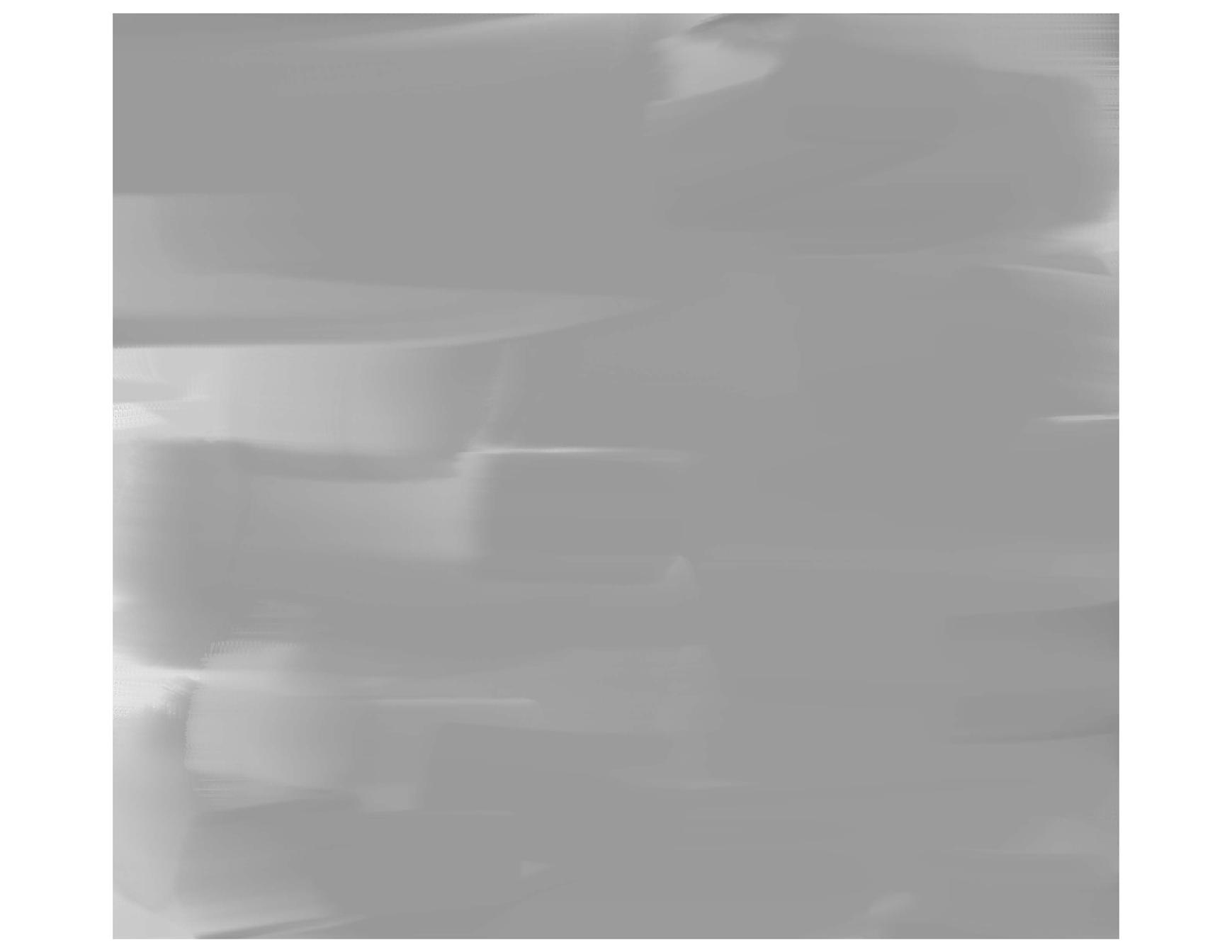
8 MISS GLEASON, IN 38 STAGES 1
AMY SILLMAN
1. The painting is big, 84 inches wide by 91 inches tall. The first step was a thin wash of purple wiped on as a ground, like a sky.
2. Then totally intuitively, I added one lone shape, some sort of saddle with a limb, or protrusion.I like it! Maybe I should stop! I probably should have but then I thought, Nope, know what it is yet.


3. Then came a pile-up of beige, ochre, and bluegreen shapes. I was trying to create a disequilibrium, an interruptive kind of jumble. I’m often aware of the instinct to paint a mark over the exact place where a brush mark begins, which makes it hard to follow the progression of what’s on top and what’s

4. Now there is a complicated bunch of shapes, but I need to clarify, so I add lines, which basically changes it from a shallow space with overlapping forms to a flattened linear diagram.
5. I continue trying to both clarify and complicate the whole thing, to heighten contradictions, and also to add color -- for example, in this layer, a purple area at the bottom weights down the bottom. So now we’re off to the races, dealing with space, line and color all contradicting each other. I’m building

9 2 3 4 5
6. Many days go by where I’m flipping it upside down, and back again, adding lines and taking them out, and now I’m thinking, Hmm, now what? It’s just confusing. By this time I’ve added a purple C shape on the right side and made a lot of other color changes. I’m still negotiating between the diagrammatic and the
7. I simplify the palette, there’s a new greybrown tonal ground with warmer, brighter colors up front. It has a kind of clock face in the center between two “trees.” The painting feels emptier, and cleaner. The colors move around over the next few weeks.
8. At some point it turns into a valedictory kind of image, like a flag or Girl Scout medal, and I think, I like it! Maybe I should stop! I probably should have, but then I thought Nope. I don’t know what it is yet.
9. Then I get really angry at it. It’s so flat, and I don’t want it to be, so I’m trying to figure out how to make the space more dynamic, to squeeze it vertically or expand it horizontally. Some orthogonal lines are drawn on top, like window shutters, making the space perspectival.



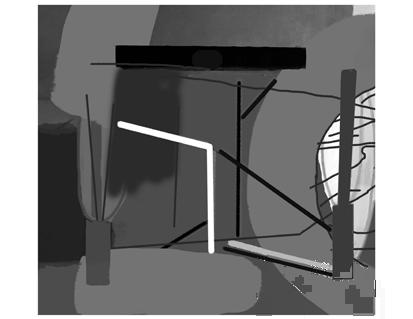
10
AMY SILLMAN 6 7 8 9
10. But then I think, no that’s terrible –too heavyhanded – so I add a kind of decorative treatment that flattens it again, kind of a bow or X-shaped thing.

11. It starts to look like an opened book. I tilt it back and forth to test which way has more weight, but it’s still not working.
12. I try painting the image in sideways to see if it works as an asymetrical structure instead.


13. At this point I’m just fiddling with the painting’s components, opacities, transparencies. I’m trying to work out the part-to-whole relations, and at the same time it’s getting flatter and diagrammatic again.

11
10 11 12 13
14 . At some point the parts aren’t working and I wipe a rather tormented purple field above it.

12
AMY SILLMAN 14
15. I somehow pull the flat linear forms forward from this murky ground again, and now it’s got a stacked-up vertical on the left, like a diagram of a person. I’m also trying to balance the purple with a large green rectangle. It’s like a Jenga game, finding a resolution between different parts and different colors.
16. Then I’m thinking, awful! I wipe most of it out, put in some misty shapes and some patches to cover it. This painting has suffered a lot of wipe-outs!
17. Then comes a total wipeout.
18. Then I turned it on its side vertically and it got lost for awhile. I don’t have all the connecting images but weeks go by with a series of desperate figure/ground maneuvers, figures that emerge and submerge continually into an all-over fog.

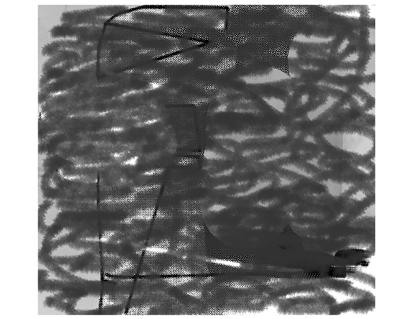
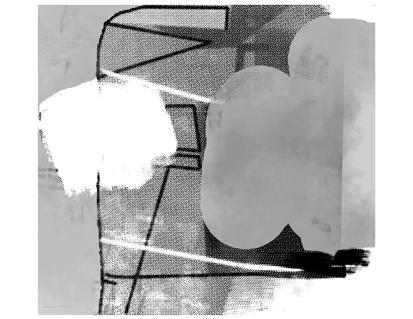

13
15 16 17 18
19. Finally a pair of schematic figures stuck, one on the left, a black silhouetted figure with a white head and neck, who was kind of waving or hailing the figure on the right, who was made like a kind of anthropomorphic object -- a bottle with a kind of boob, with a nipple.
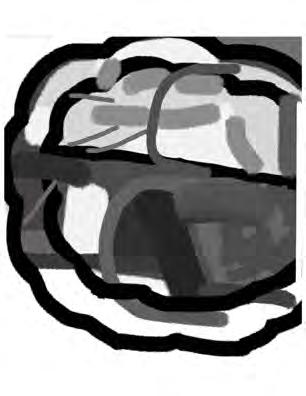


20. tThe painting was flipflopping between figures, and erasures. But I needed to steer it back to being a painting, not a diagram, so I dragged a big dirty fabric horizontally across it to energize the surface. This changed the action to a kind of horizontal latticework, and the two “personae” became one disembodied figure going
21. After mucking around between figure and structure for such a long time, I started worrying, what should I do with the edges? I needed an outer container. So I superimposed a diagram over the top, made of big arcs. At this point I was surprised in a good way, and probably should have left it, but instead I started
22 . I was only adjusting colors and tones at this point, pulling ground tones out from underneath so the various blocks of color felt like light coming through a structure.

14
AMY SILLMAN 19 20 21 22
23. I turned it sideways again, and again considered leaving it. It was a nice painting at this point.
24. But it kept evolving and went back to vertical. Now w border-vs-interior structure had been established, but I wanted to find the body again, something with some gravity. It went back and forth repeatedly until pendulous forms started to appear, like limp body parts or a droopy nose or spout.
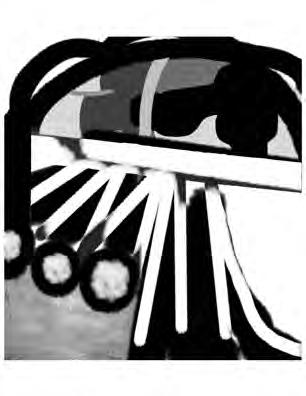
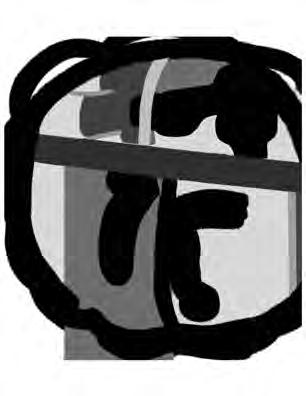
25. Then things got complicated and went awry. The painting took a detour, and a pattern appearted at the bottom, like an awning or fringe hanging from a machine. The whole painting veered into confusing territory, and I realized I needed to make a big gesture, and deal with scale..
26. So I eliminated some narrative frippery and enlarged the geometry and colors into blocks.


15
23 24 25 26
COLOR
like it was sitting on a see-saw or an unstable blade.
29. The white below made the upper part need more empty space, so I got rid of the top, and left it empty like a sky, and organized the shapes below into a kind of signpost or goalpost structure, something you could imagine passing under or through. The white triangle became its own form.


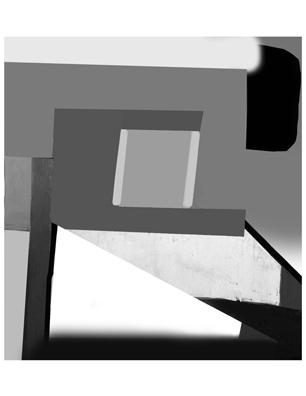
it.

16
27. The underlying narrative receded, and the color blocks took precedence.
28 . Eventually a white triangle appeared and made the whole situation seem a bit unstable,
AMY SILLMAN 27 28 29 30
30. The grid kind of opened up. Air came into
32. I kept moving it around for a couple weeks, and started to get mad again , because I was getting tired of this endless indeterminacy— I flirted with wiping it out entirely again, but instead pulled a kind of fog around inside it.
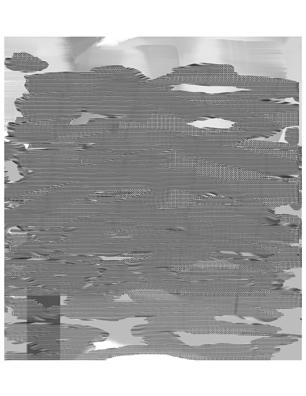
33. I got mad again and covered the whole thing with a grey scrim that descended downward over everything. Everything that had happened up til now was about to be wiped out, and I knew that I was getting to the point where it would soon be too late and I would lose whatever light was in the painting once and for all.
34. So I clarified the sky tone again, to rescue the light and regain some of the space. It was still a kind of shadowy mess, but there was a structure underneath again, below the cloud.

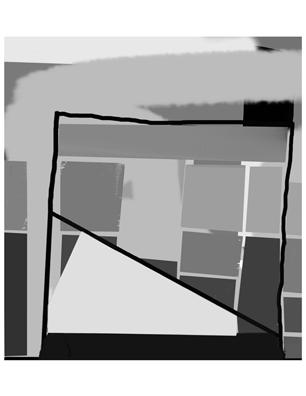

17
31. I kept turning the painting from horizontal to vertical, and the white triangle became different things, from an empty plane of space, to a sailboat going out of the picture to the right.
31 32 33 34
35. Then the weather kind of cleared up, the painting opened up again, and I found this tattered structure visible in it again, like a single post with a laundry line strung across it. I liked it.
36. I continued by adding a sequence of colors, like flags, that moved across the space in a horizontal line, each marked by difference to whatever was next to it: a cool, then a warm, then a dull scuffed color, etc, all hanging like sheets on a line.

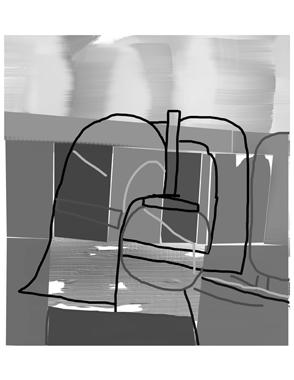

37. I was thinking, I’ve got to be done soon. So I made the color blocks become a ground by imposing a drawing of a single figure-ish form on top, an object+body like an apple or a tea-kettle, a torso with a kind of tilt, leaning over and down to the lower right side of the painting.
38. I clarified the tea kettle body as the central figure, which comes up from the lower right and has a structure, like a sculpture on a pedestal, with some logic and some weight. On the right, it leans up against a dark green oval; on its left side it’s more open, like a bell-shape hanging in space. I liked it, and that was it. I gave it a
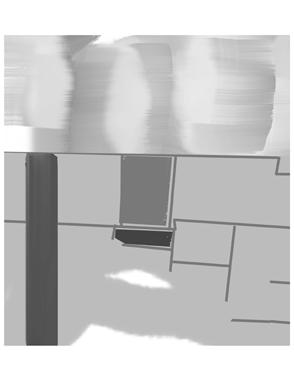
18 AMY SILLMAN 35 36 37 38
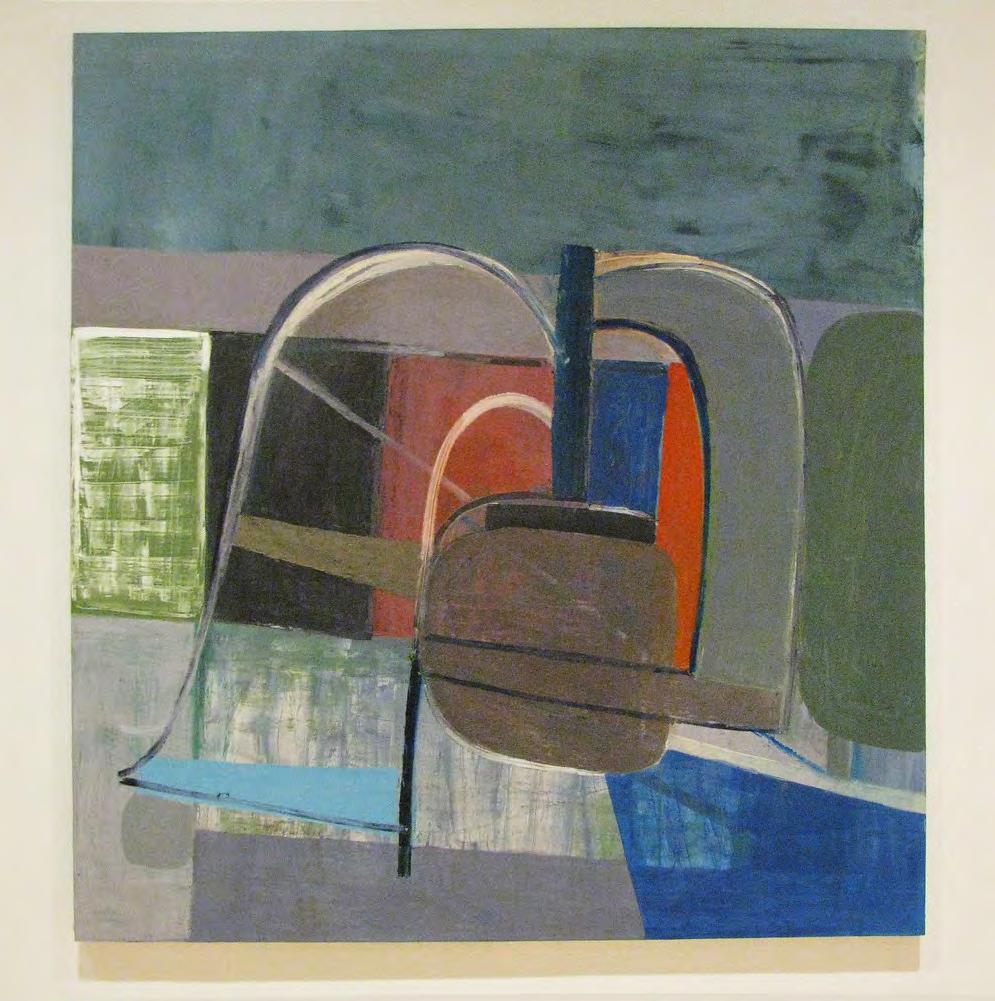
19 39
39. tktktktktktktkt ktktktktktktk tktktktktk tktktktktktktktktktktk
DAVID MANDEL

What if Dr. Seuss
Fucked Maya Angelou?
NOW, HOW DO YOU write a joke?
In the Introduction, I mentioned a visit I paid to the set of Veep. I was invited by Frank Rich, a good friend and a writer at New York, who was an executive producer of the show. He thought it would be fun for me to come observe a shoot. Veep was an HBO comedy largely about Selina Meyer, played by Julia Louis-Dreyfus, who starts the show as a ridiculously unscrupulous vice-president and then goes on to various other political adventures where she is pretty much foiled at every turn. The show was vicious and hilarious. It ran seven seasons, the last four overseen by David Mandel. But when I visited the set I thought the fun would be just watching actors I admired doing their highly professional thing; I didn’t realize I would also see great comedy being written in front of me, on the fly. The day I visited I sat behind Mandel, a boisterous guy with a big warm laugh, and watched. A scene – short and inconsequential, basically centered on Jonah, an idiot congressman – was being shot on a set in an adjacent room. Mandel kept stopping the action to fix a joke – a little Jonah joke that landed on a Jewish holiday. I watched as Mandel kept trying to ratchet it up, mostly by switching out the holiday. Nobody remembers the joke at this point, but I now know that what I was watching was a familiar process where ‘alts’ – options, some spontaneously generated, some written ahead of time --are offered to fine-tune a joke to its funniest calibration. The rigor they brought to construct a little joke that would hardly register was really impressive.
Mandel, who had followed a familiar comedy path to get to Veep– he watched a lot of the Honeymooners and the Odd Couple growing up, went to Harvard, became a Lampoon writer, graduated and found himself writing for Seinfeld and Curb Your Enthusiasm – was hired after the show’s originator Armando Iannucci decided to exit after Season 3. Ianuuci had left the show at a narrative crossroads –or “a trap,” in Mandel’s words. Selina, who had briefly inherited the presidency, was running to be elected president, and the election
2 DAVID MANDEL
occupation : Tktktkttk work : Veep born : 19tk 27
ended in a tie. As part of Mandel’s audition to run Veep, he had to pitch a solution. Mandel devised a short and long-term scenario which would involve Veep ’s version of hanging chads; Serena’s loss to a younger woman, which would particularly vex her, and then shenanigans involving her ex-presidency, a memoir and library nobody wanted. The plot line won him the job. Mandel proved an excellent showrunner, a comedy locomotive who took a moment but then accurately diagnosed what exactly it was that made Veep successful, and how to bring his own ways to a pattern already set by someone else.
“I was taught to write sitcoms by Larry David – first on Seinfeld , then on Curb . So first, my guiding philosophy: Is it really the funniest it can be? What can you do to get it there? No, that’s not right. What comes first is story. If the story isn’t working you can papermache over it with as many jokes as you want. But at the end of the day it won’t work. There are Seinfeld episodes I wrote where the stories never were quite right. They had some really funny jokes in them but it didn’t matter.”
“In my first season of Veep they made me

3
DAVID MANDEL:
Ed quid quo totatiste voluptio blabor anti dolut rerum de andellis.
hire three editors. I was like, why three editors? When I got there I realized, oh I see. Because sometimes Armando was just poring through huge amounts of improv footage, finding a show in the footage by going from edit room to edit room and working on multiple shows at once. I don’t work like that. I love what he does. I can’t find a show, do you know what I mean? His method results in some digressions that are wonderful and cloudlike in the way they float. And ours is a little more rat tat tat. But essentially we come to the same place.”
“I go into a season with a rough idea and try to figure out very quickly where I want that season to end. I bring in guests, like the people who worked for Obama in Iowa, to help give us ideas. Pure story at this point, though if we think of something funny, we note it and bake it into the structure. And at first we draw lines on whiteboards. 10 buckets, one for each episode. And we move things around. First, big picture Selina things. And then, what’s going on with her daughter, with Jonah. What if Jonah runs for something?
“Everybody in the writers room gets to have opinions, but at the end of the day I’m holding the dry erase pen. I show [the plan] to HBO and Julia [who is also an executive producer and basically the show’s reigning figure]. People get assigned scripts. Sometimes there’s gang rewriting, but it’s eventually going to go through my typewriter.
“And that gets to a table draft, then we’ll do a punch up session where we go line to line trying to add more jokes, then that gets to the table read with actors. I’m listening for: is it working? Is it long? Why are people confused? Why didn’t this joke land?
“Then the script gets locked and we enter shooting mode. On the night before shooting a scene Julia and I would talk through anything not working or lines that could be better. Or what seems too naked – like if Selina was almost saying what she wanted as opposed to acting on it. And it would go out to all the writers-- we’re looking for some options here.”
Aha. That’s how we get to the alts, but first there was an important lesson to be learned as to how the show actually worked, something he didn’t realize at first. After the painstaking process of getting the job, the show he wrote to start the season was inert. He panicked. Veep was a beloved series. “I knew we were going to be judged very quickly. I felt like I was being dropped right into a foxhole.” Eventually he realized that plotting the right developments in the right sequence with funny jokes in between wasn’t enough. Veep ’s mojo lay in its pace.
“My first episode was kind of a disaster. And eventually I rewrote it. And sometimes I think that they loved that rewritten episode because the first one was so wrong. And the thing is, it honestly wasn’t that different. It was very much people talking – Selina woke up and talked to Gary [ fn1 ], then she went out and gave a speech. There was, how do I put this? A lack of chaos. It was almost painfully logical. Not that that was what anybody identified it as. But what it took was almost taking the scenes and mushing them together because there wasn’t enough happening. And then suddenly it was Veep . “
When Mandel realized this, he pushed it as hard as he could. “In any given scene there were at least two or three things they’re supposed to be discussing. That was a big difference –on Seinfeld and Curb , they’re talking about one thing. Here, the show is pretty speedy. I amped it up to where it’s fucking fast. I added more story. I started dipping into the characters’ personal lives, which definitely thickens things up.”
“And then in the edit room basically anything that was unnecessary, be it words, breaths, pauses, whatever I could squeeze out of it, I did.”
The Alts.
Mandel has a tight grip: the alts process I witnessed is a vivid expression of that. He spots any weakness in the script, and puts out a call to the writers for new options, which are
4 DAVID MANDEL
usually just adding new juice to a joke, a maneuver that inevitably involves tinkering with the specificity of the language. It’s collegial but also competitive. “These are type A comedy writers. They’re not trying to destroy each other but they take pride. Somewhere in there is an egotistical oneupsmanship.”
Generally the alts were sent to him the night before. “I write my own line or I take half of this and half of that. There’s no formula. I will take all these alts, and I’m just circling anything.”
“As we start shooting I just start yelling the alts [to the actors] as I read or as I’m coming up with them myself, or someone whispers something in my ear. And I yell that out. I jam a Sam line in, jam a Richard line [fn2,] any place I can wedge something in, I’m gonna. It’s like a live rewrite, or live editing. We’re on comedy adrenaline. And there’s nothing more satisfying than that, except playing it to a room and hearing the laughter.”
That excitement was very visible to me as I watched the crew’s laughter build. Taking it in, it seemed as if he was subjecting the joke to a plebescite: the biggest laugh from the crew wins. Turns out, it wasn’t s democratic as it looked.
“The honest answer, and I don’t want to sound like a giant asshole here, is I know when the laughter is coming. It’s gratifying to hear but I have no fucking doubt about how funny it is when I’m done. I’m definitely paying attention
to how much people laugh on the set. But when I’m in the Edit room all that disappears. At some point I’m sitting alone with the editor. Not all comedy writers work this way but I’m a laugher. I definitely want to laugh.” Generally, whatever he laughs hardest at gets aired.
As I mentioned earlier, he couldn’t recall the Jewish holiday joke I’d seen that day on the set. Ever-obliging, he found another Jewish joke (Jewish jokes were not rare on Veep), and wondered whether it might be the one. Then he found another joke that built on a joke he remembered from another show. The jokes were reconstructed by an associate, who sent them to Mandel. Here they are, with Mandel’s reasoning patter as we were looking at them…
The Hanukah Joke “Sometimes there’s a clear winner but not here. The easiest way to explain this is, Jonah’s an idiot. And these are quote, unquote Jewish jokes-- by definition we want

5
them to be a little bad and a little anti-semitic, but not too anti-semitic. I’m not sure Jonah has hate in his heart, but he’s definitely dumb and quasi racist. So let’s see. Israel wasn’t doing much. The milk thing, I think that’s supposed to be a Yiddish word kind of, but not, whatever. New York I guess works, it’s right on the edge of Hymietown [a phrase Jesse Jackson had once used to refer to the city]. And during that season, Jonah’s married this Jew, who was like what would happen if Sheldon Adelson and Rebecca Mercer had a daughter. She wants him to convert, and he likes the idea of that, makes him feel “chosen.” If the joke was anti- Jewish in a way, it would undercut his love of converting. And so Hanukah felt stupid in a good way with Jonah, but not undercutting.”
And then he found some alts from a joke he particularly liked.
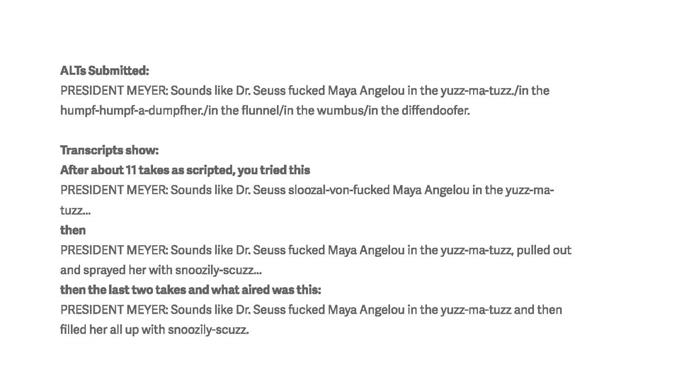
The Dr. Seuss Joke So Selina’s running for president. We’re starting with this notion of a rally, with you know that call and response thing that Obama used to work the crowd with. And Selina’s trying to do that, and not getting any response. But her opponent has this natural affinity for the crowd. So in the rewriting we kind of came up with this Dr Seuss idea, just the notion of fusing Dr Seuss and Maya Angelou, which seemed very funny. Selina’s
1. Gary was a personal assistant or ‘bodyman,’ or lap dog, comically loyal to Selina in spite of all of her abuse.
2. The original dialogue on Moonlighting went like this: David: We’re looking for a man with mole on his nose. Maitre’D: Mole on his nose? Maddie: A mole on his nose! Maitre’D: What kind of clothes? Maddie: (to David): What kind of clothes...? David: (to Maddie): What kind of clothes do you suppose? Maitre’D: What kind of clothes do I suppose would be worn by a man with a mole on his nose? Who knows? David: Did I happen to mention, did I bother to disclose... etc.The original dialogue on Moonlighting went like this: David: We’re looking for a man with mole on his nose. Maitre’D: Mole on his nose? Maddie: A mole on his nose! Maitre’D: What kind of clothes? Maddie: (to David): What kind of clothes...? David: (to Maddie): What kind of clothes do you suppose? Maitre’D: What kind of clothes do I suppose would be worn by a man with a mole on his nose? Who knows? David: Did I happen to mention, did I bother to disclose... etc.
3. Sam and Gary were also Selina’s aides-- Sam, cheerful and comically oblivious to the cynical machinations of everyone else on the show.
4. When Julia-Louis was diagnosed with breast cancer
the perfect person to hate both Dr Seuss and Maya Angelou. So now it gets complicated. I was a huge fan of the show Moonlighting. There’s this great episode when they’re trying to find a Chinese guy with a mole on his nose. And this is when Moonlighting was at its greatest, and the guy they’re talking to just turns it back and forth into this Dr Seuss thing [fn3]-and that left an indelible mark on my comedy psyche. And I came in that morning, and I said I think there’s an opportunity to stretch this line out into something more absurdly Veepy. I ordered up what the joke should be, which rarely happens. What if Dr Seuss fucks Maya Angelou-- how do we take this further? And I can remember sitting there with the staff, trying to find the right one. And someone came up with yazz-ma-tuzz and then Danny O’Keefe [a fellow writer] added “and filled her all up with snozzily-snuzz. And it was just exactly what I wanted.”
6 DAVID MANDEL
Here is a whiteboard that shows the series plot line as it’s being worked out. It’s for the last season, but it’s not what came to pass. Here Mandel discusses how he ended the series, with external events heavily influencing his thinking.
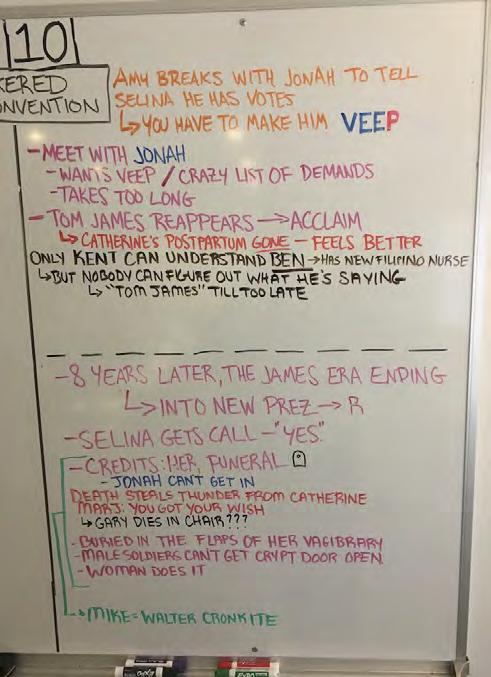
“This is basically what the end of the show looked like right before Julia was diagnosed with cancer.[fn4] We’d won an Emmy Award on Sunday night. And Monday morning I got the call she had cancer. So this is the original ending. Basically it was building to this notion Selina has to make Jonah veep if she’s going to be president again. She goes to meet Jonah, who is particularly assholey and has a crazy long list of demands. And the gist was that that takes too long, Tom James [who had been Selina’s original veep and was her sometimes lover] makes his move and is elected president. And then we jump eight years and Richard is elected president. And she gets the call from Richard. There was the thought that he was going to say, will you join me on the ticket? And she just goes, yes, like she doesn’t even let him finish. Or we just cut away, Sopranos style. Or the halfway cheat, where you just see the biggest fucking smile on her face. And then you jump ahead again to her funeral, the funeral of the only woman to be vice-president twice.
And that was where we were headed when we took a hiatus while Julia got treated. The biggest thing that happened during the interim is that Trump changed. As it became clear she was going to be okay, Trump was hitting the gas. He got crazier. He got more Trumpy, and he was pretty Trumpy to begin with. So I had this existential crisis. We were making fun of a model that doesn’t exist anymore. The ongoing structure of Veep was, she tries to do something and it backfires. And it ruins her. So much of the show is based on the notion of either her begin embarrassed or saying the wrong thing or being seen the wrong way. All these concepts just instantly started to feel outdated. This was really bothering me.
And that led to the idea: in a world where Donald Trump gets to be president, why can’t Selina be president? Why is Selina the only one paying the price? In a post-Trump world what seems shameful no longer seems shameful.
So instead we started talking these larger questions like, what does it take to be president these days. What is she prepared to do? What is the worst thing she could do – that would make her earn it but that would just be horrifying? And ultimately, it was, you have to kill Fredo. [fn5] And that’s basically it. Like the moment when Coppola feared that people might like Michael Corleone too much. What do you do? You kill Fredo.
And really, what is the only thing she cares about? Gary. So we decided she’s gonna kill Gary [not literally-- she betrays him in a particularly awful way], basically bury him in the woods. And it just changed everything – obviously the finale, but we went back and looked at the whole season, and darkened it because all of a sudden we had to play in what was politics now. And sometimes things we were making up were happening by the time the episode aired. Like no matter how horrible and dark we wrote things, America seemed to be getting there as quickly as it could.
7
HOW TO END A SHOW
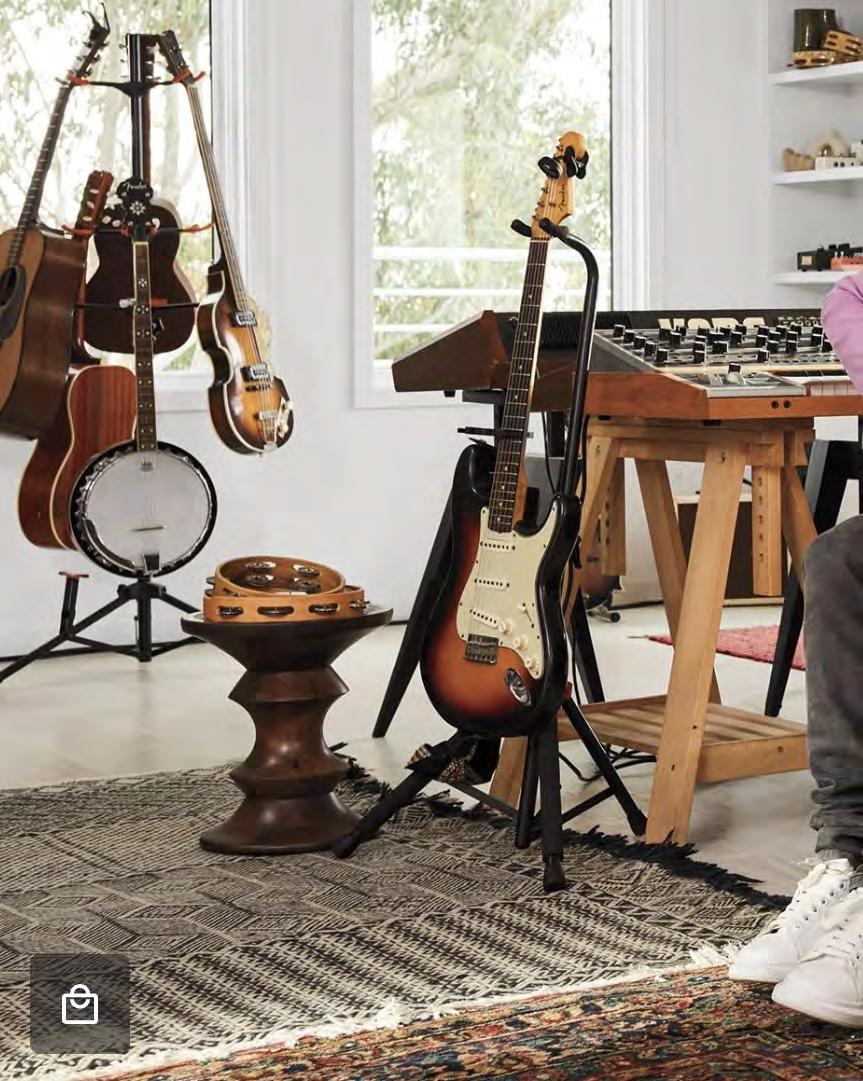

Late at Nights
ROSTAM BATMANGLIJ IS AN indie musician who was a founder of the band Vampire Weekend before he struck out on his own as a performer and producer. He has a very particular sound (and voice) that I love, and I listen to his music a lot. He is also a neighbor for a few weeks a year in Provincetown. As a child he had a very varied musical education – piano, flute, guitar, and music theory, which he got very interested in very early. “I started writing songs as a very young kid – I would write melodies, write them out on sheet music, and when I was around 13 or 14, included lyrics as well. They weren’t very good, but it was a pursuit. I started to get recording equipment, I could do four tracks at once, learned to layer tracks on top of each other.” At Columbia University, he met Ezra Koenig, and soon Vampire Weekend was formed, turning into one of the more consequential bands of the modern era, with Rostam also producing the records and functioning as what one reviewer called “the sonic consigliere” merging its many musical influences. In 2016, he broke off to try his hand at making his own music as, simply, Rostam. We sat down to talk about a beautiful song, In a River, that he particularly likes.
ROSTAM:

It started with a mandolin. I had been working as a producer with a isinger/songwriter named Maggie Rogers on a song called Fallingwater. I kept hearing a mandolin as a missing piece in the song that would make it something new. So I got a mandolin and I tried it. And Maggie immediately said no – too country, too much twang. She was probably right.
But I had a mandolin all of a sudden.
He had barely played a mandolin before.
The thing about a mandolin is, if you know the chord shapes for a guitar, they’re the same chord shapes on the mandolin, just upside down. It isn’t hard.
It was June maybe of 2016. I was sitting in my living room with this new mandolin. And I just started playing.
As I was trying to get familiar with it, this
2 ROSTAM
occupation
work : In a
born : 1983 28 ROSTAM
: First Lastname
River
chord sequence started coming into my fingers and I sort of kept playing with it – just three chord shapes.
I made a recording on my phone -- just me singing and playing the mandolin at the same time. From that first recording, a few of the lyrics are already there. Some are gibberish. Some are English words not in the right place. This was one of those cases where the melody, the lyrics and the chords arrive somewhat simultaneously. There are some songwriters who refuse to write a song unless it comes to them that way, but I’m a little more agnostic – I’ll do anything that ends up at something I’m happy with.
The key lyric – swimming with no clothes on in a river in the dark – came to him in that first session. But he can’t explain exactly why.
That is one aspect of songwriting that I feel I’ve trained myself to turn off, because as soon as you start analyzing it, you are tampering with something powerful: your subconscious. But let’s see. I was in Los Angeles, it was June, I was getting ready to go to Massachusetts to be on a beach. There are no rivers to swim in in Provincetown. And yet it came to me as it came to me. The concept came to me from my experiences there. It’s important to place yourself inside a concept when you’re writing a song. Because that’s when you can let your mind do all the work. And then it’s important not to be too loyal to the concept at the expense of what might happen.
And that was it – for a while. So inevitably these things live on your iphone and you can listen to them at any time. Sometimes late at night, you’ll just go through the various bits before you go to sleep and you listen to these little recordings that you make. Sometimes, it’s a piano part. In this case it was something resembling a song. And then you decide what you want to work on – what gets promoted to the big leagues.
He went back to his phone. The voice memo serves as a kind of scrapbook but I also use the
Notes app, which becomes like a scrapbook for lyrics. I started playing with the words, just changing one, then changing it back and forth. Sometimes it’s about trying to write more lyrics without an intention for them to fit in anywhere. I just kept going back, and getting happier and happier with them. So I was working on the lyrics, I was touring a little bit. And in January, when I got back to LA I was feeling a little pressure because I was staring down the barrel about two weeks from going on tour again, so I started recording In a River.
But recording isn’t the end-- it’s just part of the process. When I write a song it’s always a little connected to recording. Moving back and forth between recording and songwriting, the two inform each other and you get inspired to write more. When I say recorded – well, the original recording on my Iphone just of me singing and playing-- that’s the first incarnation. But then the process of recording something properly is to record each thing in isolation – recording the mandolin with no vocals, and then just the vocals. This early recording was slow – way slower than what it became. I remember not being sure that the song needed a bridge but then getting to a point where I could hear the first verse, the second verse and the two choruses and saying, Oh, Obviously yes. So then I wrote a bridge. I had the melody, I had the chorus. I had the lyrics. And then the songwriting was done.
But it wasn’t really. My intention was to play it live with my touring band, which was new because I had never really had a group of people to tour with. On that tour I played In a River at every single concert. This song is unique because it was probably performed fifty times before its final recording. I remember telling Julian who was playing the mandolin during the show that we had to get the tempo exactly right. On nights where he played it too fast it was missing something. Speed is a huge question mark with a song. Faster, it has energy
3
Even in the background
With the lights on the field
Somewhere to my right or left Is a body I can feel
We are swimming With no clothes on In a river in the dark
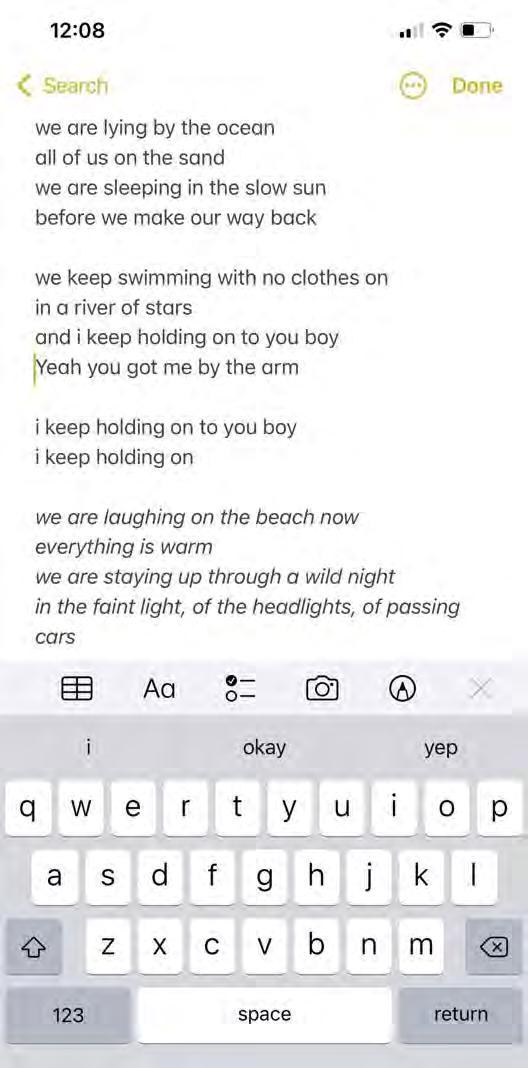
We are holding One another We are holding We are holding on
We
but sometimes loses intimacy. If it’s slower sometimes the groove is improved and it can become more sexy or more powerful.
With the help of the audience. So following the bridge of the song, there’s a part where I sort of yelp like Woo. And as soon as I would do that, there would be people in the audience who would clap. The more we played the song, the more I found that if I raised my hands above my head and clapped, then they would too. In a River was the first encore, and
MUSINGS ON HIS PHONE
I’d often say ‘We’re back – here’s one that you’ve never heard before.’ After the show I booked a few days at a recording studio.
And now he wanted to bring the audience into the song. What I wanted was to have this sort of live feeling enter the song. I wanted it to feel free and untethered by the metronomic pulse – so much music is made nowadays with no fluctuation of tempo. There was a sound too, the sound of a crowd of 500 or 600 people clapping at the same time. We recorded the
4 ROSTAM
ain’t
But I got nothing to play
So forgive me if I’m too bored And forgive what I should say I
got no time to get old
in
I’m holding
To you, Yeah I got you
In
Naked In
“ROUGH
are swimming In a river With no clothes on
the dark And I’m holding Yeah
on
by the arm We are swimming
the river
the sun And I’m holding I am holding I am holding Holding on
DRAFT”
Slide into the cool mud
Underneath the pines
Somewhere to your right or left
Is my body you can find
We are swimming with no clothes on
In a river in the dark
And I am holding on to you, boy
In the faint light of the stars
So you wade out across the marsh
Water up to your waist
Carry our stuff above your head
Till the dune comes to a crest
We are swimming with no clothes on
In a river in the dark
And I am holding on to you, boy
In the faint light of the stars
But sometimes I feel it
In a dream I know I’ve been there
We were sleeping by the ocean
We were laughing on the warm sand
We stay up all night
And we wake up in the sunlight
We got dreams we keep together
We got time to spend, oh, hell yeah
We are swimming with no clothes on
In a river in the dark
And I am holding on to you, boy
In the faint light of the stars
We are lying
On the beach now
Everything is warm
We are staying up
Through a wild night
In the faint light
Of the headlights
Of passing cars
YouTube video of one of the concerts and we put it inside the Pro Tool session. The claps arrive with the snare drum, and there’s two fiddle solos that happen at the same time, so that’s kind of where the energy comes from. And one last notable feature. Well, a thing about this song that’s kind of unique is that it ends with a chorus that’s low key and mostly has different lyrics. I guess you could call it a coda. It’s like a slow end. I don’t really remember why I did that. It might have been that I had extra lyrics. I was trying to overwrite so that I could take my favorite lyrics and put them in a song. I think I might have written them to try and see if I could beat the chorus that I had.
So he tucked them in the end, and that’s song you can hear on Spotify. It’s a song I listen to a lot.
But maybe I’ve been wrong about what it is about. When I mention to Rostam that it’s about skinny dipping with some boy (which is also how most music critics described the song), he says
Well, that’s what you say it’s about. I feel a little nervous to say what I was drawn to about that lyric [because] it evoked some thoughts about – well, specifically the metaphor of the womb, maybe at a place where you’re sort of swimming with no clothes. I think that was in the back of my head. And then this other concept of like death, ascension, traveling through space. Which is not what I was thinking about directly, but maybe that’s what drew me to the lyric as being good.
He goes digging on his phone and finally finds what he is looking for –an early Note where he is playing with the lyrics. He reads the lyrics and narrates.
We are lying by the ocean. All of us on the sand. We are sleeping in the slow sun before we make our way back. So, definitely more literal. We keep swimming with no clothes on, in a river of stars and I keep holding on to you boy, yeah, you got my by the arm. Terrible. I keep holding on to you boy, I keep holding on.. So this is yeah-- this is embarrassing,
5
IN A RIVER “FINAL LYRICS”
SIMPHIWE NDZUBE
I Am a Portal
THE PHRASE “WORLD-BUILDING” is frequently used to discuss what artists do, but seldom is it as apt as it is for the work of Simphiwe Ndzube, who populates what amounts to a Marvel-sized, richly imagined universe – it even has a name The Mind Moon – across a body of work. He is a South African artist living in Los Angeles but I went to visit him in a gallery in New York, where he ws having his first show. On the walls were pictures built from textiles and paint and collaged with photographs of his own body parts (eyes, tongue, ears); in the center of the space were lifesize sculptures, all depicting scenes from his folkloric epic, with mysterious beasts and villagers in colorful clothing on top of them. He described himself as a portal through which the world was built, with the active help of his ancestors. But it wasn’t all as wu-wu as that.

Art from Dung Not very long ago, he was a boy in Eastern Cape, a rural village in South Africa. Simphiwe was a post-apartheid child of a single mother, raised in his early years by his grandmother. He could draw. “What I remember from that first week is, I drew a candle, a lit candle, and my teacher was amazed by it. And then from that point on, she would use me to draw diagrams. Pretty terrible diagrams, but --” He was imaginative and competitive; this was his nature. The kids of his village made wire cars. His overriding thought was “how do I make one that’s better than the others are going to make? And we played house, like dollhouse. We’d use dung to make furniture.”
He learned pantsula, an expressive, acrobatic South African dance style, and when he was old enough he competed. Dance consumed him, but he was meanwhile painting pictures of the villagers– “hustling portraits,” for whatever cash he could get. At eighteen his mother died, leaving him parentless. Painting helped him grieve.
His first meaningful painting “was me and my sister as children, I have a little belly and skinny legs. We are standing outside. In the background were all these graves, it’s a really
2 SIMPHIWE NDZUBE
: 1990 29
occupation : First Lastname work : Hunter born
dark painting. Two kids trying to figure out where else to go. The moment was like, oh shit, we don’t have a father. Now our mother’s gone. It became clear that I had nothing else important that I need to be doing more than to create. And to avoid dealing with a lot of what was happening.”
He found his way to art school, where he rebelled against the general preoccupation with modern American and European art – he wanted something rooted in South Africa’s difficult history. One school break he began to experiment and he was surprised by what seemed to emerge: work that was folkloric but definitely contemporary –indirectly political, with themes of subjugation. “It looked primitive, and playful.” Simphiwe recalled. “Then I made a series of these things in chalk pastels and acrylic, on brown paper. And I posted one of them, and there was interest from a gallery. I got the confidence to go ahead and be weird. The weirder I got, the more approval I got.”
Recognizing that he was onto something, he seeped himself in magical realism, started reading Marquez and Isabel Allende and also Murakami. He found himself “entertaining an idea of a possibility of a fantastical space.” He moved to the U.S. “And being in LA I realized I could just give it a name. So I called it The Mind Moon.”
At the gallery he pointed to one picture of a mother smoking a pipe. It helped him understand that the work in the gallery was a product of her hallucinations. But also, of course, his.

Hallucinations “All of it,” Simphiwe said, “is based on my parents’ experiences, and what happened around them. I was born in 1990, in the transition from apartheid. My world was completely optimistic, but then everybody else who’s older than me is angry, they say you guys don’t understand.”
“I think about ways dreams function,” he continued. You look at his work, you know you are eventually going to be talking about dreams. “You never have intentions to dream certain things, but then...” He searched for a
3
Figure 2_Simphiwe Ndzube_Inqawe_Vusamazulu | Awakening the Heavens
phrase to describe how he thinks about dreams in his work -- ‘lucid dreaming’ his studio assistant suggested, and he nodded. “You can go into dreams with intentions to have control, and there are exercises to get to that point.” We talked about Salvador Dali’s experiments trying to capture his dreams immediately after waking with a spoon, which he found amusing but intriguing. “It’s all about how the subconscious plays out. The way dreams function is the way I can allow myself to work. And make meaning out of it only when the painting’s finished. It’s almost like a waking up moment. If I open myself up to be a vessel, there are stories of my lineage, genetic memory, that my parts remember that have nothing to do with me.”
Simphiwe’s got a vigorous mystical bent, but he doesn’t suggest things just happen, which I’m glad about because of my impatience with mystical talk (my problem, not his). I wanted to know the concrete steps he takes to build the artifacts of this world. And as it happens, his method is rigorous . “I very often begin out of nothing, pages from books or magazines, images I’ve stored. I will start off with a composition I like. That gives me the map, then I’m trying to make marks, erasing. Fixing, changing. With acrylic, it dries fast. It’s methodical. I know if I follow the steps I will most likely arrive at a painting that looks like Simphiwe.”
Depending on whether it’s a painting or sculpture he might start with the clothes, actual fabrics from Goodwill or pictures he’s cut out. “Hang the clothes, draw it, see how it feels first.” In a sense he’s building a dollhouse, like he did as a child. “Then there’s the face, the face needs to be complete. And then I pin the hands in different direction. When I’m ready I do the washes. Then I draw whatever the landscape is. And then I block it in. The painting is done. It’s just to make it convincing now from here.”
He has plenty of rituals – his palette always proceeds from ultramarine blue, he has to fix the movement
of the body before he knows what to do -- but otherwise he just plays. How he knows it is done? “If I were to do anything else with it then I’d really fuck it up.”
We returned to the idea of himself as a portal. I asked if there were ways he opens that door.
He paused. “I mean weed is definitely one of them.”
I’d been hoping someone would bring weed up – it’s not so far away from Salvador Dali’s spoon. In any case, weed was on his mind. “Weed just relaxes me. It makes me think okay, there are things not making sense, but you know, keep them coming. There’s been some dependence with weed I must say. I try sometimes to see what happens when I don’t smoke weed for a couple of days. And it’s a little bit harder but I can work longer. With weed, it peaks and drops right away.”
He gets to the studio, looks at images, frequently naps in the afternoons. Then, when his assistants leave and he is alone, he starts making his mythological world, working into the night. I’m curious about the world’s contours-- its rules –thinking how do you build a world without limits, without knowing where it stops, but my question is too pragmatic. He just shakes his head.
“I make so much from impulse, pure impulse,” Simphiwe said. “Very often I don’t understand it myself.”
HOW WE MADE ‘HUNTER’
He started with a dog. I’d made this sculpture of a dog – a metallic skeleton – that had been sitting in the studio for almost a year. It was sitting there for the longest time, chilling. I just didn’t like it, couldn’t see where it was going to go.
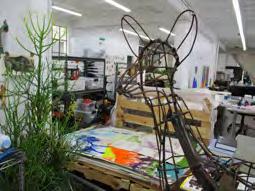
At the same time he had been making paintings of figures riding mysterious mythological animals.
About a year later I begin making a series of paintings, of figures riding totem spirit ani-
4 SIMPHIWE NDZUBE
mals. And as I was looking at the paintings, I looked over at the dog, and just immediately thought, ‘Maybe that’s not a dog.” I realized what bothered me was its four legs.
So he amputates his dog. I cut off two of its legs. Then I welded one back on. Now it had three legs and it really became so much more interesting as a form. And all of a sudden I knew exactly what to do.
Because he’d been looking at some Dumile Feni drawings...

Feni’s like the African Picasso. He’s got all these bronze sculptures, I’m obsessed with them. And I started to look at his studies of figures and horses and how he could elongate and stretch them. I’m thinking how can I look at the Old Masters and channel them? Maybe I could bring them alive again, insert them into my own work.
… And back at a sculpture he’d already made. And then I’d done this other sculpture in 2018 of a figure riding a beast. A beast of burden. So I was also thinking how could I bring back that piece. I had been thinking through this idea, about an elder that has to carry -- through labor, backbreaking labor -- the next generation. It was autobiographical to me, but I was also looking for ways to make it timeless, mythological –broad enough that it’s not limited in meaning. You see in this first sculpture the figure has an arm that is a shovel. I realized I wanted

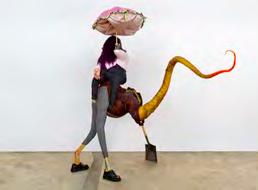
to revisit this series. I imagined them one day coming together, having sort of a procession into Noah’s Ark. I thought of them as two generations, the youthful figure on top sitting on the shoulders of giants.
He draws a sketch of what a new sculpture might look like. I wanted the figure to look like it made of ultramarine stone. I was thinking of a super blue naked figure with a slight lumpy belly and a flag, carried by this threelegged creature.
But the reclining figure doesn’t work. That was the idea. But when I started welding I was met with very practical complications –the neck’s going to be weird to read because the head of the cat and the head of the figure were too close. I wasn’t sure if I would want then to elongate the figure, have an even longer torso and neck. But that became more difficult to build with my hands. Also I wanted to use [a cast of] my own feet and visually it did not make sense, because the feet were too big. So I gave up. I thought maybe not now.
The paintings he’s making at the same time show him the simpler way to do it – with the figure upright. But then I’m doing these paintings at the same time-- and because the painting has the figure sitting up, why not try to make the one from the painting?
He starts building the sculpture. The beast starts to look like a cat. I wrapped it up– and it looked like a mummified sort of ancient-looking... cat? It’s like a sphinx cat but also an African wild dog, with the ears.

5
He experiments with different ways the head might go, using balloons to show him the way . I was trying different heads, weighing possibilities. I’d try things, and then I see, oh, it’s not working.
He draws it out. And layers fabric on the figure. I’m trying to create blocks of texture. I want the sculpture to reveal little bits of pieces.
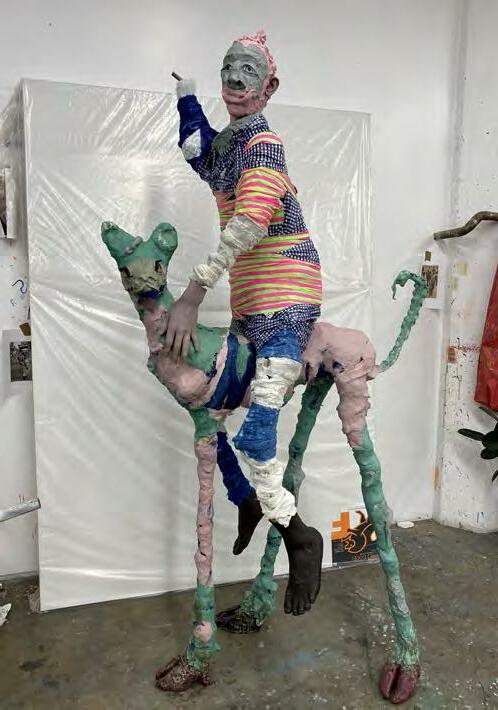
And switches up his materials to make it sturdier. It’s the first time I’m using glass eyes. And I’m building it a new way – with epoxy molding paste rendered on top of a fabric stiffened with cold glue over chicken mesh wire. I’m trying to experiment with creating longer lasting sculpture. I’ve had issues with sculptures breaking in transition. The question is, how do I make it more physically resilient, but also mythologically more open?

He plays with the face, which doesn’t go the way he’s planned, but he’s okay with that. The face is very hard because with sculpture it comes out however it wants to come out. I brought in dentures so it would feel abstract and real at the same time. Playful elements, but also sort of repulsive.
It’s coming together, but he’s still not convinced of the flag. Or the hands, which torment him. What would the flag mean? It’s an interesting statement, but is it really important as a symbol?
The night before it’s set to go out to the Sadie Coles gallery, he’s still

not satisfied. He’s agitated, indecisive. Literally the night before I was still entertaining the flag, I was putting the metallic ball there to see what it might look like. I’m still wondering, what could the flag be? I went back and forth, not knowing.
And then the hands, I was obsessed with the hands! At one point I had the hands wide open like this. I have an extra hand carrying another hand like this. I had some latex gloves I bought in South Africa I was also thinking I might bring into the work.
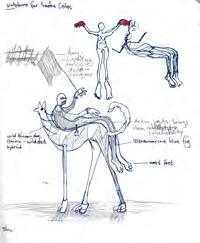
He abandons the flag. And with no time to spare, he arrives at a hand gesture that’s finally exactly right. I had a thick amount of clay, and when it was wet it created this super-lumpy shit-looking hand. It looked muddy; it was falling off. It was the final touch. Nice, interesting and funny -- at least I think it’s funny. I didn’t want to force anything. In the end the easiest things to happen become the ones that feel effortlessly right.
And then the sculpture is done. I shipped it out. It had been a month since the drawing. I think this sculpture is a masterpiece, an absolute masterpiece. But it took its time.
6 SIMPHIWE NDZUBE

7
CAPTION KICKER TEEKAY Figure 13 – Simphiwe Ndzube. Hunter, 2021.

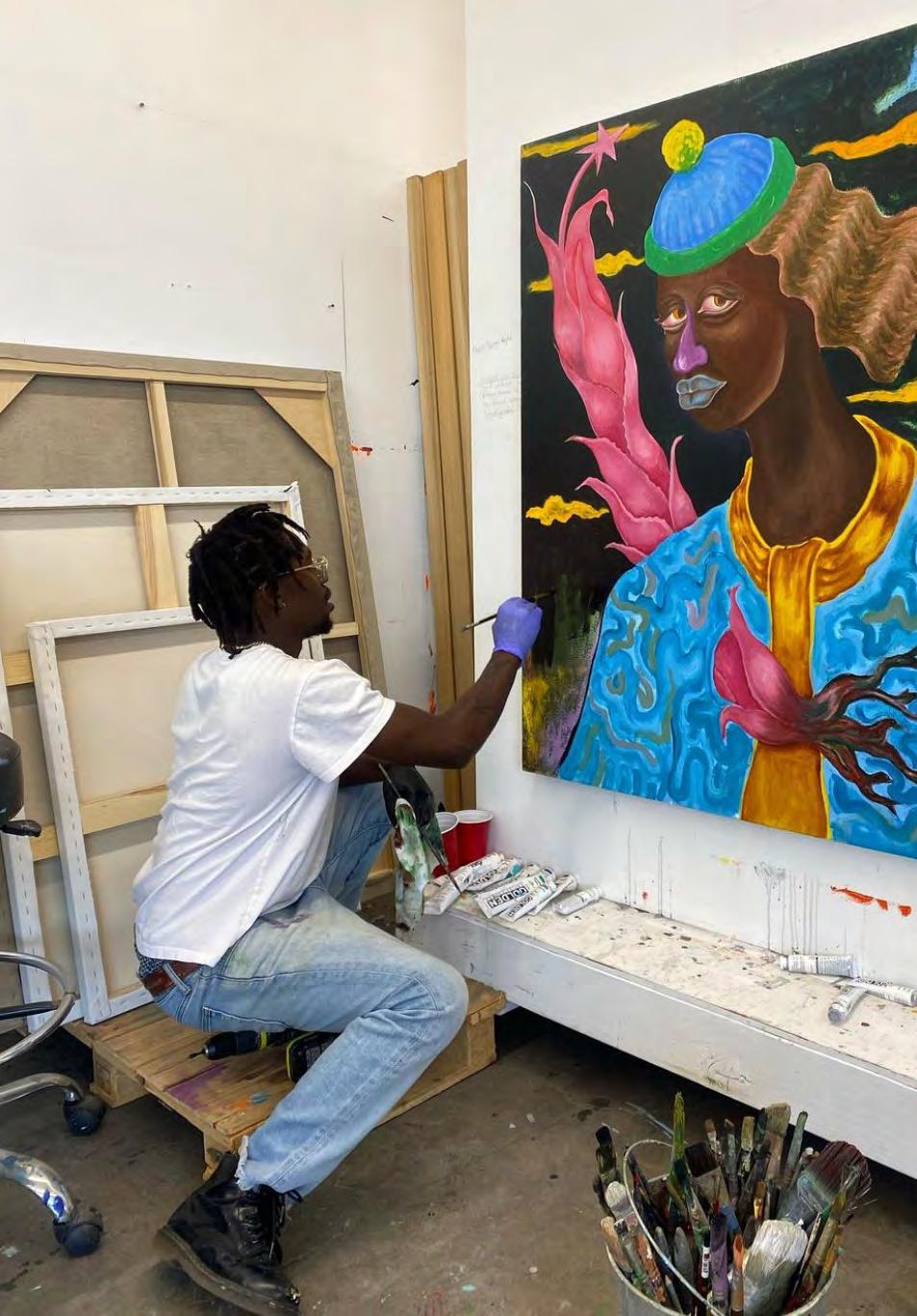
DEAN BAQUET & TOM BODKIN

A ‘Rothko’ on A1
I WAS A COPYBOY AT THE NEWYORK TIMES when I graduated from college, then left less than a year later because I felt like such an oddball there. In those days, people didn’t quit the NY Times. But the paper was a forbidding place, with customs meant to discourage deviant behavior, and when I was twenty-one, deviant was what I wanted to be. What they used to call The Establishment – and the Times was nothing if not that – fascinated and intimidated me, but also held little allure. I was really still an adolescent, and the Times was full of grownups.

I left, went to Rolling Stone, then Esquire, and then started a small, peculiar, (unconventional and amateurish, but innovative in its way-- we bumbled into original solutions to problems because we were young and didn’t know any better) magazine called 7 Days. When that folded, I was invited back into the Times by Joe Lelyveld, then the managing editor, an imposing journalist with a subversive spirit who generally saw the value of making trouble even inside an institution he revered. Joe had admired 7 Days, and felt that maybe the Times could use some of its spirit, though I was never exactly sure what that meant. I was barely 30. Basically I was supposed to go around and ask questions that might help the hide-bound think differently. Most of the staffers wanted no part of me, but I found some colleagues who wanted to bend the place a bit and used me as a safe vehicle with which to give that a try. We did some interesting projects, most of which never saw the light of the day. In spite of efforts like Joe’s, The Times wasn’t really ready to experiment much, and while frustrating to me personally, I came to feel that generally they were right. The Times was a traditional institution, which struggled with change. It could tolerate incremental movement, but anything more threatened to undermine all that was right with it.
Eventually, I found my way to the Times Magazine, which I overhauled along with my boss Jack Rosenthal, in ways that were perceived to be radical within the institution
2 DEAN BAQUET & TOM BODKIN
occupation : Chef work : Salt, Fat, Acid, Heat born : 19tk 30
occupation : Chef work : Salt, Fat, Acid, Heat born : 19tk

3
CAPTION KICKER TEEKAY Figure 1 – teekay Figure 1 – teekay
(principally conceiving it as a magazine with all the properties associated with the form rather than a newspaper supplement) but to me seemed modest. When I became the magazine’s editor, I became more aggressive in pushing what might be done at the NY Times, which made me both allies and enemies at the paper. In retrospect I realize that I felt freer to experiment than my colleagues because the validation I sought was from outside the paper – I wanted to impress my old magazine allies more than the newsroom and I’ve come to see that where you direct your need for approval has a lot to do with the kind of work that you do.
I was promoted, and in my new role attended the Page One meetings. The front page of the Times was in many ways the paper incarnate, the repository of all its values. What the Times said on its front page set the agenda for government, other media, its readers’ very sense of what was right (and mostly wrong) with the world. Its influence was almost incalculable. And so it was kind of a sacred page, very carefully programmed, with rituals of placement and language mostly only intuited by its readers but very much understood within the institution. Journalists at the paper marked their career progress by how often they appeared on the page; editors cowered in the meetings because they were generally meant to; fear was a leadership tool which created conformity. Among the editors in the room were the two I talked to in the conversation that follows: Dean Baquet, who was then national editor and would become the top editor; and Tom Bodkin, who was (and is still, though now from a little distance) the paper’s chief designer.
I wanted to talk to them because on May 24 2020, I awoke to a startling sight. I unfurled the newspaper I still read on paper every morning. The front page of the NY Times had been given over to what looked to me not like the front page the paper had been publishing for 150 years, but something else entirely: a public installation memorializing the first 100,000
Covid deaths: hundreds of names in tiny type (like Maya Lin’s Vietnam memorial in a sense) under one headline, a single image in effect, a wail of grief.
Categorically it was a work of art rather than information, and while you can argue with whether you thought it succeeded or not (I did, but some others I know were less sure), you couldn’t help but see it as an astonishment, a wrenching departure from Times traditions in an institution that was built on them.
And so as I asked my old colleagues to talk about how the page came to be, I also hoped to get some insight in how creativity can work within an institutional setting, the Times being historically a pretty straightjacketed example, and how executive decisions, a simple yes or no, can also function as artistic acts.
A lot has changed since I was there, though it hasn’t really been that many years. Number one change dwarfing all others: the Internet, which has dissolved the paper’s physical form to an enormous extent, making it, as media jargon has it, digital-first . For that reason, the physical front page is a kind of relic, which no doubt liberates its makers from the page’s heritage, though the page is still important. In so many respects, the context in which journalism (and authority, which is almost indistinguishable from the Times’ self-concept) operates has changed substantially, which made the wrecking ball to the page possible. But still, though conditions matter, so do the makers themselves.
At the time of our conversation Dean was the paper’s editor – to my mind, probably the best (aggressive, enterprising, sensitive but not knee-jerk to shifting currents) the paper has ever known, a transformational figure, especially given all the change he’d had to navigate. He says the fact that he was not a Times lifer (he left his post as national editor to become managing editor of the LA Times before returning to New York) gave him permission to toy with Times conventions. As for Tom, he’s a perfectly calibrated designer for the Times, a traditionalist at heart who
4 DEAN BAQUET & TOM BODKIN
is talented, smart and strategic, a mix which always made him an extraordinarily effective innovator within the paper. The three of us spoke twice on zoom, Tom from his country house, Dean from Los Angeles, where he’d been editing the paper remotely, which also seemed inconceivable to me.
Subhead TK
AM: Let’s get right to it. I was looking at every front page in 2020. It’s an incredible piece of history. Simultaneous to the Trump impeachment trial is the Iran standoff, then the first premonition of Covid, and the mounting awareness of its impact, month after month. There’s the election of course, and then just six days after the year is over, the January 6 insurrection. So I suspect they’ll be teaching this in high schools. But it’s covering this first year of Covid that I want to talk about – in one narrow sense, which is the way it changed the front page of the physical newspaper. I’m fixed on the day, observing the 100,000th Covid death, that you devoted the entire page to a wall to wall tiny-type roster of Covid lives lost. That was just such adeparture from the New York Times that I worked at, which was not really that long ago. So I wanted to discuss how you got there, and how you see the front page, in this period of its fading influence, at least as compared to the paper’s digital reach. So let’s discuss what you think you were departing from.
TB: You know it’s funny. I don’t think we were departing all that much. Even though it looks like we are. My focus as the designer is all about augmenting the content, making it clearer, and giving people an emotional connection to it. But it’s all based on the very solid, basic values that the Times has always had. Were you at the paper when we went to color?
AM: Yep.
DB: Me too.
TB: Well, my biggest challenge was to convince people, because there was a huge amount of resistance, both internally and externally to color – that it would dilute our values, be like USA Today...
DB: By the way, I was one of the idiotic resisters.
TB: You were not alone! The great majority
of New York Times employees were against it, the great majority of the public.
AM: Wha t’s the mission of the page to you both? Like, for example, it’s obvious that the front page has always been about creating a hierarchy of importance according to the Times – to say this is more important than that.
TB: Definitely, but it’s also about presenting a physical presentation of the Times’ values. It’s the most important expression of our values. The size of the headlines, the drama you try to create or not. It needs to be substantive, but we want it to be entertaining too. It represents us.
DB: But I think we’ve shed some restrictions in order to realize the vision you’ve described. If you go back in time to you know when I was National Editor, if the vice-president was mentioned in the story, the vice-president’s picture had to be on the front page. A photograph couldn’t work its way onto the page based on its news value. And the values are even more pure now because we’re more honest about the hierarchy. And then the Internet has changed the way I at least think about what stories go on the front page.
TB: Tomorrow’s [fn1] banner will be about the lifting of the mass restrictions.
DB: You can’t ignore the fact that it’s the biggest story of the day. But you also can’t ignore that you told people everything the day before, and that you have to come up with a new way of telling them.
TB: What I do today, I couldn’t really do preDean. (Dean laughs). I’m serious. I mean, changes in media have helped us open up a bit. But editors tend to be very literal thinkers. That’s just the way they’re trained. They’re not meant to be imaginative.
AM: Tha t’s pretty much how I remember it at the Times.
TB: Once you get to visual representations, if you’re rigidly literal, you’re not going to get across what you want to get across and on the front page we were locked. I gotta say, you know, what’s his name? (laughs) Howell... did a little bit of the freeing up. [fn2]
5
DB: Howell?
TB: I hate to admit it. But he did, and partly just because he was really interested in photography.
AM: Wel l, Howell was really trying to make sure every front page was dramatic. He would actually talk about it in those terms. He thought like a magazine editor – or a television producer.
TB: That’s right. And one of the things that got in his way, is he wanted every page to be dramatic. Sort of to an almost equal level. So it’s hard to modulate things. I mean, we’re not going to do what we did with 100,000 deaths without its magnitude. It’s a great example.
AM: Dea n, your tenure coincides with some first person stuff on the page?
DB: More than that, we lead the paper with
analysis pieces now. You have to be able to tell the difference between habit and true traditions. Newspapers used to put first person material on the front page 100 years ago all the time. The traditional New York Times lead of the paper, that’s a silly tradition, to my way of thinking.
AM: If it’s not a banner head [a large headline running the width of the paper], I think people don’t even know what the paper is saying is the most important story [on the far right!].
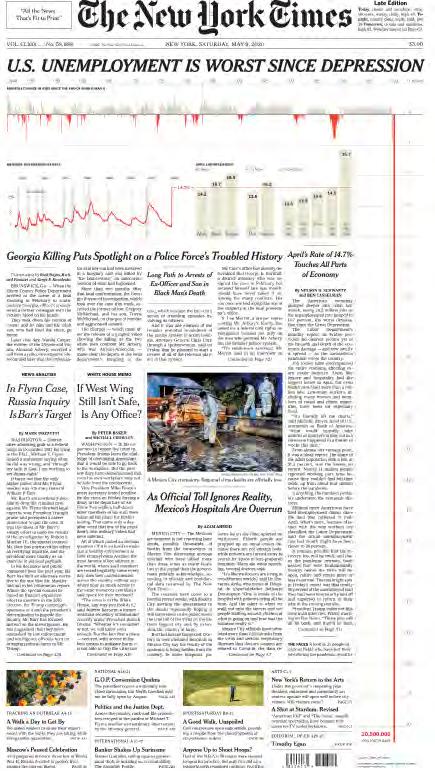
DB: I always thought if you wanted to do a graphic of how the NY Times has changed, and I can say this now, rest his soul, you could monitor the reduction of front page stories by Robert Pear [who covered Congress and policy]. Because frankly most of those stories

6 DEAN BAQUET & TOM BODKIN
CAPTION KICKER TEEKAY Figure 1 – teekay Figure 1 – teekay
were not that important. But the paper had to be dressed a certain way, in lead-of-the-paper clothing. It had to have a certain kind of lead, a certain kind of nut graph. And I think that newspapers, not just the New York Times, inflated stories that were not that important in order to meet this standard. And it was sort of ridiculous, right? If you look at traditional Times leads in the paper fifteen years ago, you’ll see modest changes in Medicare policy that were not that important. But they looked like lead-of-the-paper stories.
TB: I have a philosophy about design that I sort of refer to as progressive engagement. When people look at something complicated like the New York Times, they first have an overall impression. What is the tone of the

day? What is the feeling? And then they start focusing in.
DB: That’s very much an artist’s or painter’s construct, right? People get a feeling, then look at detail?
AM: Who are you editing the front page for at this point?
DB: Well internally we’ve changed. The big front page meeting doesn’t exist anymore. There’s a meeting, we talk through the front. But you have to acknowledge that even though there is still such a thing as the most important story of the day, if it happened early, you’ve got to find a way to tell people something different. I mean, even if you – the reader I mean-- are not on your phone constantly, you have a general sense of the news through the

7
CAPTION KICKER TEEKAY Figure 1 – teekay Figure 1 – teekay
osmosis and conversation. Also, what is news has changed a little bit too. The budget, the things that used to dominate the front page, are not as important as changes in the way people live their lives. I’m driven very much by the belief that the New York Times has to have as high a percentage as possible of things nobody else has. You know, Joe Lelyveld, who I love. I hope Joe doesn’t read your book. [I laugh], there were two quotes in my mind from Joe about the front page. One, in retrospect was silly, as much as I love him. I broke a story with Jeff Gerth years ago, as a reporter, about the Clintons, and I don’t even remember what it was, but Joe wanted the presentation to be restrained, which I respected. But his quote was “I want people to think we’re sort of reluctant to bring them this news.” As much as I love him, that’s ridiculous. But I also remember one other thing that he said that was powerful. Someone, maybe Arthur Sulzberger Sr, someone from the family, died and Joe said something like “What I like about this front page is that it looks like the paper’s in mourning.” And I thought, it showed such respect for the role of the front page.
AM: But both comments reflect the extent that one of the functions of the front page is to create an affect. The first was tentativeness, the second grief.
TB: One of the things that print, at the scale of a newspaper, can do, that is very difficult digitally is work like a canvas— express very broad emotion but also offer detail. The internet is very much a sequential experience. You’re scrolling.
AM: Is there an extent to which the declining print readership actually liberates you? I think the answer is going to be no, but I’m just asking.
DB: It’s funny. I was gonna say yes. I don’t feel pressured to get some stories on the front page. They’ll get good play somewhere else.
AM: The print edition has different readers than your digital edition.
TB: Yes, the print reader has made a very deliberate choice. So for them you want a slower, maybe deeper experience.
AM: Do you make the page for historical purposes at all?
DB: You know today we had a conversation. I argued that we needed a banner about today’s news, about the lifting of the mask restrictions. [fn3] And the science desk tried to convince me that we shouldn’t use it as a banner, that we didn’t learn a whole lot more about the science. And my view is that when people go back and look at the front pages of the NY Times, you’ve got to have a banner headline on the day they they were told they didn’t have to wear masks if they’re vaccinated. That is a fucking big deal. There are moments.
TB: The moment thing is super important. Often I have to argue for a bigger head than my colleagues want to use. Newspaper editors, except for a few exceptions, they’re very literal. But Dean understands. And I think part of it is because he does appreciate art.
DB: It’s also because I left the paper. [fn4]
TB: Yes, that helps.
DB: I’m not as involved in the front page choices as my predecessors were. And I did that consciously. And it was hard. When I first became managing editor of the LA Times, I sat at the head of the table and picked the six or seven stories for the front page. And Jon Carroll, who was the editor, very gently said to me, “I know that’s what New York Times managing editors spend their time doing. But if you spend your time doing that, here are all the things you’re not going to do. And you’re going to send a signal to the designer that you’re making all the choices, and his job is to just going to be to put scribbles on the page.
TB: Dean, you know I have to say this. [Dean laughs]. But you have to put an editor in charge of that page...
Dean: I know, I know. This is a constant conversation Tom and I have...
TB: ... [The current setup takes “a lot of energy” arguing], and it probably keeps me sometimes from doing what I like to do.
AM: All right, let’s talk about the Covid pages. The way I see it, you had three front pages before the May 24th issue, where you were dipping your toes in a major disruption of storytelling techniques through graphics on the page. On March 27th you have a job
8 DEAN BAQUET & TOM BODKIN
losses graphic that takes over the right hand column. On April 16 you use a graphic as the second line of a banner headlines – it’s about stores. And then May 9th was very dramatic, with unemployment figures plummeting. I think maybe it was even in color.
TB: There was one other.
AM : Where you pierced the logo...
TB: And the peak went through the logo. I liked that one a lot.
AM : So, all of these were departures before you got to the 100,000 day. I wouldn’t call them baby steps because in other times they would be considered gigantic. But in the end, they pale next to the 100,000 page. Was there a debate among all those literal editors?
Tom: Yes. There were real concerns, but people were willing to let go of some of them. These numbers are almost a metaphor, and a lot of things artists do are metaphorical. I mean,
SPEAKING IN A DIFFERENT LANGUAGE
I wanted to also talk about another huge shift in the front -page, the use of more subjective language that came with covering the Trump administration. AM: Can we talk about the other stories of 2020? Specifically I want to ask you about the escalation in the language you used to describe Trump, especially in front page headlines.\Dean: The first discussion was over the word ‘lie’. I mean, all politicians lie, right? But he was clearly playing in another league. And in the back of my mind, I was looking for a moment to use it. And the one time we did it it was so clear. It was when Trump backed off from his statement that he said Barack Obama was not born in the US. And he went further than that. He said I have hired people, they’re looking at it, and they’re finding very interesting things. So when he finally said he didn’t hire anybody, he conceded that was a complete lie and we used the word lie. But I still wanted to make it so that every time we used that word, I wanted to sign off on it. Because I was wary of slipping. I’ve always been a little bit worried about extricating from it.
I was wondering if you were.
Dean: I mean, some of the loosening up of language should continue. We should never have done all of the crazy backflips newspapers went through to keep from using the word ‘racist.’ In retrospect that was ridiculous. But I think the way we’ve made it easier to extricate is that we didn’t use the word lie too often. I was a jerk about it sometimes. But there was another powerful front page when we decided to really call him out for subverting the election.
One that really struck me — it was a six column banner on a piece of news analysis by David Sanger. The headline said Trump Escalates Push to Erode Trust in Vote. And the deck described what he was doing as “baseless attacks threaten a process in place since 1788.” And yet that day’s news wasn’t all that different than what he had done the day before. So you were making an overall characterization.
Dean: That’s the one I was thinking of. I signed off on it. I just wanted to do it. It was a drumbeat. We probably could have written that headline three, four days before. But we needed a vehicle to actually call it in a much more dramatic way.
Me: Do you feel you go over the line sometimes?
Dean: I’m not shy about it. We go overboard sometimes. On the headline on the story about the George Floyd anniversary, we used the phrase “call to action.” I thought that was too much.
9
this is not normal. And I feel almost an obligation to do something different. I want them to look at this page and say Shit, the Times must think this is really huge.
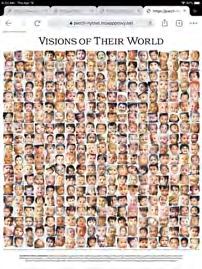
AM: Was there a sense of momentum, one of these changes emboldening the other?
TB: The first was the hardest in terms of convincing my colleagues that it was going to be okay. But once we did it, the reaction was positive, right? And after the first, I felt, okay, we should look for other moments. And the next moment was when retail sales fell to nothing.
AM: And did you feel that you were in any danger of hooking the reader into an expectation that you’re now going to be speaking in this more dramatic language?
TB: No, because variation is important. And you don’t hit 100,000 deaths every day.
AM: Okay, so the 100,000 deaths.
TB: I think what probably happened was Marc Lacey, the National editor, said something like the day was coming in a month or so, and we’ve got to be doing something special for it. And it was Simone Landon [id]’s idea to gather all these obituaries; an algorithm was written to pull them all from different sources.
AM: So it was imagined as a project for inside the paper.
Tom: I wasn’t even aware it was going on. My initial thought was hundreds of tiny little pictures. Because what I do, this is my designer’s head, is I try to reduce things. And what I’m thinking is we want to express two things: the magnitude, and the humanity. It’s 100,000 people dying. So you know, what does that look like? So tiny faces filling the whole page. And I started talking to the picture desk about it. And they were man, that’s gonna be hard to get a hundred thousand, you know?
So maybe two or three weeks before, Marc Lacey calls and he says he’s seen all these special pages now, and I think, you know, a lot of names would have the same impact. And I thought the important part was the putting nothing else on the page. And I knew that would actually be very hard to get anybody to agree to, except Dean.
AM: You brought this to Dean?
DB: You sent me a text, or an email.
TB: I’m pretty sure that’s exactly what I did. To work at the NY Times effectively, you have to be very good at strategy. I didn’t have the patience to convince every literal editor. I knew that the editors would say well, don’t we need a few refers [fn5] at the bottom of the page?
And I decided I’m not going to discuss this with anybody, I’m just going to fucking do it. And then I’m going to show it to Dean. Because I knew Dean would get it immediately.
AM : Ok.
TB: And at this point I’d been convinced that a typographic solution was actually better.
AM: In some ways it deviates less than the pictures.
TB: Correct! We fooled around with a lot of ways of doing it, different columns and stuff. And I thought, even though six columns isn’t maybe the best way to present this content, I want six columns and column rules – minimal other changes to the page.
AM: Let’s switch points of view. Dean, what do you remember?
Dean: Tom emailed me a mock up of the page.
AM : Ok.
DB: And I don’t remember having any hesitation at all.
AM : Rea lly?
DB: Maybe I’ve romanticized it a bit. But... [phone rings] oh, let me call her back.
TB: Yes, now she’s calling me because she wants to make changes on the page...
Dean: So my recollection is, no hesitation.
TB: I knew you would get it.
Dean: It did not feel like it wasn’t the New York Times. I got a couple of calls from editors who said, “You sure?”
TB: I didn’t realize that. Really?
DB: I won’t tell you who. Anyway, like twenty minutes later, just because whenever I deviate,
10 DEAN BAQUET & TOM BODKIN
when I deviate that much, I sent a copy of it to AG Sulzberger. Just because the publisher should not be surprised. And my recollection was, he had a one word response. “Wow.”
TB: It didn’t really matter what day we did it, because we were approaching 100,000. So we decided to do it on a Sunday. Partly because of the circulation on Sundays. If you’re gonna do it…
[Dean hops off to deal with the front page. Ultimately, Dean does not get the banner head he’d wanted. In spite of his belief that the CDC decision on masks was monumental, the foreign desk editors convinced him that a MidEast development was important enough to interrupt the banner. That development would prove to be not monumental. So, by the way, would the CDC rulings on masks. Covid surged again, making the decision basically moot. In any event, front pages are not prophesies, though sometimes they pretend to be.]
We talk again a few weeks later. Dean has just come from another page one conversation.[fn]
DB: So F Lee Bailey [fn6] died. And I asked the young woman who runs the meeting what do you think? And she said I’m not sure. And it suddenly dawned on me. She had no fucking idea who F. Lee Bailey was. And in the post-meeting, that whole generation never heard of him either.
TB: Really, well it’s been a while, right?
DB: It’s not like he was a slam dunk, I don’t think. But… slow news day.
AM: Back to the 100,000 COVID death front page, what was the reaction mostly.
DB: It was almost all overwhelmingly positive. The only negative comments we got were from the school that thinks COVID is overstated. They started to look at each case to find whether there were a couple of people…
AM: Who hadn’t died of COVID?
DB: And they actually found one or two. Between editions, we changed a couple of them. But really the reaction was good. They got what Tom was trying to do. You know, I’m a big Rothko fan.
1. We spoke for the first time on May 13, 2021. It was the first time the CDC relaxed its Covid mask mandate.
2. Howell Raines, the executive editor of the New York Times from tk to tk, when I was at the paper, had a turbulent tenure, and resigned in the wake of the Jayson Blair plagiarism scandal and a staff revolt over his management style.
3. Jeff Gerth was an investigative reporter who often worked with Dean
4. In tk, Dean left the Times to become managing editor of the LA Times. He returned in tk year.
5. a ‘refer’ refers to a bit of copy that directs you to other copy. The bottom of the front page is taken up with refers
6. Our second conversation was on on June 3, 2021.
7. F Lee Bailey was a flamboyant trial lawyer, bestknown for representing OJ Simpson.
Because Rothko was trying to do the impossible. He was trying to paint emotions. I actually thought that page was trying to portray a feeling. Nobody was going to read it name by name. It was like a Rothko. And the longer you look at a Rothko the sadder you get.
11
ELIZABETH DILLER


Theory and Fog
WHEN I FIRST SET OUT to talk to Elizabeth Diller I thought we’d discuss one of the subtler, unshowy projects she and her colleagues at Diller Scofidio & Renfro have taken on that have altered the way I experience New York City. Maybe we’d talk about the High Line, the park they created around abandoned train tracks, which reimagined an urban idyll. Or, the ingenious renovations at Lincoln Center and MoMA that intelligently reshaped two pivotal New York cultural institutions. Or even The Shed, a shape-shifting Transformers-like performing arts venue in the otherwise
2 ELIZABETH DILLER
31
occupation : Chef work : Salt, Fat, Acid, Heat born : 19tk
execrable Hudson Yards. So much of modern cultural New York has been touched and made better by Liz Diller’s hand. Trophy buildings are always fun to gawk at, but they don’t generally improve people’s living experience. For the most part, the restrained and introverted work Diller and her team do has a positive practical effect. It’s more about brains than drama.
But as I started poking around Diller’s past work, I came upon something dramatic in the extreme -- in a sense, useless -- and I couldn’t let go of it. It became clear that it’s the project
I wanted to feature here, even though I hadn’t experienced it myself and never would. That project, certainly no secret to anyone who follows her and her work, is the Blur Building. The Blur Building was made entirely of water. It sat on a lake (Lake Neuchatel, in Switzerland). It was erected as part of an expo in Switzerland in 2002, and was temporary. The “building” was a wildly inventive spectacle, a work, more or less, of art for art’s sake. It is a building whose material is as much theory as it is fog.
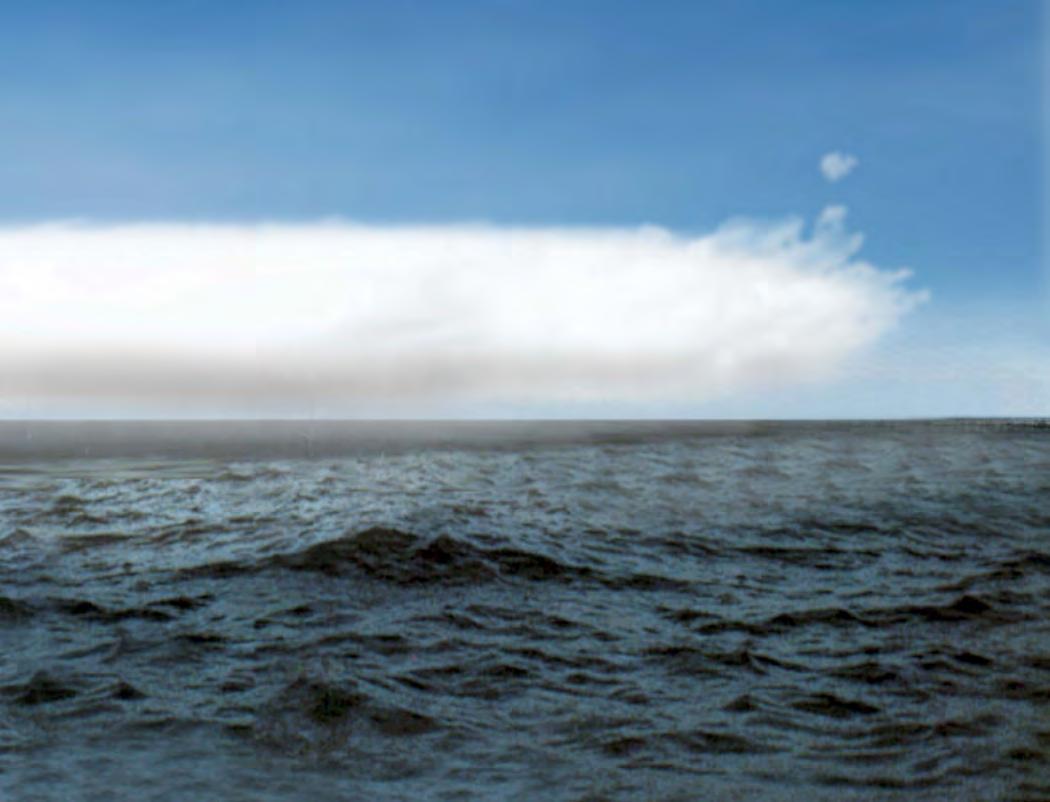
3
Blabor anti dolut rerum de andel ste voluptio blabor anlis.
Elizabeth Diller is cool and cerebral (with short hair and glasses in a Rachel Maddow style), but also slyly playful. She began the firm with her husband Ric Scofidio. She was Scofidio’s student before they married. Diller, whose parents emigrated from Poland when she was five, is a multi-disciplinary artist as much as a straight-ahead architect. The firm’s early work included many art installations (2500 traffic cones in Columbus Circle!), and the project Diller seems to describe with most enthusiasm was a Mile-Long opera she staged with a thousand singers at the High Line.
The Blur Building was about one-third art installation, one-third performance piece and one-third building. It was the product of a vision, simple and immediate, that she (and her husband) could see but nobody else could, and that she herself tried to complicate before it was reduced to its pure misty essence, a project, like much great art, insane and obvious at the same time.
ELIZABETH DILLER:

Some of our projects are commissions and some are just out of our own research. They come you know from nothing, so there’s no brief,
right? So the first imaginings are likely to be sketches. I used to keep sketchbooks, not in a very orderly way, just whatever was around. And then I started to doodle, on anything, a napkin or menu or whatever. I think the act of actually drawing something, sketching, imprints something in my brain. And it’s important to record because my memory is really bad. But I’m able to sear concepts in my brain that are the product of a simple doodle. I have lots of ideas. They evaporate like dreams, unless I write them down, or sketch. Something nags at me and I don’t really know how to get there when I believe there might be a solution. And then there’s also the old agendas that keep coming up. Like the complexities of vision, issues of voyeurism, exhibitionism, control, surveillance that somehow come into every project. It’s like a parallel agenda.
Blur Originally there was a competition for the Expo 2002 in Switzerland. It was an art expo. My studio was asked by a couple of collaborators if we wanted to do it. Our work was known to some of these Swiss folks just because we’re interested in large scale projects, I think the High Line was maybe in the
4 ELIZABETH DILLER
Blabor anti dolut rerum de andel ste voluptio blabor anlis.
works. So in our conversations I was promoting the idea of building on the lake; other team members wanted to stay on land. I thought, because this is one of those lifelong themes, about tourism, sites that are produced to be exclusively seen by tourists. There was no particular brief – it was solely to make a proposal for a large scale installation. We were shown the location and asked for an idea. But the water was never offered as a site; it was the backdrop for the site.
Our team was largely focused on landscape. And we came up with some ideas around the landscape, cutting through the landscape, making a sort of typography covered by flowers. I was pushing the team to build on the lake because though the lake was the backdrop maybe it could also be the experience, even the building material. And everyone thought it would be too big a risk to take,we would lose the competition. And I said, let’s take a chance. So we sort of split apart and did different things.
We were thinking of the problem of vision, and this was the first years of the 2000s, so were also preoccupied with technologies. And our early inspiration was about the water – can
we atomize water? As a critique on our ocular-centric culture. Can we block off vision, can we problematize it in a kind of beautiful way? And we got a vision of the cloud bank. It was partly just surreal, you know? It sort of popped into our heads. You know you can’t explain everything, right? There’s this critical analytical mind that’s kind of reading the place. And that’s rational. But then there’s a kind of itch, you keep wanting to scratch it. You know, like Ric and I might be in the middle of dinner and find ourselves drawing on a napkin . It rarely comes when you sit down and focus on the work. All of a sudden, you think of something. It’s indirect, one thing starts the sparks that connects the other synapses. I wish I knew how it works because I would want to trigger that more often.
Can this be done? So we had this fog bank with no other reason to be but problematizing vision. And it just made total sense to us. And that was followed by, how the hell can we do that? The artist Fujiko Naykaya had done a project in a 1970 expo of a building that was totally obscured by fog. So she was the expert. We went to her, said we want to make fog. We don’t

5
Blabor anti dolut rerum de andel ste voluptio blabor anlis.
want it to be a building, there’s no interior, just fog. And she said, well you can’t really do it. Because the fog isn’t going to stay in one place. And then we said what if we made a thinking structure, which, when the wind blows[it registers the shift and] makes more fog. She introduced us to some guys who manufacture nozzles, for agriculture.
Oh, I forgot the part where we won the competition!
We just wanted to make a cloud on the lake. An ozone inspiration. So for the purposes of the Expo, we showed a cloud. But once we won for God knows whatever reason, we said Oh fuck, how do we actually make this?
And the process became fuller and more interesting as we developed the structure, a tensegrity structure [a three-dimensional base, which plays tension and compression pressures against each other for stability] very lightweight with four points that touch the lake bottom.
We got a structural engineer involved. And at some point we decided that we wanted white noise, we wanted to add another layer of sound. And we asked Christian Marclay [ fn1 ]if he would collaborate. He made a beautiful soundscape out of drips.
The Braincoat That Wasn’t And then we also began to envision “the braincoat,” a raincoat that could be worn in the structure, that would
sense out other people because you couldn’t really see who you were passing by, but you might be able to respond to in some way. And so the idea was that you could fill out this questionnaire, and we worked with the writer Douglas Cooper. [fn2 ]We would make a compatibility index, sort of like matchmaking. When you come close to someone there’s a little display on their chest – pink was affinity, green was the opposite.

We were working with IDEO, we designed through it to a certain degree. But we didn’t end up doing this because we had a sponsor for it, and we lost the sponsorship. I was very upset that we lost it. But people encouraged me, saying it’s really good, just what it is, without the raincoat. The raincoat was a hard loss.
Then we thought about projecting on the fog, and you can see some of these were bad ideas. Because you can’t actually project on fog. And we wanted to put in a restaurant that would be a dry space with a hole and then the two parallel glass walls would have special fish.
And then, there was the lake. One of the things we didn’t anticipate was the water quality. We started to test the water. And we were panicked, totally panicked. Because if [polluted water] is in your lungs, you know it’s Legionnaires disease. We could kill off an entire population! We went to work on the filtration system.

6
ELIZABETH DILLER
Shortly before we spoke, a project in London – the Centre for Music, a concert hall, for which they’d done a very ambitious design -- was scotched --. So you know, architecture. So much of our work is based on competitions or direct commissions and these projects are never secure. Funds need to be raised. Approvals are needed – from the city, the general public. Take the High Line. It was a competition before it was a real thing. There were five different visions, and ours was selected. You may not win, chances are you won’t. But you have to enter with the belief that you’re going to get it. Otherwise it’s hard to muster up the energy. You have to sort of fall in love with someone with the potential of being rejected. For the Music Centre, we won the project – unexpectedly by the way. But Brexit made it very difficult for the orchestra, and Covid made it nearly impossible.. And that was that. Disappointment is structured into architecture, and we are used to it. But every time it happens, it’s crushing.
What
Makes a Bad Idea. A bad
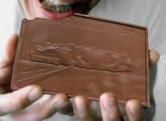
idea is something that’s extraneous to the whole thing. The self-editing process is as creative as putting the ideas on the table, you know? So we decided sometime that this was not about video or restaurants. This was an exposition with nothing to see and nothing to do, except contemplate our dependence on vision. There are more ideas than there’s really space for. And the hardest part is the self-censoring. One idea is stronger without the other. The problem with a lot of people who do creative work is this tendency to oversaturate projects with too much. And it turned out that some of the ideas were totally unnecessary. What was most interesting was just getting lost in the fog. The surreal image of the cloud was what made us win. In the end, all of these other elements might have been a distraction from what was really powerful.
The Experience of Blur You’d enter the building on a ramp. Someone would just come into focus and then pass. You didn’t exactly know where the stair was. A gust of wind would come in and the cloud would move. And then it would fill back up, very quickly. Architects typically build things where you can predict, more or less, how people will behave. In this we knew so little. And then there is this thing called the ion effect. I didn’t really take it seriously. But then we did the piece and I felt it myself. When a certain kind of light would
hit the water, it created a kind of ethereal, beautiful feeling. It made you kind of overwhelmingly happy, like a drug, you know?
We got really bad press for the project, though that didn’t stop people from coming. [Over a million people visited.] The response was, why would you put money into this problem of fog? Fog was a bad thing. Afterwards it became a national symbol. We realized in reading about it that it came to symbolize Swiss doubt. Switzerland was always sort of this in-between thing. That hadn’t been in our mind at all. Some people even had a religious reading of it, that it had to do with the Ascension.
P.S. After we talked about Blur, we discussed public space in New York, a subject I think a lot about. Most of it wasn’t relevant to the Blur project, but I’ll just leave you with this, as an indication of how her mind works while musing: “I’ve always thought that all ground floors should just be open, and you should be able to walk through every building, to the other side though the block, it should just all be public. These spaces could be porous and leaky. Not private taps, you know?”
I loved that idea.
7
1. Christian Marclay’s artistic work is often about sound but he is probably best known as the maker of the 24-hour film, The Clock.
2. Douglas Cooper is a novelist and short story writer.
DISAPPOINTMENT
Blabor anti ste voluptio blabor anlis.
ON
IAN ADELMAN & CALVIN SEIBERT
Here Today, Gone Today
occupation : Tktktkt
work : TKtktkt
born : 19tk
ONE DAY AT LUNCH Ian Adelman took out his phone and showed me a picture of a sandcastle he’d built. Ian and I had worked together for years He’d designed the universe of New York ’s digital publications, each with its own original feel, each its own theme park. He was a world-builder like pretty much everyone else in this book but in the corner of the web that made journalism, he was also a pioneer, the best anyone had ever been in a medium that leaned more towards utility than art. In my view, he was the first true artist in the field. But that’s not why I wanted to talk to him. He’s a creative polymath, and a true obsessive. Once I saw his sandcastle, which looked like an elaborate architectural model and was very beautiful in my view, I thought it would be interesting to talk about making art – a kind of art – as an all-consuming hobby, not a term he liked because it trivialized the effort, but still, as something he did just for the love of it. He was an Elizabeth Diller of the sand. At that point he was building sandcastles feverishly. During the pandemic he’d moved to Water Mill, a beach town in eastern Long Island. Mornings he’d get up early and set about creating another modernist structure, one that would more or less disappear by day’s end. That seemed interesting to me too, creating something meant to perish. So I went to his house one day, and we talked about sandcastles.
occupation : Tktkt
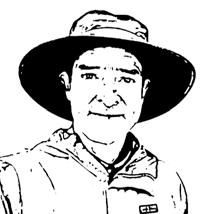
work : Tktktkt
born : 19tk
An Arty Kid His mother was a painter. He grew up largely without a television. He built forts from materials he found in the woods. “I made models, scale models, this whole diorama thing. Even before I thought about it as a term, urban planning, I was interested in shapes, roads, how everything interacts.” He used fabric paints to make rock t-shirts –his friends asked him to draw on their jeans. He designed the lettering for his yearbook. He was just an arty kid, restless at the beach so when his father, a scientist, made drip castles in the sand, he would join him. But it wasn’t as if making things in the sand interested him that
2 IAN ALDELMAN & CALVIN SEIBERT
32
Dolut eliciisqui te volupti ne et fuga. Sit quiae.Nemporat empore inis se natur sinctem perions equibus repudae susapel entium sapiend istoria aut que imporro et et labo. Ore offictur, unt apelent eum quaes eaquia sinum




3
A CASTLE IN TODOS SANTOS, IN STAGES.

Intureptum ut mint videm et est quatem quidis ut es utem comnihillaut re aut repro ev eaturep tatur, velique perovidus et fugia nis nullat.
1. It was New Years day, we were flying out the next day. I knew the sand was great. I began at 7:30 in the morning.

2. I wanted these forms to intersect. I often like asymmetrical sloping things and I like making solids that intersect. I drew in the sand so I could remind myself what I was trying to do.
3. My plan was to go there and start building maybe half hour after high tide. So it would be tide line. The water would be close to me, while I was building. Also the sand had been underwater, and it’s incredible sand,

4. There’s always a first cut. And immediately I start going away from my plan. In my sketch there was a symmetrical tower. But as soon as I did that I wanted something different.

IAN ALDELMAN & CALVIN SEIBERT 4
5. At some point I thought I would just take a big slice out if it. Which is what I did. I lost the crispness so I thought I’d turn it into a curve. I don’t know if I like the way it looks but I’d done it so I had to work with it.

6. I’m thinking, am I going to be happy with how this feels. What am I going to do with this, right now? Am I going to embellish it? This is literally all I’m thinking about.
7. I completed the structure – let’s see – at 3:40, so eight hours later.


8. And I actually ended up not being super happy with it. I find the form a little weird. It ended up even more elongated than I imagined.

5
much. He went to the Rhode Island School of Design, became a graphic designer, eventually came to join us at New York . No castle-building really, except as a way to relieve his boredom while everyone else was laying around.
A trip to Tulum One visit to Tulum, a beach town in Mexico, changed all that. “When I first went to Tulum, it was the first time I experienced sand that I could basically sculpt. The sand was so fine, it was like making a snowball. And clean – no pebbles or small rocks or driftwood. On the beach I got increasingly ambitious. Because the Tulum sand sticks together so well, I could make different things, like a whole bunch of spheres joined together, with space underneath. The sand was like clay. I improvised. I wanted to create something that in the sun would look like a dazzle camouflage, all angles, ideas like that.”
When he returned home from Tulum, he got more obsessive –building castles in Water Mill and Brighton Beach, Coney Island –wherever he could find sand around New York. He’d spend the better of the day, alone, making increasingly elaborate angular structures. It’s worth noting that what Ian does for a living requires him to work in a company, with a team, which isn’t always the most satisfying way to make art, and maybe especially for Ian, who has strong convictions and can get gummed up when he thinks things a process has gone awry. Building castles is a project free of consensus-building – just Ian alone in the sand, building with his hands, away from his keyboard.
Ratcheting Up “As I was doing it more I really wished I had something to form things more effectively. So I went to the hardware store and bought some masonry. I had never carried
water to make sand wet, I would just kind of dig until you got to the wet sand. But once you introduce your own water and combine that with the hand tools, it opens up another world. I often have the desire to outshine the thing I did the day before. Over time that’s harder to accomplish. But with tools, I could approach it with a particular intention.”
He gets an idea, sketches it so he internalizes it, but rarely brings the drawings to the beach. He goes in the early morning, when it is empty. He avoids the sun, which is a castle-killer because it dries out the sand. He’s fond of arcs, intersections, planes, swoops. He makes letter forms, was going to do the alphabet, got to G. “I’ve made things that feel like they belong in some sci fi world-building. It’s that intersection of the kind of rectilinear architecture that is that part of the popular imagination of the future as rendered by the people in the past. You see Dune ? There was a lot in it that made me think about things I’ve made.”

The tao of it Ian describes his psyche as he’s building as one of almost perfect focus, no wandering grocery lists or stray anxieties, just a locked-in mind-meld with the sand. “I decide something is done when I run out of time. Part of the appeal of working sand is that it’s temporal. Because it’s temporal, stakes are lower. Sometimes people ask if I’ve thought about working in stone? I’d be frozen, I’m not ready to do it.
“Glass is really the closest thing. In its liquid state you can manipulate it with your hands, there’s a full spectrum of stability and it’s incredibly tactile. That doesn’t mean I’d feel comfortable with it. It requires years of training. Sand is freeing. You don’t have to worry about wasting material, and you get instant feedback on all the decisions you make. I’m
6
IAN ALDELMAN & CALVIN SEIBERT
pretty disappointed if I’m not happy with it, but in the end it’s just sand. If I spend a long time building something up and a big part of it falls off, it’s frustrating but you can still find a way to make it into something. And sometimes it’s actually intact the next day. I can just dump water on it, pack it down and put more on top of it, turn it into a bigger thing. Then once it’s bigger than you, it takes on a whole other dynamic. Definitely more dramatic. I get excited thinking about it. Just that feeling.”
The word feeling comes up a lot as he’s talking. Not emotional feeling – actual body sensation. All of Ian’s obsessions are physical in significant part: he is an intense cyclist and cycle-builder; also a dj. “As things gets bigger the physicality takes on a whole other thing. I like to ride my bike in traffic because I love the feeling of always calculating. But also the way you use your body responsively. I think of working with sand the same way.”
Performance Sand castles are made in public: “People are always part of the equation.” Generally he is left alone, but people sometimes try to engage him. “I was at Brighton Beach, and a man came over who’d emigrated from the Soviet Union and he saw something in the forms that made him think about constructivism. We just talked for an hour about Russia and the Soviet Union. And I liked that because it is a performance.”
And then there are kids. “Kids are typically awed when you’re building – until you leave, then they want to kill it.” Ian recalled one instance when a young boy just started to build his own castle near the one he was building. “He came over and said, look, I’m an artist too.”
Instagram Ian records all his castles, and posts them. “I’m making two objects now, the castle and the picture. The picture is its own piece. In many ways it’s an opportunity to get validation. And when you start posting stuff then it’s almost like you’re expected to deliver.”
For a long time, as far as Ian knew, he was the only one pursuing sand castle-building with such zeal. “And then there’s one I made with balls of sand. Someone commented that it’s almost like Calvin Seibert level. And I was like, who’s Calvin Seibert?”
And that’s when he learned he had a doppelganger, who was also making elaborate architectural structures in the sand. They weren’t exactly like his, but they were close. Calvin Seibert, who is a sculptor who’d moved recently to Denver, was an Instagram superstar. “I love a lot of the stuff he makes; it’s without question super impressive. All the time people send me images of his work and say, Look at this guy, he’s copying you.
“I’m like no, he got there first.”
So I thought it might be interesting if I hooked up the two of them for a conversation.
A Conversation with Calvin Seibert
AM: Hav e you guys ever spoken?
CS: We talked to each other on Instagram. I knew he had those bikes. How many are we looking at?
[We are on Zoom. Ian is in his workroom].
IA: There’s three built bikes on the wall, one built bike on the floor, and one frame on the floor.
AM: Calvin, how did you start making castles?
CS: I grew up in Vail, my father started Vail, and so I was surrounded by construction. I played in the sand piles of construction sites, and my mother, in order to keep me out of the sites, had a full load of sand dumped in our yard. A truckload. And then I started to make things out of concrete, using my mother’s KitchenAid mixer to mix concrete. We made roads and dams and little ponds.
I always thought I was going to be an architect. But looking back now I understand I was really a sculptor. And then I went to New York, went to SVA [School of Visual Arts], would make castles at Jones Beach, the Rockaways. My sculpture was always architectural, the sand castles have always been architectural, modernist, hard-edged.
7
Dolut eliciisqui te volupti ne et fuam explabo. Obis ea autate. Ihilla audisqu. Nam volo dolupta
IA: Precision is a pattern for you.
CS: But I’ve been trying to let that go. My whole life is about letting go. Because my early sand castles were very severe, symmetrical, even. And that’s just a trap.
AM: Yo u make sculptures now with other materials?
CS: I’ve been making stuff out of cardboard. In New York, I’d visit the galleries on recycling days and get this really clean cardboard out of the garbage. But at the same time I was going to the beach to make sculptures out of sand.
AM: Were you attracted to the perishability of it?
CS: Didn’t care. Still don’t. I do drawings that go into boxes and I never look at them again. I just like doing it. I’ve never had much ambition in terms of getting my work seen, though obviously I take pictures. And I’m ambitious about the work itself.
IA: For me a very specific thing happens. And I don’t want to suggest that it’s necessarily the same for you. But I have ADD right, and I take medicine for it, but one characteristic they say of people who have ADD, they have this ability to hyperfocus. The only distractions are the formal ones within the thing you’re making. There’s something about these intense isolated moments of focus that are deeply satisfying.
CS: It always goes the same way for me. I’m very optimistic at the beginning. And by noon or when it’s really hot I just want to go home. But I get through that and by four I’m much happier. It gets better, that’s a constant. And I think a lot of artwork is like that, the next morning you wake up and realize it’s not so bad.
AM: Of course, with sandcastles there’s rarely a next day.



CS: Sometimes you can get a really nice picture the next day, of the half-destroyed castle.
IA: Do you have a plan as to what you’re going to make?
CS: I usually arrive at the beach with no notion. Well, one notion, I say yesterday you made curves, today you’re going to do triangles. I need to keep expanding the variety within the parameters of what I’ve set. I have these tried and true solutions. I try to fight them.
8
IAN ALDELMAN & CALVIN SEIBERT
tatiam, nonesci umquae nos autatio
But you can’t knock a castle down and start all over because you run out of time.
IA:How do you know if something’s working?
CS: It’s working if I’m surprised by it. They discuss tools. Calvin recommends plexiglass sheet plastic, which allows him to make perfect edges. They compare styles, with Ian saying he would find it impossible to be quite as precise as Calvin, who says “I spend almost half the time, just making it look clean. If I didn’t care about making it clean, I’d make something twice as big.” Ian: “I just
don’t have the patience.” They talk for a while..
IA: I feel like I could talk about this stuff all day. One last question. How do you feel about the passers-by?
CS: Mostly it’s best without it. I like some human interaction, but not too much.
Ian: In my experience, the most frequently asked question is, “what is it?”
CS: Yeah, I don’t know what they’re expecting. I say, it’s a sand castle.

9
audisqu. Nam volo dolupta tatiam, nonesci umquae nos autatio


TYLER HOBBS
The Computer Has a Hand Too
NFTS WERE BOOMING. I was cynical, and didn’t really understand what they were, but I had a sense they might have a place here.
I turned to Tyler Hobbs. He is an Austin-based artist famous for an NFT project called Fidenza, several works of which were selling for over a million dollars. But I wasn’t just following the money. I realized from research that he was an unusually thoughtful man. A lucid writer, he published essays on his website explaining what he was up to in his work. It turned out NFTs weren’t hard to understand once he explained them. Tyler had made Fidenza to be sold on a platform called Art Blocks. His art was a code, from which Art Blocks would generate 999 works, whose specific characteristics he couldn’t control. The important artistic work was in building a masterpiece of an algorithm which could then generate a high percentage of sublime creations.

And though this work is, in one sense, made by a machine, there was an artist at the helm. Francis Bacon said that all interesting work was accident, though you have to create the conditions for the right accident. And it turned out that that was exactly what Tyler did –which, when I thought about, disarmed my skepticism about the genre.
And as it happened, NFTs weren’t the genre anyway. They were merely – or primarily --the way the work got distributed and bought. And also as it happened, most of Tyler’s fortunes were tied to selling particular works, not algorithms – since the real draw of Tyler’s work was on the secondary market, where people could see the work the algorithms made, and collect what excited them. Tyler was a generative artist, though he didn’t know that when he started making work on a computer. Decisions, and his reactions to his decisions, were explicitly his tools as an artist, just as they are for any artist. Only in his case, they were more legible.
I grew up drawing and painting all the time. I made comic books, took after-school painting
2 TYLER HOBBS
TYLER HOBBS:
33
occupation : Teeksay work discussed : Fidenza born : 1987
lessons copying Van Gogh, Monet, Renoir. I was good, but I wasn’t like Picasso. I had competing interests – skateboarding, music, computer programming. In my early 20s I decided visual art was it. So I redoubled my efforts in learning the basics – composition, color palette –and got really into figure drawing especially.

The important thing is, I was trying to follow the traditional route, paying my dues, eating my vegetables. And at a certain point, I realized I had squeezed as much juice as I could out of that, and I needed to make something original. I was 27.
I was working as a programmer at a local tech start up in Austin. I had heard the advice for artists, that you need to bring into your work what you’re passionate about. I looked at my own life and realized programming was that for me. It just clicked. It’s how I think about problems. I knew it had to be part of my artwork. But it wasn’t clear to me how.
Here’s an example where I attempted to introduce mathematically-based elements into my figurative work. It was transitional, from 2013.

But I didn’t know yet know anything about generative art. So I did strange experiments. I did paintings that were like coding environments. I did programmatic manipulations of photographs. I tried a few things that were unsuccessful. I went on many long walks. I wondered if there were aesthetics that were particular to the coding environment. Could I observe coding through the lens of painting and extract something interesting? And by aesthetics I was thinking of maybe the stereotypical hacker scene in a movie, where
text moves across a black background. Not quite that, but arrangements of shapes and colors, abstract design elements.

So my first attempt at merging these two was to literally paint these patterns.
It did not turn out very well. But it wasn’t the worst thing ever. It’s just kind of boring,
The next one I did was around programmatic manipulation of a photograph or digital image. And having a photograph as a starting point was comforting.
They weren’t bad, and they were enough to entice me to continue. But they weren’t it, exactly.
And then I tried one other direction, which was to paint a painting using mathematical components, like sine waves, quadratic curves. And it was reasonably interesting.
But while I was painting, I had a thought. Why don’t I write a program that creates the painting? Why am I doing this painting by hand? Why am I trying to measure out a sine wave on a canvas instead of writing a program that creates the work itself?
The Art is the Program And so I made my first work with that in mind. And it was immediately interesting to me. It was more interesting than any of the paintings I had been making, and I didn’t think I had ever seen anything like it before. I created the painting out of mathematical primitives, it uses a lot of curves. And I used randomness in the program, to shift detail around.
I did not have a final composition in mind, and part of what made it successful for me was that I had not been able to visualize the abstract composition ahead of time, which I had
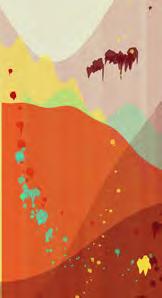
3
been able to do for figurative work. But this was nice because it was iterative and discovery oriented. I would just try things, see what happened. Sine waves were the first thing I worked with because I found them aesthetically pleasing and they happened to be very easy to code.
I started making several works per week, for a few years in a row – I had like 500 generative works in the span of these few years. I honed programming skills, refined types of calculations about creating artwork, and consumed lots of work about artists – trying to educate myself visually. I got very heavily into the New York school of abstract expressionists like Rothko especially. Digital art tends to be cold and rigid – it’s just not that compelling to me, I didn’t want that to be the case, but it was. I had come from painting. And I wanted to see how the vibrance and texture and chaos of paint could translate to the digital world.
But it was a big mental shift. When you’re creating a painting, you’re thinking of every aspect of a particular image, constructing it and fine-tuning it. For generative work, you’re finding ways to abstract and extract it. You’re turning it into a system. What is about this style of image that I enjoy. Is it the balance of the shapes? Or the distribution of color? How can I generalize those? And because it’s code, it has to
be incredibly explicit. The computer never gives you anything for free. I had to rely on my ability to iterate to get to a good final point. And that has been so much more successful for me than trying to dream a masterwork, and then bring it to reality. And sometimes the computer randomly suggests something new to me. I heavily rely on those moments for inspiration.
The weakest position for an artist is to have a blank canvas. Many, many times I have just said, okay I’m literally just going to draw horizontal lines on the canvas so it’s not blank anymore. As I’m developing the work I have every image and version of the code. Oftentimes there was a point in the middle where I could have gone one direction or another. It’s very fruitful for me to go back and say, now I’m going to explore the other route and see where that leads me. So it’s not a blank canvas. It makes me much more productive, and I can move fast.
I started selling the work directly on my website, and getting commission offers. I went full-time as an artist. That was about 2017. I thought this really worked, it’s called Ecto Genius: A big part of what made this successful was the color distribution, and the importance of creating pockets of vibrancy surrounded by larger areas of desaturation.
WHAT IS AN NFT?
Ok, let me define the terms here. An NFT is just an online record of a sale, and it’s particularly important for digital artwork because it helps someone get recognized as the legitimate collector of the artwork. The Art Blocks model is, they take the code and they write it to the blockchain, so collectors can come in and say I want to purchase an NFT that’s generated from that program. I don’t know what’s going to come out, neither does Art Blocks or the collector. And there’s an output size-- so for Fidenza I said there were going to be 999 NFTs created from that program, no more. So this is the first time I had no ability to curate what’s coming out of the program. Usually I can cherrypick the images I like to sell as individual works, but not here. So it really raised the bar for what I needed to do in terms of a consistent high-level output from the program. And I have to introduce a lot of variety as well. Particularly with Fidenza I introduced so much variety there were many surprising outputs, even to me.

4 TYLER HOBBS
Making Fidenza Before I actually made Fidenza, I should explain how I got there. I was interested in this idea of curves flowing, distorting the grid so curves swerve in interesting ways. This image is the very first thing I ever put down in a program. The circle represents the distortion to the grid. It was helping me visualize whether the code was working in the way I intended.
Two days later I made this, which is the first actual work using a flow field, which is a way to generate cures that don’t tend to overlap. Programming tends to be rigid and squared off; creating an organic curve is a pretty difficult task. Before this I didn’t have the means to achieve this programmatically and I don’t think many other people did either.

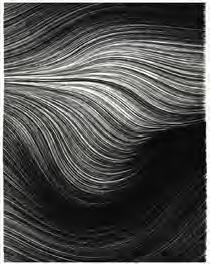
This is two days later. It shows how I was able to take the flow fields to create more complex constructions and add color to it.
This delivered the early hints of what was to come later with Fidenza. By 2020 I started to pay attention to the spacing. So this one reminded me of corals and sea anemones; it had an organic quality to it while being very simple. The shapes are not overworked, not pretentious, and I loved that.



I started to introduce more variety and more variations of scale, more dynamic compositions. The positions of the segments, the thickness, these are all randomized. But they’re randomized
within a window. Which gives me a sense of control but still gives the computer room to surprise me with something unexpected. In this I was liking the rhythmic quality particularly:
So now I started to move into color. There are a million ways colors can go wrong, that just become obnoxious or overbearing. The way it works is I define a color palette by hand.
I hand select the color and assign a probability to each color – so, a 70% chance of a shape being white, 20% chance of it being blue and so on. Lots of surprises occur, some good, some really bad.
These are just sketches, not finished works. For some of them, maybe there’s a distance of an hour between them. I can move fast. This gets closer to a finished work. It was for an
interior mural that a company had commissioned. It was the same session as the preceding images

A Killing in the Market I started to hear about NFTs in 21. Started hearing about A rt Blocks, which is a particular platform that
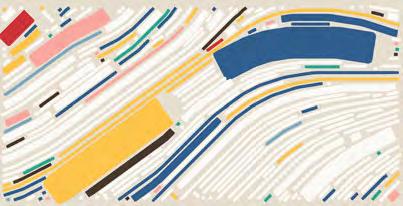
5
serves generative art through the blockchain [footnote]. And I felt it would be natural fit for my work. I submitted an application to Art Blocks in 2021, said, hey I’m Tyler. Art Blocks sounds awesome, I have this program I think will really work well. I showed them these sorts of outputs, said this is the kind of thing I would like to release, and they were incredibly excited about it.
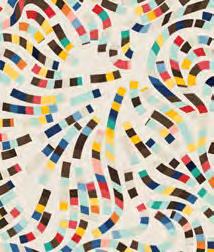
So after Art Blocks accepted my application I had three or four months to get to the finished Fidenza output.


I made sketches for what I imagined Fidenza might be in my sketchbook.
And then I made variations. On June 11 Fidenza became available for sale. And among the last images I saw before release – well, I was seeing a lot of images like these...
Instead of thin curves, I used thick, curved rectangles. I designed them with fourteen unique sets of colors. I shifted scale. I made “small” shapes very rare, jumbo (nice, chunky shpaes) the most common and jumbo xl rare again. I played with different textures ranging from a painterly look to a more graphic appearance. I allowed for outlines. And I added a “collision check, no overlap” feature, and they created two different modes where these checks are not as strict, including one which removes checking altogether:

And that was it. I was making hundreds,
thousands of outputs, so I had a very good feeling for the kinds of things the algorithm would do, while surprising me. I wanted it be 99% acceptably good, the top 25% to be quite good, and the last 5%, when things combine in an unpredictable but beautiful way, magical. So when I felt comfortable that that’s what the program might produce I just released it. Here’s what emerged.
The primary sales from the algorithm were soon eclipsed in the secondary market. On the secondary market, you can see a particular image and buy that. (I can’t tell you which ones I like best-- my collectors would kill me. But there’s no best single one.) And for me, the nice part is there’s a 5% royalty that goes to the artist on secondary sales, which in my case was massive -- Fidenza came along at an interesting time, because NFTs exploded immediately after I put it out and Fidenza did particularly well. The works started selling for 100 times what I had originally sold it for. And so I was lucky that I was allowed to reap some of the rewards.
6 TYLER HOBBS


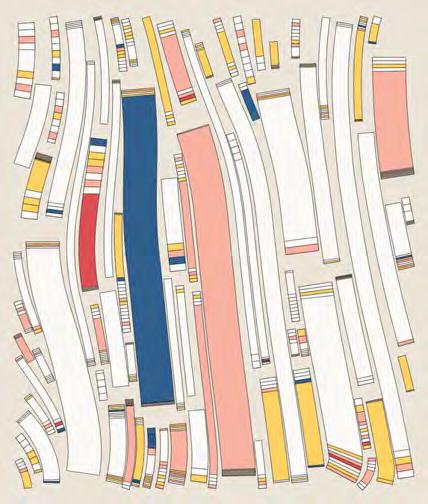
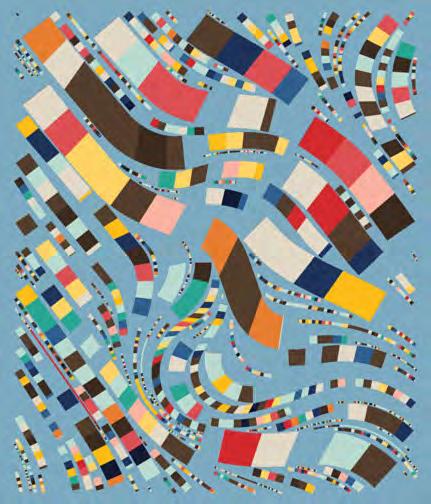
7
FIDENZA 118
FIDENZA 344
FIDENZA 982
FIDENZA 410
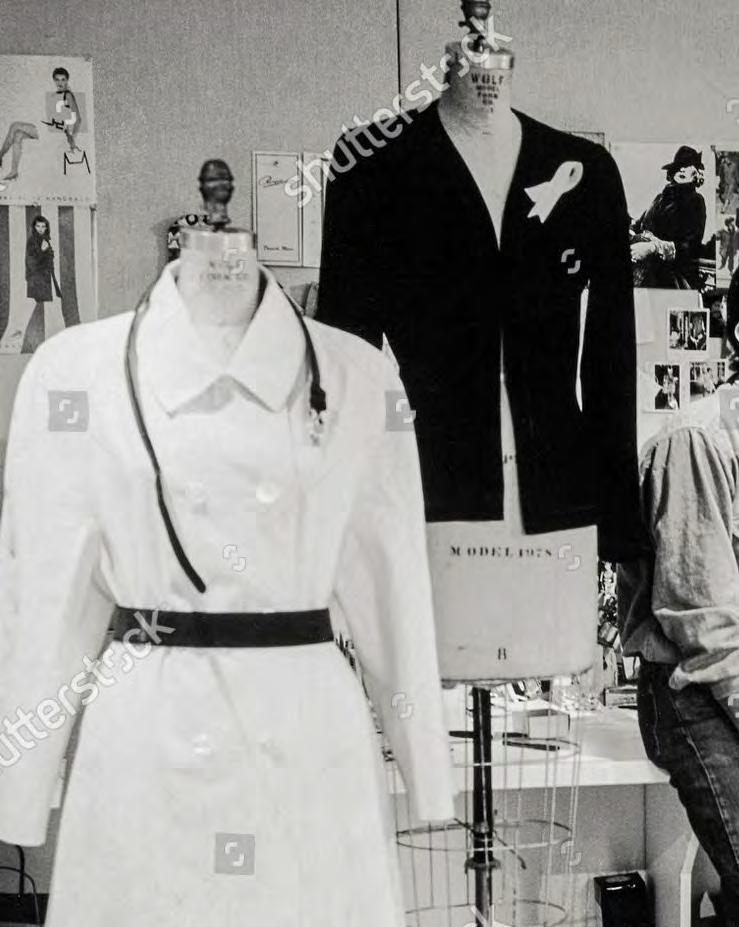
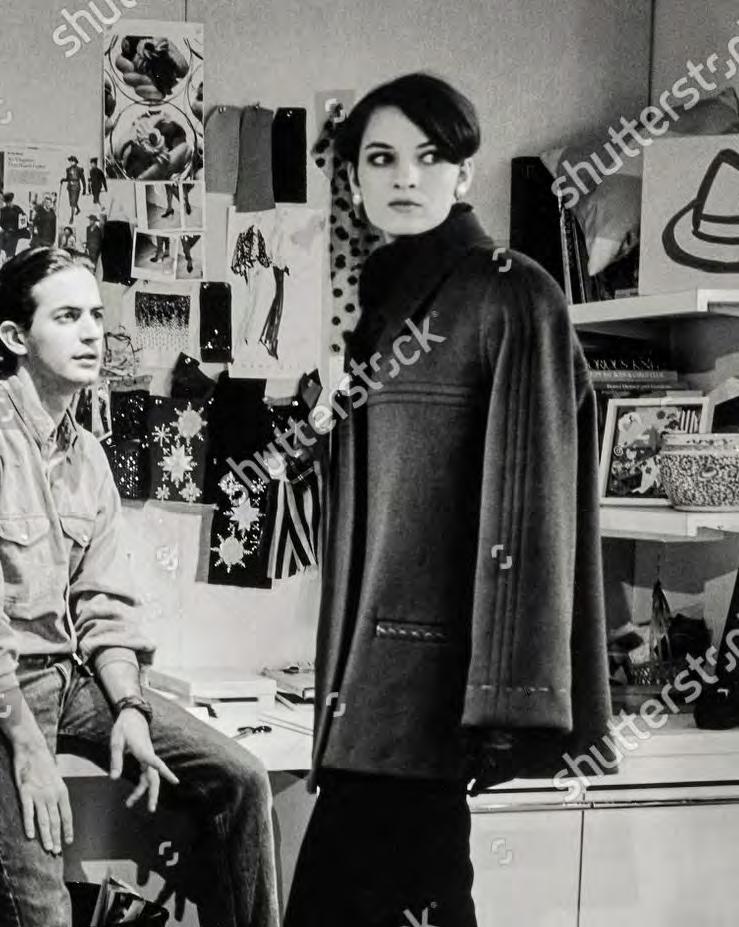
It Is Always Harder
IN MY OLD EDITING JOBS, I used to go to fashion shows during “fashion week” in New York. Many of the houses were advertisers, and it was important to show your face. It sounds like fun, but it wasn’t – not for me. The kissy social swirl was amusing, but I couldn’t help thinking it was lot of posturing for what was in the end, usually ten minutes of performance to dress up commerce like art. And the clothes didn’t interest me much, although that was mostly because I didn’t understand them. When I sat next to the critics and editors who knew fashion, and they would explain what I was seeing, I was much more impressed. But even they had disdain for much of what was on the runway. Most of the houses would trot the same look out, season after season. And


2 MARC JACOBS
occupation : designer work : Striped Jersey Dress born : 1963 34 MARC JACOBS
Figure 1 – teekay
all “week” (it was closer to two) the fashion cognoscenti would wait for the one show that never failed to thrill them, whether it fully succeeded or not. The last night belonged to Marc Jacobs, for he was considered the true artist of American fashion.
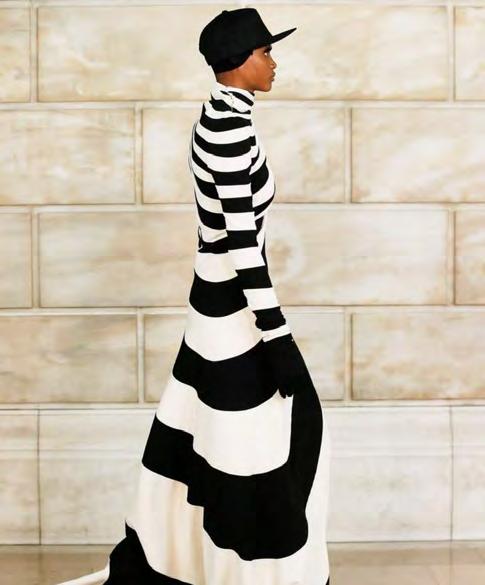
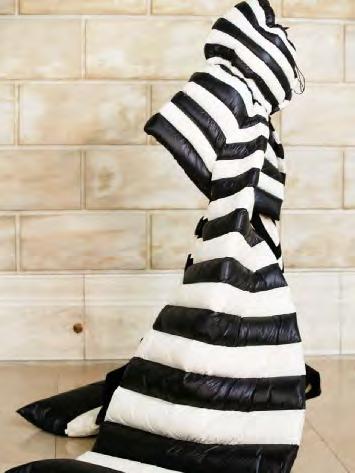
And actually, to my surprise, I saw why. Season after season Jacobs would reinvent himself. In a world numbed by branding and the necessity of repetition, he would never do the same thing twice. His clothes were alert to changing times, but not in a way that felt dutiful. They were intelligent, witty –conceptual and yet also generally very beautiful. He was not just making a statement. Also his shows themselves were clever and highly theatrical spectacles, so that was a kick
too. As the models marched down the runway, I’d take in the sweep of a genuine and coherent vision, admire the fastidious detail, get mesmerized by the splendor. I couldn’t wait to talk about them to my knowledgeable colleagues.
His career was an alpine range – vertiginous ascents and descents. A precocious talent, he went to the High School of Art and Design and then to Parson and shot to fame quickly, the youngest designer to win the Council of Fashion Designers of America Award for “new fashion talent.” He designed for Perry Ellis, was notoriously fired for designing a (pretty great) “grunge” line; had his own popular eponymous label; triumphed at Louis Vuitton before eventually leaving, presumably
3
TKTKTKTKTKTKTKT, Figure 1 – teekay
not of his own choosing; and saw his empire shrink. Throughout he lived a very public life – his drug use and sex life and facelifts were all there for the world to see. He never hid any of it, and was candid and human, even while living a life made for a tawdry miniseries. He frightened me personally a bit (in that nerd to queen bee kind of way), but I also thought he was marvelous.
What does it mean to be an artist in a fiercely commercial context; also a pretty vicious one? Marc Jacobs is just raw enough, and just enough calloused, to maneuver through it. This took years of practice, but it must also be a function of a very unusual character because his m.o was there from the beginning. He descends a rabbit hole, takes what’s useful to him, descends another. He allows ideas in, but is rigorous about dismissing false leads. He cares terribly, he doesn’t care at all. He is vulnerable and tough, open and shut. He preserves his
instincts, which usually serve him. I went to visit him in his Soho office smack in the middle of Covid. I came to talk about the first collection he did after lockdown, which had received rapturous reviews. He wanted to talk about one dress, the first he made after the quarantine hiatus and the last he finished before the show. The building was nearly empty, I was let into his office, he descended a stairway – very Hollywood. Then he took me through the making of this elegant striped dress, one decision after another.

We get together and start talking. It’s very similar from season to season. We talk about fabrics, about colors, everything comes up. And I’m not a very linear thinker. So I’m lucky to have Joseph who is the director of the studio, he’s able to decipher things from my conversation. Things start to stick. Some drop out,
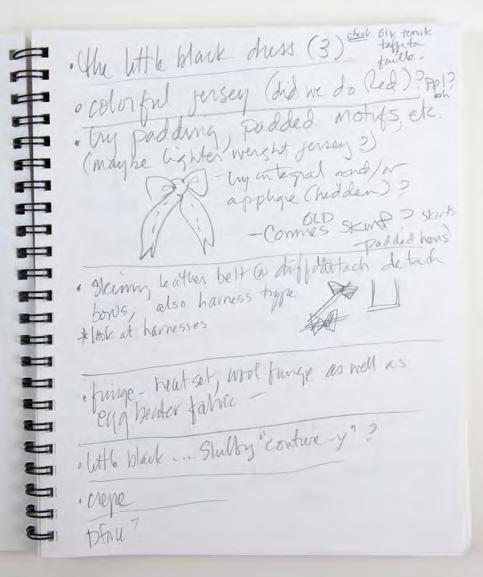
4 MARC JACOBS
MARC JACOBS:
Figure 1 – teekay
reappear later or go away.
So there’s no real direct line. We don’t really know where we’re going. We need to get to work to see where we’re going – I think that was a quote from Chuck Close. I do sketches to try and transmit an idea or thought –midnight, three in the morning.
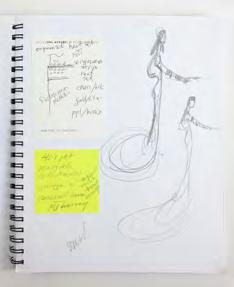
And then I come in with a pocket full of them. But it’s only a starting point. And it’s a little silly that I have to say that out loud, but I feel like I do, every time, say, this is only a sketch.
Time becomes the greatest editor. Sometimes it’s easier to let go of an idea and sometimes it’s harder. But the only way to get things done is to finish.
The Dilemma We had stopped during Covid. We just couldn’t figure out any way to create something during lockdown and I felt it was a really smart decision to not do anything. So we checked in with each other. And we thought we’re not going to even attempt to do something until we’re all together.
I like to work towards the goal of a live show, whether it’s for 100 people or 400, in the Armory or the Library or in our store. What motivates me is the idea of making clothes for a performance, a theatrical performance. So we took a break, we all had a lot of time to think, and then we were able to be reunited.
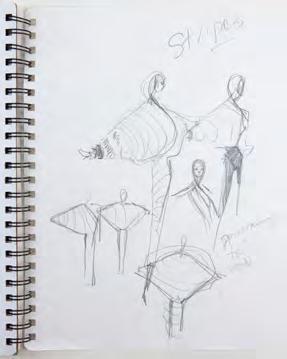
The windows were all open, we were masked, it was weird. We rely on Italian mills to make fabric, how were we going to do that? They can’t come here. There were these new obstacles. So we started to think, we have to be really mindful of fabrics, maybe we should use the fabrics we have left over. And then we decided we were going to do this with Bergdorf’s exclusively – the clothes would only be available in one
place. And I felt that by doing something rare, a small amount at that price level -- no wastage, no overages of fabric -- that actually felt responsible.
The Stream of Consciousness that Led to this Dress This was the first piece we talked about and the first piece we started. We were still working on it like up to a week before the show. Here’s how it began. I thought: what have people been wearing during lockdown? Sweatpants and t-shirts. And I didn’t want to show sweatpants and t-shirts necessarily. But maybe we should do some kind of t-shirt that could be long – that could be a t-shirt dress. And I always say this. So it wasn’t new. But to my mind there was some new importance to it. I was like, we should start with a jersey because it’s very comfortable to wear, it feels good, it’s not restrictive. And we started looking at images of dance and fashion where there was a lot of movement. We created a collage board and said, well, what kind of jersey would that t-shirt be in? What color? Solid or patterned? And I said, it should be a striped shirt. But then: Printed or knitted? And I said, it should be stripes, with two colors we piece together. And then everyone started playing. We bought a jersey in midtown, we had leftover jersey from the previous season, we played.
I thought about this couch by Borna Sammack that I remember loving. And then, I don’t know, I like the idea of stripes being kind of irregular and maybe creating some optical pattern. I like the idea of it feeling like it’s twisting or moving, turning around the body.

5
We started playing with squares that were different size stripes, and we cut holes in them and we had a model come, and we made a hypnotic sort of spiral. We just layered squares and rectangles.
And then: maybe it should have a hood.
So then it became kind of a hoodie over a t-shirt. The conversations went back and forth. Maybe the circular thing is a square. Maybe this, maybe that. It got distilled into this shape.
It was like a turtleneck t-shirt dress.
And then, maybe the hood belonged to something worn over the dress. Maybe a puffer?
The thing just kept getting layered and layered, but they were all just scraps. I mean, it wasn’t a real dress, or a real coat or anything. It was just panels and panels.
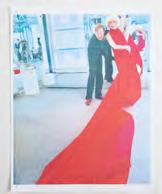
But still, the jersey felt too... kind of limp. And once I saw the roundness and the body of the down piece, I thought we should trapunto, which is when you put padding between the two layers of Jersey and there’s a lot of stitching. So even though it was a jersey, it had kind of a squishiness to it. Then the fabric became padded, quilted, it just evolved like that.
And we were entertaining the idea that if we weren’t able to do a show, these things had to make great photographs, right? I thought, whatever we did it would be shown in the store. So the most important thing to me was to see the figure from the side. And I thought well, if this were a photograph, I think the hem of the dress should make a beautiful shape on the floor. So we made it very long.
And the points of the square that we had originally cut became bigger, longer, with wider stripes on the bottom. We put our house model Christina on a white seamless and we placed the points so it had this amazing shape. Like an op-art thing.
I started thinking, each look we do we’ll find an environment where it’s camouflaged. The striped dress on the stripe floor, the dress disappears, or morphs into the floor. I thought we should just think of these as images.

And in my head I have lots of insecurities and doubts. I was also inspired and excited, but I wasn’t sure we had it. So like I said, it ended up being stitched and padded. But in the interim, we also tried strips of jersey to make up the black and white stripes. So each one of the black stripes was made up of twelve little strips of black fabric and then six little stripes of white fabric. We tried using sweat shirting fabric because it had more body than the jersey we ended up using. We tried it with all the seams on the outside – maybe that would give the stripe more texture. We tried cutting the jersey in different directions to see if it changed the way the dress fell. We tried different ways of working the fabric, and different stitch samples. It was the first piece we started working on, and we were still … I mean, I don’t want to say perfecting, because it wasn’t perfect in the end. But it was pretty good.
Conversations with his Shrink There’s always a reason I feel more unsure than ever. I feel this way all the time. This season it was like oh my God, we haven’t done anything for a year; it has to be incredible. And I remember saying that the last show we did, with all the dancers – Carole Armitage did the choreography
-- if this is the last show I ever do, I’d die a happy man.
Which is a wonderful feeling until you have to do another show. So I had to get past that, say well this is going to be something else. I’m not sure it’ll have the same emotional pull. But you know, my shrink helped me. He said, just go to work and do it. You
6
MARC JACOBS
know you say this every time, there’s always some reason why it’s worse than ever. I don’t know if it’s me who feels this way or if it’s reality, but there are always more obstacles than there were the time before. And I always feel it needs to be better than the one before.
My psychiatrist said to me: you know, you have evidence that proves that this is your process– and something good comes of it, right? So will it be the best thing you’ve ever done? Don’t know. But you will do something good. Because it’s just the way it goes.
I wish I didn’t feel anxiety and stress and pain. I don’t know if it’s useful. Is it my fear of failing? Or my fear of people not liking, like my identity, whatever? The list goes on.
No part of this ever feels easier, it’s always harder. I think sometimes of what Karl Lagerfeld said, no one wants to hear about how much you suffered to make a dress. Our job is to make it feel effortless in the end.
I ask if these are meant to be prison stripes,
thinking he may have been thinking that way, consciously or not, because of the lockdown. It is the wrong thing to say.
I hardly think it’s prison stripes. But then...
Okay, I don’t know why I insisted on a stripe, it’s funny. But I always think a stripe t-shirt as like the dumbest thing. When I was a little kid, all my t-shirts were striped. It’s classic. The Cat in the Hat.
But what you said about the prison stripes –I’ve stopped correcting people. People would come backstage after a show and say, oh I love that it was so Mary Poppins. It wasn’t Mary Poppins. But that’s fine. That’s what you saw. As long as people see something, you’re fine. So prison, or 30s Berlin, or Cat in the Hat, or rave. It’s like, great.
Critics of the show saw lockdown. And were drawn to the progression of the show, which led to a release from the cloistered nature of the clothing.
That was a conscious thing. I had started to collect images of the way people covered their face. I had doctored a turtleneck and pulled it over my nose. We created a mask, a hidden identity. A hat and hood and a turtleneck and all you saw was eyes. As we worked through it, we thought, how covered should everyone be? And then, what if we then repeated the show, uncovered – strip them of all the layers. Kind of like concealed identity and then release: okay, you can see my face now. I was a little afraid that when we stripped down each of the humans in the show, their outfits wouldn’t look enough. You can’t do something like that unless both versions look great.


But when we started doing the fittings, we thought, okay, this looks amazing without all the head coverings. And we got excited because we knew that this idea was gonna work.
And it did. The show was generally seen as a triumph.
But if we’d had no deadline, we’d still be working on that striped dress. [He laughs.] I know I would want to stitch it differently.
7
Figure 1 – teekay
JOANNA QUINN & LES MILLS
Brain, Hand, Pencil, Paper
JOANNA QUINN DRAWS THE PEOPLE she sees at the bus stop from her window, draws in the middle of the night, has been drawing compulsively since she was an only child in London. The person Quinn draws the most is one she made up: Beryl, the bodacious (brazen, curvy, prone to fuckups) protagonist of a series of animated short movies. Most of these movies she’s made with her husband, Les Mills, who she met when he was her drawing teacher.
Quinn’s bawdy heroine, emerged, like so many characters in these pages, pretty much as-is right from the get-go (I’m still amazed when that happens), though following years of rigorous training in life drawing. Beryl appeared first in a cartoon Quinn drew as an undergraduate, and she reminds me a bit of characters I might have seen in the underground comics I devoured as a teenager, though she’s a very British, contemporary version; for all her hilarious misadventures, she’s a feminist heroine. I like the politics of Beryl (barely visible but strongly etched) and she makes me howl, but what I love most about her is her body. I love all of Quinn’s bodies -- big and fleshy usually, and very often naked. They remind me of a cross between the creations of the cartoonist R. Crumb and the painter Jenny Saville.
Beryl is an exuberant broad in the old sense, and maybe Quinn is too. Quinn doesn’t seem to care about mainstream success or fortune or any of that. She – and Les, who writes the movies, while she draws and directs – have devoted themselves to Beryl, even as she costs them money (the movies are paid for by commissions mostly; she used to draw the Charmin bear for commercials but found it all predictably soulless.) They’ve made four Beryl movies, each more complex and outrageous than the last, but the short animated film is a category people are usually trying to break out of, since nobody sees them. Quinn and Mills don’t care. They’re jmostly trying to please themselves. “There’s only like four feature animated films I’ve ever liked,” Mills said.
2 CHERYL POPE
occupation : animater work : Beryl born : 19tktkt
35
Quinn goes to great lengths to protect the joy she gets from drawing. She draws with a pencil and paper even while it would be far more efficient to draw directly onto a computer tablet and, she admits, nobody would ever tell the difference. When she feels her drawing is getting too stiff, she tricks herself to get back to her natural, freer style.
Dreams and Desires: Family Ties is a short film in which Beryl is given a video camera, which she uses to film her friend’s wedding. The point of view of the movie is clever, with much of it what Beryl’s ‘filmed,’ and it’s loaded with filmic winks – at one point she imagines herself shooting in the style of Leni Riefenstahl, for instance. Many hijinx ensue -- carnal, drug-addled, irreligious (she gets stoned
and sees Jesus pop off his cross). As with every Beryl movie, it’s all about Beryl’s humiliation, but every frame of it is on her side. Quinn and Mills followed Dreams and Desires with a short called Affairs of the Art, for which they were nominated for an Academy Award.
Joanna Quinn: When people ask, where did Beryl come from, for a long time I didn’t know. I think when I was in college I got more political. And I realized I was always drawing men. I’ve always been a draw-er, and as an only child. I spent a lot time alone, drawing. I was drawing men all the time, yet my politics was feminist. Why was I avoiding drawing women? So I decided to make Girls Night Out , a comic strip about women, just about women. And it needed a central character,

3
Beryl began as a comic strip Quinn made for the school paper.
SKETCHBOOK SIDEBAR TKTKT
and that was Beryl. It was Beryl’s birthday, and her friends were taking her out and surprising her with a male stripper. I just drew her.
We did animation the first year in school. I did two little films. One was called The Dancer – I was doing a lot of life drawing at the time so I wanted to animate the figure. And then I did a film called Superdog which was really awful, about a boy dog that tries to rescue a girl dog and she’s all ‘bugger off’ at the end. So I liked the observational stuff of the life drawing film and the comedy of the funny film. For Girls Night Out , I translated the comic strip into the film. I was just making my illustrations move. And I remember the feeling of Oh my God, this is magic.


Les Mills: I was her drawing teacher. And I realized looking at her drawings, that they had huge dynamic potential, in terms of the way she drew and used movement, even in the still drawings. I would tell her not to rub out her mistakes: ‘you’ve got animation within drawings you know.”
JQ: Dreams and Desires was a really successful film for us, it’s won lots of awards. And the reason people like it is that it’s like a video diary, with the point of view of the camera throughout, which was really hard. People went wow because they’d never seen
that before.
LM: Structurally it’s a lot more disciplined than the other films. We used our own filmed video footage as references to explore camera angles and made references to seminal filmmakers like Eisenstein and Riefenstahl.
JQ: We were doing commercials, stuck in the land of commercials for 13 years. We made the film on the money we got from that. Making commercials is relentless, there’s not much room for creativity, you’re just making somebody else’s idea come alive.
LM: All this time, people were asking when are you going to make another Beryl film? We were both feeling miserable that we weren’t being creative, and we really needed to make a film. And we decided, okay, let’s not tell the agency, I was able to delegate enough to other people and pretend I was in charge.
I had these cameras at the film school I was teaching at, which is where the idea of Beryl being given a video camera, and a friend asking her to video the wedding came from. She decided to go whole hog and explore it, read everything, and experiment at the wedding. And then it becomes sort of a disaster movie. My thing is, weddings are disaster movies.
JQ: Les writes the script first. But not a script script. More like a short story.
4 CHERYL POPE
She continued to evolve Beryl in the film Body Beautiful.
She turned the strip into the movie Girls Night Out.
LM: Then it’s backwards and forwards, very much a team thing.
JQ: Before I storyboard, I take his script, and then start to do some ideas, draw. And then he goes, oh that’s good and tweaks his script. Generally because I’m more interested in character, I make it more specific about the characters, bring more personality and humor in. Les is broader, I’m specific.
What we always try to do when we make a film is not use that many words and show the animation. But it never works. So we bombard everybody with language and bombard everybody with animation. We really start off not trying to do that. I think one of the reasons we work well together is cause I’m actually quite conservative, with a small c, and anxious about what people will think. Les’ll go, eh, it’ll be all right, just put it in.
I spend forever doing the storyboard. In the storyboard you’re problem-solving-- problems of continuity, where the camera is. Everything is set so you don’t have to worry about it later on. I blow up one of the frames, and I just animate it.

When we’re done, we really aren’t sure whether it was okay or just awful. When you’re so focused on something, you can’t tell. I think with Dreams and Desires in the end we felt it was a bit relentless, there’s no breathing space – you know, too in your face. Little did we know that we would go on to make a film that would make Dreams and Desires look really calm.
Affairs of the Art was [so chaotic and long, for a short film] because it wasn’t a commission, we used our own money to make it. There was no deadline and nobody that we had to
5
Quinn creates storyboards from Mills’ scripts. From Dreams and Desires:
explain ourselves to. We knew the story, we had the storyboards. Looking back, we should have been more ruthless about it, said right at the beginning, this is going to be a ten-minute film. And chop stuff out. Because 16 minutes-- which is what it ended up being – it’s sort of a halfway house. We’re going to film festivals, and people see a film of 16 minutes they go, Oh God.
For Affairs of the Art , I worked for six months animating digitally, drawing on the Contiq – which is a giant table, you don’t draw with a pencil. You just draw directly [onto the computer] with 2d software, everybody uses it now. But it made me realize I love drawing on paper, I just love the act, the simplicity of
it. And my animation became really …
LM: Rigid.
JQ: Rigid. So I went back. I draw all the time. I’ve got piles of sketchbooks. And I do look out the window a lot. I love disappearing, being able to disappear in your work. The commercials nearly ruined me, because the style had to be flat and lifeless. So I had to break out of that. I broke my arm actually last year. And so I started drawing with my other hand. And Les said, oh you’re drawings are much better! Sometimes I draw, not look at the page, look at the person. The lines are all over the place but you manage to catch something of the person. When I’m animating, my little thumbnails are the best thing.
And explores character, through sketching. Some of the cast of Dreams and Desires:

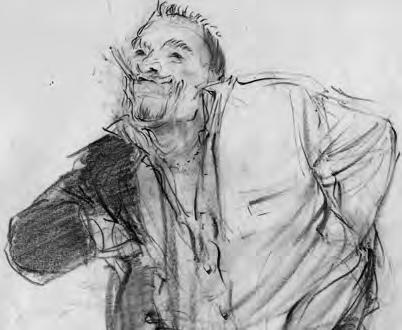
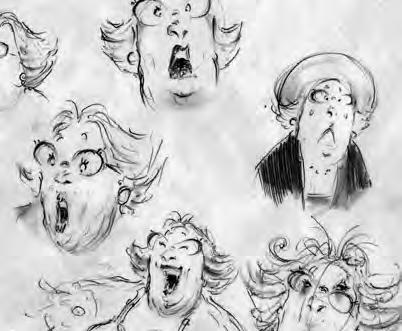

6 CHERYL POPE
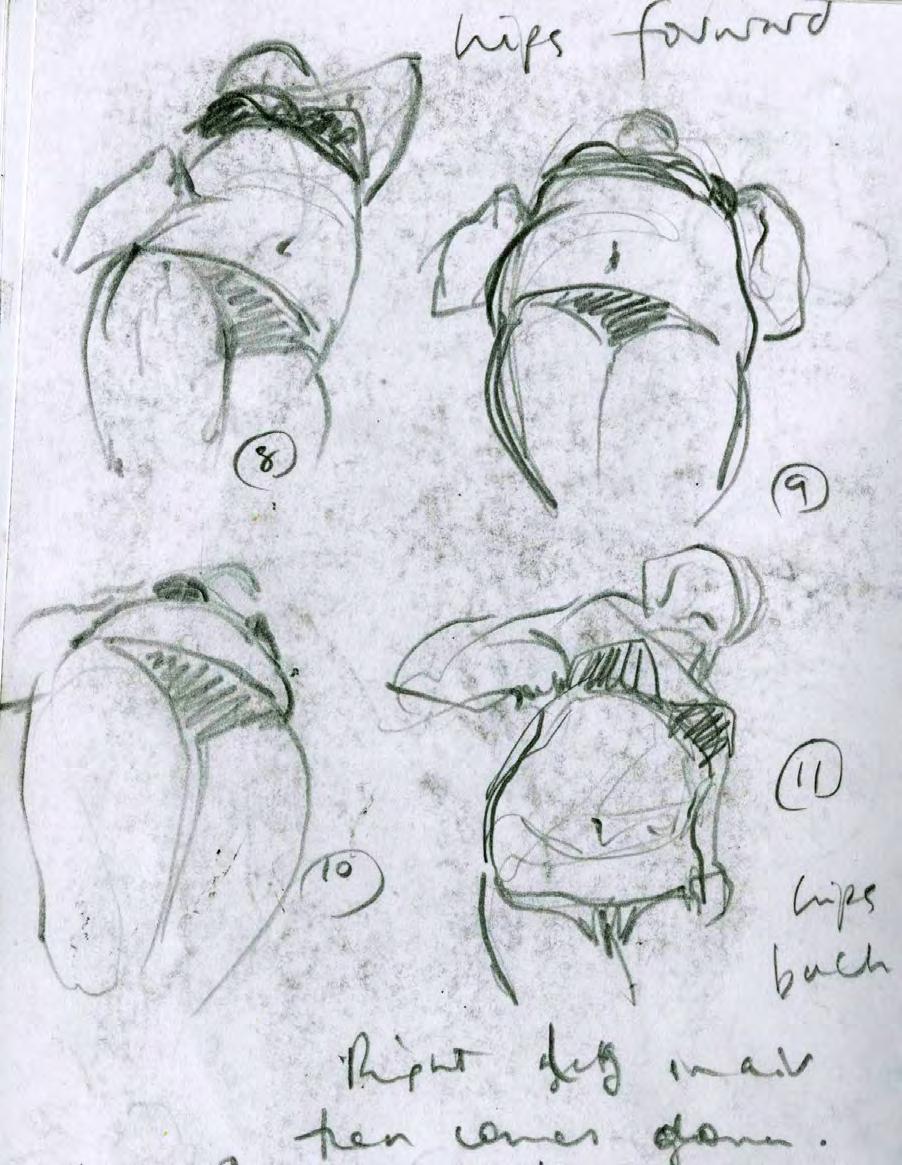
7
She sketches to work out movement.
WILL SHORTZ

The Brain is a Slide Carousel
ARE LOGIC AND CREATIVITY OPPOSITE? Not at all: even the most unrestrained surrealist or experimental novelist is working within a grid of his/her own logic. There were moments in my conversations for this book that I began to believe that setting up that grid and solving problems within it was the primary act of creative process and I’ve never entirely let go of that. In any case, that was my own logic for wanting to talk to Will Shortz, the Crossword Puzzle editor of the New York Times (that, and thinking that an edit of a Crossword puzzle would be fun to pore over, which it is for me).
I briefly supervised Will (though just barely; we did have a funny encounter at the time however, which we discuss below). When he began at the Times in tk, where he came from Games magazine and NPR, he was flying solo. These days the Games department at the Times is enormous – their puzzles are hugely popular and multiplying. For instance, in the last couple of years Will introduced the highly addictive Spelling Bee (a game like anagrams, where you pick out as many words as you can from the letters you’re given, though all have to use the letter in the center) which we play all the time at our house. The Times bought Wordle, which brought many more puzzlers into the fold. And Shortz spools out one new puzzle after another.
We talked about the puzzling mind. If there is such a thing, I don’t have one – I lack patience, at least – but Will certainly does. He began making puzzles when he was eight, and sold his first one at fourteen. When Will went to college, he created a major he called Enigmtology. “Enigmatology is actually the study of riddles.” he said. “ I broadened it to mean the study of all puzzles. I created one course on crossword construction. Every few weeks I’d go into my professor’s office with a new crossword I’d made and sat next to him as he solved and critiqued it. I found professors in the math department to help me make math puzzles. For logic puzzles, I found someone in philosophy. And I took a course in the psychology of puzzles – what’s going through our
2 WILL SHORTZ
36
occupation : First Lastname work : “Merry Go Round” born : 1900
brains as we’re solving puzzles and why we as humans feel compelled to solve puzzles when we’re faced with problems in everyday life.”
The attributes Will think make for a good puzzle-solver overlap some with those that appear to mark a successful artistic mind, especially having rigor and play in balance. “You need a level of language,” he said. “But also a flexibility of mind. A sense of playfulness. And you need to like being challenged. Somebody once told me he never does crosswords because he’s afraid of failing and feeling stupid, which is a silly way to feel. I mean, it’s just you and the puzzle. But there is a skill of the top solvers that just blows me away. They can look at the first four down clues and get all the answers before they go over the grid and fill them in. They don’t waste precious seconds. My mind won’t do that. I can’t fathom a brain that can hold all those things in mind at once.”
He started out doing the Jumble puzzles in newspapers. “I could typically do it in five to eight seconds. I just go boom, boom, boom. And I’m very good at anagrams, which requires you to break words into individual letters. Years ago I was in France watching TV in a hotel room. There was a game that involved French anagrams. I’m not at all fluent in French, but I got a nine letter anagram on the show before the contestants did.”
“My mind is flexible, which makes me a good crossword editor. But you know I’m also crazy about table tennis [in fact, Will owns a table tennis club] and my flexibility of mind hurts me there. For table tennis, you need constant focus.”
“I’m a pretty good solver, as you can imagine, but I’m not the world’s best. I think among average people, among my friends, I would be a genius. But at the World Puzzle Championships, at an event of literal geniuses, I’m not a genius.”
Puzzle-solving is about finding links, and linking associations – that’s true of art-making a well, and in a broader sense, all kinds of thinking. “What goes on in the brain is a
mystery,” he said.
“Here’s a crazy thing. You hear about this phenomenon all the time. People are solving a crossword, they get stuck, come back fifteen minutes later, and immediately get an answer they couldn’t think of before and they’re off and running again. What do you think has happened? Has the brain been working subconsciously in that time? I had a professor who compared the brain to an old-fashioned slide carousel. The slide drops down, and then you move to the next one. The second time the puzzle comes around, the carousel is in a different position, and the brain connects somehow.”
Over time, puzzles have gotten more sophisticated and also more popular (“it’s hard to compare it with the crossword craze of 1924 and 25, or the Rubik’s craze of 1981.”) – this is where Will’s mind goes – “Or even the Soduku craze of 2005 and ‘06. But generally, puzzles are more popular now and the reason I think is that more people use their brains as a living – there’s less manual labor, more computer programming. And when you’re done with your regular work, you can’t turn your brain off. It wants to keep going.”
“I like to devise new puzzles. For Spelling Bee, there was something similar that appeared in British newspapers. Theirs had a letter in the middle as well, with six letters around. My important change was that the middle letter can be repeated. I said, you can repeat any letter, which makes it more interesting. I called it Spelling Bee, which I think is a really good name – the central letters have the shape of a hexagon, which gives you a sense of a beehive. And that improves the puzzle visually, and the visuals of a puzzle are very important. And we’ve said you can now use four-letter words instead of starting at five, which makes it easier. Without four letter words, we were gonna run out of combinations after so many years. Now I think the puzzle will go on forever.
“My hope is to devise a crossword in which clues can have two different answers. That’s
3
never been done before. And the reason is that, you know, I think one of the reasons people do crosswords is to bring order out of life. We’re faced with many problems and we do the best we can. What’s great about crosswords and other human-made puzzles is that there is a perfect answer. Finding perfection is something we don’t experience much in life. Two perfect answers violates this basic reason and that’s what makes it elegant.”

Creating a Puzzle Of all the puzzles at the NY Times, the crossword is still the nucleus, the classic. So I asked him to share the making of one. These days he gets around 200 submissions a week, and picks seven. The puzzle Will chose was a Sunday puzzle (mid-range difficulty) from a regular constructor named Sam Trabucco. This, for reference, is the completed puzzle:
“Every theme answer contains the name of a vehicle,” he said, explaining the puzzle’s ground rules. “And if you go around the vehicle as if you are passing it on the highway, it makes another phrase. So say ‘log cabin’ has ‘cab’ in it – if you change cab to G-E-D you get ‘logged in.’ It’s an elegant concept. It’s not made by a computer. Only a human could
think of this idea, only a human could execute it. When I’m choosing a puzzle, I’m looking for a fresh idea for a theme; then if I like the theme, I look at the fill. What makes a good fill in a crossword is basically names and phrases that people know. You can have the occasional obscurity but mostly you want the grid to be filled with fresh, lively, colorful vocabulary that people know. Then if the constructor can write good clues, that’s a bonus. But if I
4 WILL SHORTZ
TEXT SAYS SOMETHING TEEKAY Dolut eliciisqui te volupti ne et fuga. Sit quiae.
need to, I can rewrite the clues myself.”
On average Will rewrites half the clues. That was the case with this one. You can play along if you like, at the left and see all his changes, along with this narration of why he fiddled with what he did:
WILL SHORTZ
Five across was “Hot Mess.” [ for ‘fiasco’].I think he threw that in to sound current. But a fiasco has nothing to do with a hot mess. “Total mess” is what it is. I like precision of language.
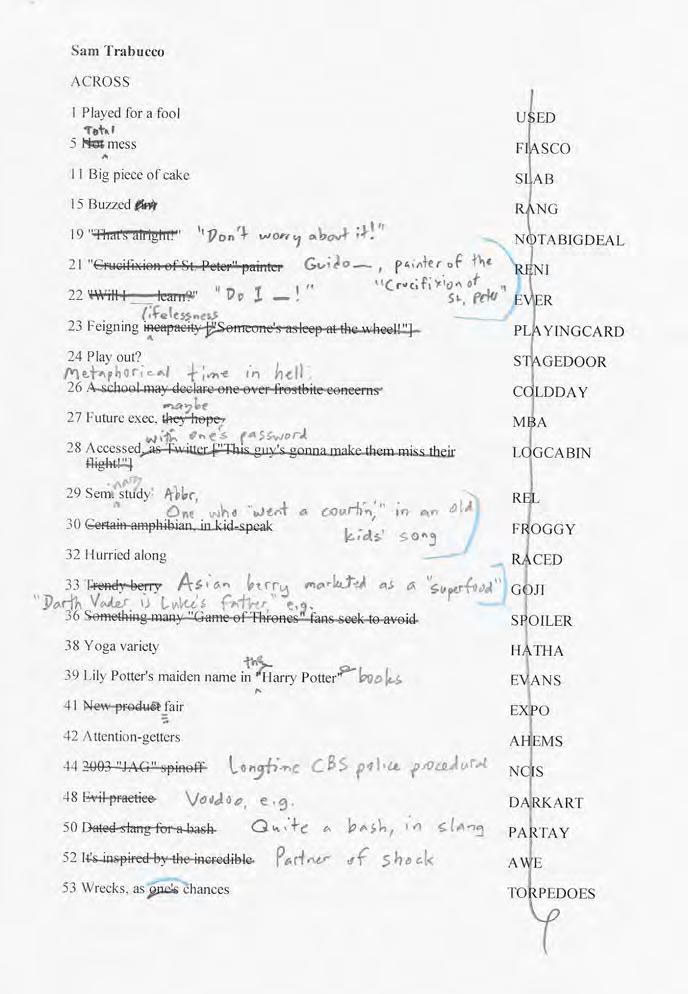
19 across: “That’s alright!” [for ‘Notabigdeal’]. Well, I wouldn’t do that because that’s a non-standard spelling of all right. So I changed it to ‘Don’t worryaboutit’.
Okay, the next one , “Crucifixion of St Peter” painter was perfectly fine but I like to give context to answers. If you don’t know this artist [‘Reni’]and you get it from the crossings then you ended up well, I don’t know. But by giving the first name it gives context, you’ve learned something. Let’s jump down... 26, “a school may declare one over frostbite concerns.” The answer’s ‘cold day,’so that seems stretching it to me. The
actual way people use it is It’ll be a cold day in hell when blah blah. So that was a way to clue it [metaphorical time in hell] that reflects the way people really use the word. For 26, the clue was Sem Study. I spelled it out. I don’t
5
[Figure
2.1 – 2.6 – Will Shortz Crossword Puzzle Edits – Merry Go Round – NYT – 2018]
know that most people know what S-E-M is an abbreviation for so I wrote it out, Seminary Study, abbreviated. Mmm, let’s see “Trendy Berry” –answer’s Goji. The Times crossword has a shelf life of 5 to 10 years, so I don’t use trendy because five years from now it’s not trendy. For 36, ‘spoiler’, “something Game of Thrones fans seek to avoid, I instead wrote Darth Vader is Luke’s father. I don’t know –that just made me smile. 41, New product fair ’ was too specific for ‘Expo.’ An expo is just a fair. And also I wanted to make it harder – for Fair, you might first think just average, or light-complexioned. For 59, the answer is STD – it can be clued as sexually transmitted disease or abbreviation for standard. I will always go with standard because STDs are such an unpleasant subject. And I’m not a prude –I had brown-nosed in a crossword once. 104 was just a matter of being more challenged. For ‘Strings’ he had ‘Puppet masters pull them’ – that seemed too easy for a Sunday puzzle, so I changed it to ‘big part of an orchestra.’

Do you want me to go through all of these?
Here’s one clue that I like a lot. It was 80 down. His clue was ‘Walking Up’ but that didn’t make grammatical sense. And I thought “like some clowns and beachside houses” was fun. When you read that clue you think “what could clowns and beachside houses have in
6 WILL SHORTZ
[Figure 2.1 – 2.6 – Will Shortz Crossword Puzzle Edits – Merry Go Round – NYT – 2018]
common?’ The answer was ‘On stilts’. Would you get it? When you do, it’s a little aha. It’s like a punchline to a joke. For 30 down, for Fox, he struck out “Network with notable partisan reporting” and replaced it with __ News.
I wondered if he makes a conscious effort to steer clear of politics. “Clues shouldn’t take sides,” he said, “they should be factual. And it probably is factual that they are a partisan network...”
“But you’re just being extra cautious?”
“Yeah, I guess. A comment that I read every once in a while is from right-wing solvers, who say that ‘the only reason I subscribe to your rag is for the crossword.’ You know, it’s a broad audience.
I WAS STRUCK by how loaded all these choices were, which reminded me of the awkward encounter I alluded to earlier, back when I was supposed to be his minder. It was 2001. The puzzle’s name was Homonames, and some eagle-eyed Times readers interpreted that to suggest it was all about gay sex – and possibly of the rougher variety. I was asked to investigate. “ Oh yes I remember, “ Will said. “Instead of Carrie Fisher the actress, it was C-A-R-R-Y F-I-S-S-U-R-E. Rex Reed was W-R-E-C-K-S
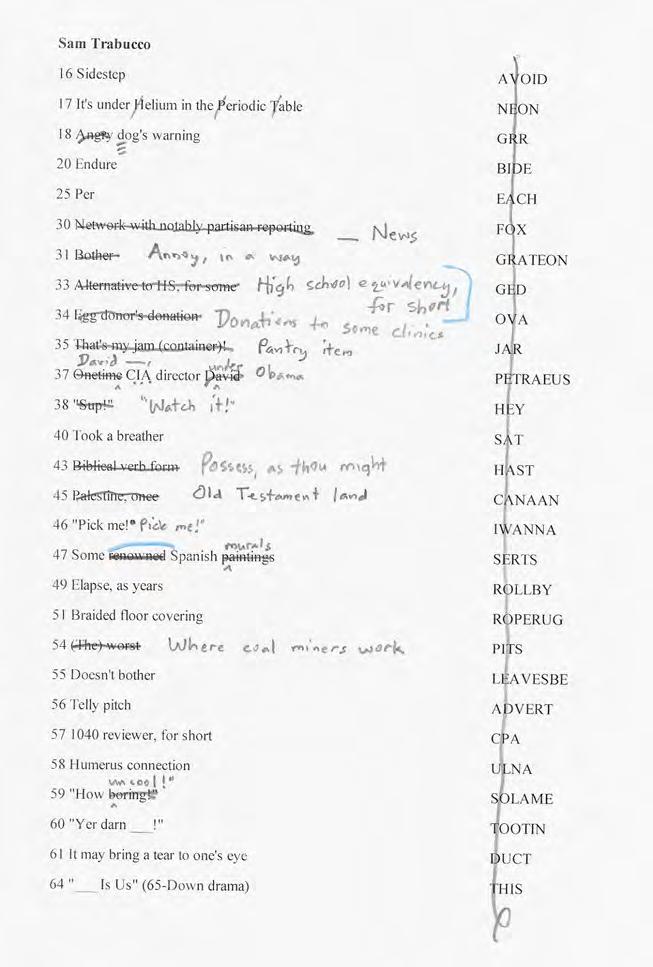
R-E-A-D, and he was notably gay. And Jim Nabors was also in there, as G-Y-M.”
Will professed to be horrified at the time, and said that none of those references were intended.
“It’s a stretch,” he said to me, perhaps
7
[Figure 2.1 – 2.6 – Will Shortz Crossword Puzzle Edits – Merry Go Round – NYT – 2018]
A Map of Her Mind

occupation : Chef
work : Salt, Fat, Acid, Heat
born : 19tk
SHEILA HETI
37 SHEILA HETI
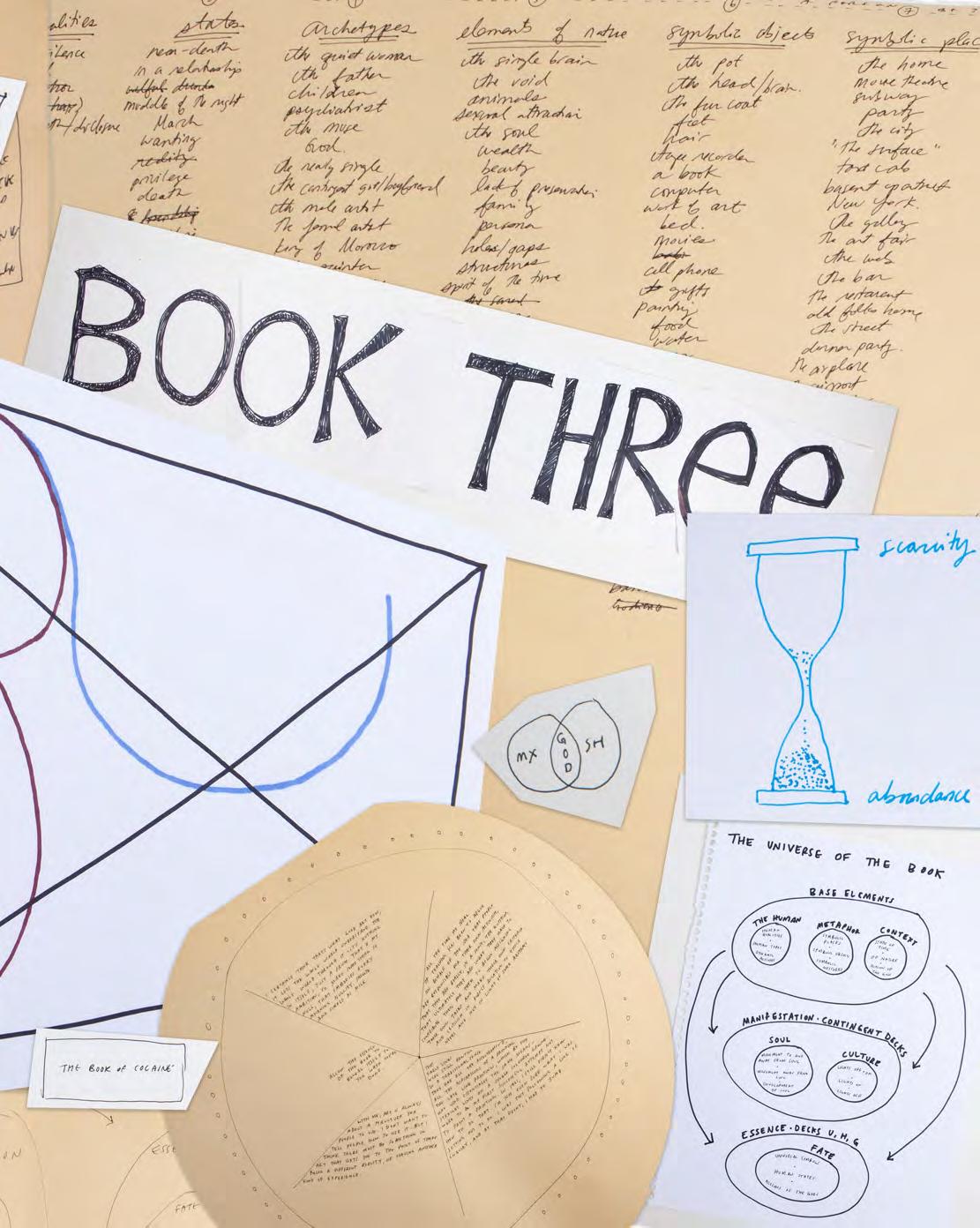
THE FIRST TIME I really thought about Sheila Heti was when I read a short excerpt of an experimental new novel she was writing. I don’t know why she hadn’t been in my sights before. For that project, she’d broken down years of journal entries, and recombined sentences alphabetically so that they created a kind of narrative progression. I’m not sure it was so interesting to read – bursts were, and then it would feel like an exercise -- but I admired its effort to rethink what a novel could, or perhaps should, be.
She has written eight books, novels like Ticknor, Pure Colour, Motherhood, nonfiction book projects, some a little more conventional than others but all pretty bold in toying with form. One of her stranger books was also her best-known, How Should a Person Be, and that’s the book whose origins we traced. How Should a Person Be? is about a character, named Sheila, trying to forge a moral path after a divorce and at a point in her life when she fears she has no soul. She has failed to deliver on a play commission and is worried that she is a failure. She has a heated, self-destructive, sexually graphic affair. Her friends have a competition to make the ugliest painting; the ugly painting becomes a metaphoric motif. Much of the book is in the form of transcribed conversations with her friend Margaux. Reallife Sheila has a best friend named Margaux. Real-life Sheila taped her conversations with Margaux. Real-life Sheila divorced, failed to write a play. Real-life Sheila had such an affair. Real-life Sheila’s friends had an Ugly Painting competition. How Should a Person Be? is a work of fiction, absolutely, but also, in her account, one she had to live (enact, in her real-life) in order to write it.
How Should a Person Be? is now considered one of the the pivotal works of ‘autofiction’, a blend of fiction and autobiography, and a genre that Heti hadn’t been aware of when she wrote her book. How Should a Person Be? was met with polarizing reactions – “Reviewers,” wrote one, in The London Review of Books “describe
wanting to throw the book across the room or stock up on copies to give to friends, sometimes both” – but has since become something of a classic to many, especially successive generations of young women, who see her as a truth-telling savior. But the book is also admired by other cohorts, including other writers, drawn in by that candor, an extremely winning voice, and its thrilling bludgeoning of the conventional novel.
One of its most intense antagonists was the critic James Wood, who called it “messy” and “narcissistic,” a review which has itself been bludgeoned by Heti’s very devoted adherents. So I was surprised to hear Heti, who came over one day to tell the book’s story, say that Wood was on her mind as she was writing the novel because she felt he might admire her attempt to rewrite a novel’s rules. “I read a review by James Wood,” she said, “About Flaubert, Madame Bovary. He wrote, ‘This is how Flaubert revolutionized the novel.’ There was one paragraph where Wood said Flaubert privileged seeing. And I thought I’m going to do the opposite of all that. Because I hated Madame Bovary. I hated the conventional realist novel. And that was a huge driver when I set out to write How Should a Person Be? I thought instead of seeing, I’m going to privilege oral details, in the recording of conversations. And the thing about a novel like Madame Bovary is that the narrative voice always retains a cool composure. And I thought okay, my narrative voice is going to lose its composure.”
You can hear the ambition in her voice, though she delivers it evenly. “I thought I was writing my book for James Wood. I thought he’d love my book.” Not that she seemed to care much when he didn’t. She has strong convictions about novel-writing. She finds most fiction boring. “Because I think there’s a texture missing. Because [much of what a novel used to do] is not necessary. You have TV. “ She likes novels of voice not unlike her own own, though she has plenty of reservations about her own work as well.
Heti lives in Toronto, and projects what I
4
SHEILA HETI
guess is a Canadian unflappability. She is kind and quirky, but not at all as eccentric-seeming as I’d thought she might be from her work. And yet there was clearly a lunatic in there somewhere. When I had described this book’s project to her, explaining that I was hoping to find physical entrails of her process, she said she might have what I needed and brought over an enormous trove of notebooks, notecards and huge sheets of paper containing what she called maps. You can find them on the preceding spread. They were insane, and I’m not sure I mean that colloquially – she had devised an elaborate cosmology to help her write this book that provided a clear view of the crazy-person that lurks underneath everyone, maybe artists especially. But it was also beautiful and elegant, a work of art in itself, even though its entire purpose was to help her explain her work to her herself – it wasn’t meant to be seen by anyone. “Writing How Should a Person Be? was the hardest I’ve ever worked in my whole life. It wasn’t like I was writing a novel about myself. I had no template.”
So that’s what we talked about, how she found her way – with the help of this code.
SHEILA HETI:

It was 2005. I was separating from my husband. I had just published my novel Ticknor, in the voice of the historical figure George Ticknor, and I found that process … unjoyous. I ended up writing about 20 pages a year. Painstaking. And all alone. And I thought, I can never write in that way again.
I moved to Montreal, got an apartment of my own. And I started to read the Bible. I don’t know why.
I was emailing with a lot of people, really long emails, that’s what people wrote back then. I was now by myself, somebody else was getting divorced – all sorts of dramatic things were happening. I started to number
the emails like the Bible: The Book of Lee, the Book of Margaux, the Book of Kara. Numbering the passages.
And I had also been reading this famous article about Linux called “The Cathedral and the Bazaar” which advocated for open sourcing in software. I thought, maybe I can opensource a novel. Maybe that’ll get the bugs out faster. Maybe I should model my process on Linux. So the process itself would involve showing friends’ multiple drafts, not believing my brain was the best brain to write the book.
When I moved back to Toronto, my husband and I broke up. I started spending more time with my friend Margaux Williamson, who’s a painter. We talked and talked nonstop. I was thinking maybe my studio can be out in the world rather than in my room – the opposite of what it was for my previous book, which was so unbearable.
So this is what I’d been thinking about, but I had no subject. I always have this conviction that it doesn’t matter what you write about, the subject will come. And then, because I had just gotten divorced, and I was wandering and lost and totally discombobulated, and wasn’t sure I was a moral person, that became the subject of the book.
It was so gradual. Oh, and I was really into the reality show, The Hills. And so another of my thoughts was how can I make a book like The Hills. What that meant is that I’d have to orchestrate things to happen.
I was taping the conversations I was having with my friends. We would go to brunch, this group of friends of mine, and one brunch someone asked: who can make the ugliest painting. And I said: we have to really do that, so I can tape it and make it part of my book.
Margaux and I talked a lot about Paris Hilton. At one point I had considered writing an article about her. You remember when Britney Spears cut her hair off, Lindsay Lohan, all these girls were getting in trouble-- they
5
[Figure 2 – can what is ugly be made beautiful?]
were seen as ruining America. Margaux found them fascinating. She was like, Paris Hilton is my Andy Warhol. And I did write it, though it was never published. The article was a kind of a transcribed dialogue in which Margaux defends Paris Hilton. Which I thought for awhile might be the center of the project. Maybe it became two or three sentences of the book.
SO I HAD THE BIBLE. I had Paris Hilton. Me and Margaux. The Ugly Painting competition. I was trying to put all these elements together.
2006 was the big year, the year of discovery. And I’m not sure what order it all happened in. But I wrote what became the prologue. Just in a spontaneous push- it was about 90% of how it ended up in the book. How should a person be was the first sentence of the prologue.
So in 2006 I was at Yaddo and already had this phrase, How Should a Person Be but I wasn’t sure it was gonna be the title. On my wall I’d written: How Should a Person Be, question mark. Margaux came to visit me there, and she said that should be the title of the book.
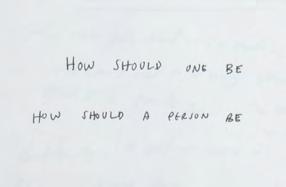
I thought, I’m going to become this Paris Hilton slash Sheila. In order to write the book. It wasn’t like putting on a costume. You repress parts of your life and exaggerate others. It was so fun, you know? I think that’s why Andy Warhol was so interesting to me. Because that’s how I understood him.
Oh, one more thing. Before I had the title or written the prologue I had started a book with my friend Misha Glouberman called The Moral Development of Misha. I wrote like 70 pages of it. About him as a character walking through the world solving peoples’ problems. A Jesus figure. I never did anything with it really. I gave it to him. He liked it. Later, I wrote a book with him called Chairs are Where People Go. For a long time Chairs are Where the People Go and How Should a Person Be? were the same book.
Margaux and I went to Scope, at the Miami Art Fair, and she read the prologue on the plane. It was kind of in the voice of me as a character in The Hills. That voice just came out. And she loved those pages, loved the voice. She said, this is the best thing you’ve ever written.
And I sent it to Mark Grief. [fn1] And he said this is great. Now you need to write another 300 pages of it. So I thought, okay, I have the voice.
The reason the character’s name is Sheila in the book is because when I was transcribing our conversations, I just kept writing Sheila, Margaux, Sheila, Margaux. And Margaux liked it. I tried to change the name but it just seemed so fake because I had been looking at these transcripts. Margaux said, it looks like we’re hiding something if you change the names. But if you leave the names it’s just so weird. She thought what I was doing was really weird. I didn’t think it was weird.
I WAS IN THE BOOK, I was living the book.
But I started to think, I need a narrative. I wanted people to get to the end of the book, and I understood that to get somebody to the end, you need some kind of arc. And in 2008 or so I started moving away from Margot a bit and that was a bit of drama in our friendship. And then I got the idea, oh, I have to betray Margot in the book. Because I want to be a good person and I’m always somebody that runs away from relationships. That might work for drama, as a plot, in the book.
And my idea of plot was I needed to create a forest of symbols for myself that would be the world that Sheila and Margaux were walking. So I wrote down 500 scenes that were real. Moments. And then I turned them into a single word, like pigeon. The plot of the book is lights go on, lights go off. She starts to develop her soul then the lights go on. And the last three scenes the lights go off.
6
SHEILA HETI
[Figure 2 – can what is ugly be made beautiful?]
Okay, this is the part that’s really hard to explain. But I’ll do my best.
The Cosmology Sheila does try to explain, with the help of the materials she has brought. She has a mountain of them. It’s clear this was not a rudimentary exercise; it’s something she worked out over a very long period of time, repetitively. There are piles of notes, drawings, cards. It takes the form of a card system, with echoes of Tarot. I don’t understand it. You won’t understand it. Sheila herself doesn’t fully understand it. But what’s important is that it helped her write the book: “Sheila betrays Margot and she makes herself alone. I understood that. But I couldn’t see the whole thing. I was really desperately trying to see the beginning, middle and end, writing the book, and trying to understand the book at the same time.”
Having despaired over trying to make sense of it for me, she wrote me a few weeks later. She’d found an email in which she describes the system to Lorin Stein, her editor at Farrar Straus, [fn] after he’d had rejected the book (a plot in the book’s narrative which we’ll get to), hoping to change his mind. Here is an excerpt:
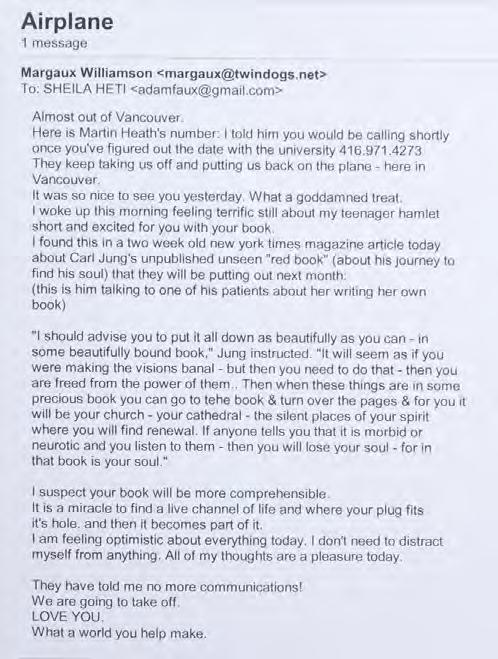
IMAGINATION IS COMBINATION.
I created four decks of cards. Each deck represented a different aspect of the universe or life. I broke all the elements of life into four, and those four were: human qualities / actions of the gods / universal symbols (tree, mother, etc) / contingent symbols (paris hilton, a street in Toronto -- things pinned to a particular time and place, not comprehensible across cultures and time).
There were 30 different actions of the gods, 60 different human qualities, 90 universal symbols and 180 contingent ones.
Also, there was a grid, a four-pointed triangle (that is, a 3-D triangle) and each point represented one of either actions of the gods, human qualities, universal symbols, contingent ones.
This 3-D triangle is an imitation of how the physicist Julian Barbour (author of author of THE END OF TIME) conceives of the universe. That everything that is possible already exists, every configuration of everything to everything, but that humans move on a path through that triangle, not straying, and our illusion of time comes from the fact that we move from one moment to the next, rather than jump to a completely other point within the 3-D triangle (which is obviously a model).
Anyway, I decided the book would have several main sections, and would proceed in this order:
1) movement away and toward soul
2) movement away from soul
3) lights go on and off
4) movement toward soul
5) lights go on
6) lights go off
7
Parts 1, 2 and 4 represent the individual; parts 3, 5 and 6 represent the culture.
Each section was given a number, representing how long it would last in the course of the book.
The way I came up with those numbers (essentially, to be brief) was I came up with (and wrote down in short paragraphs) about 600 ideas for scenes; a scene might be something that happened to me in the past three years, or an important idea that had occurred to me in the past four years, something in the news, whatever.
There were, of course, very many scenes that didn’t fall into any of those six categories, and those scenes were discarded.
From the scenes that were left, I wrote down key words which reflected the main ideas of each scene (the airport, secrecy, pacing, responding to a request, the critic). These words were then put into the four categories that I mentioned earlier -- the decks (contingent symbols, actions of the gods, human qualities).
The universal symbols I took randomly (using a numbering method) from the Penguin Dictionary of Symbols.
So then I had four decks of cards, each with a different number and colour, the colour representing which of the four decks (universal, gods, etc) and the number referring to that deck’s list of key words.
Apartfromthedecks,Ihadthepaththrough the book I would take, through the six movements, which were graphed onto a 3-D triangle. If you can visualise it: you draw a 3-D triangle and then draw a squiggly line through it (this map is on my wall) meaning that at any particular point on the line, you are closer to one of the four corners than the other; for example, you might be close to the lower-left corner of the triangle, which represents actions of the gods, and far away from the top point of the triangle, which represents contingent symbols.
All this in place, when I came to write certain parts of the book, I could randomly draw
one card from each of the four decks, having before me a universal symbol, a contingent symbol, a human quality and an action of the gods -- as well as a place on the squiggly line within the triangle, so I would know the relative weight of each of those four elements to each other, and then I would begin to write -- and what I would write would try to make sense of how those four elements interacted with each other.
What might a scene be that (for example) necessitated (determined by the random drawing of four cards):
fucking (an action of the gods, naturally!) being-for-others (human quality) ascension (universal symbol) andy warhol (contingent symbol)
ThiswasthemethodbywhichIwrotemany passages of the book
SHEILA AGAIN:
I kept creating new systems because I didn’t know how to write the book. What’s the plot? What is a plot? And then, practically: how much dialogue should be in the book? What portion should be transcribed conversation? What’s the tempo of the book?
There was a point in the book in which I had come up with 10 new commandments. I remember one: Be honest and transparent and give away nothing. Then I thought I can’t actually put those in the book because I’m not Moses. I want to be Moses but I’m not Moses. This is gonna be what Margaux and I learned. And I’ll put that in the book. I started sprinkling sand throughout the book. I had to indicate that we’re wandering in the desert.
2.“At one point I wondered, Did I just use Margot to write this book?” Sheila continues to be very good friends with Margot, though their relationship has changed over the years. About her role in the book, “Margot felt mixed.” Sheila said. “Because she’s an accomplished artist in her own right. And it’s a big part of her public identity, and I don’t think that’s necessarily always what somebody wants. But she loves the book.”
I realized it needed the body, it was too cerebral. That’s when I put the sex in. After the end of my marriage, I’d had this affair
8
SHEILA HETI
1. Mark Grief is a cultural critic, author of the book Against Everything , and one of the founders of the journal N+1
with a guy. It was sort of mind-blowing. So I wrote all the Israel [his name in the book; the scenes are explicit and somewhat self-abasing] passages. And I gave them to the guy to read. I didn’t think it was for the book, it was just spontaneous writing, I thought maybe it would be for its own book “Chastity.” And when I did put it in the book, I thought this is going to eclipse everything. No one’s going to notice anything except this sex stuff.
I didn’t know where I was going. I didn’t know how to finish the book. I had so many different endings for the book. One night I woke up and said, I’m going to write a scene about squash. It just kind of came to me. And I wondered, why am I writing this scene? But then it ended up of course being the end of the book.

At some point, I sent it away with Margaux [fn2] And she told me, it’s not done. And that was really devastating because I didn’t really know how to get it done. I was glad to be accountable to her because part of why I was writing the book was I was trying to become a more moral person. She’d read 100 drafts. And I had failed with the play. I wasn’t going to fail with this.
She said, “If you betrayed me I would not forgive you so easily.”
So I cut stuff, wrote new stuff. Tried to think more deeply about it. I kept trying, rearranging, trying to find the heart -- the feelings.
And then I felt exhausted, like I can’t go further. I didn’t know what else to do with it. Everybody I showed it to gave me permission to publish it, even those who didn’t really like it. “Israel” (I had changed his name but everybody knew who he was) was very angry about it.
I’d sent it to Loren. He said “Who cares about you and Margaux?” Maybe you should
put it in the drawer.” He didn’t want the book. And that threw me off course of a few months. I felt hopeless. Is anyone gonna get this? But then I came back to it because I just had to write it.
And then finally I felt I’m never gonna be able to finish this book because it’s my life. If my life keeps changing, the book keeps changing. And I remember being really troubled about that. But finally I did finish it.
(How Should a Person Be was rejected by many publishers before House of Anansi in Canada put the book out in 2010.[ fn 3] It was two years before an American publisher, Henry Holt, released it. In between she rewrote parts of the book, mainly reworking some of
9
[Figure 2 – can what is ugly be made beautiful?]



GERALD LOVELL
GERALD LOVELL IS AN ARTIST I found on Instagram. I was immediately taken by his work, which depicted scenes of contemporary young Black life --his--, pictures of friends painted in impasto tile-like globs. I kept scrolling, rabbit-holed my way to an art-crush. His paintings had Lucien Freud’s visceral texture and Alice Neel’s charismatic distortion, which is precisely how I want to paint in my wildest dreams. He’s very hot right now. He’s young (29 when I visited) and self-taught – a graphic design school dropout. The mythology around him is that he learned to paint by watching YouTube videos, which intrigued me; it turns out to be true but only a little bit. Mostly he learned by figuring it out for himself. And he hasn’t been painting that long, the source of some envy on my part.
He’s from Atlanta but recently moved to New York. I went to visit him in his new BedStuy Brooklyn apartment, which reeked a bit of weed. He’s sweet and wiry, boyish. I feared from reading about him I wouldn’t get much from him because he generally doesn’t say much, but I was wrong. I had looked for an artist to talk to at the minute he was getting traction, and I was lucky and grateful that that artist happened to be feeling vulnerable about it ,interested in what he was going through and wanting to talk about it. Rather than withdraw from the attention, he had decided to go all-in, which he was aware was risky. Here he was in New York, giving being a big-time artist a try, flirting with fate. “It felt like I was jumping into the ocean,” he said about coming to New York, in this new apartment his gallery had found for him. The ocean was fun so far, but he was also very aware it had sharks in it. “The art-world is like a big mystery to me. It can get really competitive – very toxic really fast.” he said. He looked away. “And I’m not really competitive at all.” So he was treading carefully, not wanting to screw himself up.
But it was also a period of change personally – turning thirty, living alone for the first time. I didn’t know him but anyone could see that his identity was shifting. “It takes such a

2 GERALD LOVELL
38
occupation : painter work : Chameleon born : 1992
I Am Begrudgingly on the Wall”
lot to say ‘I’m an artist.’ “ he said. “Because there are so many expectations that come with it. And as soon as you say it outloud, the next questions are along the lines of “well, how successful an artist are you? Or where are you showing?” He was doing spectacularly, but he was clearly anxious -- wanting, not wanting.
We went downstairs to his studio in the basement. He pointed to the wax on his table – he’d been playing with building even more texture into his paintings (“I want to make it look more grotesque.”), which excited me as someone now invested in his work but also interested me for myself. I grilled him on his method, both for this

3
Dolut eliciisqui te volupti ne et fuga. Sit quiae.
purpose and to steal ideas. Several paintings were on the wall in various stages of incompleteness. A couple were self-portraits. His success so far had come from looking at and documenting the lives of others, conjuring a vivid and colorful social world of friends growing up together. They formed the cast of an ensemble series you might see on Netflix; I wanted to watch. But now he’d started to turn his work on himself. “I’m really drawn to self-portraits right now. I feel like I’ve given my friends to these walls, and it’s done a lot for me, just putting them in places where they’re admired, and I want to continue that but also address some problems I’ve had for a long time, and just figure that out.” He was talking personally, not about art particularly.
One of the half-finished paintings was of him shirtless, with a scissor in his hand. I told him I liked it. He said he was having to move quickly on that one, because it was slated to be sold at Art Basel in Miami. That’s the picture you see represented here.
We’ll get back to that one.
But meanwhile, he works on many pieces at once and is both exhilarated by his ability to make something out of nothing and at war with the grind. He talked about how hard it is at this stage to let paintings go, referring to them as his pseudo-kids, but he is painfully aware that while demand for his paintings is growing, he has to feed it. We toured the room, found ourselves at another portrait of himself. He showed me he’d been spending a lot of time going over the repetitive detail of the background. He wakes up at six on a good day, and is basically working constantly. When he’s exhausted, he moves from the fun stuff to the tedium, which he can do with less conscious effort. But this painting was taking him a while. “When I first set out, I was like Oh my God, this is going to be really great. But I know for sure it’s not going to be finished to my satisfaction before Art Basel, so I have to put it away for now.” This was in some ways a good thing --he was happy to be living with this painting a while longer.
But that meant he had turn most of his attention to the scissor picture. “Everyone’s like, ‘produce, produce, produce.’” He can’t waste time. It was all happening for him very fast.
As a child, Gerald was skilled at drawing, lackluster at school, “angsty.” He was directed to the Art Institute of Decatur by a teacher but once there thought he needed to be focused on something he could make money from, which ended up being graphic design, which he didn’t like because he couldn’t stand dealing with capricious clients. He transferred to a traditional school before dropping out. And then he moved to Atlanta, he was working all the time, and he was frustrated and lost.
“Eventually I crashed at my friend’s apartment. I was sleeping on the floor in the living room. And we used to get drunk all the time, and I was like I don’t know what the hell I’m going to do. And my friend Jerrell, who is an amazing artist himself, said ‘Well, you could try your hand at fine art. You have technical skill. If you worked out a particular style you could call your own, yeah, you could, you know...’ And I didn’t know if he was serious. And in the following days, I went exploring. Doing the YouTube thing. And I looked up painting techniques. You Tube is a university, you can find out how to do anything. And I just learned different ways – like different tricks with impasto itself.”
Impasto is a way of painting in thick layers. Lovell became entranced with loaded paint, and was a quick YouTube study. He began to paint in a corner of the living room where he slept. And what was so striking to me from his description was how quickly the essential feel of his paintings materialized. He just started painting portraits built from these tiles, and they looked amazing. He was developing a style, just as Jerrell had suggested, but by Gerald’s account it wasn’t deliberate at all. He wasn’t even mimicking anyone, as artists tend to do when they start. Then he went to look at a Van Gogh painting. He had always liked Van Gogh, and then saw
4 GERALD LOVELL
things in him he hadn’t seen before. “Van Gogh didn’t do layers. He went from thick paint onto the surface.” he told me. “And I was , Oh that’s just like me!”
Really fast, he began to make a series of portraits from photographs built from impasto tiles-- just as he does now. He wasn’t sure where it came from. “I was like Whoa, this is crazy.” He made a self portrait, built from burnt sienna and ultramarine blue, two colors in combination he would come to rely on for his flesh. “I showed it to my friend and he was like ‘Yeah, keep doing that. You don’t need help from anyone anymore.”
He found his subject matter in casual photos he would take of his friends, which he he would then paint close to verbatim, exaggerating a bit. Eventually he would try and control these pictures more because they became so central to his work, but really he was just documenting his set the way many younger people do as a matter of social habit. “But I made the executive decision I wanted everyone to be looking at me.” (That stare-back is a key characteristic of all his work.) He hit a stride, “made like four of them” and posted these paintings on Instagram. He started to get inquiries from galleries.
But when he arrived with his work, the galleries were unimpressed. The pictures were small; they didn’t make much of an impression. He wasn’t deterred. “There’s a level of ego that’s present in order to make something you’ve made and be like, ‘No, this is good.’” he said. “Because if you don’t do that, no one else will believe in you. You can’t let your insecurities surface.”
He started to paint ferociously. “I would do a lot of overnights, like I had to get something done. And I was just never good with jobs.” He was working restaurants and retail. “I’m definitely the employee that will just noshow and never show up again. I’ve done that at least five times. My heart wasn’t there.” His heart was in his canvases. He experimented a bit, mostly with what parts of the painting were flat, and what were built up with paint.
In time, he would figure out how to separate his pictures -- paint his backgrounds flat, and keep his figures in impasto. (Part of the reason was economic-- impasto takes a lot of paint and he had to be sparing with it.) He painted lots of pictures.

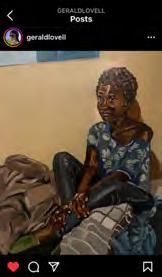
Then he took a trip to LA, saw Kerry James Marshall paintings among others, and came back with a conviction. “The work needs to get bigger. It needs to get bigger, it needs to get better.” The bigness helped; the paintings became more ambitious. He made a painting he called “The Woman with the Eyes, “ which was the first time he said he felt elated. “That was the first one that’s like this size. Like it wasn’t just face, shoulders. And I thought, well every painting going forward has to give me the same feeling this painting has given me.”
And that, more or less, brings us to this remarkable moment we were in now. He quit his jobs, got gallery representation; his work started to sell seriously; he took going big to an extreme, painting a five story mural called “Grace” that brought him more attention; he moved to New York. And now here we were, staring at the self-portrait I was drawn to when I first entered the room. The one with the scissor.
It’s a daring picture for him (“it’s the first time, like, I don’t have a shirt on. I’ve never rendered [a naked torso]-- that’s like half the body.”) Like many artists he’s drawn to painting nude figures, but he’s self-conscious – about his own figure, but he’s also too shy to ask anyone else to sit nude for him: “I don’t know if I can find someone ever to pose naked.” Finding a model to strip, which he could do very easily, doesn’t interest him– his
5
pictures are too personal for that – they are about his relationships.
But what he’s mostly taken with in this picture we are looking at is his own interior, his psyche. He’s become very interested in figuring himself out. At the moment, he’s liking the brooding eyes and their window into his dissatisfaction. But it’s more than that. He’s very open; he hasn’t seemed to harden yet. “I’m starting to settle into accepting that I’m not a child anymore.” he said to me. “I’m like an adult. Like, really an adult. Even though I feel like an adult in a child’s body sometimes. I think that’s where all these self-portraits are coming from, coming to grips with this vessel that I exist in, the things that I’m insecure about.”
Central to the image is the scissors. “So I cut my own hair. Before this year, I’ve had dreads. I didn’t have any spiritual connection to it, it was just easy to groom and I liked the way it looked. But there’s like things culturally that I was trying to avoid by having dreads. My grandfather was from Puerto Rico. There’s a lot of racism in being both Black and Puerto Rican. There are Puerto Ricans who will be, you know, I’m not Black. And I’ve never really felt truly connected [to my Puerto Rican side] because I didn’t know Spanish. And then moving here, and then seeing so much [Puerto Rican] pride, neighborhoods where the flags
are everywhere, I don’t know, I’m starting to develop this relationship with my self. I felt like my dreads were hiding this part of myself. I’ve had Black experience, I identify as Black. But also, you know I’m living alone, there’s a lot of self-reflection going on.”
He’s feeling political pressure these days to represent his work as being about the Black body but he just doesn’t see it that way. “I feel I have more to offer just by revealing more, being throughly honest with myself, being vulnerable.”

He posed the picture with the scissors with the intention of making this painting, and did it in one take.


He got the look he wanted. “I was not happy, and I knew I was not happy. I felt like this was time. I want to be the person I feel like I was always trying to be but didn’t know how to be.” He gestured over to the eyes in the painting. “Once I reached this part, I was like, oh no, this is going to be great. I look tired and like all the things we are. You can observe but it’s not blatant. There’s so much going on in the face, and in the cutting of the hair, but it’s like a sweet spot between okay, the viewer could explore or the viewer could not.”
The painting was not presenting any technical problems – “I think the painting itself isn’t hard.” I found myself envious of how little he’s ever been daunted by the more ordinary
6 GERALD LOVELL
Dolut eliciisqui te volupti ne et fuga. Sit quiae. Ces auta volut verunti aspelic iuntium reium aspicia nobit autempor mi, cusamustius, volor aut vero bersped maiorro destrum sument aut esed quaspe lam que et aliquib usdandentur
challenges of art-making, like just getting the paint to do what you want it do. The work comes easily to him, even as he’s vexed by the more personal aspects of its presentation. “People talk about mastery and stuff, they love to throw that word around. But if the work still makes you uncomfortable, unsure of yourself – do masters still get unsure?”
He’s a little embarrassed by this painting “because there’s no way to present a huge painting of yourself without it coming off like vanity thing.” We talk about its vanity, and I reassure him the painting seems honest, not grandiose. It’s hard to resist giving him a little hug.

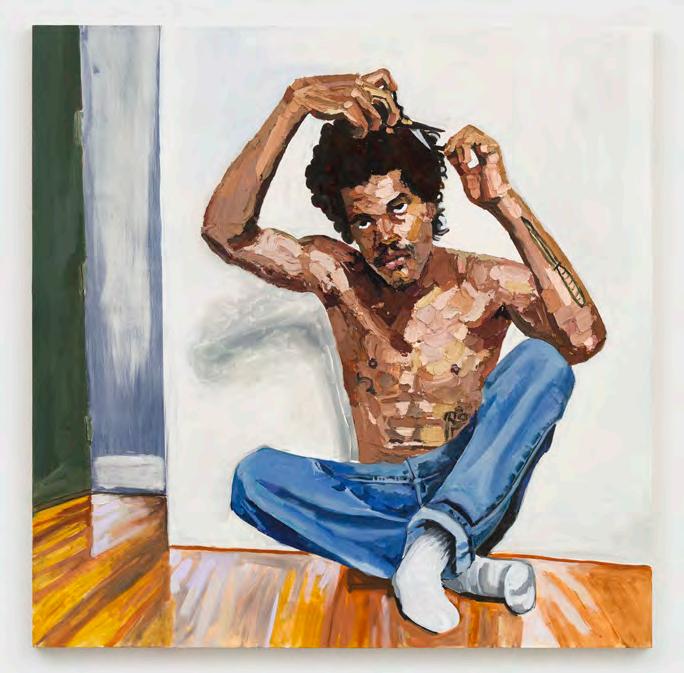
**
After he was done, we spoke again, and I asked him what he was working through as he continued through the picture. The last figure is the final work.
“Getting a composition to work in a square was really tough,” he said,” but I liked how the legs and the arms made a circle of C’s in a non-symmetrical way, I thought that was pretty cool. Technically the hardest thing was the hair.
I didn’t put highlights on it the way I usually do – the shininess came from the medium. But the hair is nothing but green and red on top of each other. And then the tattoos – I painted over the tattoo, then I went back with like a brush and carved it out of the paint while it was still wet.”
But mostly he was satisfied for reasons that had nothing to do, specifically, with the painting of it. . Everything we had talked about during my studio visit was in the painting. The eyes he had painted first that he had liked so much actually contained that feeling of unease that was so conspicuous to me during my visit. “I really love this painting.” he said. “I feel like I’m begrudgingly on the wall. Honestly there was a lot of stuff I was working with – like my place in the art world, and feeling like that world is an unhealthy atmosphere for an artist.” He loved the snarl in his expression. “It feels like a moment in time where I was just documenting my own personal angst.”
“I ended up calling the painting ‘Chameleon’. I was painting a
7
JODY WILLIAMS & RITA SODI Stay Simple
occupation : First Lastname
work : Svizzerina
born : 19TK
THERE’S ONE DISH I crave most when I’m hungry and tired, and that’s a hamburger. Not any hamburger: I want a svizzerina , which is not even a hamburger according to its makers though it looks like one. The svizzerina is a crunchy disc of chopped strip steak that is almost vermillion inside, with a little rosemary and confit of garlic on top. It’s really delicious. And it is, to me, a work of art. Is it a work of art like a painting or a poem? I suppose not, but I include it here because a) I was curious about how Rita Sodi and Jody Williams had arrived at the svizzerina’s sublime simplicity; b) as with the entry on Samin, I wanted to know how the process of creating food compared to the other subjects of this book. The svizzerina is served at a kind-of -trattoria named Via Carota, which the New Yorker called “New York’s most perfect restaurant,” a restaurant that also serves a simple/ complicated version of a green salad that Samin called the “world’s best salad.” Via Carota is just one of four astonishing restaurants and one bar the couple own within a four-block
occupation : First Lastname
work : Svizzerina
born : 19TK

2 JODY WILLIAMS AND RITA SODI
Dolut epti ne et fuga. Sit q tenisuptam, ex ex ea.
39
very bougey radius near my home. During the period I was talking to them, they had just taken the lease for a fifth.
Jody and Rita had each set up her own smallish restaurant when they met-- Jody’s was a French place called Buvette; Rita’s was Italian and called I Sodi. Jody saw Rita at I Sodi gnawing on a rack of lamb bone and maybe that was the moment she fell in love. In any case, they started dating soon after. They make an odd couple, both geometrically and in temperament. Rita is angular, taller, more reserved. Jody is softer, closer to the ground, more garrulous. Jody had restaurant training, Rita started her restaurant impulsively, knowing pretty much nothing about the business of food, though she was a serious cook.
“We start with a different opinion on everything.” Rita said, when I asked how they make decisions together. “But the more we work, the more we agree.”
Jody: Rita, you always say no, no matter what. In fact she does this [lip smacking sound].
That’s the same sound for no and yes. Is that right? Is it true?
Rita: It’s not true.
Jody: You know it’s true. And I won’t give up. But whatever the struggle with us together, what comes out is so much stronger”
I ask if it’s always a consensus in the end. Rita [to Jody coyly] Okay, now I want to hear what you say.
Jody: In the kitchen it’s a consensus. In a bigger project like the design of this restaurant [we were sitting in a restaurant they were preparing to open], I win by losing sometimes. I need to keep things moving.
Rita: We are very different, but at the end very similar.
It’s often said that restaurants are imbued with love – they mostly don’t make a lot of sense economically (though that’s not true for this couple, who do very well), so passion has to play some part – and in Jody and Rita’s case that takes several forms. It’s obviously a love for food (Rita says her interest always starts with memory: “The flavor I’m missing, the smell that I’m missing. I start with this. The biggest part is nostalgia.” Jody: “I think I bring to the table a little gluttony – the desire to eat and have it all.”); a real passion for creating environments; a need to use the restaurants to make their own relationship work; and a more primal need to be loved back by their audience or, in this case, customers, along with the battle not to let this need screw them up, which I recognized from my conversations with conventional artists.
Here’s Jody’s account of the beginning of Via Carota:

“I was doing Buvette, Rita was doing I Sodi and we had this friendship, and dating. And we were so busy, you know I said, it’s a joke, we were crazy at planning. And we said, if we really want to see each other we should open a restaurant together.
“And then we looked down the street and we saw, what was it? This restaurant [which had been the site of many failed restaurants before], and you know it’s sad when a restaurant
3
sort of languishes, then decays. And decays. So we said, let’s do something there. An ode to Via Carota – we were referring to Rita’s place on Via Carota [in Milan?], that we had spent some time in together. And then, it was okay, call em up. And we’re talking to them, and there’s always this moment when I look at Rita and she says, “Let’s do it.” She does not hesitate. And then it’s like hell or high water, we’re gonna see it through.
“So then well, let’s find 85 chapel chairs, like the ones around her dining room table at Via Carota --- we find them at O’Fagan’s Antiques. “Do you have 85 of these by any chance?” And you figure it out. 50% ignorance is bliss.
“You know, it’s not perfect sometimes, we learn along the way. We do slow openings, it takes us six months to improve and be confident. And we never really feel confident. We feel like we need to apologize. I’m gonna take your money and you’re gonna put this right now in your mouth? Sometimes it’s just painful.
“I mean, will people come? Can we get maybe 60 for lunch and 100 (for dinner)? We’re totally panicked.”
Their idea for Via Carota was unconventional: a restaurant built around side dishes. They didn’t want fine dining, they didn’t want a conventional Italian restaurant, they just wanted what they wanted. “We were envisioning a menu that sort of is deconstructed, so you can really have the freedom to eat all the sides. We never really want to eat all the
meat and fish on the menus, we just keep eating all the beans.”
I was there the very first night. I walked by, saw that it was open, took a seat at the bar. A few months later I couldn’t get in; the place was mobbed. It’s been that way for tk years. It’s probably my favorite restaurant in the world.
Jody hauls out a bunch of old pages she’s saved, some of which are represented on these pages. (Rita, incredulous: “I don’t know why you never threw those out.”)
On one page is the directive: stay simple. I ask Jody what that means. “You might feel compelled to do something to be liked. Will you love me? I want to be loved, you know, I can like overdo it. Yeah, so stay simple. It’s good when you can no longer take away.”
That dictum especially informed the creation of the svizzerina, their own little Mona Lisa. I find the word scrawled in their note, along with a little picture, doodled as they first envisioned it.
So here is the evolution of the svizzerina, which does in fact follow a familiar pattern It took them about a day to devise:

4 JODY WILLIAMS AND RITA SODI
1. Pose a problem. Jody: “At first we were thinking, would we want to do a hamburger?” said Jody. “And we’re like no. We can’t do that. Because that’s all anybody focuses on. I mean, we love hamburgers. But it just didn’t fit on the table [of sides]. A hamburger doesn’t go on that table. A hamburger is a sandwich, a hand food, right? It would disrupt the sharing, for one thing.” Nevertheless it seemed they’d really need a hamburger-like thing.
2. Dig deep; or start with what you know. “And then we realized we had inside Rita the stories of the svizzerina. The svizzerina is what they grew up eating in Italy. It was like for iron, if you’re run down. And I knew flambe hache, which is a French seared steak, raw. It’s a bistro thing. Like cooked steak tartare.
3. Allow yourself not to know what you’re doing. Rita: “We tried everything.” J: We didn’t have a lot of confidence.”
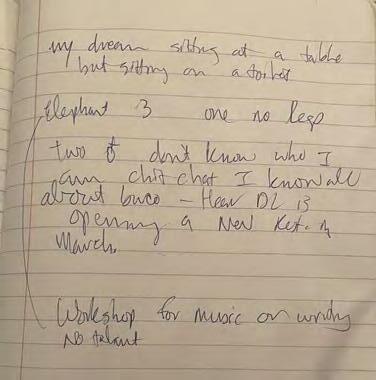
4. Consider your materials. Jody: “You could do rib eye but you get better texture with the New York strip.”
5. Begin. Jody: “And then you can take the fat cap off. You chop the fat, you chop the meat.”
6. Complicate. Jody: “The fat has a different consistency than the meat. When you chop it together it’s a little bit of a mess. If you divide the consistency, it’s easier to chop and it’s more precise work. So we chop the meat and then we’re missing the fat and we’re folding it back in. And it’s becoming more speckled and brighter with the fat-and if there’s not enough, like a 40-60 ratio, you put more fat into it. Fat is where all the flavor
Henim andio. Ehenis auditae reptissum et aut autempe ritati debis dolliquas atumqui antionsequia nis elessum volorep erfere voluptat. Mentotatem et ex estiundaecta esti ullabo. Orum hit voluptae alit dolupid endi dictur, non consed eiunt haritat invelecto vellest, consequidel et laborum coreptat mi, sequunturio. Aximaximus, to evelendenda nosandae voluptas voluptate ernate acipiet quias rehende nimolor erferro dis el maio. Nempor assitatibus eic to eosam rate aut dis consectiat maximporent, ne sinum a nonsequis et exces es el issimpore nem voluptatae nonem fuga. Ut vitius niasimpor magnis maximost, abo. Ut eossed qui dolorro conse sum fuga. Itas et lacerit lab idebis rem sum fuga. Lament aut quae nimaxime volorro restem sequissitio blaciis dolum quaspiet vel imaximus, am, odis duntiae volori adis et asin et, inctata dellaut repti volor repratenet aut dioremped event quis velluptati ant. Consequaera verae
and joy is. You don’t season it. You put the steak back together.
7. Make it yours. Jody: “You’re gonna do it on a flattop. It’s gonna be hot. So you can really sear. And then you season and you let it go. It’s very rare. You basically want the meat to sear and crunch. You’re looking for two extremes. You need your seasoning on the outside – salt and course pepper --cause you’re not seasoning inside. Because then it’s like making meatloaf. So you want it very rare inside so the fat sort of becomes opaque inside.” Sometimes people ask for it to be less pink. Usually they say no. Jody: “you eat it like this or not at all.”
8. Experiment. Jody: We’re not gonna do hamburger, but let’s put a piece of bread under it, do you want to do that? Let’s do it with focacci – no that’s gross.” So, no bread.
“I added fried onions on top. Boop, boop,, boop, boom. Like an onion sauteed, carmelized onions on top.” So, no onions. “Potatoes. We tried a couple different potatoes. We’re not going to dumb it down by fearing that someone’s going to want french fries,” So, no potatoes.
“Sometimes we don’t know what we want; we change our mind in the middle of everything. And then all of a sudden we just did the garlic confit and some rosemary fried in olive oil over it. And we thought…
Rita: “That’s perfect.”
Jody: “When you can no longer take away, the dish is done.”
5
Dolut epti ne et fuga. Sit q tenisuptam, ex ex ea.
TAYLOR MAC & MACHINE DAZZLE


A 24-Decade History of Popular Music
occupation : First Lastname
work : Don’t Hold Back
born : 1900
occupation : First Lastname
work : Don’t Hold Back
born : 1900

2 TAYLOR MAC & THE MACHINE
40

DURING 24 HOURS from noon to noon the weekend of October 15, 2016, I was an ecstatic captive of a cult leader named Taylor Mac in a theater in Brooklyn. I know the date because the performance I saw occurred only once, and will never again, in its full 24 hour duration. It was called A 24 Decade History of Popular Music and it defied easy genre. I guess it was a performance piece, but its scale calls for a different description-- maybe a Happening (though a very structured version of one); or a ritual, led by an immensely charismatic leader in drag vestments that had a mind of their own. Some of my friends were going. I was cranky and hesitated because –24 hours! I was afraid of feeling like a prisoner and I really hate immersion theater experiences, but I went anyway. I was persuaded it was a once in a lifetime kind of thing. Wesley Morris in the New York Times called it “one of the great experiences of my life.” And it was for me too.
We often see creators as God-like because we are asking them to take control of our experience (reading their book or listening to their music) but I’ve never seen such a vivid demonstration of the God principle in action as I did that weekend. Over 24 hours Taylor (who I knew a bit) took the audience through the entirety of American history, one decade at a time, offering an inverted, or ‘queer,’ mirror as a lens. Each decade relayed the American epic from a marginalized (Black, Jewish, gay, etc) perspective; each used popular songs of the decade to tell its story; each involved audience members participating in the telling. But that doesn’t begin to convey what was going on. Taylor staged The Mikado on Mars; pitted Walt Whitman against Stephen Foster in a fighting match (asking the audience to pelt the loser with ping pong balls); restaged the Oklahoma Land Rush and suburban white flight by coaxing the audience to enact their greed and panic by racing around grabbing things; took us to a same- sex alternative version of our high school prom in which we were commanded to dance with a same-sex stranger;
fed us soup on an approximation of a Depression bread line; woke up whoever was sleeping at the 18- or- so -hour mark with a kid’s marching band he’d invited to enter and blast our eardrums, thrillingly. All the while Taylor bossed us around; he crooned and belted and exhorted; and we surrendered. It was in fact very culty. We might have done anything for him.
There were 650 of us and we were at his feet. Taylor was above us on a stage. His orchestra was behind him. (There was a loft to nap in if we were fading). Throughout the 24 hours Taylor lured us to fall in love not just with him but with his collaborators. Then one by one they were banished from the stage, so that by the time we reached the AIDS era, we were feeling the crushing grief that came with the epidemic. The epidemic was why we were all there, but it was never explicitly about that. We were led subtextually into sorrow. In the end Taylor was alone.
But though Taylor did more to embody the deity we project on all creators, there were other artists making it happen, and they were just as staggeringly inspired. One, particularly, called Machine Dazzle. Machine was Taylor’s costumer, friend and frequent collaborator. Taylor had come up mainly as a downtown performance artist; Machine made costumes for a troupe of deliberately terrible dancers that mostly did nightlife gigs. They found each other and started to play together on a piece of Taylor’s called The Lily’s Revenge.
But this show would be each other’s masterwork. For A 24 Decade History, Machine dressed Taylor in elaborate wearable dioramas, dresses and headdresses that existed on a parallel plane and told their own story of each decade and were usually hilarious, made of frankfurters and eyeballs and cassette tapes full of coded references you might grasp or not before Machine yanked them off Taylor and replaced them with an even more flamboyant and knowing narrative sculpture; they were more sculpture than costume. There were dozens of them. They were their own
4 TAYLOR MAC & THE MACHINE
spectacle; in a sense, their own show. Years later they got a floor of their own at a show celebrating Machine’s work at The Museum of Art and Design called Queer Maximalism. That’s an apt description of both their work. Taylor’s famous maxim is “perfection is for assholes.”
These two artists spew-- you could easily imagine they don’t edit anything out, but that’s not at all true. It’s just that they’re not at all bothered – in fact they relish – the mess of being all-in. So the difference between them and other artists here is more a question of valve than method. Of the two, Taylor is more swaggering – controlling but seductive. Machine works in his own world, Mad-scientist-like, making creations from found objects whose wonder only he can see. Each is very devoted to his own invented, twisted vision, which happily intertwine.
I really admired the way they fed off each other’s talents, and wanted to talk to them together. They agreed, and we sat in my kitchen trying to piece the evening together, and discuss how they got there. I was surprised at the extent they worked separately-- in fact, had no idea what the other was doing. That’s a product of knowing each other so well and being years in sensibility- synch, but it makes for a very unusual collaboration. Taylor held secrets from Machine; in turn, Machine wouldn’t tell Taylor what he had made until he showed up with it.
We decided to focus on something they called the Blind Reveal, which occurred some hours in after a decade in which the audience was blindfolded and asked to flirt with each other, playing musical chairs in the dark and ending up on a stranger’s lap. For this conversation, Taylor and Machine wanted to talk about what the audience would see as our blindfolds came off. Taylor’s costume was, after all -- as Machine put it – both costume and set. The moment was, they both thought, a rich creative opportunity (they had covered our eyes for an hour and then had one shot to startle us) and they spent the better part of years, as they workshopped the show in three and six and eventually twelve-hour increments, in effect training for this one-night only performance, trying to get it right. (They still perform the show sometimes, though just a clump of decades at a time). The costume evolved with the moment, which eventually involved Taylor flying in a harness – Taylor up in the air, in a cloud of balloons. You can see the versions in the surrounding pages.
The show’s beginning
TM: We were working on this other play The Lily’s Revenge. At some point before it ended its run I realized that what I had been doing with Lily was a five hour play with 36 people in it, and I had some kind of realization that I was subconsciously reenacting an AIDS Walk that I went to when I was 14 in San Francisco.
MAXIMALISM’S BEGINNINGS
“I had a very supportive mother in terms of being an artistic human being, and a negative mother in terms of being queer.” said Taylor. ‘’So it was mixed messaging. But I can’t say it was a good childhood, I’m sorry. And I think this is where Machine and I are a little similar. We stored up all the things that we imagined and wanted to do. And then we got to the age where we could do them, and then we wanted to do them all. Don’t want to hold back anymore.”
“When it was time for art class, “ said Machine, “I would do the assignment 100 times, everyone else wouldn’t even do it once.” That zeal eventually developed into an aesthetic. “I have a million ideas. I want all the ideas in there. And I’m going to kill myself to do it.”
5
I’d never met an out homosexual before, and suddenly there were thousands all at the same time. I found myself chasing that feeling of wanting to stage that without really knowing I was doing that. And I thought, why don’t I do that consciously for my next big project? And so I started to think about that, looking for a form for it. And I don’t remember exactly when I thought of popular music, but I was thinking that the content is communities being torn apart and then building themselves as a result of being torn apart. But the thing about the popular song is that it’s not reaching for the hem of God, it’s reaching for community. You remember the song because we
repeat the chords a million times. The popular song is saying, let’s use our frailty to gather together. And the queer thing is, what connects queer people isn’t our sexuality it’s that we’re outsiders.

And then part of it for me was, can we make the queer person represent something other than a queer person? Can we be the metaphor? And then: I’M gonna be the metaphor: one queer body will be the metaphor for America while grappling with the history through these songs that have been written. That was kind of the idea.
AM: And the 24 hours, full sweep of American

6 TAYLOR MAC & THE MACHINE
THE BLIND REVEAL: 1st Try 2nd Try
history part, was there from the beginning?
TM: What became a kind of happy accident— I wish I’d thought of it before — was that I just realized one day that I was literally joining 240 years. And so that was… 24 hours. One for every decade. So the math just started working out. And then: when would I do a 24 hour show? 2016. So we had to try to get it done by then.
Yes, and then Machine came on. Though in my mind Machine was always on board, because Lily was such a joy.
AM: Machine, do you remember when Taylor explained the idea to you?
MD: It didn’t happen right away. [Turns to
Taylor] You didn’t spill. You didn’t spill all at once. I remember you were in Europe. And you were like, Machine, I need an 1890s inspired outfit. I didn’t know what it was for at first. You had something in your mind. As far as I knew, it was for a photo shoot. I never saw you, we never had a fitting. But you kept it, the one that had patches of candy.

TM: It was for the first of the three decades we started with.
MD: Yeah, but the thing is it was actually a while — months, or even a year, before you asked me to do a 1970s thing [which was the next decade they made]. You were like now I’m doing the 70s. And while you’re at it, let’s do a 1930s too. And I thought well okay, this is interesting.
AM: You never asked him why he wanted these costumes?
MD: No. And then you called a meeting and came to my workplace where I was a jewelry designer. And you said, what I want to do is a 24 decade show. I didn’t know it was going to be 24 hours. You spilled that we were going to do 24 decades in 24 costumes. But I still had no idea it was going to turn into a marathon!
TM: Yeah.
MD: I was like, Oh my God. I thought, what’s great is I can start thinking about all those decades now. I had the luxury of time to just figure out ideas and start little piles of sketches.
AM: And was the basic aesthetic in place from the very first costumes you made?
MD: No, the early ones were a lot more experimental. They would fall apart. They were very garbagey.
TM: One of them was even on paper. And it only lasted the night I wore it.
MD: I started working on the opening look. The wig is made from macaroni. And then I added a witchy vest thing that actually says 13, with stars on them— because you know, 13, great number. And then an old pair of gloves and then better gloves.
TM: And then the shoes are perpetually evolving, being repurposed.
AM: And Taylor at what point did you start
7
3rd Try
to see it as a single show?
TM: Well the concept was that I was going to workshop all these shows at Joes Pub, where I would break even paying all the musicians, like maybe if I was lucky I’d make 100 bucks. And then eventually we’d put it all together, and it would be real ragtag you know? But beautiful. And then along the way these producers Pomegrante Arts that did Einstein on the Beach saw it, and they came aboard, and then it was like, this vision [to do the entire sweep at some point] can actually happen. We’d done maybe ten workshops, maybe half the decades. But once they came on board, we started doing these decades again. And part of my concept at that point was we would make itwith the audience. So it would become a ritual. You would want to come back to see how the decade evolved. We would workshop it for many many years. It was like a Ponzi scheme— we could be booked for the next five years with one show.
Anyway so we couldn’t really rehearse. We’d just make sure all the charts were correct. But no one would ever hear what I was going to say on stage.
AM: Had you written it out?
TM: Yes, but no one had heard it. Did it change a lot or just on the margins?
TM: Often a lot. Whole new concepts.
AM: So you didn’t tell Machine, but did you always have it in your head that you’d be doing all the decades together in one show?
TM: It was always going to be something we could do in one night. I think I didn’t tell everyone because even though people are pretty game with the big projects, I always get a little flack for having ambitious ideas…
AM: Do you? I mean, that’s who you are—
TM: Well it’s like why do we have to work so hard?
MD: Except me. I would never…
TM: Machine’s always the one who says Oh wait, bigger, yes, let’s go! Also I don’t like to say fully what the concept is right away because it may change. I kept that to myself for a few years. It got to the point where I was asking
myself do I have to get butch, do I have to get aggressive about having a vision and defending my vision? It’s not fun to have to do that with your collaborators who you love.
AM: How much time would you give yourself to work out the particulars of each decade?
TM: Months. I work very content-dictates-form. So I would say what’s the decade about? Okay, let me go hunt for songs from that decade..
AM: And you would decide what the decade was about, as opposed to it being a conversation among all of your collaborators?
TM: Yes. I put an offering on the table. I want to have the thing people are responding to. But I don’t ever dictate to Machine what to make. Because Machine never tells me what to make. I know that it’s very rare in this industry.
MD: Nobody else that I know has the relationship we have and the trust we have. I mean, Taylor at this point could work with anybody. They choose to work with me. I’m really lucky.
TM: Oh please.
But this is true. I was talking to this Broadway scenic designer who’s got more Tonys than anyone — I think literally — and he said to me he feels his entire career is just, he makes something and then the director says great, can I get that in orange?
AM: You don’t give Machine any parameters at all? I mean, obviously you told him you wanted to do it in drag…
TM: I don’t think I ever even said that.
MD: There was only one thing you ever asked for specifically in 24 decades. You said you wanted something to represent a man and a woman and I showed up with the most basic thing, but it really works: a lock and key. A heart shaped lock and a big floppy key.
TM: I might have said something like, it’s all a metaphor for robber barons. Also I need a costume that I can take off and put on an audience member. Functional things. But that’s all. I just know what he does. When we started working with each other, we were drawn to each other, to our aesthetic.
8 TAYLOR MAC & THE MACHINE
AM: So one more question before we get to the blind reveal. I’m curious because I found it so affecting: the stripping down the population on stage, decade by decade, when did that come into your thinking?
TM: That was also early on-- like, within the first week of realizing I wanted to do this because it all come from the AIDS epidemic. I wanted the show to get harder as it goes along, I wanted it to be a challenge. And so it was important that you feel a loss.I wanted the audience to be surprised but feel it. Okay, we’re losing the trombone. Not trombone.
MD: The tuba. That’s the first one.
TM: So we’re losing the tuba, the audience cheers, but they don’t really connect to what is happening until the 20th century, when they start losing people they’ve gotten to know. They start to gasp.
AM: As you were workshopping the show, what would shift? The music, your language, the theme?
TM: All of it. We would try different songs, different concepts. This song isn’t doing anything. Can we make it minor? Can we slow it down? I mean generally, how do you rehearse something like this? How do you rehearse blindfolding an entire audience? We would have to experiment during the performances.
AM: Can you take me through a song change?
TM: Ok, here’s one. So this was the decade of the 50s into the sixties. We were doing that Pete Seeger song “Turn Turn Turn.” We’d rehearsed it in the music studio but when we got to the concert, it was like, blah, horrible.
AM: Because it was treacly?
TM: Honestly, it was because none of the musicians liked it.
So I’d been thinking maybe we should do this Peter Gunn song instead [the theme song to a popular fifties TV show]. I said, can we play this? And then everyone loved it. It became a staple. It’s one of the only ones we really mash up...
AM: So you mashed it up with Turn Turn Turn. TM: Yes, it just gave us excitement from the get go.
The Blind Reveal
AM: Let’s move on to the blind reveal. What was it?
T: Well, you know four hours in the theater is a long time for most people. I’ve gotten them up in the first decade to stand for a song, and then it happens again in the second decade, the women stand up and go Ooooh, and then in the third decade people stand up and play beer pong, spitting at each other. But when the fourth hour is over, I thought they’ve been staring at the lights the whole time, we just need to do something radically different. So I was researching the decade and it was roughly when Braille was invented, and I thought, that’s perfect. That was in France, and in America the War of 1812 was over, people were committing to the idea of America in a way they hadn’t yet. So they had to figure out how to see anew, feel anew, listen anew. And it just felt right. We need a bit of a palate cleanser after all. And if I put it in too late in the show we might put people to sleep. So I just thought now is a good time to blindfold them, and then we can make them do musical chairs.
AM: Well, if I remember right, it wasn’t just musical chairs, it was a little like sex in a backroom.
TM: Exactly. People sat on your lap.
TM: Well, the reason you picked up on the backroom is we had a dramaturg early on who championed finding ways to connect the various decades together. I knew I was going to do a backroom sex party decades later. So I was like, how can I give them a backroom sex party experience in the 1800s-- especially without having to deal with sex as the issue. So in a sense we were queering the audience. AM: At a certain point you’re going to tell them to take off their blindfold, and there’s a thing that you want them to see. And I assume this is the thing you kept rethinking.
TM: That was Machine...
MD: It started along these lines. At one of the earlier shows at Joe’s Pub [before the blindfolding] I showed up with a dandy outfit because
9
it was like the height of the dandy-- all these highly effeminate...
TM: Cis men. There is even a song about the dandy in that decade.
MD: But I didn’t know about that. I did my research about the decade. I didn’t know there were songs. I’d never been to a rehearsal, I just show up an hour before Taylor goes onstage, he hadn’t even tried on the costume. I don’t remember ever doing that decade again until we really started putting the shows together.
TM: Eventually Machine’s concept was that it would be the most amazing outfit in the show.
MD: Because by that point, they were blindfolded. And when the blindfolds were removed, they would see the dandies. I kept building it to make it bigger and bigger. And when we had the capabilities to fly you through the air, somehow it got even bigger. First he was revealed somewhere on the other side of the room.
TM: Up in the loft yeah.
MD: But when we started going to theaters where you could fly in a harness...
TM: The audience freaked out.
MD: I could do something huge! And that’s why those balloons came.
AM: But at first, in the pictures you sent me, it looked fairly demure.
MD: That was at the beginning, when we were doing little bits of the show at Joe’s Pub. With the wig? And the top hat?
TM: It wasn’t particularly fabulous at all.
MD: Well no...
TM: This is what I found out about Machine. Often he will show up with something jaw-dropping from the get-go, nine times out of ten. But then the one time, he’ll show up and it’ll be Okay, this is the beginning of an idea...
MD: That was before I found my recipe. I kept building on it. The top hat that exists now is still the top hat. I turned a dress into a jacket. It’s just so embellished you don’t see it anymore. And one day I’m like blowing up balloons and covering them in tulle …
TM: This is a man who loves working, so the goal isn’t to get it done. The goal is to work.
AM: Talk about the recipe.
MD: I didn’t get the recipe until we had workshopped about half the shows out. All of a sudden I realized, wait, this outfit is solid black, the Jewish decade was black, the 30s were black. And then I just realized I had to do more. I rarely take away. I add things, and then I started to get a little more gimmicky. I love all the pageantry. But I was really starting to get all this at Joe’s Pub. I realized that when Taylor walks on the stage, he’s not only the costume, he’s the set, he’s the props. I’ve got to give the audience something to look at.
And so then it was, I know you look absolutely silly. But the audience is going to love it. Trust me. Sometimes when I’d watch Taylor I’d think, maybe that costume’s a little too easy. I think he could handle more.
And then of course I keep experimenting. I look at what they’re wearing at the time. That’s where I start. That’s what most historical designers would do – the silhouettes. It’s a piece of the pie but not the whole pie. And somewhere it clicks. What was new at the time? And then: what was invented? How can I turn that into a costume? The second decade...
TM: … Yeah, that one really evolved. It’s so gorgeous now. . .
MD: … was when the steam engine was invented. And so I put steam stacks into Taylor’s costume. At first they were tulle. But then I got the balls to do dry ice and boiling water.
TM: He would put boiling water on me backstage.
MD: Well, not on him exactly. But you know, emotions become sculpture.
AM: I assume you imagine that the audience is subliminally getting it, even if they’re not seeing it precisely.
MD: Most people would never get all the references. I want people to figure it out, or get Aha moments. Anyway, at first it’s a dress turned backwards and cut open like a dandy jacket with tails. It was really colorful. And there was this weird codpiece that was really malfitting. It was like fur.
10 TAYLOR MAC & THE MACHINE
TD: I forgot about the codpiece.
MD: It was a weird thing. And then I just wanted it to be pretty. And then, once the audience was blindfolded, it changed.
TM: I’m basically in my little panties and shoes. Or barefoot. And then Machine would come out with one part of the outfit and put it on me while I’m singing. And I’m singing with a microphone and he’s got to put things over my head.
AM: Which the audience isn’t seeing.
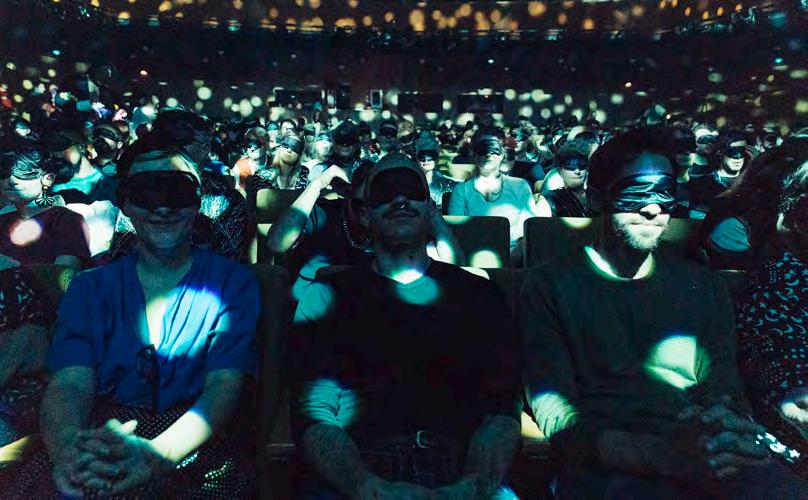
TM: We want them to be concentrating. So we’re asking them to pass a flower on, tease the person next to with your flower -- while I’m taking off my shoes, creeping around.
MD: So what happens is we get you dressed, you end up somewhere in the theater, or you’re in the harness and you’re flying. And then they take off the blindfold. And it’s big. And it’s pretty. It’s the kind of thing you want to look at and adore like a flower.
TM: Like, this is what I’ve been wearing the whole hour, and now you see it.
MD: And then it’s just all balloons. I wanted you to look like you were in a cloud, the dandy
in the cloud.
AM: You were just building on top of the Dandy jacket and top hat you started with?
M: Right. When we were at the Curran theater, in San Francisco, there was an amazing craft store, a discounty place. I still had the jacket and top hat, but I knew I need more. [To Taylor] I think I might have had you in fishnet, and those lace gloves. And then I found these great flowers, and I built the hat with all those flowers. I spent like hundreds of dollars in that store! Oh my god it was so pretty. With all these silk like scarves and weird salmon colored dressing. And I added this big pussy bow.
TM: He loves the pussy bow.
MD: The thing is, we would dress you up on stage, and then you would travel, and most of your costume wouldn’t even show, like you were peeking out of a thing, saying I’m up here...
TM: And then you had the balloons.
MD: I started doing the balloons.
TM: The balloon was like a boa.
MD: I probably had 20, maybe it was 40 balloons. I started covering them in tulle like poufs. And it looked very pretty. Light-colored. And it started to become the cloud.
AM: And that was that?
M: Not quite, he was still on the ground. In Philadelphia, I realized he was going to be up in the air, flying. So I’m like, finally a real cloud! And I blew up as many balloons as I could. And I wanted to move Taylor like a cloud. And so that was it. Finally after so many cities, we flew, and then it became like the dandy floating in this huge cloud of pastel balloons. Full on dandy fantasy.
AM: I know you say you’re never going to do
11
Caption Teekay
DAVID SIMON CREATED The Wire , one of the most ambitious television series ever made, which elevated itself from the (very good) cops and robbers show it seemed at the outset to an (even better) critique of the American city and of capitalism generally. This it did very deliberately in season two, when Simon made the crucial decision, amidst much disagreement, to shift the show away from the dramatic world it had painstakingly built in its first season to another -- seemingly unrelated-- one in order to turn the series into a bigger, more blistering argument, a radical creative choice he explains below.
Simon uses the word ‘argument’ often, in many contexts. He is far more interested in argument than art, in spite of the fact that he happens to be an unusually artful storyteller. But his success as an artist is less about the free-flow of associations you see a lot in these pages and more about what looks like the opposite: a dogged, polemical mindset that took hold very early and hardly budged. In our conversation, we traced the evolution of that mindset and of his unusual career, which I was interested in because he didn’t start out with any interest in television at all – in fact, it seemed closer, as he recounts it, to disdain. Most of the subjects of this book revered the medium they were trying to master; Simon tolerated it.
Simon was a newspaperman, even a newspaper type – he resembled many of the men (this is mostly a male archetype) I met during my years as a newspaper journalist: gruff, smart, deeply class-conscious and quick to outrage. He entered television accidentally, and mainly as a way to sell his books of journalism. His timing was excellent, coming along with experience in a kind of gritty narrative that suited the early days of HBO and prestige cable. He became interested in journalistic storytelling at a very early age, and his convention-flouting temperament seemed to develop around the same time: the way he tells the story of his childhood, his destiny was obvious. But he was also quick to deflect
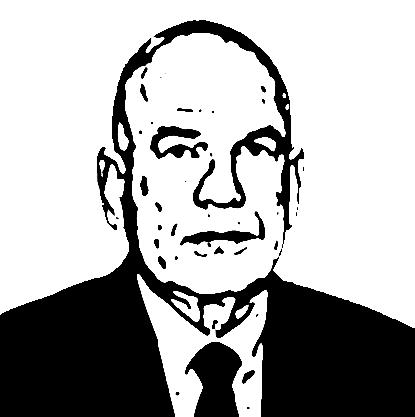
2 DAVID SIMON
41
occupation : Screenwriter work : The Wire, Season 2 born : 1960
DAVID SIMON Arguing
suggestions that he was any kind of auteur; he frequently emphasized the collaborative nature of his work (and particularly the way he works), and indeed you will see that much of his day to day consists of tussling with and wearing down collaborators and higher-ups. By al evidence, he is a brutally effective arguer – it may be his core talent. Still, he is clearly the main driver of all his work: everything about The Wire, or the two books he wrote and co-wrote, Homicide and The Corner , or the many series that followed The Wire – Treme, The Deuce, Generation Kill – seem very much
a product of a sensibility rooted in urban realism and a specific, 19 th century talent for telling detail-and-character-rich stories as vehicles for political and moral critique.
A hard-boiled childhood Like for so many, his sensibility was largely inherited, in this case from a father who had romantic (and frustrated) ideas about journalism. “My dad wanted to be a newspaper man,” he said. Instead,“he got hired to do PR in the Brill Building [fn1] Brill was music. Good steady job. But he had friends who were

3
Disam res nemodia nis se di dolorro
newspapermen. The guy he really cultivated was the religion reporter of the New York Times, a man they called Pat but whose real name was Irving Spiegel. Pat could recite Shakespeare in Yiddish – on a table if people weren’t paying enough attention to him. He was a fucking character. My mom could barely tolerate him.” But Simon was entranced, and inhaled all the usual hard-boiled texts – “Dashiell Hammett, Damon Runyan. It was in the ether of my house. We would parse this shit around the table.” Simon’s voice – the way he talks, the way he writes – seems almost lifted from these books.
And this is the string: When he got a job at his local paper, The Baltimore Sun , he was assigned to the police beat, where he got to cover “the mass production of murder. So now I had a canvas. In Baltimore they had I guess it was 250 murders a year. I was always calling at 10 at night, trying to get those angry Irish bastards to put up with me, and tell me if there had been a couple of murders, like give me some details. You know, motherfucker, just give me enough to write three paragraphs? I’m trying to cover my ass here. We were a morning paper, you just don’t want to get beat by the afternoon paper. I started going to the unit and just hanging out.
“And so Christmas Eve, after I’d gotten to know a few of them, I walked up with a bottle, about 9:00 after the bosses had gone. I’m Jewish, I don’t care it’s Christmas Eve. So I had some good whiskey and paper cups. And we sat around bullshitting and they started telling good stories of … you know, Christmas murders. Which is like a whole sub-genre of degeneracy. It was funny, absurd. I wrote it up as a column, Christmas Eve in the Homicide Unit, which is almost its own punchline.
“When I sat down to write the column – well first let me explain that the Sun, like most papers, had a honorific policy. Everybody was Mr. or Detective or Sergeant.
“But you’re talking about a unit where the guys know each other by their last names at
best. You didn’t want to stumble over your newspaper’s ornate style. You want to face the newspaper’s audience and say, He said this, that’s why I can say it. He said it and I fucking believe him. So now I’m going to be in his head. Say ‘Landsman thinks,’ you know.
He was reflexively a finger-flipping guy but this simple act of subversion was enormously productive: it opened up a creative world to him. “By starting to say fuck it to quotes, shedding all its newspaper conventions, it really started to read like good fiction, that was a revelation. After the column had already run, the paper’s management figured out that I had taken out the honorifics, an editor comes back to me mad, says you pulled a fast one of us.”
Simon took a leave to write a book in that style. The book was Homicide: A Year on the Killing Streets, which miraculously sold to television and became the NBC show Homicide. Simon himself didn’t watch much television – old movies and sports mostly – but they’d sent the book to Barry Levinson, the Baltimore director, -- “ I think NBC had turned Levinson down for a show based on Diner. They said, you got anything else? Levinson [and his people] had gotten my book over the transom and read it and showed it to the network and boom.”
They asked him to write the pilot for Homicide, which he declined. He was already writing (co-writing, with one of his police sources named Ed Burns) another book The Corner, this one set on drug-infested block in Baltimore, which was much more important to him. And he wanted the series to work so he could sell more books. This is the way he describes it – television meant pretty much nothing to him. I asked him whether the prospect of writing for this other medium intimidated him. He paused. He is impatient with any talk of craft as especially relevant to his trajectory, but I was curious.
“I looked at a couple of scripts. One thing I sensed was pacing. Every line has to justify itself. You don’t start at the beginning of
4 DAVID SIMON
scenes, you don’t end at the end, you come in late and leave early – all the things you could intuit if you were writing and saying, how does this work? People go to school for this shit.
“And I was thinking if this show runs for a couple of years, I’ll sell some books. But if I fuck up the pilot... I didn’t know a guy could come up behind me and fix it, which is what I now know is how you do it. I said, Never mind me writing TV. Get somebody who knows what they’re doing. I said, you know, when you have five or six scripts and I can see what you’ve done with the characters, come back and maybe I’ll try my hand at one. So they did.”
Tom Fontana, who was the showrunner [series mastermind] of Homicide , told him to write an episode following“ ‘a case all the way from murder to Death Row. And being a police reporter I said, well that’s 19 years of litigation. But I didn’t say no.”
He and David Mills, a college friend, wrote the script for the episode in three weeks. “They showed it to NBC and NBC said, ‘This is too depressing, we’re not going to make this.’ “ But they gave the script to Robin Williams, who Levinson had worked with before [fn2], and asked him if he was interested in playing the father, as a guest star. Unexpectedly he said yes. “So NBC said, okay we’ll shoot it now. People like Robin Williams didn’t do TV at the time. And the show pulled a 34 share.”
You hear enough of these stories, you realize how often fortune plays in to success, at least as recounted by a teller humbly reconstructing his story from the top of the heap. But I wanted to know: was he any good at this point?
Simon paused again. “Well, we were overwriting. I would write a paragraph that was too expositional. Tom would write zzzz’s next to it.
“I wasn’t properly servicing the ensemble cast. This is the stuff you can never know until you’re on the inside of a TV show. The script needed especially to service Robin Williams. When we wrote it, it didn’t have Robin Williams. So it was more heavy with the detectives and the three kids who did the murder.
“David and I, being from newspapers,
thought if 45% of your story went to rewrite, you’re a fuck up. So we felt like well, that sucked. And David was sort of bummed about it. And then he talked to other people in LA who said: run on that, man. Nobody gets that. I can tell you now, being a showrunner, that if 20 of your 60 pages is filmed, you’re getting another script. Because [it means] you can crackle, you know how to write a scene. Even if you might not be the interior voice of the show we’re trying to make yet.”
He got 2/3 of his newspaper salary for one script. When they offered him a job, he took a buyout from The Sun and joined the Homicide staff. But – “I was still working on The Corner. I didn’t think ‘Oh well, now I’m in TV.’ I thought I was going to go back to journalism. I’m making good TV penny working on a cop show based on a book in my town, I’m just nailing in boards. I’m happy to do it.”
The Pivot One morning Tom Fontana gathered the staff of Homicide and showed them a test he had done – 10 or so minutes – for a new channel called HBO. The show was Oz. “It’s got a rape scene, a murder in the shower,” said Simon. “And we said, they’re gonna put that on television? And Tom, said yeah I think so.”
You know what happened. Television was evolving in a way that completely altered the structure of the series form, and Simon was ready for it. “On HBO, it could be dark, profane, there are no advertisers to appease. We didn’t have to write act-outs [ t he little cliffhangers before a commercial break], you don’t have to bring them back after the Lincolns. [he’s talking about the car]. You just write an hour of TV.”
Simon calls this moment, in TV-ese, “the pivot.” You can’t create anything unless your way of seeing is aligned with conditions on the ground, and now they were: there was suddenly a hunger for his noir-y groove and reportorial eye, which were perfectly matched with the morphing medium. Things happened fast. Fontana helped him pitch a series based on The
5
Corner . He told me he misunderstood what they were looking for and offered a fictional version of The Corner , which was, essentially The Wire . They told him they wanted a docudrama-style series instead, with the material from his book, so that’s what he gave them – “but again, all this to me is a way to sell books. [I think if they make The Corner ] I’m gonna sell a lot of copies of The Corner that I wouldn’t otherwise sell to people. And I’ll have a platform for a political argument I’m now trying to make.” At this point, he was still, essentially, indifferent to television.
“And then the other thing that came out of the meeting was, We’ve noticed you’re white, all the characters are black. “Do you have anybody you want to write with? And I named some people. And I named Dave Mills, who was by this time on LA Law [and was African-American] And they jump out of their chair and say You know Dave Mills? So that kept me in TV.”
And that’s why when, on a panel one day, after The Corner had been aired, an executive at HBO asked him “‘what else you got?” he already had an answer. “ I just thought, well I tried to sell you The Wire before. So now I’ll really sell you The Wire.”
The Pitch “The Wire was half the opposition to what the underclass had built in America. And half what the underclass was building, which is the drug trade. The drug trade being a parable for people on the outs and how American institutions were now cracking under the strain of having to service two different realities: What was happening in the police dept or the courthouse and what was happening on the streets. We wanted to make things parallel.”
Simon wrote a pitch for The Wire that is one of the great documents of the medium, a fireworks display of Simon’s persuasive power. It defined the show he wanted to make in brimstone rhetoric and laid out in a detailed nine-episode bible how he planned to get there, which is remarkably close to the show he ended up making. He brought in Ed Burns, his co-writer on The Corner, who, from his reporting work, he felt understood both cops and robbers as well as anyone,
as his partner. He also felt that with Burns he would be well-served by having a “bounce” [fn 3]– that is, he’d work better through ricochet than a solo effort and be a more effective creator if he had someone to wrestle.
He’d had to shaft Burns on the television iteration of The Corner. “I needed to bring David in on The Corner so I basically had to deal Ed out in order to get it made. Ed wasn’t too happy about that. For The Corner we had these pre-interviews at the beginning and the end, which were the only place we could get these systemic critiques of the drug war in. They were filmed in video, grainy, different from the film. I don’t think it played precisely as we wanted it to, because when Chris Albrecht [his boss at HBO] got a look at the cuts, and he saw the first three minutes of the film were in black and white, he was like No, fuck that. You know, we’re not gonna have much of an audience anyway, but now you’re really killing us. So I lost that argument.
“But I said to Ed, the parts we weren’t able to do in The Corner , that’s The Wire . The Wire is the why of the piece. Here’s why the world’s not working. So the same things that happen to McNulty [cop protagonist] happened to D’Angelo [drug dealer protagonist].” They loosely built the show on the scaffolding of a Baltimore drug case of Burns’ that Simon had covered as a reporter.
Eventually Simon and Burns brought in the novelist George Pellicanos to collaborate on The Wire as well. (“And that was the beginning of hiring novelists. We realized we were making more of a novel than we were television.”) And they made the show. It was set in inner-city Baltimore. Drug dealer vs. cop, with its own stubbornly hard-to-understand patois, rich complex characters and a vividly-imagined, wholly original street-world. For those who stuck with it, the rewards were immense. The ratings weren’t, but HBO was patient. “Something funny happened,” said Simon. “I wrote three scripts. And Carolyn Strauss [an HBO executive] said, I get it, I see what you’re doing. It’s getting better. It
6
DAVID SIMON
was a little slow but it’s getting better with every episode.
“And I thought, well, that’s kind of how I read books. The first 3 chapters of Moby Dick, you know he goes to the town, there’s a maritime sermon, he shares a bed with this guy with a lot of tattoos, you don’t get to see the white whale. But that’s not American television. So like, I don’t give a shit. This is how I know how to tell a story”.
Bait and Switch Then before viewers had even made it to the end of that first season, Simon pulled a switch. He yanked the show away from the setting he and his collaborators had so meticulously created, and shifted its focus. He’d had this upending in mind the whole time, but he hadn’t told HBO and he hadn’t told his collaborators. They weren’t happy. In a sense, they’d completed their storyline at the end of the first season, but Burns and other writers felt there was still plenty to mine and that the viewer (few as they were) would feel betrayed. But Simon was insistent.
“I knew if we got to a second season we’d have to slice the city in a different way. Or we’d just become a cop show. I didn’t say that to them until they gave the re-up for a second season. And that’s when I said if we just keep chasing the drugs, the show is incremental. And we can run as long as we can interest people in the cops and robbers. But I don’t want to spend five years of my life doing that. This is the time to start critiquing what’s gone wrong in America. It was the first time the show was going to veer from being a straight war critique, to be thematic about issues of urbanity. It was the bigger argument. And the next thing has to be the death of work.… the idea that union wage jobs, the things that used to propel a city toward middle class sobriety and affluence, is dying. The corners are a factory because the factory is gone
“And that coincided with reporting I had attempted to do, in a book that I had attempted to write, independent of the other stuff going on.” Simon felt that book would be a back-up
Pitches for shows already commissioned tend to be more thoroughly worked out than shots in the dark but still, Simon’s proposal is meticulous and forceful, a swing for the fences. “The great theme here is nothing less than a national existentialism: it is a police story set amid the dysfunction and indifference of an urban department, one that has failed to come to terms with the permanent nature of urban drug culture.” And, “The Wire should be judged not merely as a descendent of Homicide or NYPD Blue but as a vehicle for making statements about the American city, and the American experiment.”
The proposal lays out nine episodes and introduces characters. Some names are different – McNulty started out as McCardle, Stringer Bell was ‘Stringy’ – and surveillance in the pitch’s description was more front and center than it became – but what you most notice is how precisely Simon saw the show before he made it. If you’re interested in The Wire, or in making television, it’s illuminating and easily found online.

7
THE PITCH
plan if The Wire were to fail. “I was looking for book number three. After the drug corner, I felt it had to be why the drug corner. It had to be the death of work. I had tried to get permission from the GM plant in Baltimore to let me in for a year and let me work the line. Then I asked Beth Steel. GM wouldn’t let me in, Beth Steel wouldn’t let me in.
“And now I’m faced with season two of The Wire . I know GM won’t let me in, so I think let’s do the port, longshoremen, and what happened to them. I came into the writers meeting. I had to sell George and Ed on the idea that we’re walking away from the inner city. The drug trade will still be there, we’ll carry it as a B line. But the main storyline will be the port. And it laid there like a bagel. Ed thought there’s so much more to say about the Barksdales [the main drug ring]. I said yeah, there’s a lot. But if we don’t expand the palate of the show now, people are always going to credit us for being a crime show and nothing more. So basically I argued and argued with Ed. But then I went into HBO and pitched it.” HBO agreed.
“At that point I’m also thinking I’ll get to school system, get to journalism. Basically the decision to go to the port meant the show had moved in an irrevocable direction. Once you pivot once, you have to keep turning the clock. The only one I knew we were going to do was City Hall. We had to do that one pretty quick because we need to see decisions go up the ladder fast. So season three would have to be City Hall. I didn’t know if we were gong to get more seasons. [fn4] But we were just always laying pipe for where we want to go. I knew the last season, if you told me it was the
last season, was going to be a critique of media. What we pay attention to, that seemed like the last rational question. Like if the audience wants more bang bang, I could give a fuck. We tried to make the violence more abrupt. It was the opposite of Peckinpah. We didn’t wound a lot of guys, unless we really needed the wounded. We didn’t want violence to prevail as the currency. I’ve read interviews with David Chase [fn5]where he was saying the same thing.”
1. The Brill Building was the legendary home of a crush of Tin Pan alley songwriters.
2. The movie was “Good Morning Vietnam.”
3. I came across the word “bounce” as a noun to describe a collaborator – a person to argue with, who makes you better -- in the book Difficult Men, which describes the making of The Wire, The Sopranos, Mad Men, and other works of HBO’s golden-age. It provided an excellent history of The Wire to check against Simon’s version.
4. Simon had to constantly plea for renewal, but at no time did he have to slug harder than when he went in to beg after the third season, when the HBO brass thought the show was finished. Difficult Men describes this as “the pitch of his life.” Wrote Brett Martin, its author: “When Simon left, Albrecht turned to Strauss. “He was like, “ we’ve got to do this,” [Straus] said. “And I was like ‘duh.’” Simon was impassioned and relentless. Albrecht: “Honestly I think it was easier to do the fourth season than to have to call David up to have another meeting.”
5. David Chase is the creator of The Sopranos.
6. The ‘vacants’ were the abandoned buildings where the drug warlords had buried bodies.
Maybe Simon could do take that risk because he was so uninvested in television’s conventions. And because he was, at heart, a polemicist – that’s what really drove him, and if there’s anything that seems most true about creation, really successful creation, it’s that it has to at least feel authentic to the creator. And then it was also true that he could root his story in an argument that in someone else’s hands might have felt arid or haranguing because he happened to be a master story-teller (that was what he’d gotten from Runyan & co) with a beautifully-trained eye (that’s what he learned in journalism) and a deeply-held moral bent (honed at family dinners). He also had good taste -- he’d brought in collaborators who were literary showmen. And of course, his idea was smart and original, especially for television, and happened to lend itself perfectly to drama. For all those reasons, it worked out. He made the show he wanted to make, and it turned out to be as good a show as anyone has ever made on TV.
Lessons from a showrunner Meanwhile, back in the writer’s room, here’s how it works--
“It’s democratic until it isn’t. You try to win the room on the arguments. You try to have the room turn against a bad idea, a redundant idea, an idea that’s not thematic to what you’re trying to say.
“Now if you’ve given it a day and a half and you’re still arguing over whether Stringer [lieutenant drug keypin] should be taking the SIM cards out of his phone, the showrunner has to say ‘we’re going this way.’ After which,
8
DAVID SIMON
that may solve the argument. Or you may get a 6 page memo from Ed Burns explaining that you made the wrong decision.


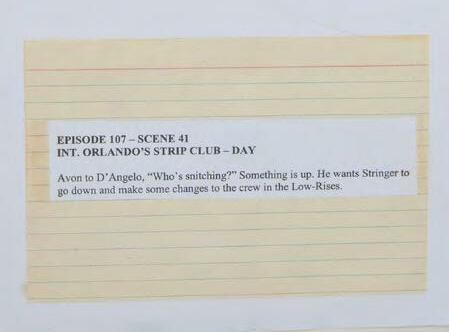

“For instance, Ed did not want to soften Bodie [a key character in the drug mob]. Ed wanted Bodie to kill Wallace [a sympathetic boy], because Bodie was beyond redemption. He wanted Bodie to be as sociopathic as Marlow [a drug chief] throughout the run of the show. And I thought wouldn’t it be great to have the guy who killed the kid you cared about, if you are compelled over time to see him as as much a trapped animal as Wallace. To this day Ed was like, You ruined that character.
“The most difficult question in TV writing is why are you doing the show. And if you can answer that question, you usually answer what the show should be. Whether you have a hit or not, if they wheel a fucking semi-truck of money up to your driveway and say please give us three more seasons of we don’t care what, just keep it coming, you have to be able to look at them and say I don’t have three seasons. I have other stories.
“Could we have done one more season of The Wire? Yeah. But that was not the dynamic. We never pulled numbers.
“We could have done one on juvenile justice. There’s a miniseries in that. But it was incremental to what The Wire was saying.
“There was one season I would like to have done. David Mills would go to the Broadway market over in southeast. It used to be white
working class. But now Mills said, everyone was speaking Spanish. And he said, we should do immigration. And as soon as he said it, I was like, he’s right. But we had to pull the bodies out of the vacants. [fn6] We couldn’t go back. Plus, I would have had to go back to HBO and go thank you for the last two seasons, I got one more. I never brought it to HBO. We were prepping season five. We couldn’t put those scripts aside. But I realized that if we’d done a whole story within the culture of immigration, we’d have said something fresh about American dysfunction.
“There was one idea I did bring them. Once we did the City Hall season, which I thought we did really well, I thought we could do a show around Carcetti [a pol who becomes mayor] who was to me a completely viable political character. I wrote a pilot, and sent it to HBO. I said I would like to run a show concurrently with the Wire. Called T he Hall , about City Hall. After four years as mayor, of which two would have been the first two years of The Hall, [Carcetti] prepares to run for governor or senator. The Hall and The Wire would alternate. There would be different timeframes going on at the same time, moving from Maryland to Washington. It was like man, what we’ll be able to do by showing the interconnection. Oh man, this is fucking great.
“And Chris said, You know, I can afford one show nobody’s watching. That was his answer.”

9
Disam res nemodia nis se di dolorro
GEORGE SAUNDERS
I FIRST KNEW George Saunders as a journalist. I read a lot of journalism, and George was doing some moves in his work (rollicking reported essays for the most part) that no one else was, mostly owing to the fantastic control he had in his voice, which was precise and caustic. The journalism was often very funny but also actually pretty wise. I didn’t even know he wrote fiction, but when I eventually found my way to his short stories, first collected in CivilWarLand and then in Tenth of December, I found they were even more inventive than the nonfiction-- funnier, sharper, more satiric. Satiric isn’t the kind of thing I usually like, but the work was also ultimately so giving that I became devoted. His technique was dazzling and ambitious, but he also just seemed a really good, generous guy. Later I found out he was a writer writers adore and want to imitate. I wasn’t surprised.
But then it wasn’t until I found myself reading Lincoln in the Bardo – a novel passed around with urgent pleading (“you have to read this”) in my circles, that I began to fully appreciate the extent of his creative powers, which are gargantuan. Lincoln in the Bardo is a really weird book, weirder than his stories. But it’s a book that explodes with creative ambition, and it’s worth saying at the outset that all of its odd and original fictional conceits – and they are many – are at the service of a straightforward and almost unbearable humanity. Some readers I know were exhausted by the book’s reach, but for me its innovations are not just original but also moving, a book that really successfully marries the brain and the heart. It won the Booker Prize, among other awards.
How did such a book come to be? George had never written a novel before. This one wandered a winding path over ten years, some of it surfacing in a short story and then a play, neither of them published. All along, he kept pushing it aside, sometimes allowing it to just drift off, and sometimes as a forceful act of abnegation. Eventually it just seemed to will itself to happen, though that’s not to say it wasn’t also a struggle.
2 GEORGE SAUNDERS
42
occupation : Writer work : Lincoln in the Bardo born : 1958
“ It’s Your Book, You Can Do Whatever the Fuck You Want”
Here’s what you ought to know about the book to understand our conversation: Lincoln in the Bardo is set in a graveyard, narrated by a chorus of people who don’t quite know that they’re dead and refuse to surrender to the beyond. Abraham Lincoln’s son, Willie, has just died, and during the course of
the book is visited – and held – by his grieving father. The plot involves the chorus, led by three men who speak in their own funny, odd version of period dialect and set off visually like dialogue in a play, trying to coax Willie out of the Bardo (this liminal place where all the characters have congregated) and into
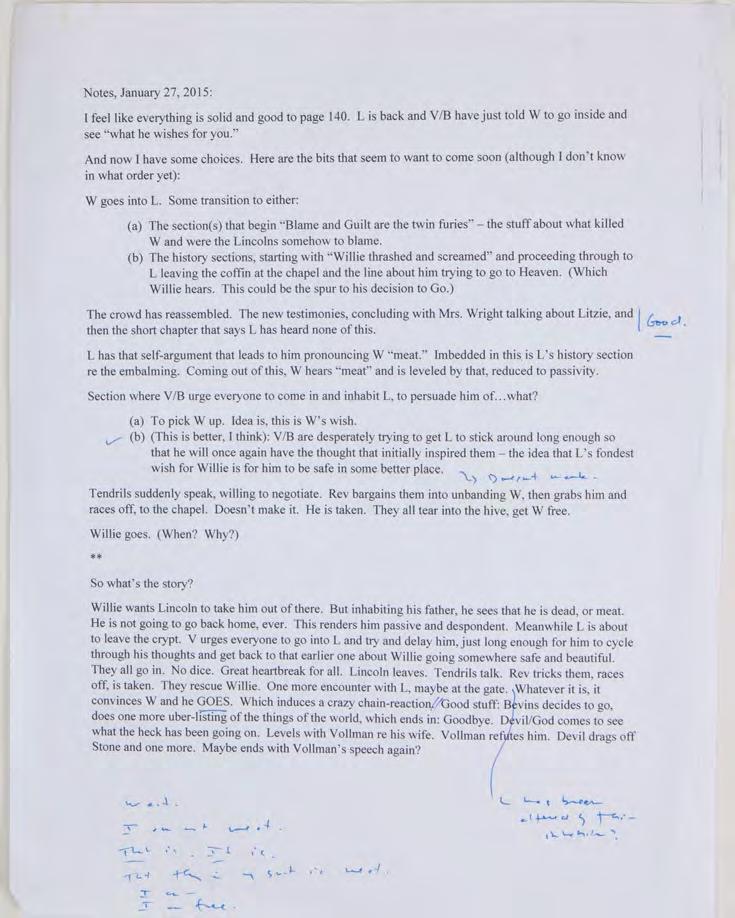
3
Dolut eliciisqui te volupti ne et fuga. Sit quiae.
Heaven, where he needs to go for his own everlasting good. Meanwhile, since some of the story is true (Willie’s death, and the ambience of the brewing Civil War and Abraham Lincoln’s deliberations about what to do about it) large parts of the book are given over to snippets of historical accounts, most real but
some made up. It takes many pages to understand what’s going on – it’s not even immediately clear who’s speaking. But eventually you figure it out.
George and I talked during the period around the publication of A Swim in the Pond in the Rain, a book that arose out of his classes
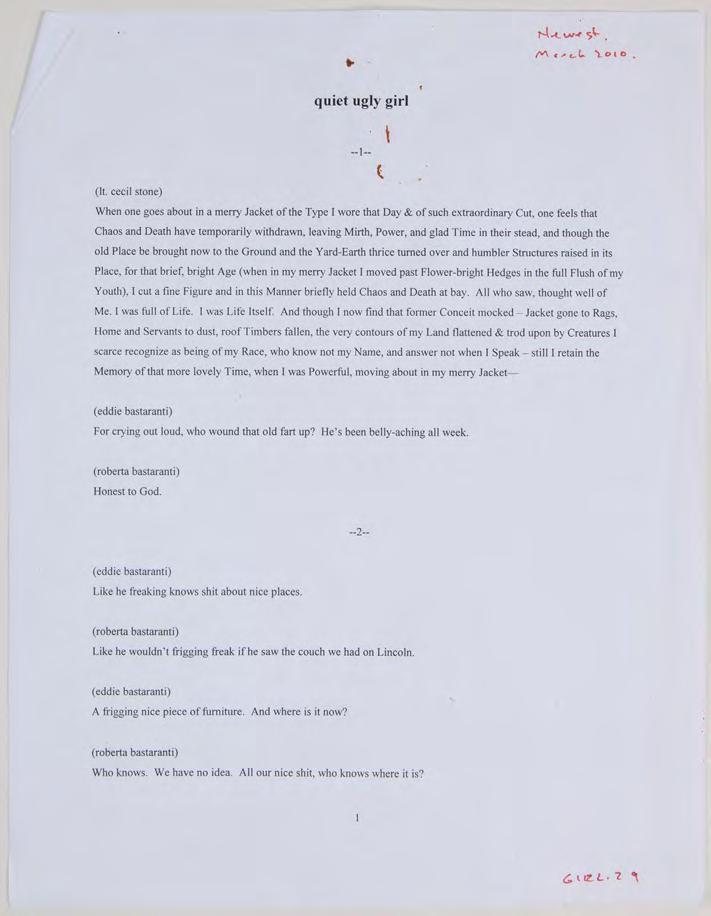
4 GEORGE SAUNDERS
Dolut eliciisqui te volupti ne et fuga. Sit quiae.
at Syracuse University about how to write and read a short story. As such (or maybe he’s like this all the time), he was very interested in trying to interrogate his own process. So he was unusually lucid about the book’s trajectory and his own state of mind during it.
George Saunders: “I was visiting Washington and driving in a car with my kids and wife and her cousin Courtney. We passed the Rock Creek Cemetery and Courtney offhandedly mentioned the story that Lincoln had gone in there after Willie’s death and held him –like, you know, the Pieta -- and the Lincoln
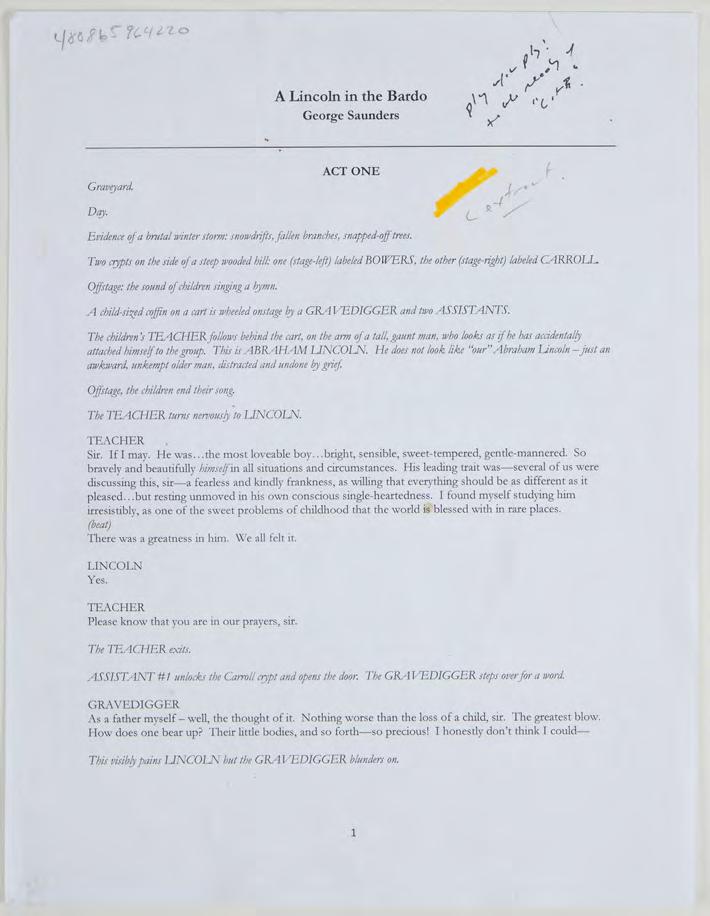
5
Dolut eliciisqui te volupti ne et fuga. Sit quiae.
Memorial kind of cross-fired in my mind. I thought that was beautiful, but you have an idea that’s one circle, and then you have the way you’re working at the moment. I couldn’t imagine any intersection between those two. I was writing the stories in CivilWarLand at that time. I could see maybe doing a sarcastic version of the Lincoln story, but that didn’t really appeal to me. So I let it sit, but also I found myself casually researching it. That was it.
And then some years later, I was living in a sweet little town called Pittsford, up on the Eerie Canal. And there was a little pioneer cemetery and a little library we could walk to and it was just heaven. Somebody in the town had self-published a book of historical photos of people, like, playing croquet on the lawn, so you had the really cool experience of being able to walk by these old houses and know who built them. And then you’d go by the graveyard, and you’d see the names of the people who were playing croquet on the lawn. And then I started to think I’d want to write something that captures the feeling of being in one village for 200 years because that was new to me. I grew up in a suburb. And one day we went to hear the Kronos Quartet, and listening to the music I just started this kind of mental fantasy of a book set in that graveyard. And I had the idea that all the people who ever lived in that town who were buried there were still around and they had a job which was, whenever somebody new died in town, they had to sort of do a collective group monologue on his or her life just summing it up. And that there would be a young woman who was not very pretty and had some weird mannerisms, had a rough life, never married, she went through life as a local joke and it was her who was dying. So the idea was okay, all these people who knew her at different stages of her life were going to be crosstalking. And I had this notion at the time – it was the days of the early Internet, when they had those chat lines and I thought they looked cool. You had a fragment of a line, then somebody would interrupt.
I started goofing around with that. There
are all these ghosts who had lowercase names and they were chatting about this girl who had just died that night. So I had about a hundred pages of this story I called “Quiet Ugly Girl.”
I worked a lot on it, and I really liked it. But it basically didn’t work. The problem was that there was no real-time story. It had nice riffs and nice tonalities – the interrupting I really liked – but I didn’t figure out the driver. So what, you know, she died? We’re watching Dr. Zhivago now, and that has some great forward storytelling. This didn’t. I couldn’t get any purchase on who she was, or why I would want to tell this story. So I finally just let it fade away.
And by the way, I was not thinking at all of Lincoln at this time. In fact, when I was writing the book, I never made the connection back to this story. I look back now and it seems like it’s kind of all laid out in front of me but all those years I never thought to put Lincoln into that graveyard until really late in the game.
I’m getting ahead of myself.
A Decade Passes About ten years (?) later, I was thinking about Lincoln again and I was still stuck on the non-intersection of those sets – the material and my own voice. If you look at CivilWarLand, part of the charm is that you and me are on the same page and I’m winking at you in every sentence, ready to tell you how to regard the fictive world, which is a little below us and a little askew and we can have fun making that world and then quickly, instantaneously comparing it to the real world. But the Lincoln book would have to be much less ironic, more traditional and you know, novelistic, and I just couldn’t do it. So I thought well maybe I can do it some other way. Maybe in a play I could do it. I was trying to give myself permission to use a different kind of language that was a little less edgy.
[I never wrote a play before.] I went through it many times and I could never get it into fighting shape. But every time I went
6
GEORGE SAUNDERS
away from it, I thought Oh, I know there’s something there. I did hundreds of drafts, I have boxes of them.
I mean, you know, one of the things about revising is that I’m never a hundred percent sure something is good. Once you send it and someone approves of it, then maybe it goes to 87%.
And though I really didn’t like a lot of it – my version of theatricalized language – I thought maybe if it had good actors? And nice sets, you know?
But the other thing I was thinking – I actually wrote this across one of the drafts of this play: RUN AWAY. On New Year’s Day I look back to see what I worked on. And one New Year’s I wrote: RUN AWAY, DON’T TOUCH IT.
When I wrote that note I was as close to pissed off at myself as I’ve every been in writing. Like no, just fuck, why are you doing this?
The one thing I’m pretty good at is being really honest with myself about my moment to moment excitement. And with both these projects, what happened is I got to certain point and the big narrative ball wasn’t rolling anymore. You know, it starts feeling just like typing. I always picture it like a river that’s really tight and fast and then it gets wide and slow. And at some point it gets so wide and slow that it’s a pond, and then a marsh. And then bleh.
When it comes to time-wasters, I’ve got kind of a thick skin. I had a teacher who said once, if a young writer could know the difference between the stories he thinks he should write and the stories he should write he’d save himself about 20 years. I’m still trying to save myself those 20 years. I’m pretty ruthless about that. You put the time in, you earn the right to, you now, tell it to piss off.
So I just wrote that thing across it, and it felt really good. Like ugh, fuck, gosh, shoot. That was a close one.
But I was still reading about it because it still interested me.
And five years more Okay, so more years pass. Tenth of December was coming out. I’d finished it. And I had some version of, all right,
look man, you’re over 50, you had a really good run. You know how when you finish something in a certain mode it begs you to come up with another mode? The Tenth of December mode was fully played out of me. Whenever I tried to start another story, I had the feeling like, now you’re doing the same thing again.
And: you do want to do that Lincoln thing. You don’t want to do that play. God, no. So why can’t you do this? What’s the problem? Oh, it’s too vast. It’s too beautiful. It’s about love. These were actually not good answers for why I shouldn’t do it. This feels like it could be the moment where I as an artist chickens out, and that’s sad.
And then my mind went the other way. This is me talking to myself: You were 40 when your first book came out, it was a very hard won victory that you got by going through a narrow doorway of a very weird voice that you’ve now perfected, why would you want to fuck that up? This tone I was anticipating was a real departure. You could become a laughing-stock.
So I just kind of said to myself: take the six months I was waiting to see Tenth of December published, a time when you’re usually just worrying about the book that’s coming out, and just goof around. If it’s ridiculous, you just throw it away and nobody has to know you even started it, you know. It was really important to make that kind of contract where I could pre-approve the waste of time.
And still, I thought, this was going to be just like the play. You’re gonna throw it away. And that kicks something open in my head –why not make it more play-ful?
I took the play. And I plucked out a first monologue by a guy who had died, had had a bad marriage, his wife was nymphomaniac. It felt a little misogynistic, I just kind of flipped it in my mind and it went okay, Boom. And I came up with the idea of the truncated consummation [ in Lincoln, this wife turns from nymphomaniac to virgin].
I didn’t have a lot of thoughts about the book. I just grabbed a chunk of text, called it
7
the start of the book and began messing with it – very mechanical. I didn’t think about the rules of the world I was creating, but a lot of the rules turned out to come from the play. The idea that somebody was trying to get Willie to leave was already worked out, I guess. I never thought of this before, but I think I had to use language I didn’t like to work out some structures, and by the time I got around to using better language the structures were kind of in my memory to fill in. The angelic chorus in the book – that was in the play first. Lots of elements.
In the simplest essence, the story is Lincoln was grieving. He comes to the graveyard, he interacts with the body. And Willie either goes to the right place or he doesn’t. In an early draft, Lincoln comes three days in a row. But the material in the middle was so boring. So one of the great simplifiers was no, he’s just there one night, and he’s gonna pick up the body because of that early Pieta image. And then in an early draft, I thought Willie could just stay. Or he could hang around for a while and for no particular reason leave. Which is no good. I had to put some risk in there, but I had to ask myself how does the place work? It always amounts to some almost Sci-Fi imposition that I make. And it’s just trial and error, trial and error. I sometimes think structure is just finding a way to answer the question the flawed nature of your narrative causes the reader to ask. I’m trying to do a good job of imagining what the reader will stomach.
One of the first things I wrote was a monologue that never made it in. It was Lincoln and these two senators from Illinois who were taking the coffin from the chapel to the crypt. And it was funny – almost Gogolian in the way that these Senators were kind of counterpoints. One was strict and the other was verbose. And I finally just plucked it because it was in a 19th century guise and it just didn’t fit. It took all the wind out of the sails and made it sort of pretend. I didn’t want this to be a pretend book, or a satire. But it was weird because I liked the section. It’s a funny, funny section,
but I had to say, okay we’re now in a different world where you George, Mr. Proud of Being a Stylist, is going to have to stand down a bit.
There was one draft where it was a little sad and maudlin and straight. And I had these barons – they were actually in Quiet Ugly Girl, in there as a sort of dead 1950s Dean Martin kind of couple, and I loved them as comic relief because the draft was getting so self-important.
But maybe the biggest thing was that in these early drafts, the book was really heavy on ghosts, and something was missing. And I realized it was just that all of the historical stuff that made it so compelling to me when I first heard about it had no way to get into the book. At some point I did three or four pages of very straight third-person Gore Vidalesque Lincoln-- basically Lincoln walked into the cemetery on a gloomy February night. But I looked at that, and thought just no fucking way. That’s not going to happen. So I shut down that whole avenue, like in one day.
But it became clear I needed to get the historical stuff in there. I tried having the characters say it, which doesn’t really make sense, like why would Lincoln be talking aloud about this party [an important scene in the book-a flashback to a party in the White House, while Willie lays sick upstairs in his bed]? And I thought, well how did I know about that party? Well, from those books. And there’s a light on: I’m like, can I quote directly from the books?
And I remember just having a thought, well, it’s your book. You can do whatever the fuck you want.
So I put some of the historical accounts in, about the party, and it was really coming alive. Suddenly I could write about physical things and food and all that. And I was just curating it, excerpting from real sources. And then there were just places where I’d be imagining that thing all these years and the excerpts didn’t really do justice to the thing in my head. So I thought: well, can I make these up? And I’m like, yeah, sure you can.
8 GEORGE SAUNDERS
That’s what you’re doing anyway, you know.
And then it became, don’t do that too much. There was an important stage where I went through a big section of the book, toning down the made-up ones because they were sticking out like sore thumbs.
And a big moment for me --in one of the intermediate drafts I had the characters identifiers at the top as I’d done in Quiet Ugly Girl or in a screenplay. And I flipped it, putting it on the bottom, and it was oh wow, I can go anywhere with this. As long as somebody said it, I can now accommodate it. And it just looked cool. I was moving at speed now, goofing around and just playing.
I had written about a third of it. I was excited about it and knew it was working on some level, but with this one more than anything I’ve ever written, I was aware that knowing it was working might not actually mean it was working. And I knew if I went out with it too early, and it was stupid and nobody could understand it, I would go back to my play-mind and just run away from it. I sent it to Paula Redick ???, and she wrote me a note about it that I always kept private, but was very nice. And then I realized, okay, I have a book to do. I’m gonna cash in on that six-month contract and go ahead.
A long sprint It took about four years. If you ran it in fast motion, I think what you see is a series of six or seven page blocks being spit out, refine, refine, refine – all the way to the end. I don’t much like outlining. It’s all very Rubik’s cube-y, not thinking about it, just everyday going in and polishing what I can polish and waiting for handles to show up, each part written a hill at a time. Like, for example, let’s get to the party scene. Then: what happens after the party scene? There would be stopping points where I’m like Oh God, I really don’t know. That happened after Lincoln comes in and leaves. What, what’s the natural reaction to that? I was out one night, and I just thought, oh, they {the narrating chorus} are like superfans of Willie now, you
know. Like a king has come to visit Willie so he must be somebody special – like Kanye came to visit him, you know. So, that’s it, that’s the next beat and I could go ahead.
Generally I let myself do exactly what I feel like doing in the first draft moment. I don’t even worry about it. I just put it down. And then when I really start to destabilize is in revision. But with this Lincoln book, I had to lower my standards a bit on the prose. Instead of trying to hit a homerun with every phase I had to say well no, this is just a normal person talking here – a Civil War soldier-it’s got a certain diction. I realized that what’s going to do the work in this book of originality is the structure.
I had that Reverend in Hell scene [an elaborate horrifying and funny sequence I bring up, in which one of the narrators actually leaves his liminal state, approaches the Judgement gate, realizes he’s going to Hell, and then hightails it back to the graveyard]. I don’t really know why I wrote it – I was reading some books about death – but I wrote it quickly and it was really easy. And I thought, oh no, no, no, that’s one too many, that’s going to be a goiter on the book. If I put it in there, it’s going to fuck it all up, just leave it out. And sometimes those sections you eject just keep coming back in. It kept coming. Until I finally said, okay, if you want to be in the book so much, I’m going to put you there. It was like some monster comes in and sits on your couch: Okay, well, you’ve been here for a month, so you have to stay. And then of course the book starts reacting to it. And subconsciously I think it had to be there because it basically answers the question of what happens next in this world. I always use the word undeniable. I don’t know what it is, but it means it’s earned its way into the story. That’s the thing that’s going to establish the structure. It’s not like you think of the structure and then go find that piece. And the audacity of the sequence – I’ve come to recognize that feeling as something to go toward.
You ask how conscious I was of how much to frustrate the reader at the beginning, and
9
the answer is I was thinking about it 100% of the time, and I did a whole lot of fine-tuning. In fact, I was surprised that people found it so difficult because I really thought I had pitched it just right. I can even walk you through it. They were two or three hints during the initial Vollman-Bevin [two of the three chief narrators] conversation, where as soon as you mentioned the kid and as soon as you mentioned the sick box and there’s a whole anecdote about Vollman’s sort of funeral I think in my mind, any alert reader is going to know ‘okay, these guys are dead,’ right? And then when you see the words Willie Lincoln, I’m like, they’ve all got it now, you know? But some people tell me they had no idea of what’s going on. The theatrical style really befuddled some really good readers who need more – I was going to say verbs, but that’s not it – physical grounding . Certain
reading imaginations don’t really take to it. I didn’t know that at the time. I didn’t want to be any more obtuse than I needed to be, but the reason we’re doing it this way is so that later it will pay off. The reader’s going to be welltrained, and you’re going to be able to do some cool things. It’s almost like in music, where you do a motif early. I kept shrinking and enlarging the opening of the book to try to find the optimum place that would be a little telegraphic but not too telegraphic.
I think I may have taken a trip to Fresno for a reporting trip for a magazine story during this time. I lived in a homeless camp. I only realized it later but that was really important to the book. People would come up to me and tell me their story about how they wound up in the camp and in those stories they were always the only sane person there. And then the next day, they might come up and tell me the same story. I carried that over completely unconsciously into the Bardo, where these people establish and maintain their identity through repetitive storytelling.
[I point to a big white sheet of paper on which he›s written Endgame. I ask him what it is.]
Well yes. It was towards the end, you have a certain ground secured behind you. I know that up ahead of me, three of four things have to happen. I don’t know what sequence they have to happen in. I bought that big piece of paper on purpose just for that. Let me write out the possibilities and then I’ll reorder them a little bit. I’ll know if one ordering seems more sensible than another. When there’s some logical decision that has to be made, it helps me to write that out longhand. I’m close enough to the end where I see that the endgame is Willie

10 GEORGE SAUNDERS
has to go. Okay, if that’s the centerpiece, what has to happen around it. So it’s outlining but it’s not theoretical outlining. The end product would be a list of the order of operations, something like that.
The big finish And then there was a burst. We had moved to California, but I was still here, teaching but not doing anything much else. And I just cranked. I was out there 12, 14, 16 hours a day. And that part was magical. All thee bowling pins just came down. Things that I didn’t know the book was going to do, it started doing. I’ve never been in that mode before. That was incredible.
We circle around to how he initially came to inhabit the voice he became known for.
It was a little existential you know? I was 32 years old, I had a family and basically I thought, why does my prose not excite me? And then: okay, what do you want not to sound like? Anything that was normal or banal, like normal English sentences that anybody can write, I didn’t like those. If a sentence sounded mundane I would freakify it or cut it. I was saying to myself, go ahead and be a little weird, a little jazzy. I goofed around with some poems at work, just writing these little Seussian things-doggerel. And the poems had more life in them than anything I was writing.
Compression was key for me. I found you could make yourself sound more like yourself by making those really hard choices where you eliminate everyday phrases. Like, On the way to work, I ate an apple. Well maybe if the next sentence is at work, you can cut the first phrase. Small things like that-- just a series of moves that got internalized. They felt to me more truthful and the stories that were being produced were actually more interesting and urgent to me. I had a certain sound in my head, I could just hear it. So I just started fucking with that. And one of the ways I did it was I put those stories in theme parks, and then even if I was doing some sort of version of Hemingway it was kind of funny you know. The clouds hung low over the Virgin Mary
theme park!
I never really had a plan about those stories. I just wanted them not to suck. And so if they started to become too familiar, I would just disrupt them. And that disruption became the driver. Gradually I found that in writing those CivilWarLand stories they didn’t sound normal. They sounded like something unto themselves.. It was a long process and it paid off great, you know. So that’s why it was kinda hard to move away from it with this book. It’s almost like, leave the party with he who brung you, you know.
It’s interesting though isn’t it. Like for example, I play music and I cannot get to that point in music. I can’t break away from the stuff I’m imitating. I just can’t do it. I’m a good guitar player. And I’m not a bad lyricist. But the result isn’t very interesting.
But – Random House let me record some music for my audio book intros. I worked with this kid. And that was interesting because that music is actually original. I don’t think it’s fun but it’s original. There was a moment when it felt like I felt when I was first writing those CivilWarLand stories. It was kind of like ach, fuck it. You just give up trying to do anything in particular and just make a bunch of moment to moment decisions that seem edgy. Me and this guy – we were just literally improvising together. I’d play a riff and he’d cut it up and recycle it and add something to it. And it had energy that is a little similar to what I’ve done in writing. The situation meant that there could be no planning. Whatever I planned, he would mess with. That disrupted the conservative, cautious controlling part of my mind. I had no pride whatsoever or possessiveness about what I put down.
I ask him whether he’d intended that Lincoln be a novel, given that he’d never written a novel before, which took us to the present and what he was working on now, And then we were done.
Really for me it was just that when I had that first third done, it was 60 pages or something and I wasn’t even started yet. The form made it. I’d made a career making these really
11
SUZAN-LORI PARKS
How Great Thou Art
SLP: Do you have writer friends?
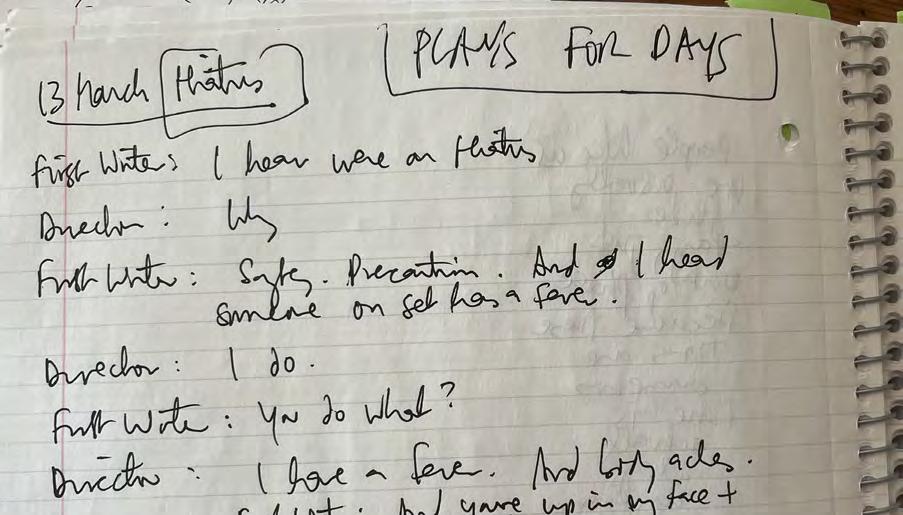
AM: Quite a few.
SLP: I hate you.
AM: You don’t have that?
SLP: I’m trying to make—no.
AM: Maybe you don’t want writer friends. Maybe you just like to be in your own writer world.
SLP: Just a musician. He’s my friend. I had to marry him.[fn]
AM: Childhood friends?
SLP: I moved around so much, I have no childhood friends. So now I think outside my immediate family, my most intimate relations are with my characters.
occupation : Playwright
work : Plays for the Plague Year
born : 1963
Suzan-Lori Parks is a playwright, winner of the Pulitzer Prize for TopDog/UnderDog, among other plays and prizes; but she also writes songs and novels and movies and TV, and hosts a performance piece/tutorial online and in real life called Watch Me Work, which is true to its
2 SUZAN-LORI PARKS
Dolut eliciisqui te volupti ne et fuga. Sit quiae.
43
title as well as being an audience-participation creativity group-therapy session. That’s one of the reasons Tony Kushner told me I had to talk to her; the other is that he just all-around thinks she’s brilliant and he knows she thinks a lot about the kinds of questions I was asking him and everybody else. I had seen TopDog years ago and found it remarkable, so I got in touch with her.
Suzan-Lori has a broad gorgeous smile which can disappear quickly under cloud cover. When we first connected, she said she had begun an unusual project, and invited me along. Her project was called Plays for the Plague Year. It was set in the first year of Covid, but Covid was also a metaphor for pain, and the plays a test of art’s capacity to heal, though it didn’t start out that way. It began as an exercise to keep herself sane. She wrote a play a day about wherever her mind happened to wander during that difficult and bizarre year. Eventually, she decided to knit
them all together into one coherent work, or at least that was the plan.
She was the main character, and would play her too. For my purposes it was as vivid an illustration as I might ever be able to devise of how an artist transfigures the real into the imagined, how, as she put it, “life becomes life.” I spent a year tracking its progress. During that same period, she was almost maniacally productive, wrapping up a TV show, writing a Jimmy Cliff musical, finishing a novel, preparing TopDog for a revival, writing songs, raising a kid, all the while enduring wild fluctuations of elation and despondency. If you were trying to make some sense of how an artists works it out, you didn’t have to look any further than Suzan-Lori Parks.
Plays for the Plague Year – the beginning
SLP: I am working on a TV show, Genius Aretha. It’s nine in the morning. I’m on a set in Atlanta. We’re shooting episode six, we have

3
Dolut eliciisqui te volupti ne et fuga. Sit quiae.
five in the can. I’m the showrunner, first time I’ve ever done that. My headset’s on. And on that March day I get a phone call from the the big cheese, who says, we’re gonna shut your show down. And I fall on my knees, crying, because it’s taken so much to get the show this far, and we’re almost done. They say, don’t worry, the hiatus will only be a few weeks, it’s gonna be awesome. And as I come up struggling to my feet in the parking lot where we are shooting, I think, okay, I’m going to write a play a day. And it happened like that.
AM: To keep yourself occupied?
SLP: Occupied, watching, awake, witnessing. 100 plays for the first hundred days, witnessing.
AM: So it was part therapy.
SLP: The way everything I’ve ever made is part therapy.
AM: Was it also opportunism – like you saw an artistic opportunity in it?
SLP: See, opportunity, it wasn’t – I’m one of the least opportunistic types of –
AM: I didn’t mean from a career point of view. Like, just, this Covid period is potentially great material.
SLP: No, it wasn’t like that. Say you’re on the Titanic. And the Titanic goes down, and a cheap piece of wood floats by. You say, I gotta hold on to this. That’s what it was. And I start writing that day.
AM: In your hotel room? How long does that first play take?
SLP: I don’t know, thirty minutes. The phone was ringing, the sky was falling, it was just a mess. But I’m thinking, just gonna hold onto this little piece of wood. And remember, the plays are all kind of like just what happened. So I’m not really inventing everything, I’m just writing.
We were talking after I’d watched several days of rehearsals for a workshop she was doing for the show, in which she starred as the Writer-herself, more or less. This was unusual in itself because she does not generally act – in her own work or any other. She’d never written
anything so autobiographical before. She’d written songs for the play too, for her and the cast to sing. She was all-in.
Plays for the Plague Year follows First Writer, her husband and child through the pandemic, but after that first day the plays (that’s what they were – tiny plays, short bursts, typically a page a piece, or a few minutes performed) became as concerned with the larger parade of what happened during that first year of Covid – Wuhan, washed hands, Donald Trump, George Floyd – as they were with the family. As she was writing, she found herself employing various theatrical conceits, each getting their own play – the just-dead (famous and unfamous who’d died that year) appeared as ghosts; an insipid rom-com she kept returning too, in which a version of herself appears, complete with laugh track; she breaks into song – there are lots of them. It didn’t have an obvious genre -- it was musical, but wasn’t really a musical. It was a succession of sketches, but they added up (to what, was the overriding question). And though she was writing quickly, what was emerging was quite theatrical. She’d been writing plays for so long, that’s just how she thought – theatrically. But still: I found myself pressing her to explain how it went from a therapy exercise to a piece of theater because that seemed to me to be the central question I’ve been circling in this book: what is the work of art? How did her lived experience become a dramatic experience?
Turning Life Into Theater
AM: But you’re also making choices, right? Editing your experience in terms of what you think might be dramatic material?
SLP: I wasn’t thinking that way – it was that wood to me – but yes, already in those first few days, I suppose I’m spooling it into theater. It wasn’t a diary. Very consciously I said, I’m writing Plays for the Plague Year. [fn] I’m writing plays. Which maybe, some day, will be performed.
AM: So you had the foresight to think through
4
SUZAN-LORI PARKS
a title, and begin to imagine its eventual life.
SLP: I didn’t call it Journals for the Pandemic Year, which I could have. It was Plays for the Plague Year. The clang, the sound, the alliteration. It just caught my ear, bouncing off the Defoe. [fn] And the process of seeing the title engendered, conceived the thing. It was if my subconscious mind was hoping, planning for it to be performed one day.
AM: One element that appears in that first play is you. The plays revolve around this character you call First Writer. And this character has a defined personality which is you but not entirely you. So you were already making yourself into a fiction.
SLP: Yes, I guess that was important. The skin on my feet is crawling right now, because I’m realizing how weird that was. We’re always performing ourselves. I’m aware that I’m always playing a part of the writer, in some play. But having a character named The Writer, I’d never done that. And it was me, yes, but it was also not me.
AM: The character is very amusing.
SLP : Like me!
AM: She’s a naif, but she’s also knowing. And cynical and innocent at the same time.
SLP: That’s part of me. In some ways I feel it’s the real me. In life I am constrained, but I get to be the real me in a play.
AM: When you headed back to New York did you tell anyone you were writing these plays?
SLP: I told my husband, but probably not until Day Three. At that point, I was thinking of the play mostly as a safety valve. Because I’m worried – about Covid of course, but also about the TV project that just got shut down. We were almost done shooting. I could have been done with the job. And I was ready. While I was doing the show, I couldn’t write anything else. It took everything. And I had plays to go back and write. I had musicals that I was working on. I had a novel. And so maybe I also saw the plays – maybe not as a piece of wood, but a tunnel. A tunnel out.
AM: You’re really astonishingly prolific.
SLP: I’m in despair a lot, artistic despair. But I
have a wonderful person in my husband Christian, who is there for me. It’s very important for creative people, especially if you’re working at a higher level, where the air is rare, friends are few, and knives are always out.
AM: I didn’t know you wrote music too. Was there a moment you decided, this thing needs songs?
SLP: It was more like, I want to learn a song today. I was a songwriter before I was a writer writer. So the songs came first. I think a lot of people have general talent, and we end up in the spaces where we feel most welcome. This is my theory based on my own experience. When I was a kid, I loved to make up songs. But it wasn’t a welcoming place.
AM: Wasn’t welcomed by others? Or in terms of your comfort writing?
SLP: Well, maybe one thing fed the other? In high school I loved to play the guitar. But black people don’t play the guitar. I heard this from black people and from white people. I mean, there’s Jimi Hendrix, and then a great falling off. It was the feeling I got from my friends. I watched my kid in front of the mirror this morning, and he’s the only kid in his school with an Afro. So he’s asking himself, how do I fit in? And I said to him, you’re such a handsome kid. And he said, yeah, that’s my mom talking. My parents encouraged me, but your peer group is more influential, so I kind of went underground. Years later, I’m just like well, I’m writing songs, this is a song, I’m gonna have a song there.
AM: How do you write a song?
SLP: I sometimes sit at the piano, or play the guitar, and try to find a groove, find some chords I like. And I’m always trying to push my chord neighborhood, my chord vocabulary. And then the chord changes. And then I sing nonsense words usually. It was a comfort to hear that Paul McCartney wrote “Yesterday”singing the phrase ‘scrambled eggs.’ It’s how children learn to speak. Gradually the right words come into focus. It’s the same thing, by the way, when I write a play without music. The rhythm is down, I just have to find the right words. Sometimes a rewrite
5
is just finding the right words.
AM: And over time, you’re building the songs in, you’re returning to these blocks or motifs – the visitations of the dead, recurring characters, the parallel universe rom-com --it’s starting to take on the dimensions of a sophisticated theater piece. I’m sorry to keep pressing on this, but was there a transition?
SLP: A transition between the therapeutic and the artistic?
AM: Yes.
SLP: What’s the difference?
AM: Well, starting to think structurally, building it.
SLP: Is it also the sense that it might be of interest or service to others?
AM: Yes. I have to make this funny because otherwise it would be too bleak, that kind of thing.
SLP: Very little of that happened in the daily writing of it. That really happened in the rehearsal. All these five plays in a row are about dead people. Do I really need them? In rewrite, I’m envisioning the audience. But where’s the leap? When do you move from complete absorption into awareness that –I begin to recognize, you, then it’s art. That feeling – that there are actually people who I might want to share this with, when that happens, then you might look at it in an architectural way. And that is fucking cool. But when did that happen here? I really don’t know.

AM: Until then your subconscious and your years of practice are doing the work for you?
SLP: Right. My active mind is getting me to the page every day. My active mind is pretty useful! I have a little note, it’s like an index
6
SUZAN-LORI PARKS
Dolut eliciisqui te volupti ne et fuga. Sit quiae.
card, or half a page I tore, saying something like ‘Write your play today.’ And I carried it around, slapped it wherever I was to remind me to write.
AM: So let’s talk about the rom-com. Many of the plays are written as if they take place in a TV show the Writer is watching – offering a fun-house mirror to what she is experiencing in real life. It’s a kind of daring theatrical move. Can you explain it?
SLP: Well, I’d been making a TV show … I guess I was just thinking about it. It was kind of to have a laugh-- there are little things you do just to amuse yourself. Some days I’d say, I don’t know what to write today. So let’s turn on the TV in my head.
AM: Talk about the plays with ghosts. The dead people.
SLP: Well, I mean, I see dead people! And I have a history of writing plays about dead people. Or with dead people. Or on dead people. Or for dead people. George Floyd and Briana Taylor and Larry Kramer and John Prine...
AM: And all the dead anonymous people. The teacher, the principal.
SLP: I just read the news. And there they were.
At Mount Holyoke, where she went to college, she took a class with James Baldwin. Listening to the way she performed her stories, he steered her into writing plays. (“God bless him. To see something about me that I couldn’t see.”) He called her “an utterly astounding and beautiful creature who may become one of the most valuable artists of our time.” His prophesy bore fruit pretty quickly. She became consumed with writing theater and won early success. Her work was inventive, irreverent, funny, historical, literary: Father Comes Home From the Wars, parts 1,2,3, Civil War plays also inspired by the Odyssey. The Red Letter Plays: Fucking A and In the Blood, riffing off The Scarlet Letter, 365 Days, 365 Plays, a project similar in structure to Plays for the Plague Year, except they’re not meant to play as one play. In 2001, she won a MacArthur “genius” grant. There was no formula for her. Some
plays took years. Fuckin A was “a real slog.” She wrote TopDog/ UnderDog in three astonishing days.
Plays for the Plague Year was proceeding along its own strange path. Covid was dragging on. 2020 became 2021. She kept writing, a half hour a day, while she tried to keep Genius Aretha afloat first on zoom, then back on location, while her son did his remote schooling, while her husband got Covid and long-Covid, and she got pneumonia. “I had no time to read the plays all over. I mean it was nonstop: write, write, write. I should take a picture and send it to you. I wrote a note to myself. It was like an index card or half a page, it said something like “Write your play today.”
Then a year and a month after she began, her ex-husband Paul died of Covid. It was April 2021. She stopped writing.
She had hours and hours of play written, a play every day for more than a year. Back in November, she had taken a walk with Oskar Eustis, head of the Public Theater, where she is artist- in- residence. “He says, “Whatcha working on?” said Suzan-Lori. “I say, ‘Well I did a TV show.’ He says, ‘no, what else are you working on?’ I say, ‘I’m doing this play a day thing.’ I sent him the first half, six months work. He says, ‘Let me find you a director.’”
The workshop I saw was several months after that. They’d assembled a small cast. Niegel Smith, a noted theater director who had worked with Taylor Mac (see p. tk) and other experimental projects, was directing. They met for days in a rehearsal space across from the Public. Suzan-Lori’s son sat in the back, listening to an adult play him, largely for comedy, which must have been weird, but he seemed unfazed, staring into his computer. He was used to his mother.
What I was seeing was pretty much all the plays Suzan-Lori had written during this Covid period, strung together and bound in a black loose-leaf notebook. She writes in longhand, so she’d altered some language as she typed the pages up, but not much. Over the course of the workshop, they’d move some of the plays
7
around, and cut plays simply by folding the pages over. They’d have to cut a lot. She’d organized it to play in parts over separate nights because it was so long – maybe six hours at this point.
“Niegel would say, ‘I don’t get what this one’s about.’ And I’d say, ‘Eh, I don’t know either.’” Suzan-Lori explained. “I was basically just trying to answer basic questions: is it interesting? Is it watchable? Am I supposed to be up there playing the Writer? Is it okay to have songs in it? All that shit. No idea.”
Niegel had encouraged her to be in it, as had others, but acting was new to her. She was good-- one of the joys of watching the workshop was witnessing her own joy playing with this new muscle. The play – (I’ll start calling it a play,not plays, since the whole project at this point was to fuse it together into one coherent piece) didn’t entirely work, but large chunks of it did, and parts of it worked brilliantly. And the songs – they were a revelation. As she sang her own material, she beamed, visibly lit from within.
Screwing with the Real We met up again a couple of weeks before the June performance.
SLP: “I finished the rewrite of part one today. I was under the fucking wheel the day before yesterday. I could not see how to untangle myself from the reality and the need to make a show. I was in a very bad place, I don’t know how to do this. Can I go home now? The answer was no, you walked down that road little girl.”
As she was molding the plays into one, she was confronting the problem we had been discussing all along: how or when to liberate herself from the very element that had shaped the project from the beginning: real life. She had written the play as things happened, more or less in order (she had allowed herself a little fudging but not much), which meant that she as character didn’t have any idea of things that she as writer knew in retrospect. But if she knew where she was going, wouldn’t she want
control of how she (or we) got there? Wasn’t that what would make this a play, not a diary? In particular, what she had realized was that the play was missing a core dramatic element. There was no arc, as they say, to the core characters, the family. And she hadn’t really dealt with the death of her ex-husband Paul, the very severe illness of her husband Christian, even her own pneumonia. She had written a play of history, where there was a great deal of power gained from watching public events unfold that weren’t very distant from your memory. As she put it, “we all get to experience that moment again” – the audience gets spritzed with hand sanitizer, the rise of Black Lives Matter is told in short plays in which Breonna Taylor and Ahmaud Arbery show up – it has a to-the-gut effect. The immediate flashback feature was great, and it’s what I had responded to most at the reading. But she wanted the play to work intimately as well: the tragedy of the play had to be personal. How had she missed that? She had stopped writing the plays after Paul’s death. There was a reason. Paul’s death would have to be the play’s emotional crescendo. The stakes of Christian’s illness would have to be raised as a throughline.
One explanation for how she had missed this key dramatic need of course was that she hadn’t known Paul would die, so he was hardly a character in her play as she was writing it. They’d talk on the phone but he wasn’t a real presence in her life. And maybe she hadn’t really dealt with Christian’s illness because it was too traumatic at the time – at some level, the plays were designed as a personal escape, the way to cope with pain by diverting it to her imagination, not necessarily to dwell in it.
But if she were to make the most effective piece of theater, she would have to approach this project as an artist, not only a witness. So she said that that was what she was doing now, carefully weaving Paul in earlier, so his death, as awful as it is to describe it in these terms, would pay off dramatically. Lingering on Christian’s pain; also her own. It was
8
SUZAN-LORI PARKS
not without risks: would she upset the careful equilibrium between private and public that made the play so original? But she was feeling that it was all a matter of calibration, and maybe now it was working.
And one thing Suzan-Lori realized along the way (I hadn’t seen it, but she was right) was that, even though she hadn’t invited me in for this reason, the play was maybe about creativity itself. Suzan-Lori’s imagination had transfigured her into the character ‘Writer’ and then again into its rom-com doppelganger –all, by her account, without conscious effort. The plays, if they had any real plot at all, were about the writing of plays. “My promise to myself was, I’ll show up everyday.” That’s what she thinks is most important about creating too --“showing up,” no matter what, and being vulnerable and taking in, and then making some invented sense out of what you experience.
Being Vulnerable The Plague Year was the play’s subject, so inevitably it was sad. But it was also sad because its main character was
Suzan-Lori Parks, and it was impossible not to notice over time that there is a lot of sadness in her, and that she writes so ferociously in order to do battle with what plagues her – not only during this year, but all the time.
“To be honest,” she said. “I’m in despair. Pretty much every day.” She brought despair up over and over: “We all need to have more conversations about frustration, upset,” and over the course of our conversations, we did. She talked about not being understood (“there’s the despair that happens when I create something that I think is beautiful and it’s dismissed, in ways that I personally feel are less than fair”); she was in despair about politics, particularly the new orthodoxy about who gets to speak for whom – she was still raw about a white director who had been approached about this project and loved it, but felt it was “black play,” (which wasn’t at all true) and demurred, adding that she wasn’t the kind of young black activist who could make it possible for him to do it (“Broke my little artist heart. It’s ugly and it’s fucked up and I hate it. And maybe that means I’m not militant enough to teach
TOPDOG IN 3 DAYS
TopDog is about two brothers, Booth and Lincoln, a three-card monte dealer. Booth, as you can guess, eventually kills Lincoln, at the end of a complex, searing play about race and class.
“I remember this is the weirdest thing. Paul and I were walking around on Canal Street,and there were these guys playing three card monte. It was cool, there was a crowd around them. I had never stopped to watch, I don’t know why I was watching that day. When they took the game down I followed at a respectable distance. Where were they going? And Paul said, ‘hey, Let’s go home and I’ll show you how it’s done.’
Several months later I had a residency at a theater, and I was pouring tea in the literary department, and it just came to me. I said to the woman who ran the department. “Oh, two brothers, Lincoln and Booth, badump bump, it was just like that. And she said, you’d better go home and write.
So I went back to the apartment and I wrote a note, because I could see the whole thing. They do this, he comes home, he’s a booster – they reminded me so much of various kooky men-folk in my family. And it was like, I didn’t want them to be just talking, they had to do things. So I thought, wouldn’t it be cool if they did that card trick. I called Paul and I said, I’ve got this cool idea for a play, and I read him the beats, scene one, scene two, scene three. He said, “Oh I think you’re gonna write that real quick.” I said, “I think so too.” So I hung up the phone and started to write, and I just did, three days from beginning to end. And it was like, if someone were standing behind you with a gravy boat. And they were pouring silver liquid down the back of your hair. I’m taking dictation. I’m hearing it. I know it’s strange. And then I finished. And it was euphoria, gratitude. I put a quote in the front. Was it Emerson? ‘I am a god in nature, I am a weed by the wall.’ That’s what it was. I am colossal. I am all powerful. I am a small little delicate piece of garbage. It was all true.”
9
someone how to work with black people. I don’t know. It devastated me.”) She despaired about the way she felt constrained as a black woman to contain her emotions – this was what she was getting at when she felt the persona she had created for herself in the play was freer to be her than the her that was talking to me. (“I felt like I got to be me. I didn’t have to be guarded.”)
I don’t mean to suggest she was consumed by sorrow. She was warm, and often exuberant, and I loved being with her. But her joy was clearly fragile. Being open to hurt very much came with her territory; it’s what allowed her to do what she does. “It’s a constant – you know, battle.” she said. “Because I’m aware of peoples’ feelings. I look at people.”
And mostly what she despaired at were the very consequences of being artist. She needed art, like oxygen. She was terrified of shutting down. It was like death to her.
SLP: “If the creative act builds a bit of wood in the ocean one can hold onto, then the inability to do that creative act just feels like drowning. I feel despair when I can’t seem to bring it forth. I feel the constricting of the throat. It’s just the physical pain that I experience when I have difficulty writing, like someone’s strangling me. I can’t breathe. I can’t speak.”
AM: So you don’t feel the fear of failure really? It’s just the fear of not being able to create at all?” SLP: Well, that’s failure.
AM: And if it’s mediocre?
SLP: Doesn’t bother me. It might be mediocre. I’m so happy to have a piece of wood. I don’t care if it’s not oak. Wood laminate, good. If it floats, okay.
While she was reworking Plays for the Plague Year, writing songs for it, acting in it, she was also finishing up her series, doing production rewrites for Hollywood, writing a novel, teaching. I asked her why she also takes so much time, which she has so little of, to conduct her Watch Me Work seminars. It seemed so generous to me.
SLP: Because I know what it’s like to be lonely.
AM: Is there a question you feel your students are asking over and over?
SLP: Am I allowed to be here? Am I okay? That’s actually it: Am I okay?
Is She Okay? In June, I went to see the new version in a workshop for an invited audience. There was a great deal more about Christian’s illness, but she’d worked in less about Paul than what she had been planning – just enough, it turned out. And she’d implied that she (or her character; it was always hard to untangle the difference) too had Covid, though she hadn’t. There were more songs, and they were working really well. But the play still wasn’t entirely cohering. It was difficult to see what she would do to pull the whole thing together, but it was only another stage in a long process. She had five more months.
And then came November. That process was complete. The play was done and performed for a paying audience at the Joe’s Pub at the Public. I hadn’t been witness to the machinations that got it there, but I went to see the result. The final sweep of changes were subtle, but were all, to my eyes, exactly right. The play was now a single three-hour event – the parts had been collapsed. The cuts helped, as they almost always do. She had junked the romcom, so the play felt less experimental and a bit more straightforward, but kept many of the visitations of the dead – the play’s strongest dramatic element. They were now more pronounced and chilling. The audience members I spoke to were most drawn to the Covid newsreel aspect, the reliving of recent history that I’d always found terrifically effective; they still were, though I wondered how they would wear as the events receded over time (the play was scheduled to be mounted again in another six months).
As for the domestic drama, Suzan-Lori had indeed played up the illnesses. Now there was a little more Paul, and especially more Christian – his long-Covid was now really long,
10
SUZAN-LORI PARKS
stretching over the play. But the most telling difference in the family story, enhanced through surgical interventions, was that the play was now a love story between her and Christian. During our time together I kept registering how tender she was in talking about her love for her husband. In this final push, she’d laced that love into the play itself.
But most manifest was that the play now really was a musical – kind of. It had an opening number, some dancing, more songs. Throughout our conversations, she came most alive when talking about her songwriting; it seemed to give her the most joy. And now that joy infused the work. She also added more gags, more bits, more sweeteners. She’d turned her terrible Covid year into something like an entertainment. But it was also still sad. I watched her face beam, and then fall, and beam and fall again, trying so hard to find good in the awful.
So that’s my record of its transformation. I’m not a critic so I’ll leave it there. But there was one constant I only really felt in this last performance. I noticed how much of what we’d been talking about for a year was actually in the play, not even as subtext, but as the dramatic material of the show itself. The play ended with her questioning the entire premise of the project – could writing the play actually help her work through her pain? Could art – not the experience of it but the making of it – really heal?
In the the penultimate version of the play she says this:
This is America and so I’m looking for a happy ending. Can’t seem to find it. Funny, writing these. First, you’re telling the truth. Then you’re obscuring the truth. Because, as you start anticipating the audience, when your mind’s eye starts seeing other “I’s” and “eyes” on it, you change it, or – it changes – becoming more digestible. Wow. Trippy, right?
And then in the final version, these words: Maybe when I started I had this belief that theater would save us. But it won’t. Not in the way I thought it would. But it does preserve us somehow. So no, and yes. Talking to
Suzan-Lori, there was little doubt it had been worth it to her.
SLP: I mean, I’m on fucking stage at fucking Joe’s Pub. What the fuck am I doing? I don’t know. But I’m being true to the thing that called me, and that’s my primary allegiance. I could have an allegiance to the Bank of America or Chase Bank or something. You know, we’re all made differently. But for me it’s a debt of gratitude. Like, I know how big, how great thou art. It’s amazing. Creating, for me personally, it revolves around my love of work --or maybe my desperation to have that wood in the water.
“The intense desire. And also the joy. There is nothing better. This novel I’ve been working on? It’s been fifteen years, on, off. I have like five drafts. And yesterday I slumped on the bed, I’m flopped on the bed going Aaaaah, I can’t figure it out. And suddenly I saw the first beat of the first chapter, I could see it. I just looked at my husband and said, ‘Ooh, you’re sitting on the steps in the dark.’ And he said, ‘What time is it?’ I said, ‘I don’t know.’ He said, ‘is it midnight?’ I said, ‘yes.’ And for the first time I saw it.”
Making art, she said, requires “despair. And a lot of hard work. There’s a lot of flopping around, it’s horrible. The subconscious cannot be rushed. But we are lucky enough to do what we enjoy, right? Even if it’s hard.”
I biked home from the Public through the same now-busy streets that had been emptied by the pandemic when I first began talking to her. And as I rode, I thought of the last minutes of the performance I’d just seen. I’d hoped to see it the previous week, but the show had been canceled. Lo and behold, after giving herself imagined Covid for dramatic purposes, she had caught the real thing. “Funny,” she’d said in a text to me after I’d asked if the show had been shut down because she’d gotten ill herself. “I have a show uptown and downtown running at the same time. And also the new play premiering in Minneapolis. So I’m like:
11




















































 MICHAEL CUNNINGHAM
MICHAEL CUNNINGHAM















































































































































































































































































































































































































